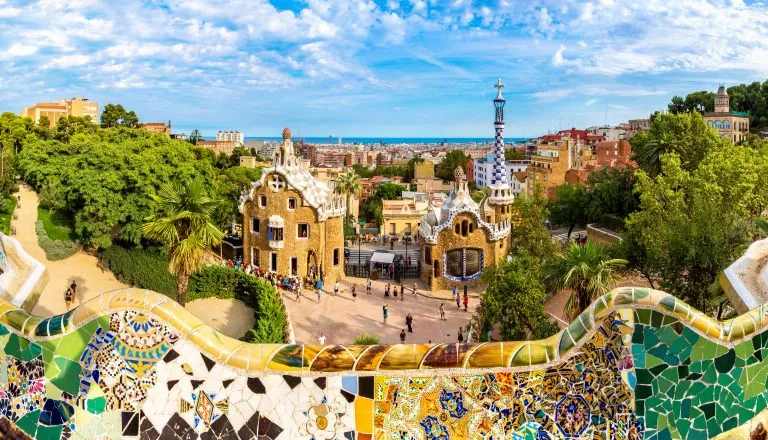

The Ultimate 10 Days in Spain Itinerary (+ Travel Tips)
If you’re planning your first trip to Spain and are hoping to sample a variety of what makes this sun-drenched country special, we designed this 10 day Spain itinerary for you!
Spain has had a special place in our hearts ever since we landed in Madrid for the first time when kicking off our supposed “6-month” round-the-world trip (that was almost 7 years ago, and that trip arguably never ended).
In the years since, we have been lucky enough to visit Spain so many times that we’ve lost count, exploring countless cathedrals, castles, alcabazas , beaches, and cities along the way.
We’ve explored the country via train, car, bus, and ferry, sampling iconic attractions and little-known villages alike, traveling both alone and with various groups of family and friends.
This itinerary for Spain in 10 days has been curated for first-time travelers based on our lived experiences in Spain, and we hope that you walk away loving this beautiful country as much as we do!
Here’s how to fall in love with Spain in 10 days.
Table of Contents
How We Structured This 10 Day Spain Itinerary
Getting around during your 10 days in spain, the ultimate 10 days in spain itinerary, the best time of year to enjoy this itinerary for spain, more than 10 days in spain, what to pack for your trip to spain, your 10 day spain itinerary map.

Some links in this post may be affiliate links. If you make a purchase through one of these links, we may earn a small commission at no extra cost to you. Please see our disclosure policy for more detail.
We structured this 10 day Spain itinerary to cover many of the country’s most popular destinations in a “U” shape, beginning in Madrid and ending in Barcelona.
In addition to the ever-popular Madrid and Barcelona, this itinerary also loops through Toledo, Seville, Granada, and Cordoba in a quest to sample a variety of what makes traveling in Spain special.
With the help of the high-speed train between Madrid and Barcelona , you can easily enjoy this trip by either flying round-trip to and from Madrid, or booking an open-jaw ticket where you fly into Madrid and leave from Barcelona.
And, while we opted to start this itinerary for Spain in the capital, you can easily reverse it and start in Barcelona instead, if the flights work out better that way!
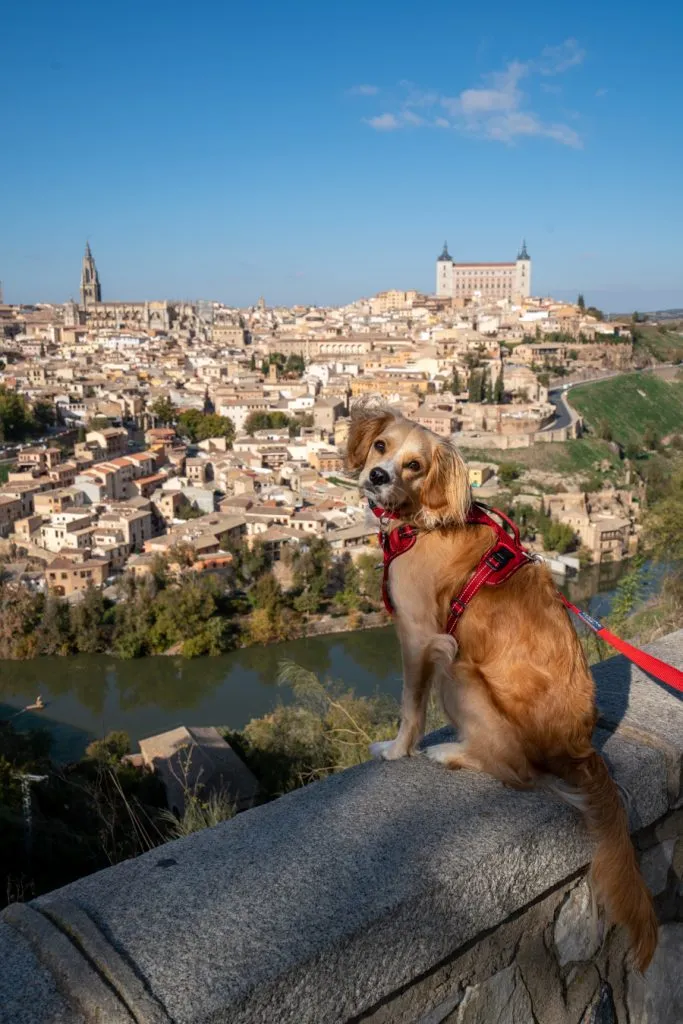
Since this 10 days in Spain itinerary is focused on cities, there’s no need to rent a car or drive on this route!
The simplest (and most fun) way to travel between each destination on this itinerary is via train.
For most places, you’ll have the choice of a high-speed train (more expensive but much faster), or a slower regional train.
We recommend comparing train schedules and prices via Omio , the service we use to book many trains around Europe.
Spain’s high-speed AVE trains, like many high-speed trains around Europe, use dynamic pricing–in other words, you should lock down your fares as soon as you can commit to dates!
Once you’re in a given destination, each city is walkable (with the help of public transportation and/or cab rides in certain places).
Shop train tickets for your trip to Spain today!
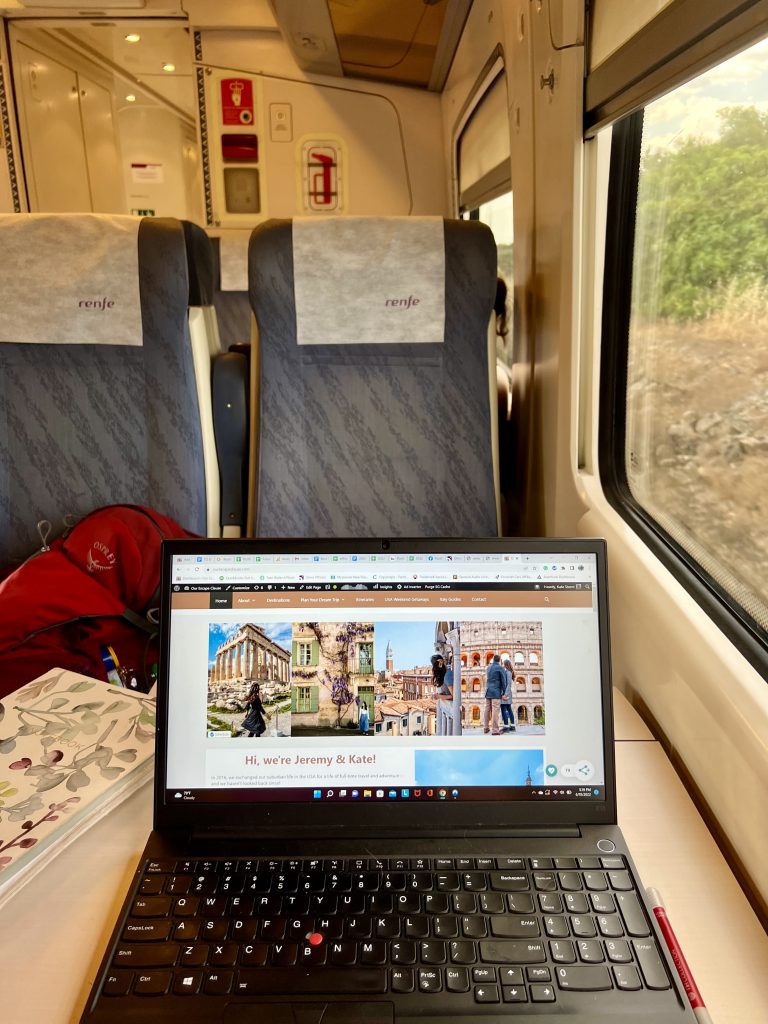
Day 1: Arrive in Madrid and start sightseeing.
There’s nowhere better to kick off your 10 days in Spain that in the vibrant capital city of Madrid!
Often underestimated compared to popular Barcelona, Madrid is beautiful, endlessly interesting, and pulsates with life from every corner.
It’s one of our favorite cities in Europe to fantasize about living in, and who knows–one day we might just make it happen.
On your first day in the city, tour the (gigantic, opulent) Royal Palace , check out the cathedral, meander through Plaza Mayor, and stop by the Templo de Debod.
And, of course, your first day in Spain can’t be complete without tapas!
Head to Mercado San Miguel for endless options, or opt for this popular tapas tour to learn the ins and outs of this tradition (knowledge that will be very useful for the rest of your time in Spain).
Book your Madrid tapas tour today!
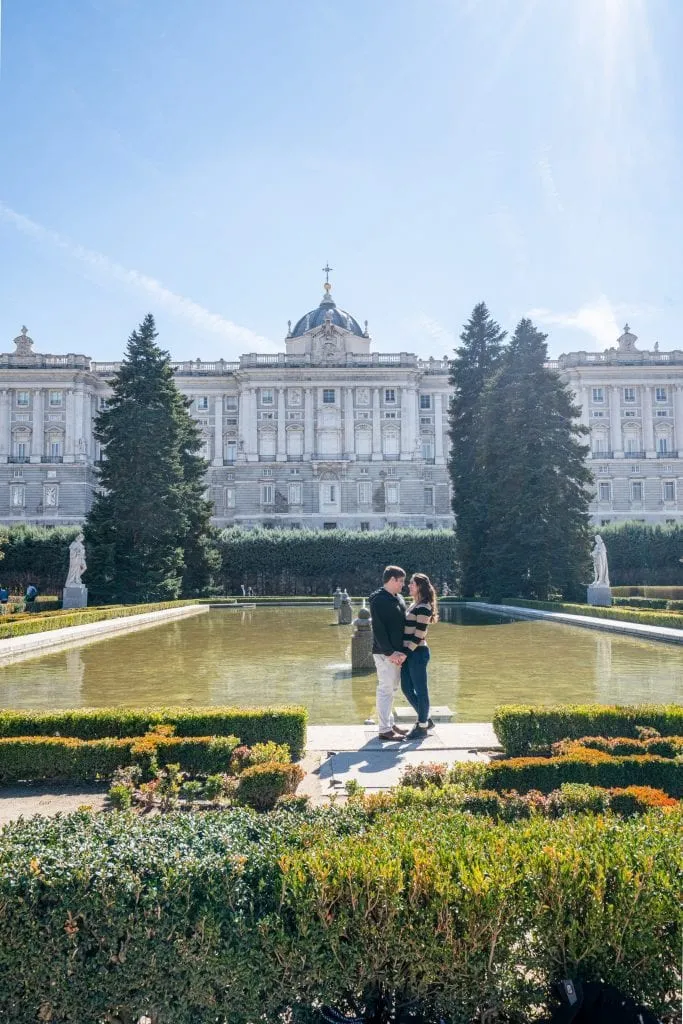
Where to Stay in Madrid
Hostal Adis — Located just off Puerta del Sol and boasting excellent reviews, you couldn’t ask for a better location in Madrid–and at a budget price, too!
Hostal Adis is an excellent property for budget travelers looking for an excellent location and plenty of privacy–rather than being a traditional hostel, Hostal Adis is more like a budget hotel.
Check rates & book your stay at Hostal Adis today!
Hotel Regina — Featuring plush beds, spacious rooms, excellent customer service, and a perfect location near Puerta del Sol, mid-range travelers can’t go wrong with a stay at the popular Hotel Regina.
If you’re feeling like a bit of a splurge, upgrade to a room with a panoramic view for an experience you won’t forget anytime soon!
Check rates & book your stay at Hotel Regina today!
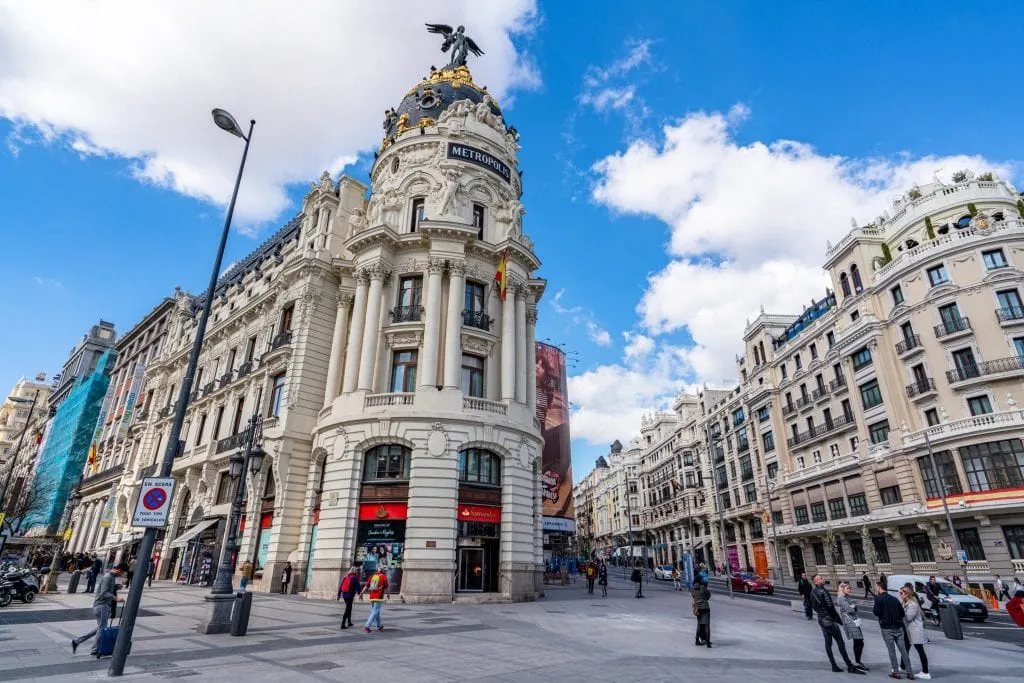
Catalonia Las Cortes — Simultaneously sleek and cozy, modern and traditional, Catalonia Las Cortes is housed in an 18-century building in the heart of Madrid and has blended together all the best of classic atmosphere and modern convenience.
We’ve stayed at a few Catalonia hotels over the years and have always been impressed.
An excellent location near Puerta del Sol, rave reviews and beautiful rooms make Catalonia Las Cortes the perfect luxury hotel choice for those looking for a blend of traditional and modern during their 3 days in Madrid!
Check rates & book your stay at Catalonia Las Cortes today!
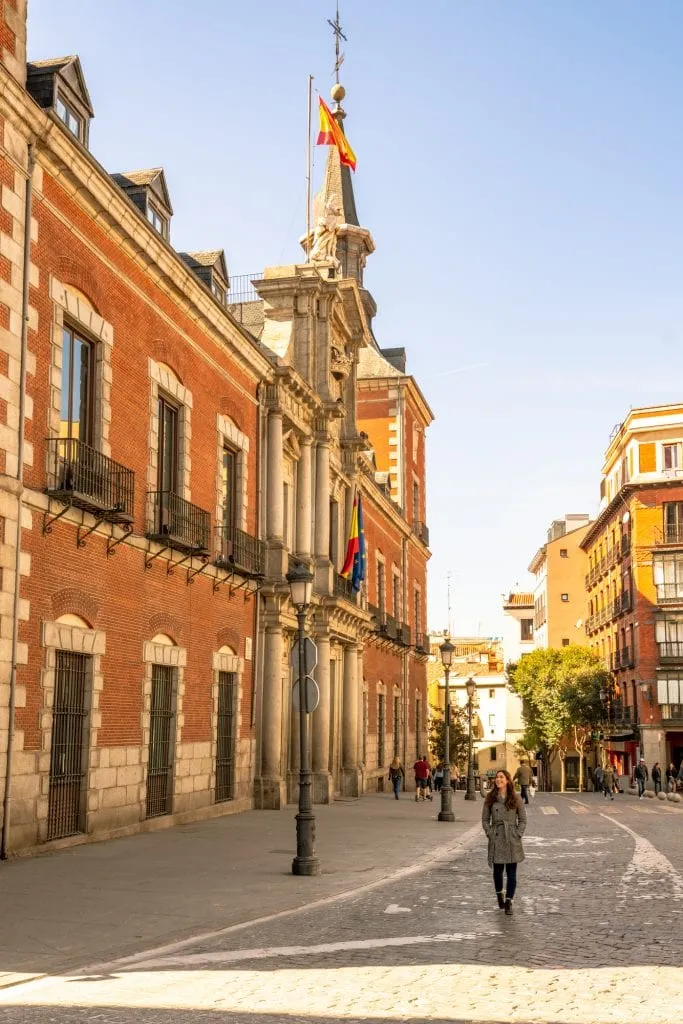
Day 2: Enjoy a second day in Madrid.
The second day of this itinerary for Spain opens with one of the most memorable art museums in the country: Spain’s National Art Museum, the Prado.
Packed with masterpieces (primarily Spanish, but also from across Europe), the Prado is one of those museums that we never get tired of.
Skip-the-line tickets are a great idea here, but for the most context (and efficient sightseeing), consider taking a tour in order to make sure you see the best of Velázquez, Goya, El Greco, and beyond!
Book tickets to visit the Prado today!
Once you’re ready to move on, head to the delightful Retiro Park.
With gardens to explore, rowboats to rent, statues to admire, lawns to lounge on, and even the Palacio de Cristal to enjoy, Retiro Park is a wonderful place to relax.
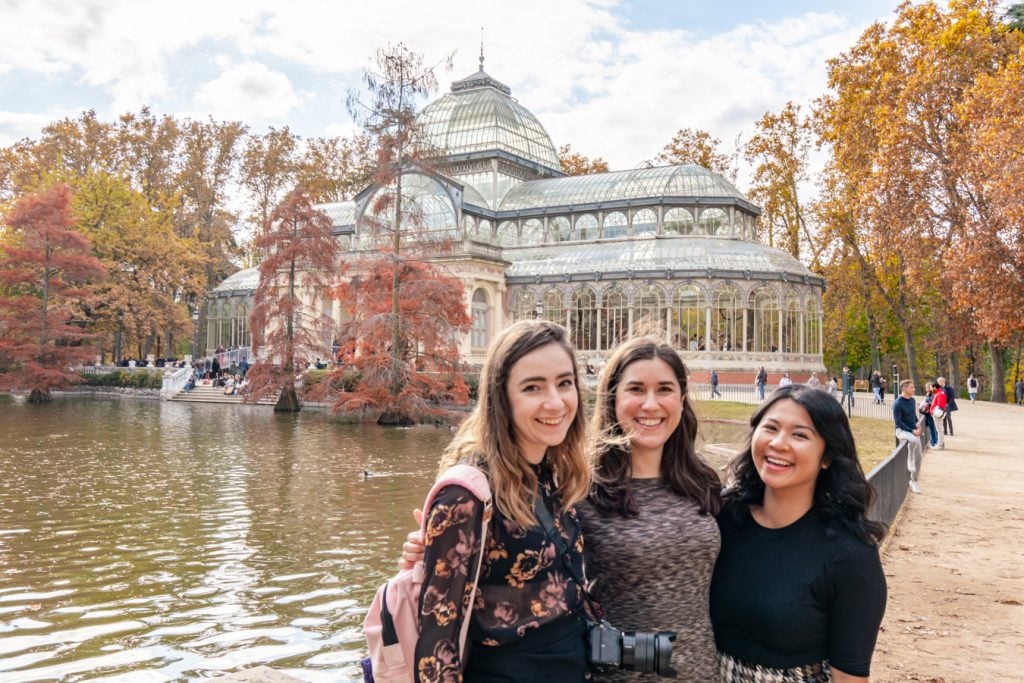
Eventually, make your way to the exit by the Puerta de Alcalá and head up Gran Vía to check out some of Madrid’s most famous architecture!
This shopping street is where you’ll find the iconic Metropolis Building (the rooftop bar and restaurant on top of the Círculo de Bellas Artes has an amazing view of it!), as well as the Cybele Palace.
Branch off to explore the Puerta del Sol and lively La Latina neighborhood in the afternoon and evening!
Don’t wrap up your last (full) day in Madrid without at least one round of churros con chocolate at Chocolatería San Ginés , either.

Day 3: Take a day trip to Toledo.
Today, it’s time to leave the capital behind and take a day trip to the beautiful medieval city of Toledo.
Set about 35 minutes away from Madrid by high-speed train (or about an hour by bus or car), beautiful Toledo is easily one of the best day trips from Madrid.
Surrounded on 3 sides by the Tagus River, Toledo is as charming to look at as it is historically relevant.
The city once briefly served as the capital of Spain, and was even an independent kingdom at one point!
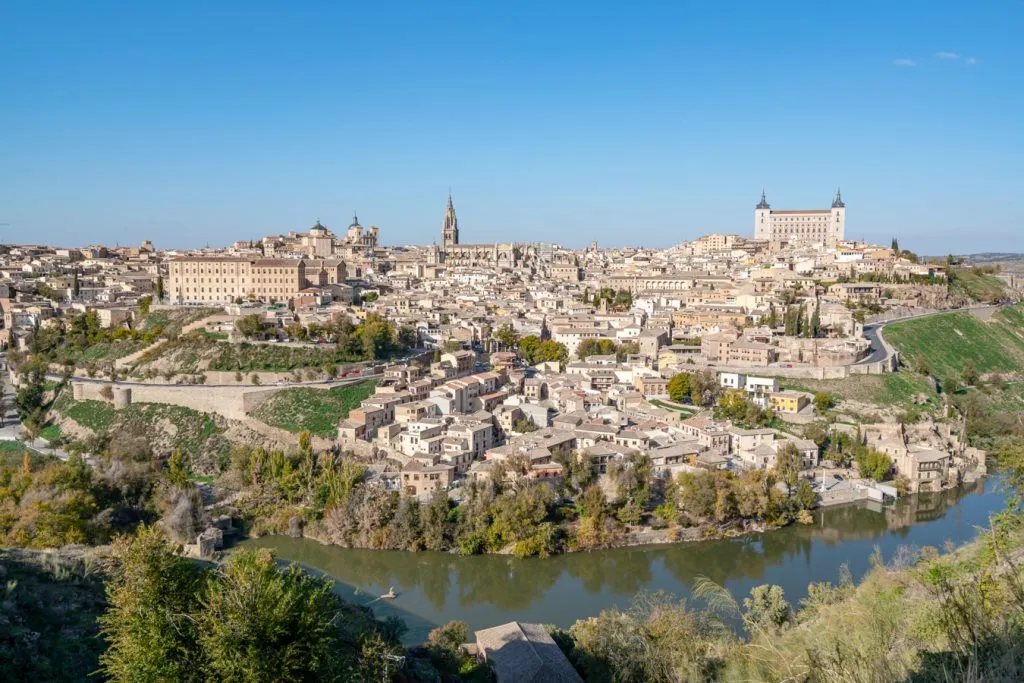
Some of the best things to do in Toledo include visiting the magnificent Toledo Cathedral, touring the Alcázar, stepping inside the Monastery of San Juan de Los Reyes, and meandering through the city’s charming streets.
Don’t miss the viewpoints of the town from across the river, either!
You can easily take the high-speed train to Toledo yourself for the day, but if you prefer the context of a tour (and/or want the easiest access to the viewpoints from across the river), this popular day trip is also an excellent option.
Book your day trip to Toledo today!

Day 4: Head south to Seville.
Sunshine, sour orange trees, flamenco, and some of the most fascinating architecture in Europe await in the next part of this Spain itinerary: welcome to Andalucia.
This is one of our favorite regions in Spain, and it always seems to keep drawing us back.
A roughly 2.5-hour high-speed train journey will deliver you from Madrid to Seville, the capital of the Andalucia region and an excellent jumping-off point for your explorations.
We recommend taking an early train down from Madrid, dropping off your luggage at your hotel (most are happy to hold it until check-in for you), and starting your sightseeing.
Today, be sure to check out the stunning Seville Cathedral , climb to the top of the Giralda (bell tower) for beautiful views of the city, wander through the famous Plaza de Espana, and explore the delightful neighborhood of Barrio Santa Cruz.
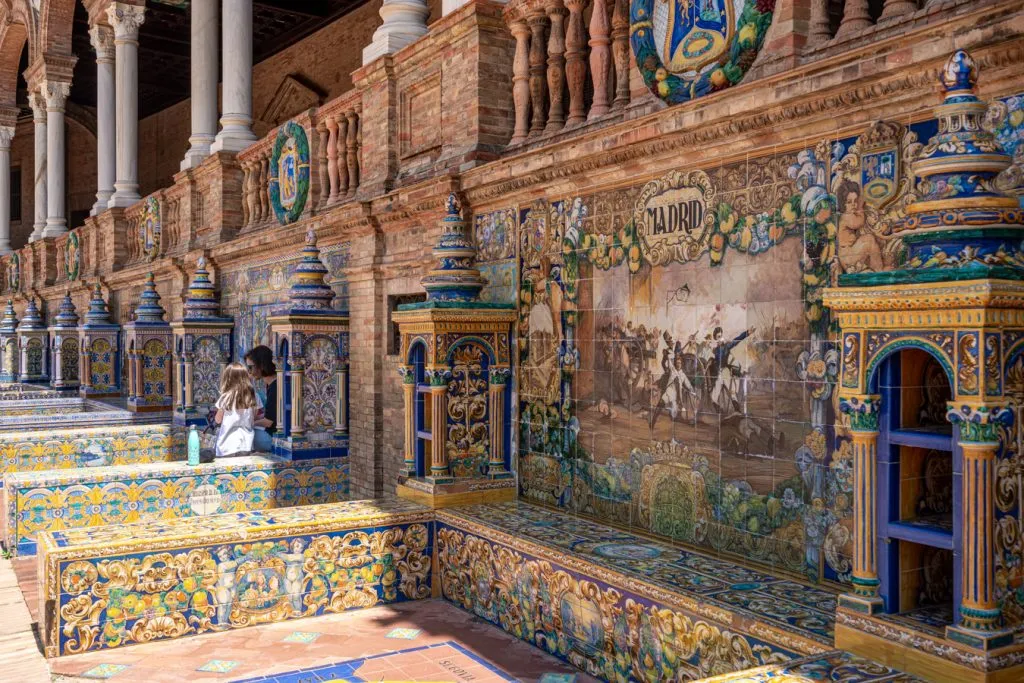
The Royal Alcazar of Seville is stunning, and also one of the best attractions in town–but we’d only recommend visiting today if you’re a really big architecture fan.
As amazing as the Alcazar is (and it is, truly), it’s somewhat overshadowed by the Alhambra, which you’ll see in another couple of days when following this 10 day Spain itinerary.
On the other hand, if you’re interested in adding a flamenco show to your Spain itinerary, Seville is the place to do it.
Andalucia is widely considered the birthplace of flamenco (though the specific origins are debated), and a flamenco show like this is a wonderful way to close out your evening.
Book your flamenco show in Seville today!
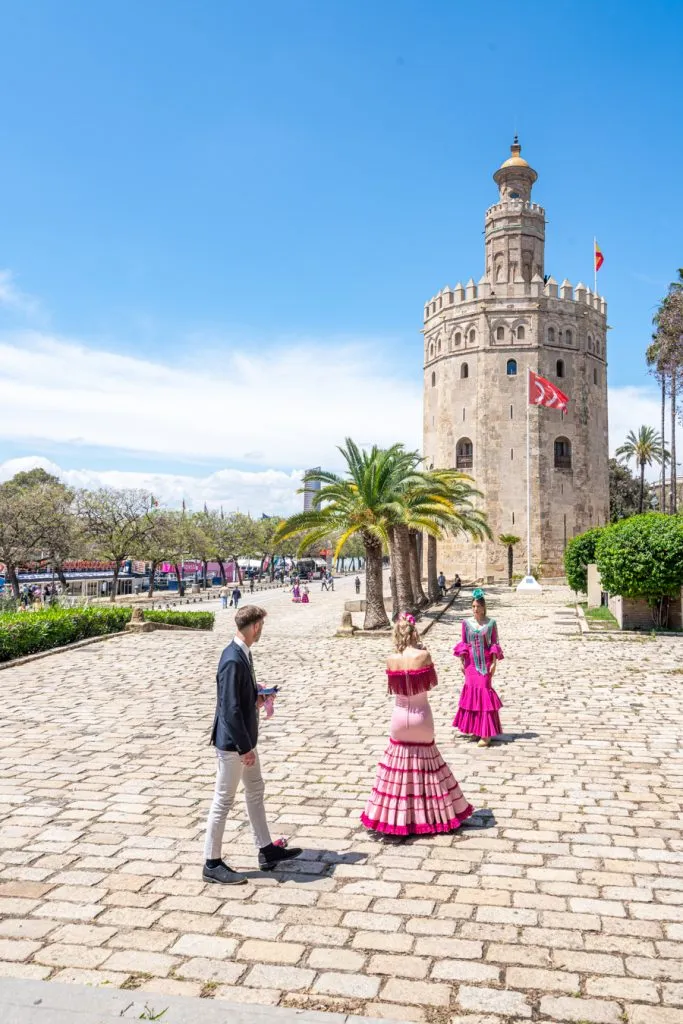
Where to Stay in Seville
When deciding where to stay in Seville, location is key as ideally, you’ll want to stay within walking distance of Seville’s best attractions.
We had a fantastic experience at Petit Palace Puerta de Triana on our most recent trip to Seville.
The hotel has a fantastic location (central but also quiet–a far-from-guaranteed combination in Spain), a delicious breakfast, and comfortable rooms.
Looking for something a bit different?
The incredibly popular Hotel Rey Alfonso X is an excellent choice, and its rooftop views are sublime!
If you’d like to stick to more of a budget, Hotel America Sevilla gets wonderful reviews and doesn’t sacrifice too much in terms of location.
Meanwhile, for the height of luxury, you can’t beat the absolutely stunning Hotel Alfonso XIII !
Check rates & book your stay in Seville today!
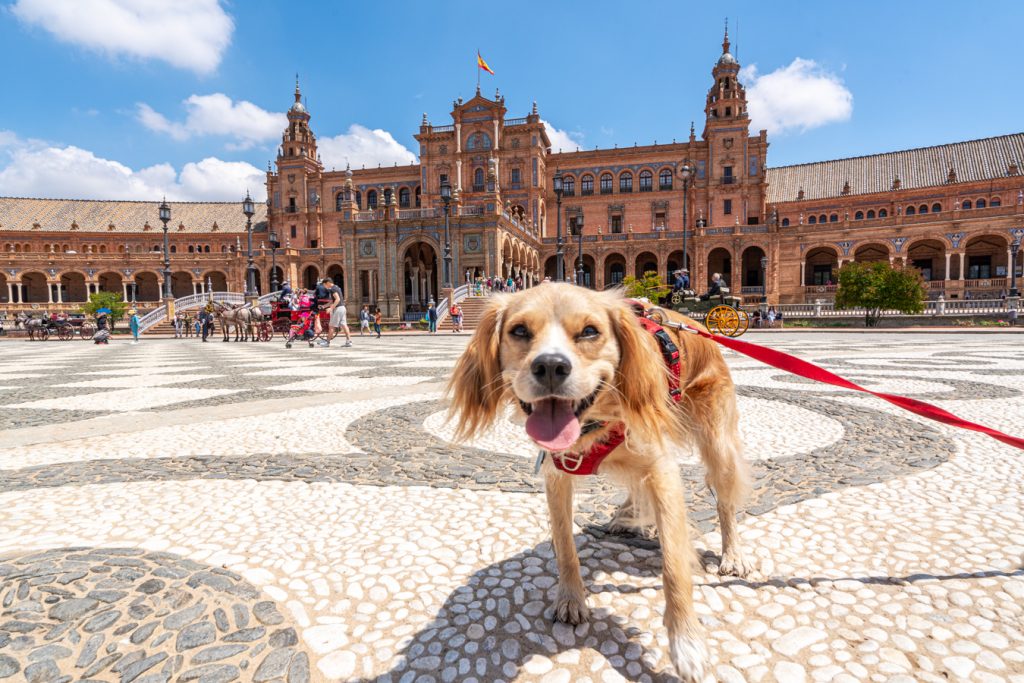
Day 5: Take a half-day trip to Cordoba.
Less than an hour from Seville by train or car, you’ll find the captivating Andalucian city of Cordoba–which happens to be one of our favorite places in the region!
Once the most powerful city in Islamic Spain, the Cordoba of today is small and manageable, a bite-size tourism destination that nonetheless leaves a big impact on visitors.
Cordoba is most famous for its incredible Mosque-Cathedral –literally a former mosque with a cathedral built into its center–which is one of the most memorable buildings we’ve had a chance to visit anywhere.
The Mosque-Cathedral should absolutely be your top priority when visiting Cordoba, but beyond that, there’s still plenty to see within a short walk!
Snapping photos of the picturesque Calleja de las Flores, relaxing in the Patio de los Naranjos, wandering through the Jewish Quarter, and checking out some of the beautiful patios of Cordoba should also be on your to-do list.
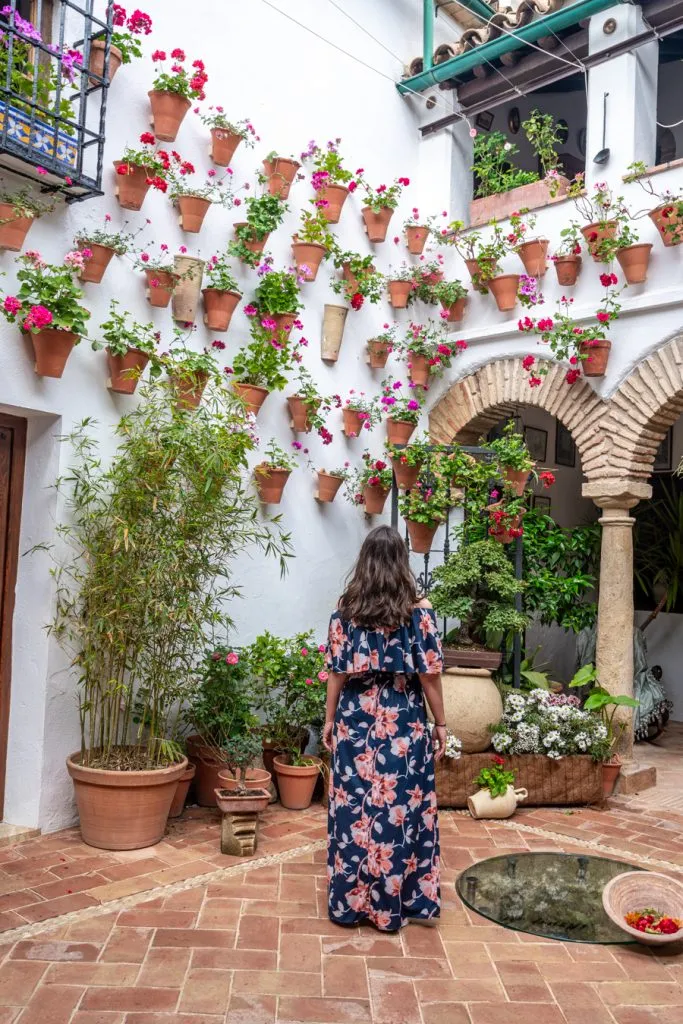
After seeing the best of Cordoba, you have two options for the rest of your day: first, you could enjoy another evening in Seville.
Or, if you’d rather make today particularly busy in favor of having more time for sightseeing tomorrow, you could head onto Granada.
Granada, home to the Alhambra, is about 3 hours from Seville by train or car and is your destination for tomorrow.
You could opt to continue sleeping in Seville and take a long day trip there on day 6, or, if you’re open to packing and unpacking an extra time, you could sleep in Granada starting tonight to give yourself more time in the city.
Personally, we love Granada and would recommend spending extra time there, but both options are compatible with this Spain itinerary.
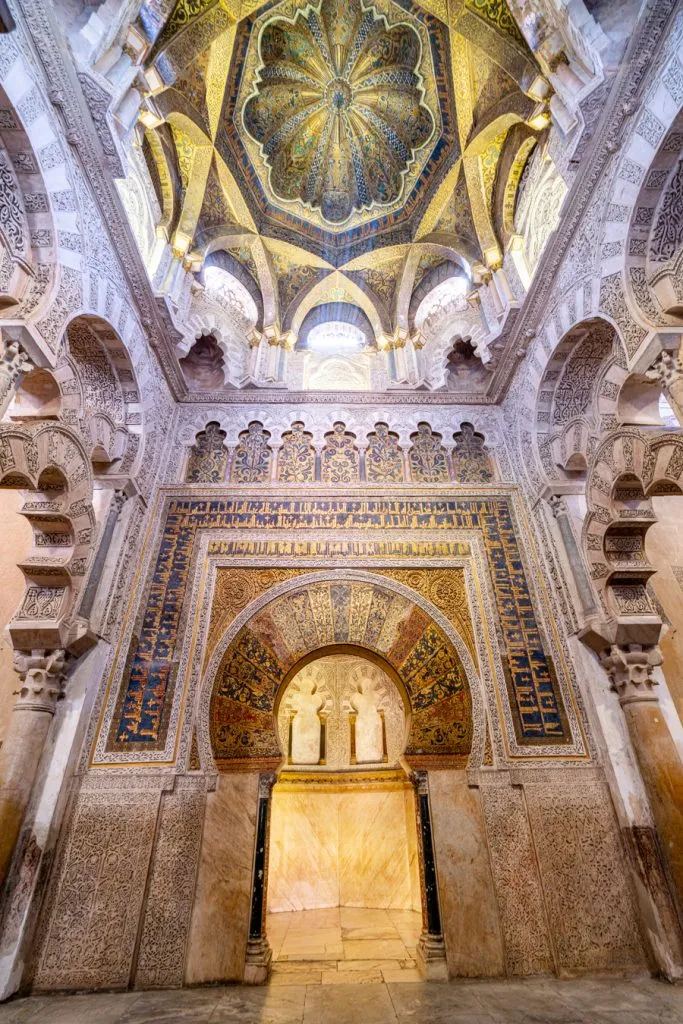
Where to Stay in Granada
When spending a few days in Granada, we opted to rent an apartment from Mosaiko Homes and could not have had a better experience: the owner was responsive, the apartment fantastic, and the location unbeatable!
Mosaiko Homes is located on a quiet street a short walk from many of Granada’s top sights, offering the combination of a convenient location and a lack of noise at night–two things that can be difficult to find together in Andalucia!
Another excellent option with near-perfect reviews is the incredibly unique Casa de Reyes (that decor!).
For a bit of luxury, the popular Shine Albayzin is not only housed in a 16th-century palace, it overlooks the Alhambra .
Generally speaking, lodging in Granada is much more affordable than in, say, Barcelona or even Seville.
If you’re going to splurge on a luxury property during your 10 days in Spain, Granada is a fantastic place to do so!
Check rates & book your stay in Granada!
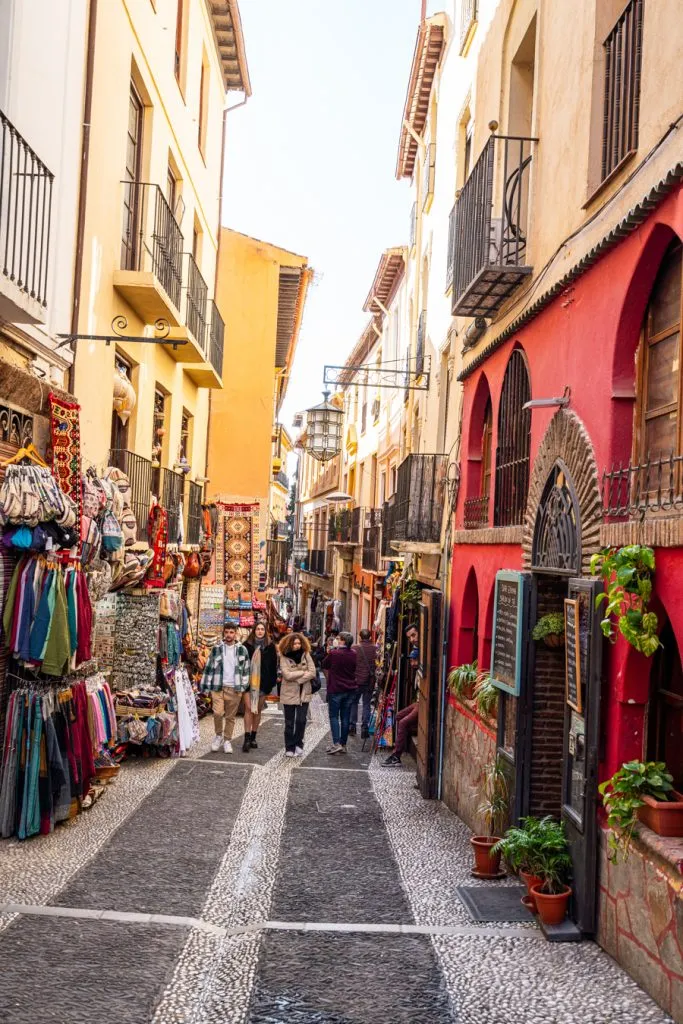
Day 6: Explore Granada and tour the Alhambra.
Whether you’re visiting on a day trip from Seville or spending the whole day in Granada (we recommend the second, but the first is doable too), there is one major item on the agenda today: the Alhambra.
This collection of centuries-old palaces (plus a fort, gardens, ruins of a medina, and more), is one of the most unique groupings of architecture in Europe, and the most-visited tourist attraction in Spain!
We wrote about visiting the Alhambra extensively here , so I’ll try to keep this (kind of) brief, but the long and the short of it is that this is a place you need to plan ahead for.
Tickets often sell out, and a tour is a great idea here if you like historical context ( we enjoyed this one ).
If you’re visiting from Seville, we recommend booking a day trip , because 3 hours of transit each way plus navigating to and from the complex is a headache in a short time frame (we rarely suggest taking day trips this long, but the Alhambra is worth it).
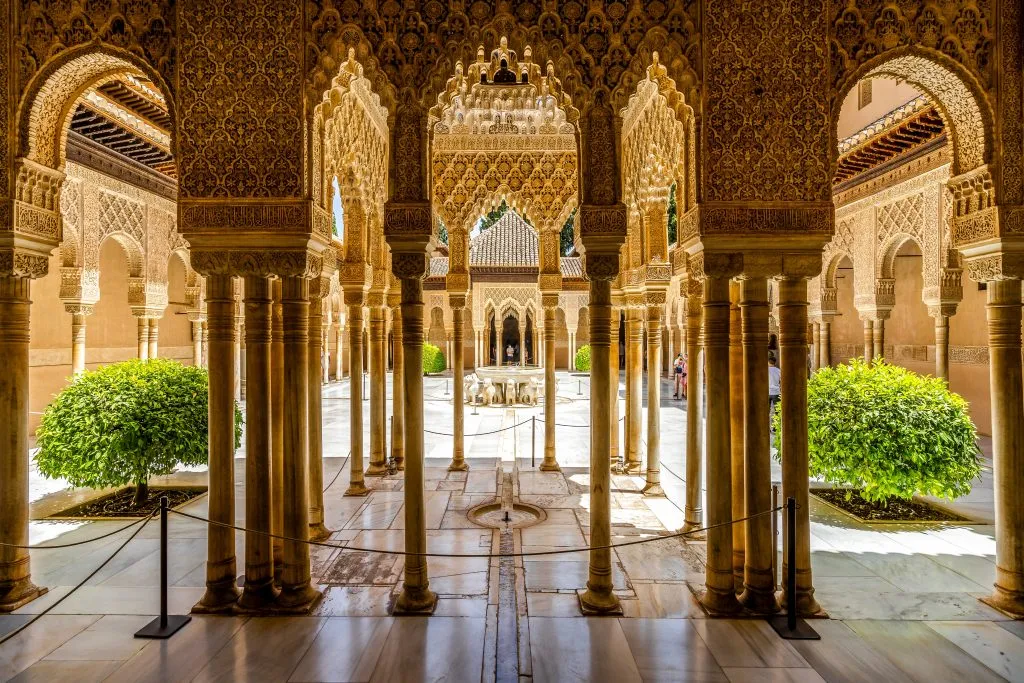
However you decide to visit, make sure that you book a ticket or tour that includes the Nasrid Palaces!
These magnificent palaces, the final stronghold of Islamic Al-Andalus before the Reconquista was officially completed by the Catholics in 1492, are the jewel of the Alhambra and an absolute must-visit.
Not all tours and tickets include them, though, so book yours carefully .
Once you wrap up at the Alhambra, if you’re staying in Granada, be sure to wander through the Albayzin neighborhood, admire the views of the Alhambra from a distance at the beautiful Mirador de San Nicolas, and visit the beautiful Granada Cathedral.
Granada is also a fantastic place to enjoy Spain’s tapas culture, so be sure to indulge in some snacks along with a tinto verano .
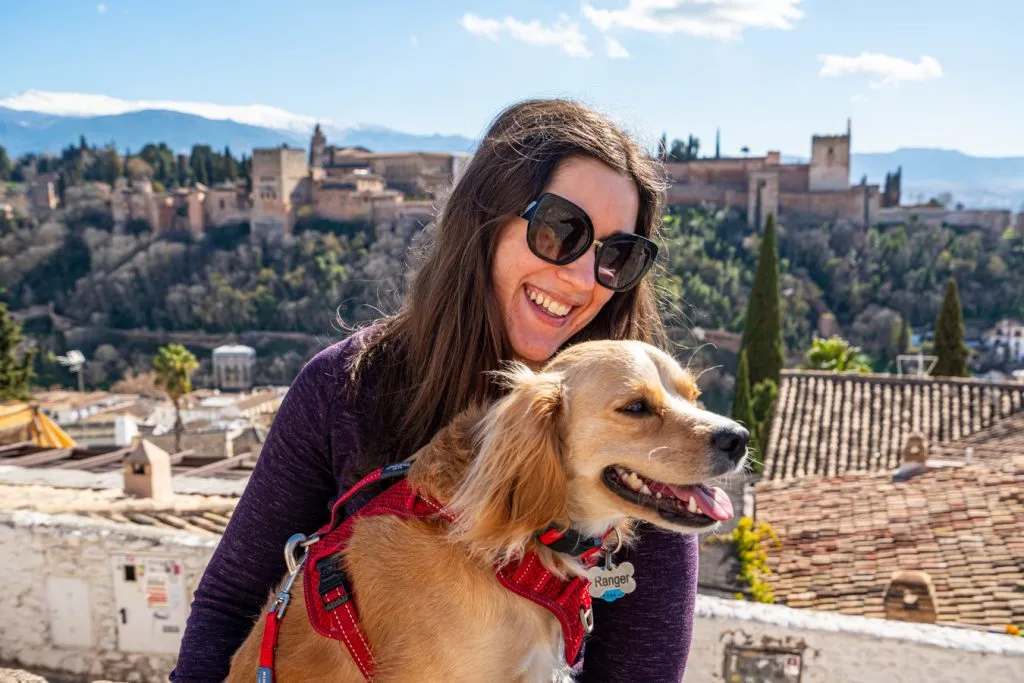
Day 7: Head north to Barcelona.
Today, say goodbye to Andalucia and head north to Barcelona!
This is the longest travel day included on this 10 days in Spain itinerary, and you can expect to spend 6+ hours on a train from Granada to Barcelona.
We recommend booking this trip at least a few weeks in advance, as you’ll want a choice of schedules and to get the best price possible.
If you’re on a budget, you can price out flights too, but traveling by train is much more fun!
Once you arrive in Barcelona, you can check into your hotel, get unpacked, and start exploring.
Meander through the Gothic Quarter, check out the Barcelona Cathedral, sample the Santa Caterina Market, stroll down Las Ramblas, and soak up the beauty of Plaça Reial.
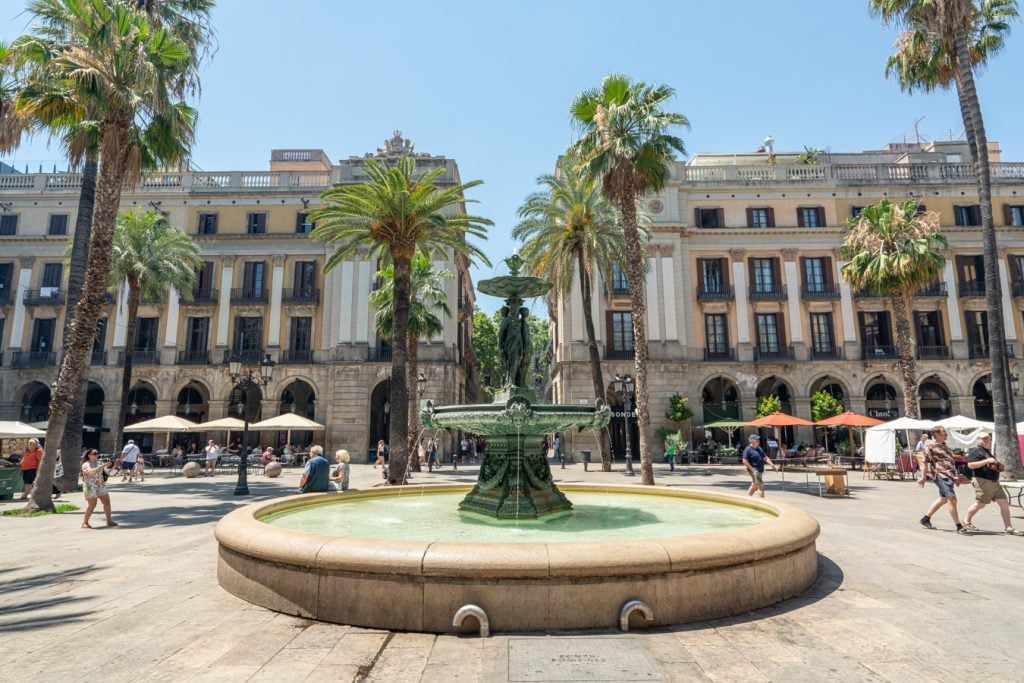
Where to Stay in Barcelona
When deciding where to stay in Barcelona, it’s important to keep in mind that this sprawling city requires some effort to move around–there’s no way to stay near all the best things to see in Barcelona, but it’s best to stay by some of them!
We checked into Citadines Ramblas Barcelona and were extremely satisfied–to the point that we may just keep going back on additional trips.
Our room was spacious, complete with a kitchenette, and extremely quiet despite the hotel being located in a prime spot right along Las Ramblas.
The view of the Barcelona Cathedral from the rooftop deck of the Colón Hotel Barcelona is pretty incredible too, though, and we have it bookmarked for a possible future trip.
If you’re traveling on a bit more of a budget, Hotel Nouvel also gets excellent reviews and is in a wonderful location.
Check rates & book your stay in Barcelona today!
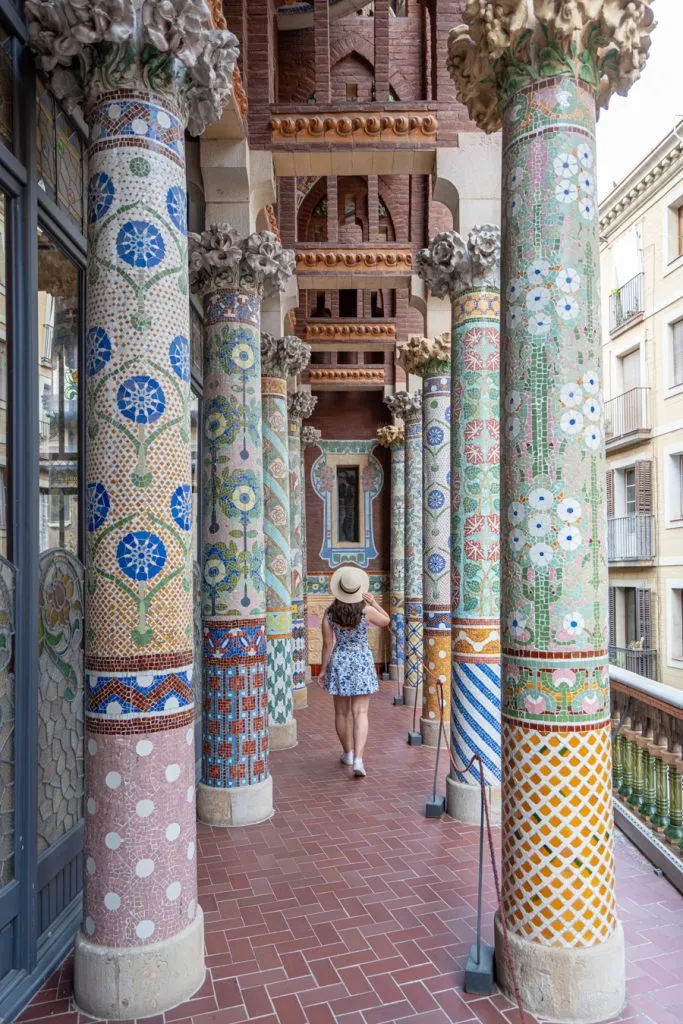
Day 8: Explore Barcelona’s unique architecture.
On your first full day in Barcelona, start with a visit to either Casa Milà or Casa Batlló , two of the most famous homes designed by Gaudi!
They’re fairly close together, but with only a couple of days left in Spain, we recommend only going inside one and seeing the other from the outside.
You’ll also want to get an early start–personally, we recommend pre-booking tickets for Casa Batlló when it opens).
From there, explore any nooks and crannies of the Gothic Quarter you didn’t get to see yesterday, including Catalunya Plaza and Mercado de la Boqueria.

If you’re excited about all of Barcelona’s Catalan modernism architecture, we can also heartily recommend a visit to Palau de la Música Catalana .
Though not designed by Gaudi, it’s an amazing (and compared to much of Barcelona, uncrowded) example of the style and a memorable place to visit!
Barcelona’s Arc de Triomf is also only a 10-minute walk away.
From there, you’ll be about a 25-minute walk from Barcelona’s beaches and bustling coastline.
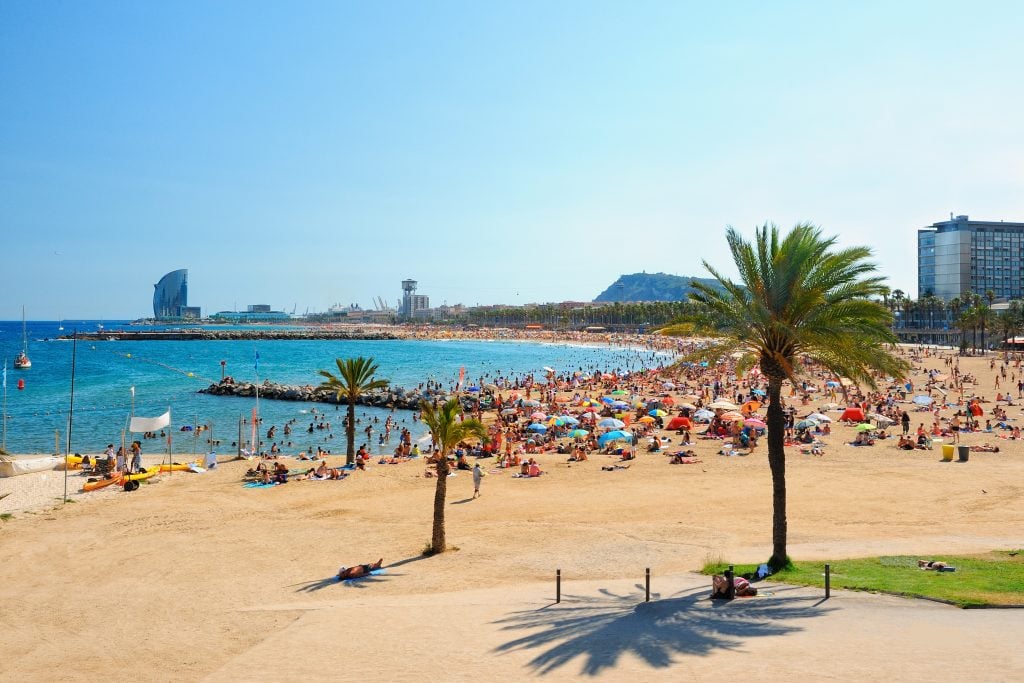
Day 9: Dive deeper into Barcelona (and possibly take a day trip).
With its long list of incredible attractions, it would be very easy to spend the penultimate day of your Spain vacation exploring the city in-depth–but another option would be to add on a trip to the monastery of Monserrat.
This mountain retreat away from the city is known for its incredible views, and a half-day trip there is a wonderful way to get a taste of Catalonia beyond Barcelona itself.
However, staying in the city also has its charms: the views from Park Güell and/or Tibidabo, the incredible Picasso Museum (which holds over 4,000 of the artist’s works), and a visit to Camp Nou are possible additions to your list.
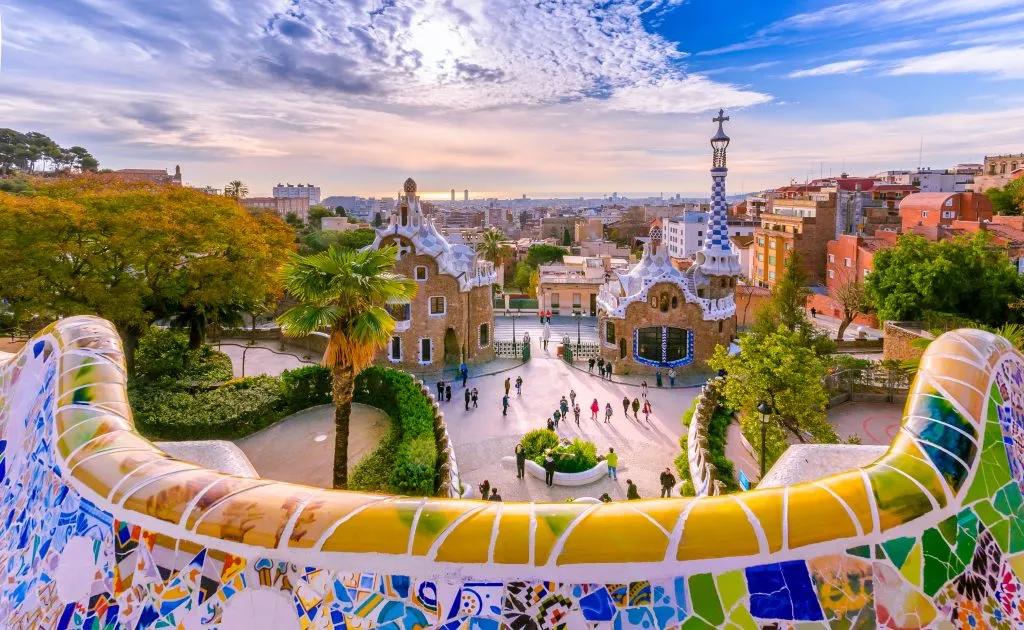
And, of course, we can’t forget the Sagrada Familia : Gaudi’s unfinished masterpiece of a cathedral is an absolute must-see when visiting Barcelona!
We visited in the early evening after hearing that the interior’s light was at its best then, and we were not disappointed–the colors were phenomenal.
If you wrap up at the Sagrada Familia before sunset and would like to enjoy the Mediterranean while in Barcelona, consider wrapping up your evening with a sunset catamaran cruise .
Book skip-the-line tickets to visit the Sagrada Familia today!

Day 10: (Maybe) head back to Madrid and say goodbye to Spain.
How the final day of this itinerary for Spain works for you depends on one factor: whether you’re flying home from Madrid or Barcelona.
If you’re taking an evening flight home from Madrid, you’ll need to take the high-speed train back to the capital (we highly recommend booking this in advance ).
If you’re leaving from Barcelona, you may have time for one more round of pan con tomate enjoyed while admiring the bustling of the city before you catch your flight!
However you close out your 10 days in Spain, we hope you say goodbye already dreaming of your trip back.
Shop train tickets from Barcelona to Madrid today!
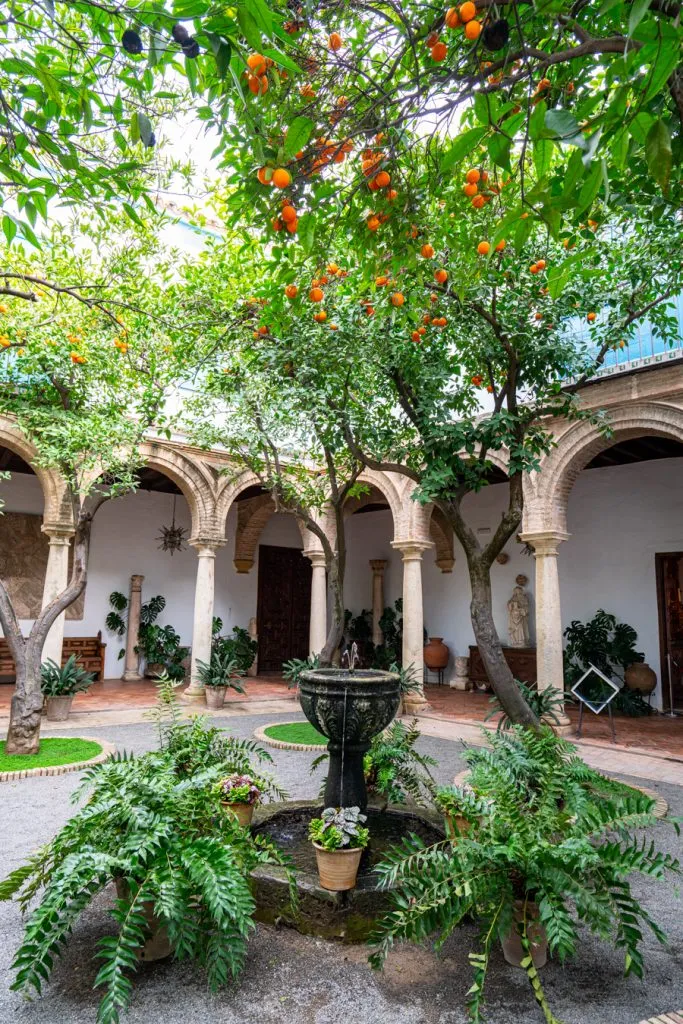
Spain is the definition of a year-round destination, and that includes this Spain itinerary!
That being said, though, if you have flexible dates and are trying to pinpoint the ideal time to travel Spain, we recommend enjoying this itinerary in the spring or fall.
Summer in Spain, especially in Andalucia, can be brutally hot (we shudder to think of visiting the Alhambra at noon in July).
Winter is perfectly doable, but the weather can be rainy and less predictable than in spring or summer.
On the plus side for winter, though, you’ll experience few crowds, low prices, and still have a decent chance at soaking up some Spanish sun, albeit with a jacket at hand.
The sweet spot for this 10 day Spain itinerary, though, which travels a decent chunk of the country and therefore needs to take multiple climates into account, is the spring and fall.
We have visited Spain in every season, and while each trip was a delight, we have a special place in our hearts for our spring and fall visits!
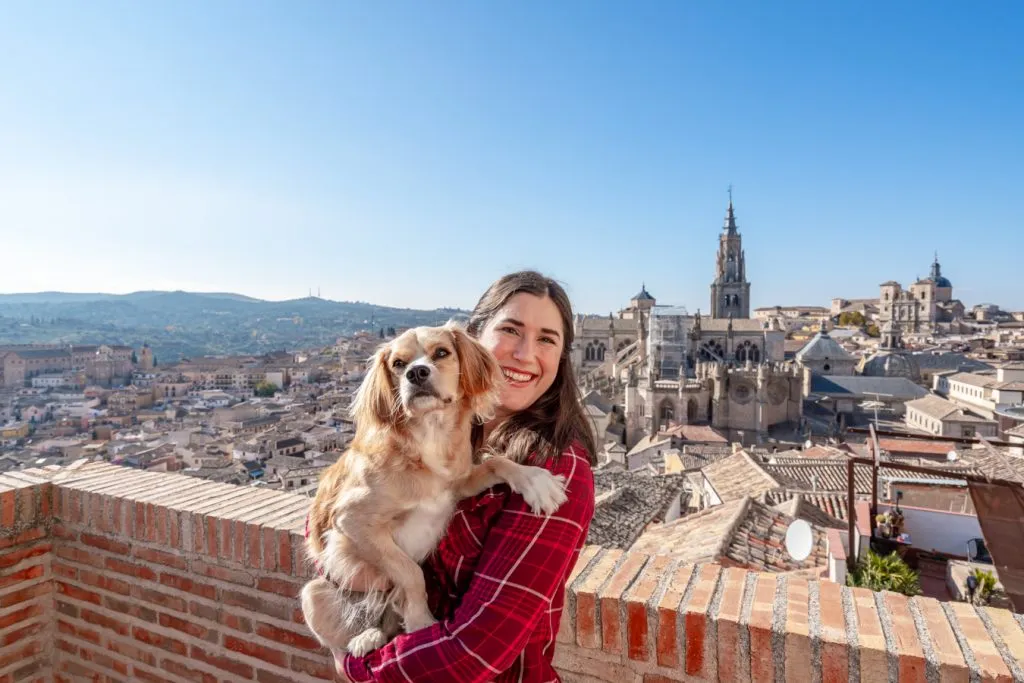
Lucky enough to have longer than 10 days in Spain? If so, congratulations!
Our first recommendation with a couple of extra days to add to your Spain itinerary is to slow down: every destination covered in this travel guide could easily use another day or two at least.
While it’s doable to travel Spain at a breakneck pace for a week and a half, the longer you’re there, the slower you’ll want to travel.
Alternatively, if you want to keep the speed going, you could add on another day trip: visit Girona from Barcelona, Segovia from Madrid, or Ronda from Seville, for example.
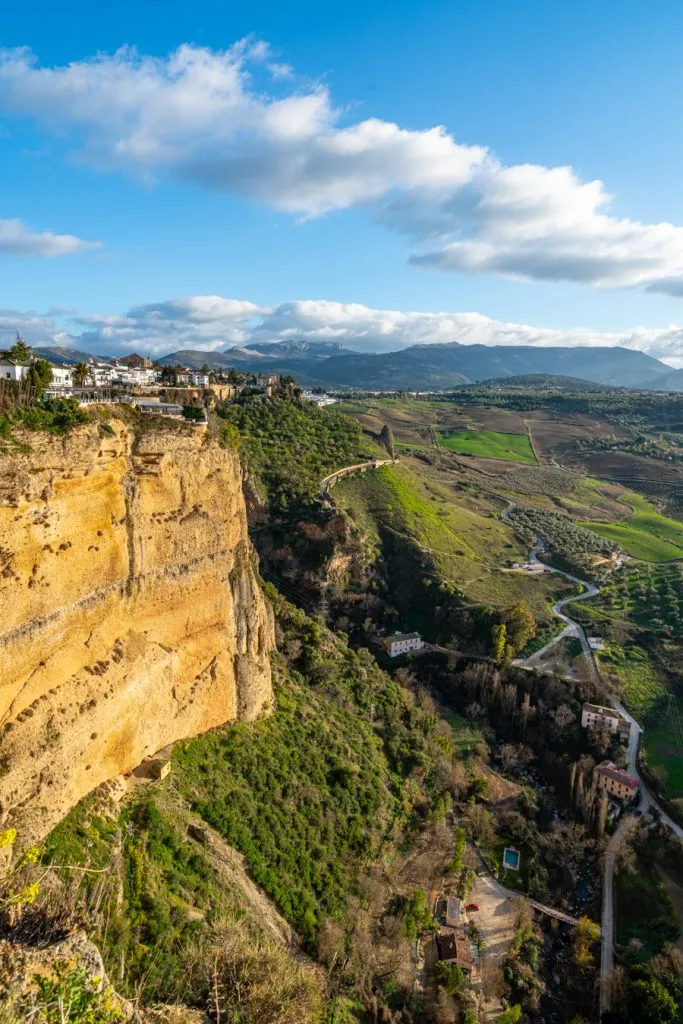
If you have closer to 2 weeks in Spain, consider adding Basque country to your itinerary!
San Sebastián, Bilbao, Vitoria-Gasteiz, and beyond makes for a wonderful extension to round out a couple of weeks in Spain.
Alternatively, you could opt to extend the Andalucia portion of your trip to include a couple of days on the Costa del Sol.
With near-limitless ways to enjoy a Spain vacation, it’s safe to say that wherever you head, you’re bound to have a wonderful trip.
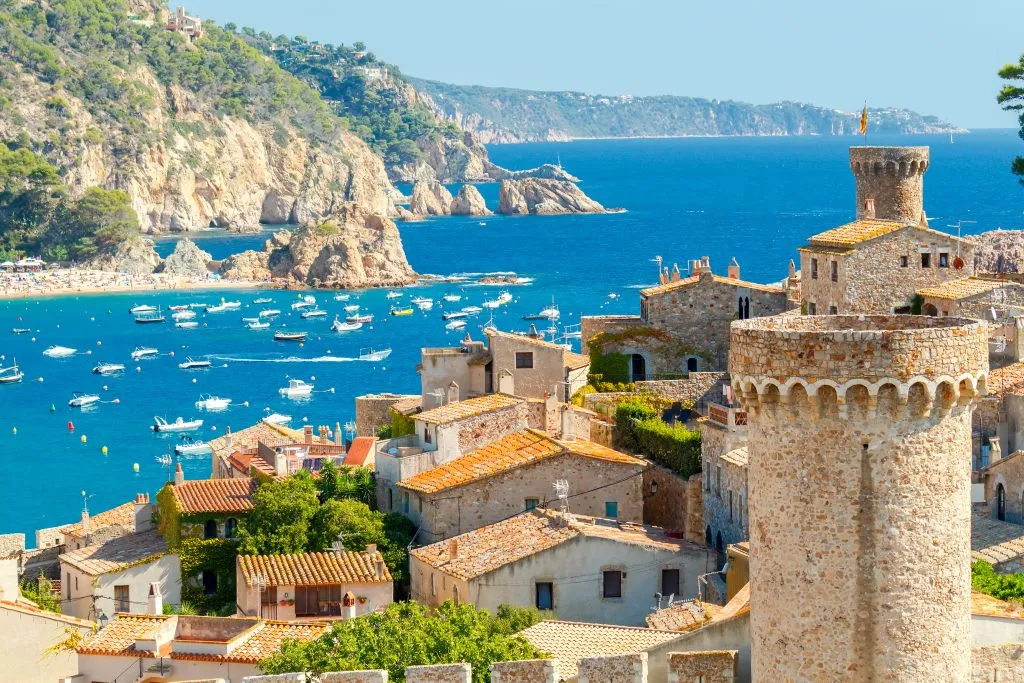
Our detailed packing lists for Europe in summer , fall , and winter cover just about everything you’ll need to bring on your 10 day Spain vacation!
To get you started on your list, though, here are a few essentials to add to your packing list:
Travel Adaptors for Spain — If you’re coming from outside of mainland Europe, you’ll definitely need adaptors for your electronics.
Camera — We completely adore our Sony a7R III , but whatever camera you’re comfortable with works–just make sure you have something with you to preserve your memories!

Comfortable Day Bag — We currently use Pacsafe’s sleek anti-theft backpack and love it, but if you don’t want to shell out the cash for this trip, that’s totally understandable.
Just aim for something comfortable to wear, not flashy, and medium-sized–we used a Northface Jester backpack for years and loved it as well.
Sunglasses — They’re not kidding about the Spanish sun! I find myself reaching for sunglasses regularly even when visiting Spain in winter.
Portable USB Charger — Don’t stress about your phone dying while you’re sightseeing in Spain: bring a USB charger along for the ride.
Take This Map With You! Click each highlight to pull up the name of the destination. To save this map to “Your Places” on Google Maps, click the star to the right of the title. You’ll then be able to find it under the Maps tab of your Google Maps account! To open the map in a new window, click the button on the top right of the map.
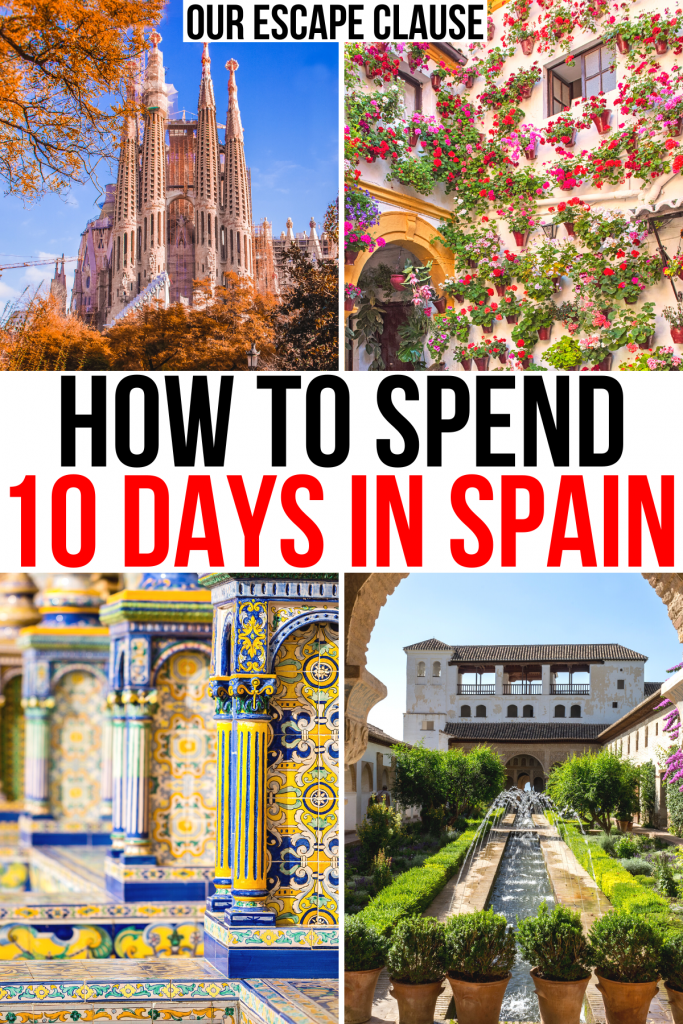
About Kate Storm

In May 2016, I left my suburban life in the USA and became a full-time traveler. Since then, I have visited 50+ countries on 5 continents and lived in Portugal, developing a special love of traveling in Europe (especially Italy) along the way. Today, along with my husband Jeremy and dog Ranger, I’m working toward my eventual goal of splitting my life between Europe and the USA.
63 thoughts on “The Ultimate 10 Days in Spain Itinerary (+ Travel Tips)”
Great overview and suggestions, Kate!
Any suggestions you can offer for an afternoon of wine tasting along the journey?
Thanks, Rob!
We haven’t done a lot of dedicated wine tourism in Spain, though of course, the local wines are delicious. You’ll be near wine regions in each stop, though, so can easily opt for a half-day wine tasting outside the city somewhere.
Alternatively, every city has more excellent wine bars and wine shops than you can count!
Amazing!! Thank you so much for all of this!!
Kate quick question if I may bother you for a bit.
I went through everything you wrote and I calculate maybe about $5,000 would cover the hotel, train and eating expenses between cities for a family of three (My husband and I and our baby girl, toddler) This does not count the air flight ✈️ to Spain.
We were thinking of visiting ending of May or Beginning of June.
Does this sound about reasonable amount to take ??
$5000 (USD, I’m assuming) is very doable, especially if you’re conscious of your budget when booking hotels! I’d recommend booking your train tickets in advance too, as those can be pricier at the last minute.
Generally speaking, Barcelona will be the most expensive stop on this itinerary and Andalucia the most affordable.
Thank you so much!
Thank you so much for creating this! This is extremely helpful and I appreciate all your tips. I am going to Spain in the middle of Semana Santa, but flying into Barcelona and departing from Madrid. I would love to visit the cities you mentioned, but this is the current itinerary I have going. Do you think that this is doable?
DAY 1 – ARRIVAL IN BARCELONA DAY 2 – BARCELONA DAY 3 – BARCELONA Easter DAY 4 – Fly to GRANADA DAY 5 – GRANADA (Alhambra visit) DAY 6 – SEVILLE DAY 7 – SEVILLE (day trip to Cordoba) DAY 8 – SEVILLE DAY 9 – MADRID DAY 10 – MADRID DAY 11 – Fly home
Yes, that sounds like a very reasonable itinerary! You’ll have a great time.
I’d definitely have some food/snacks with you as you’re traveling on Easter Sunday, as you’ll no doubt run into lots of closures.
The week of Easter is also VERY busy in Spain (and in much of Europe), so expect higher-than-usual prices and crowds. I’d recommend booking your hotels ASAP and Alhambra visit ASAP!
I love your site and this itinerary for Spain. We’re spending about 12 days in Spain in early April (unfortunately also over Easter, like Chloe in the message above), and using your itinerary as our template, we want to add a day or two in Gibraltar & Tangier. Have you done this? Too ambitious to add to the itinerary? It would look something like this:
1 – Arrive in BARCELONA 2 – BARCELONA 3 – Fly to GRANADA 4 – GRANADA (Alhambra visit) 5 – GIBRALTAR 6 – TANGIER 7 – SEVILLE 8 – MADRID 9 – MADRID (Toledo) 10 (Easter) MADRID 11 – Back to BARCELONA 12 – Fly home
That is a very packed schedule, but I do get the temptation of adding on a quick day in Morocco (and the UK, in a manner of speaking).
If you want to add on Gibraltar and Tangier, I’d consider trimming a different destination to give yourselves more breathing room, as that’s a tough pace to keep up for 12 days (though doable, if you are dedicated to seeing every last place).
Seville is a gorgeous city, but taking it off your itinerary would give you another day to work with, which you could then add to Granada or Gibraltar, since you’ll really only have an afternoon and evening there.
If you really want to see Gibraltar, of course it’s worth seeing, but if it’s more or less just a stop on the way to Tangier, you could also look at Tarifa, a beautiful Spanish beach city (no passport control) that you can access Morocco from (I believe the ferry is slightly shorter from there, too–we’ve taken that one ourselves).
Alternatively, the high-speed trains do run on Easter, so if that day is more or less just a holding day on your calendar (since the Madrid sites will be closed), you could travel back to Barcelona then, which would give you day 11 back to see a bit more of that city.
Any high-speed trains you do opt for, though, I’d book ASAP. It’s often a mad rush for trains over Easter with people traveling for the holiday.
Thanks Kate. After doing some more reading and research, we’re going to bypass Tangier. Instead, we’ll use that time to explore the towns between Granada and Seville (Thinking Nerja and Ronda) by car. Have you rented a car and driven in southern Spain? Any issues we should know about or is it a pretty standard car rental experience?
Gracias! Chris
We’ve driven in southern Spain many times(including Granada, Seville, Ronda), but generally by renting cars in Portugal and then driving them over.
It’s a pretty standard European driving experience, though–parking outside of historic centers and walking in, etc. If you’re a confident driver I wouldn’t be worried. The driving is also stunning–plenty of chances to enjoy gorgeous views along the way!
There is no condensed itinerary on this page
Here you go, Sarah. 🙂
Day 1: Arrive Madrid Day 2: Madrid Day 3: Day Trip to Toledo From Madrid Day 4: Travel to Seville Day 5: Half- Day in Cordoba Day 6: Granada and the Alhambra Day 7: Travel to Barcelona Day 8: Barcelona Day 9: More Barcelona or Day Trip Day 10: Travel Home
This is a GREAT article. I’m going to follow your itinerary. I’d also like to visit San Sebastián and Cadiz. Could you recommend a way to incorporate these into your itinerary? Thank you!
So glad you found our post helpful!
There’s not an incredibly efficient way to add San Sebastian to this itinerary, as it’s several hours out of the way regardless of where you add it on. It is a gorgeous city, though!
Your best bets would probably be either visiting after Madrid and then flying to Andalucia from San Sebastian, or visiting after Barcelona (especially if you’re flying out of Madrid) and then taking the train back to Madrid to head home.
Of course if you find a good flight to or from San Sebastian you could use it as a starting or ending point, but Madrid and Barcelona tend to have the best deals for transcontinental flights (assuming you’re not coming to/from Europe).
Cadiz is much easier to add on–it’s just an hour or so south of Seville by car, so you can easily add it to your Andalucia leg. Some people even visit it as a day trip from Seville.
Hi! Your trips look amazing! Wondering if you could offer advice. I have 10 days to plan. In my head I will be able to see Madrid, Barcelona, Seville, a beach town, Lisbon or some location in Portugal, and Morocco. As I’m researching, this looks like it might be impossible. Knowing my family would like to hit all 3 countries, what would you offer as a reasonable way to spend these days without feeling crazy and traveling constantly. It is myself, my husband, and kids age 13 & 17 who travel very well. Thanks for any help!
You know, I actually have it on my list of future blog posts to write some sample itineraries combining Spain and Portugal. Thanks for the reminder!
If you want to see all 3 countries in 10 days, the most realistic way is to do it via a sampler platter style, meaning 1-2 base destinations in each of Spain and Portugal, depending on whether you want to take a day trip to Tangier or you plan to spend a few days in Morocco.
One option could be 3 days in Lisbon (with a possible day trip), 3 days in Seville (with day trips further afield–possibly Granda/the Alhambra and Cordoba), 2 days in Tarfia (pretty Spanish beach town with ferries to Tangier), and then a couple days in Tangier. But that’s already pushing it as far as what you can fit in!
Keep in mind that unfortunately, Spain and Portugal are not very well-connected to each other by rail. When you’re short on time, your best options will be renting a car and driving across the border (in the south/if you want to go to the Algarve) or flying (between major cities).
Hi, Thank you for this great itinerary! My husband and I are planning a trip on similar lines this year and I had a few questions I was wondering you could advice us on: 1. Is early September a good time to visit? Would August be too hot?! 2. Is one day in Granada enough? I have heard that Alhambra itself can take quite a while and hence was wondering if one day would be too tight a squeeze 3. Between Barcelona and Madrid, if you had to suggest one for first time travellers, which would you recommend?!
Hi Rushali,
Of course, happy to help!
Early September is definitely preferable to August. It’ll still be warm, especially in Andalucia, but it’ll be much less crowded. It often feels like all of Europe heads to the beaches or mountains in August and then promptly goes home by September 1–so September will be much more pleasant from that angle.
One day being enough in Granada is all dependent on how much else you want to do! In a perfect world, I’d love to rent an apartment in Granada for a few months and take advantage of all the food and nearby hiking. 🙂
But for the purposes of a short trip, one day is enough to see the Alhambra (it will take up the bulk of your day) and then do a quick pass through the rest of town, hopefully prioritizing the Albayzin neighborhood, the Mirador de San Nicholas, and tapas.
If you’re able to add on a second day (or even half day, like I laid out as an option above), you won’t be sorry, though.
Barcelona vs Madrid… that’s an intense debate! Personally, we prefer Madrid, but we’re in the minority. Barcelona is wildly popular (deservedly so!) and has the beach, more outlandish architecture, and a more fast-paced vibe.
Madrid is arguably more elegant, with world-class museums, and is a bit cheaper.
Both are incredible–if you are struggling to decide, I’d make a list of the top 3-4 things you want to see in each city and see which ones pull to you more.
Hope you guys have a wonderful time!
Hi Kate, Would you recommend activities like River Rafting, Hot Springs, Walk in the wild while in Spain? We are planning a trip during early May
If they’re priorities for you and you have time, absolutely! Andalucia in particular has great options for all of those. You might want to look into extending your time in Granada if you want to get outdoors during your trip.
Hi! My husband and I are going on a 10 day trip starting in Barcelona. We go to Mallorca then Seville. Were having a hard time deciding if we want to end in Madrid or Lisbon, any recommendation?
Hi Samantha,
That’s a hard call, as they’re both wonderful but very different!
Very generally speaking, I’d say that Madrid is best if you’re looking for museums, the royal palace, and a chance to travel overland from Seville (it’s an easy train ride).
Lisbon is best for views, being near the coast (you can easily take a day trip to Sintra, Cascais, or both), and the chance to sample another country during your trip. There’s no train service from Seville, you’ll need to fly, drive, or take a bus.
Both offer popular food options, but Lisbon has a bit more of a seafood focus while Madrid tends toward pork.
This is all very general, but I hope it helps a bit!
If you haven’t seen them, our guides to spending a few days in each city will give you a feel for them:
Madrid: https://www.ourescapeclause.com/3-days-in-madrid-itinerary/ Lisbon: https://www.ourescapeclause.com/3-days-in-lisbon-itinerary/
Good luck deciding! 🙂
Hi Kate! Would recommend Lisbon or Madrid if we can only go to one on our trip? Were going to Barcelona, Mallorca and Seville before.
Hi Kate! Thank you for this great itinerary. My husband and I are planning to visit Spain this September (finally will be going on our honeymoon!). We are thinking of being out there for about 10-12 days. I have two questions that I would love your insight on. First, considering we may have extra days, any suggestions on which cities we should extend our stay at? We love wine, great food, and the outdoors. Second, what, if any, restrictions are still in place due to COVID that we should keep in mind? Thank you in advance for your help!
Congratulations on your marriage!
Honestly, any of these cities are worthy of spending more time in, but if I absolutely had to pick, I’d recommend Granada (because your time there is really compressed in the original 10-day itinerary and there’s lots of great hiking just outside of town) or Barcelona (the most popular day trips include the Penedes Wine Region and the beautiful small towns along the Costa Brava–a different kind of nature to appreciate).
I could make a case for any of them, though!
As far as COVID, there aren’t any current restrictions that are likely to impact your trip. I believe masks are still required in pharmacies and hospitals, but that’s about it.
Hope you guys have a fantastic honeymoon!
Hi! Thanks so much for this super helpful blog.. I have a question about transportation. We are a group of 3 ladies arrving from US to Madrid in the afternoon and would like to start our trip in Barcelona and end in Madrid for return flight. I think we will travel via train same day to Barcelona but my concern is luggage. Do you know if trains allow for larger suitcases or will we be met with bag costs?
Thanks so much for any advice!
You can take your luggage onto the train without issue! European trains are much more flexible with bags than any plane is, you’ll even see people bringing sporting equipment and such onboard, depending on the place.
We have many more tips on what to expect on trains here: https://www.ourescapeclause.com/travel-europe-by-train/
Have a great trip!
Hi Kate! I am planning a two-week trip to Spain for my husband and me for next spring. (Your 10-day Spain itinerary has been super helpful!) So far, I am generally following that itinerary with a few extra nights in some places (we have 3 nights in Madrid with a day trip to Toledo, 3 nights in Seville with a day trip to Cordoba, 2 nights in Granada, and 4 nights in Barcelona with a day trip to Girona). My question is, if we still have 2 more nights we can add on somewhere, would you recommend renting a car and seeing some of the White Hill Towns of Spain (with 2 nights in Ronda), or using the Lisbon stopover program and spending those 2 nights in Lisbon (with a day trip to Sintra)? I can’t decide between the two! Any thoughts or suggestions you have would be great! Thanks!!
Definitely a very hard decision! And unfortunately, there’s no right answer.
I’d opt for the hill towns if you’re looking for more peace and quiet with a side of nature, and Lisbon if you’re looking for a city break and palaces (in Sintra). The hill towns are gorgeous but aren’t as heavy on sightseeing as a capital city is.
Lisbon definitely adds more variety to your trip, so I’m inclined to lean that way (the stopover program is very convenient, we used it ourselves several years back), but if hill towns definitely make for a more relaxing trip since you’ll be spending a full week in Andalucia that way.
Hope that helps a bit, but I’m afraid there’s no clear winner or loser here!
I think we are going to spend a few days in Lisbon! Thank you!! 🙂
Hi, how would you recommend adding Ibiza to this itinerary in a 2 week trip?
Hi Rebecca,
Assuming you’re trying to fit everything within 14 days, the only realistic way to do so would be to trim another destination or two. Personally, I’d recommend visiting either Madrid or Barcelona (whichever appeals to you more/has better flight options for you), then Ibiza by plane, then fly to Andalucia from there.
You can take the ferry to Ibiza as well, but I’d recommend looking into an overnight route so you don’t lose one of your days to traveling there.
If you have longer than 14 days and want to add Ibiza as an addition, I’d probably leave from Barcelona and then fly to Andalucia afterward.
Hi Kate, we will be visiting friends who live in Madrid in later March-early April of 2023 (exact dates still TBD). We’re spending a week 3/23-3/31 with them at a rental house in Benimeli, but will likely travel around on our own for another week or two on our own. Your itinerary sounds lovely. Can I ask why you don’t include Valencia? My sister studied there in college and loved it.
For the same reason we didn’t include Basque Country, Mallorca, Galicia, and many more… simply time! Can’t see it all in 10 days, as lovely as that would be, so we focused on the destinations that tend to be a priority for first-time visitors.
Valencia is a beautiful city, though, and would definitely allow you to trim the budget a bit if you swapped it for Barcelona. 🙂
Hi Kate! This is SO helpful!
I’m planning a trip for December, which will be winter and on Christmas Eve/Day. Do you have advice or tips for travelling, where to go, what to do/not do or anything that would be useful for being in Spain at this time?
Thank you!!
In general, expect for things to be closed and everything to be VERY quiet on Christmas Eve and Christmas Day! Some places will be open the morning of the 24th and then close around midday.
I’d recommend stocking up on groceries and planning to spend a relaxed day exploring places that can’t “close”–parks, plazas, etc.
If you’re there before Christmas, check out any Christmas markets that are around! They don’t have quite the same atmosphere as the ones in Central Europe, but they can still be lots of fun.
We’ve already been to Seville (loved it of course), any thoughts on swapping it with Valencia? Curiously nobody in the comments has mentioned it, and you don’t either…we travel in January and seems like a really nice place to visit that time of year. Looks beautiful. 10ish days split between Madrid/Valencia/Barcelona seems easy travel wise too.
Valencia is a beautiful city, and very popular with expats! It doesn’t tend to call as many tourists as Seville, probably due to both location and fame. I don’t know anyone who has visited who didn’t love it, but as most people are working with very limited time, the most iconic cities tend to pull visitors.
I’d have a hard time suggesting someone skip Andalucia entirely if it’s their first trip to Spain (it’s one of our favorite regions, and we’re far from alone in that), but you’re obviously in a different position!
We are planning this trip from Jan 1-11th. Thank you so much for sharing your trip. The only place we are skipping is Granada. Should we try to accommodate a stop there, or leave it for another trip.
1st DAY- MADRID (1)(Hotel Regina, RIU, or any other) 2nd Day- TOLEDO (2) (35 mins highspeed train) 3rd Day- MADRID TO SEVILLA (3) (2.5 hrs highspeed train) 4th Day- Still in Sevilla (Day trip to Cordoba (4)) 5th Day- Sevilla to Cadiz (5) 1hr 24 mins 6th Day- Cadiz to Malaga (6) 3hrs 48 mins (day trip to Marbella(6)) 7th Day- Malaga to Barcelona (7) 6hrs 17 mins 8th Day- Barcelona 9th Day- Barcelona 10th Day- Madrid
Your itinerary is already very full, so if Granada isn’t at the top of your priority list, I think it makes sense to leave it off for this trip!
I’m not sure if you’re planning to sleep in Toledo on day two or take a day trip, but personally, I’d recommend opting for a day trip to keep the transition simpler.
The other day that sticks out is day 6. It doesn’t seem like you have enough time to explore both Malaga and Marbella, so I’d recommend choosing one of them and staying there. If you’re mostly hoping to appreciate Marbella, in other words, I’d just head right there and spend the night instead of taking a half-day trip after spending several hours getting there from Cadiz.
Hope that helps and that you have an incredible time in Spain!
Kate and Jeremy,
Thank you so much for taking the time and effort to educate those of us who will be traveling to Spain for the first time. My wife and I, who are around 70, are planning a 10 – day trip to Spain in September. Your 10-day intinerary sounds fantastic. While we are both in good health, my wife does have a knee that can act up. Based on your experience, is this itinerary a reasonable one for people our age?
The other question I have is whether there is a travel agent you would recommend to help us coordinate everything? We are spoiled as we just returned from a trip to Argentina and worked with an amazing person — both professionally and personally. Plans came together perfectly. Does anyone come to mind?
Thank you, again, for your thoughtful recommendations. It is incredibly helpful and reduces the anxiety of being completely overwhelmed by all the touring options. Happy holidays.
Gayle and Alan
So happy you’ve found our site helpful!
Everyone is different at any age, of course, but I’d say you’d have better luck with this Spain itinerary than, say, a similar one in Italy–fewer hills. You’ll definitely want to take advantage of tours to smaller towns (with possibly some hop on/hop off bus tours), including Toledo, to limit walking in hilly places. For the Alhambra, definitely take transportation up to the palace–it’s a long, steep walk from town.
But Madrid, Barcelona, and Seville all offer lots of flatter walking areas.
Anecdotally, we visited Seville and Cordoba last year with my grandparents in their late 70s, and they found it very doable.
As far as travel agents, no advice to offer there, I’m afraid–we’ve never worked with one ourselves.
Hope you guys have an incredible trip!
I have been practicing Spanish for the goal of traveling to Spain in 2024 or 25 with my family. I wanted to do 10 days and capture all the popular and non-popular but recommended spots. I think this is perfect – going to save it!
That’s great to hear, thanks Anita! Good luck with your Spanish studies–it definitely does a lot to enhance a trip. 🙂
HI KATE HOPE YOU DOING GOOD . UR DETAILED ITENIARY ABOUT SPAIN IS AMAZING . WE ARE PLANNING A TRIP IN START OS MAY . THOUGH WE ARE CONFUSED WHETHER WE SHOULD DO SPAIN OR ITALY . WE HAVE 10 TO 12 DAYS IN HAND , COULD YOU PLEASE SHARE SOME OF YOUR VIEWS TO IT . THANK YOU MARISHA
So happy you found our posts helpful, Marisha!
Choosing between Spain and Italy definitely isn’t easy! Personally, we have a slight preference for Italy, but both countries count among our favorite places to travel. You truly can’t go wrong, so I’d decide which is home to your absolute top 1-2 destinations, whether that’s Madrid, Cinque Terre, etc, etc, and then go with whichever country that is.
Alternatively, you could of course enjoy one city in each country with a flight betweeen!
Here’s our recommended 2 week Italy itinerary if you want to compare: https://www.ourescapeclause.com/2-weeks-in-italy-itinerary/
Thank you for all your wonderful tips! My husband and I are planning a 10-12 day trip to Spain this year and wanted to ask for some advice on cities to see. We love architecture, churches, markets, and music and enjoy walking and exploring new sites.We were thinking of doing the following cities: Madrid (fly in/out of), Toledo, Seville, Cordoba, Granada but wanted to know what other day/overnight trips you would recommend to places such as Ronda, Nerja, Malaga, Andalusia or Estepona. As much as we would love to visit Barcelona we would rather do that on another trip.
Hi Melinda,
There are definitely more than enough day trip options (or overnights) to keep you busy with that timeline! Truly you don’t necessarily need to add any others–slowing down a bit in the places you mentioned will still leave plenty of stones unturned–but if you would like, the white villages (including Ronda, Setenil de las Bodegsas is also very memorable, among others) are a great option.
The Costa del Sol is a bit further, but if you want to spend some time on the beach, Estepona, Malaga, Cadiz, Tarifa, etc, are all wonderful bases as well.
Our Seville day trips guide might give you some ideas, it covers the general area pretty well: https://www.ourescapeclause.com/day-trips-from-seville/
Thank you Kate for the info! Do you mind giving recommendations on day trips vs. overnight stays? I don’t want to feel rushed when visiting a city but don’t mind spending a night or two in places where there’s plenty to see and do.
In your case, if you’re hoping to spend time on the Costa del Sol, I’d pick one base to spend a night or two in down there and potentially visit another spot from that base. Personally, we love Tarifa, while Malaga is very convenient for hopping from village to village. The smaller beach towns are lovely, but I’d opt for one of those if you’re hoping to stay in one place for a bit, as opposed to using it as a place to take day trips from.
The small white villages, like Setenil de las Bodegas, can easily be done as a day trip. We spent a few days in Ronda and loved the slower pace, but you can easily cover over half its main attractions on a day trip as well–just depends on your priorities!
Hi Kate, thank you for creating this itinerary! We used your Portugal itinerary last year and loved it! Planning a 12-day family trip to Spain in July with 3 kids ages 14-17. Currently considering the following: Fly into Malaga (2-3d) Granada (1d) Seville (1d) Cordoba (1d) Madrid (1-2d) /Toledo day trip (opt) Barcelona- remaining time/fly out of Main question- is Malaga worth visiting? Or we can do start/ end in Barcelona. Is it too much? Remove/add something? We don’t plan to rent a car, but may consider if it makes sense for a portion of the trip. Thank you in advance!
That’s amazing you hear you enjoyed our Portugal suggestions, thank you for sharing!
First, Malaga–if you’re wanting to spend a couple days relaxing on beaches, I’d consider going a bit further afield, perhaps to Nerja, Estepona, etc. If you’re just wanting some general sightseeing, a full day in Malaga is probably enough, and I’d consider trimming a day or two there and giving it instead to Seville, Granada, or Madrid.
Malaga has some cool places, and it’s definitely worth seeing the Alcazaba, Picasso Museum, Cathedral, etc. if you fly into there, but I would say that personally, we find it the least compelling city on your list (which is admittedly a list with very stiff competition).
You may already be planning on this, but I’d definitely take a day trip to Cordoba from Seville rather than spending the night there to avoid the hassle of changing hotels again–it’s a very easy day trip.
If you trim a bit from Malaga, I think you’ll be moving at a very doable pace, and agree there’s no need for a car on this route.
Enjoy some tapas for us!
Hi Kate, thank you so much for your reply and additional tips! I was thinking the same regarding Malaga, given the competition :). So reworked the itinerary as follows: D1 Fly into Madrid (seems to be doable with current flight options) D2 Madrid /Toledo day trip D3 Seville D4 Seville/Cordoba day trip D5 Granada D6 Granada D7-D12 Barcelona- /fly out of
A couple of questions: 1. Would you recommend adding a day or two D1-D6, and if so, where? 2. In addition to sightseeing in Barcelona, we hope for some beach time. Would you recommend staying in Barcelona for the beaches? Or is there one that is a reasonable day trip and is worth it. 2a. I looked into Cala sa Boadella, do you have any thoughts on that or any other one? Thank you so much!
Personally I’d suggest adding one day to Madrid to give you time to see a bit of the city in addition to visiting Toledo. Gives you a little more time after the flight to get settled, and Madrid is also a very cool city (we love it there).
Barcelona’s beaches are expansive, sandy, and good for relaxing on, but they’re generally not considered the best beaches in the region. If you’re looking to get out of the city for a little beach time, Sitges is a very easy and popular day trip, and Tossa de Mar offers a combination of beach + castle. There are lots of beach towns nearby, though! A Barcelona expat we know wrote up several day trip options from Barcelona for us and she included quite a few beach destinations: https://www.ourescapeclause.com/day-trips-from-barcelona/
Hi Kate! I am so sorry, somehow I missed your reply, just saw it. Thank you so much, I greatly appreciate it! Love Barcelona day trips, we will plan to do at least one. Thank you again!
Hi Katie I just read through your entire itinerary and it sounds great. My husband and I and our two adult children are flying into madrid, arriving on 4/15 and out of Barcelona on 4/24. We want to visit Sevilla during the Feria de Abril. I was thinking 4/15 and 16 in Madrid. Should we take train to Sevilla on the 17th or plan to leave Madrid on the evening of the16th? Want to do a day trip to Cordoba and see Granada before heading to Barcelona, Could you give me your thoughts how we should alot time in each city
Hi Suzanne,
If you are open to a more fast-paced itinerary, I’d definitely consider an evening train to Seville on the 16th, since it sounds like you’re hoping to fit in quite a bit down there.
From there, I’d recommend spending the 17th-19th in Seville (with one day allotted for Cordoba), then head to Granada on the 20th, see the Alhambra on the 21st, and head to Barcleona the 22nd.
That leaves you with only enough time for a very whirlwind tour of Barcelona, but since you’re hoping to enjoy the Feria de Abril, you won’t want to cut Seville short!
Kate This might be a duplicate comment. Going to Spain arriving in Madrid 9am on 4/15/24 and leaving from Barcelona on 4/24/24. We want to see El Palacio Real and Prado museum for sure. We are thinking of just staying one night in Madrid and then heading to Sevilla. We would like to go to Toledo. Should we go from Madrid or Sevilla? We are not interested in other museums in Madrid but have considered 2 nights in Madrid. We also want to go to Granada before Barcelona. Not sure how to split up our days. Any suggestions? We are traveling as a family with my husband, 31 yr old daughter and 28 yr old son. Also what are would you suggest if we would rather get an apartment than hotel in Madrid
Just saw you left two comments! I also have a message for you under your other one. 🙂
For Toledo, I’d recommend taking a day trip from Madrid and not changing hotels. You will have to double-back slightly that way, but overall it should be more efficient than changing hotels again, as the city is really very close to Madrid.
As far as using a hotel vs apartment in Madrid, there are pros and cons to both (and we use both depending on the trip). For such a short trip, though, we’d personally probably opt for a hotel unless you’re planning on eating most of your meals in an apartment versus going to markets/restaurants. If you do opt for an apartment, I’d carefully peruse the reviews for noise, as it can be an issue in Madrid depending on the street and neighborhood!
Not sure about the festival but we will be there during that time. How much time should we consider spending in Sevilla? If we want more time in Barcelona would you give up Cordoba or Granada?
I’d recommend making your you have one full day in Seville itself, excluding days you arrive, depart, or take a day trip to Cordoba. Here’s what we’d recommend doing with one day in the city: https://www.ourescapeclause.com/one-day-in-seville-itinerary/
As far as Granada versus Cordoba, they’re both wonderful.
Based purely on sightseeing, I’d recommend Granada, as it’s a distinct city that has a very different feel than Seville, and it also has the Alhambra, which is easily one of the best historic sites to visit in Spain.
However, Granada can’t easily be done as a day trip from Seville (you really need an organized tour for it, and even then, it’s a very long day), so I’d make the decision based on whether you want to keep your pace of travel slower (in which case I’d visit Cordoba), or if you want to prioritize seeing as much variety as possible in limited time, in which case I’d visit Granada but make sure to spend at least one night there.
That being said, we love Cordoba too! The Mosque-Cathedral is an unforgettable building, and either city will be a great addition to your trip.
Leave a Comment Cancel reply

Home » Destinations » Europe » Spain » 5-14 Day Spain Itinerary: A Guide For Planning Your Perfect Spain Trip
5-14 Day Spain Itinerary: A Guide For Planning Your Perfect Spain Trip
Links in this article may earn us a little money if you book/ order stuff. More here .

Plan Your Perfect Spain Itinerary with These Detailed Templates!
Want to explore Spain but confused about the perfect itinerary? You are not alone! It can be a true challenge to determine how many days to spend exploring.
From 5-day Spain itineraries to 7 or 10 days, to 14-day itineraries – there are certainly lots of different routes and options to choose from. The hard part? None of the routes are necessarily bad or wrong since there’s just so much to see and do all around Spain!
Spain is one of the most visited countries in the world. Because of its popularity, Spain knowledge is really flowing around the travel world these days!
It’s no secret that Lisa lived in Spain and took full advantage of her location (and her Spanish language knowledge)! So, she’s experienced quite a few of the places we recommend below for a great stop on your itinerary!
Spain Itinerary Overview
Best Time to Visit: Generally, summer is the hottest and winter is colder and wetter, but regional exceptions apply. March-June and September-end of October are best.
Getting Around: Trains ( RENFE ) and buses ( Alsa ) are reliable. A rental car in Spain is a must-have for smaller towns.
Popular Places to Visit: Barcelona , Madrid , and Valencia for larger cities, and Granada , Seville , and Córdoba are worth a look, too.
Where to Stay: Check for hotels in Spain here and Check for hostels in Spain here .
Table of Contents
Spain Itinerary – 5 Days
If you plan on travelling through Spain for only 5 days, it’d be best to fly into one of the bigger cities as they are usually well connected with other European cities.
Depending on your route, you can either take public transport if the travel times align with your plans or opt for a rental car if you would like more flexibility.
As with the other Spain itineraries in this blog post, our 5-day itineraries are pretty fast-paced. However, since it is pretty much impossible to go top to bottom and actually see parts of the country we decided to write two separate Spain itineraries for 5 days.
One covers the north and northeast of Spain while the other itinerary covers the south of the country . Choose the one that is more suitable for your interest and travel plans and feel free to modify the written itineraries however you see fit!
Spain Itinerary 5 Days – Northern Trip
For this classic 5-day trip across the northern parts of Spain, the total driving time is about 8 hours and covers around 750km .
If you rent a car, given this exact route, there are tolls on most of the highways so keep that in mind that it may be longer if you took non-tolled roads that may be more indirect. A bus would be able to breeze right along these highways, however.
navigate map
Spain Itinerary 5 Days – Northern Trip Overview
Day 1: Barcelona
- Day 2: Half-Day Barcelona/ Zaragoza
- Day 3: Logroño
- Day 4: Donostia-San Sebastián
Day 5: Bilbao
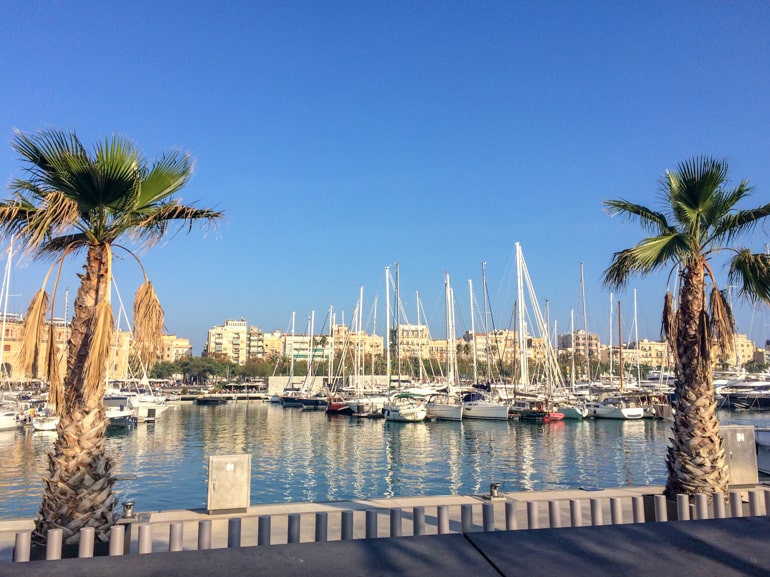
Barcelona is a good city to start a road trip since it is a popular tourist destination and thus has frequent flights to other European or International cities. Barcelona is the capital city of Catalonia which has its own unique culture and language next to Spanish.
Since it is such a popular city, the car rental industry is very well developed and it is easy to pick up a rental car from the airport or in the city.
Find your rental car in Barcelona here .
Alternatively, the bus station in Barcelona is great and easy to reach from the centre. There are numerous connections to Zaragoza which will be the next stop on your 5-day Spain itinerary.
Accommodation in Barcelona : As a super popular tourist destination, there are lots of hotels and apartments available in Barcelona.
Check here for Accommodations in Barcelona .
Specifically, for hotels check out Catalonia Born Hotel with a boutique style and rooftop pool in the city centre and close to the beach.
If you travel by car, Sallés Hotel Pere IV is a lovely and affordable hotel with spa in the heart of the city with a private parking garage onsite .
As for hostels, you can check out Barcelona hostels here. Specifically, we liked Kabul Hostel . This place even made our list of favourite hostels across Europe .
Overall, since Barcelona is so popular we strongly advise you to book in advance – especially during summer – as it can get very expensive otherwise.
Must-see Attractions in Barcelona:
- Sagrada Familia
- Casa Batlló
- The National Catalonian Arts Museum
We’ve written a whole guide on some of the incredible places to visit in Barcelona if you are interested in seeing more!
Day 2: Barcelona/Zaragoza
On the second day of your 5 days in Spain, you’ll spend the morning in Barcelona (you’ll get a cafe con leche y croissant in any cafe/bar for quite cheap if you get off the main tourist roads) and then drive from Barcelona to Zaragoza later in the day.
The drive from Barcelona to Zaragoza will take you approximately 3 hrs 10 min by car (includes a toll road), 3,5 hrs by bus and 1,5 hrs by train . If you end up taking the train, try to book in advance if you can as this will usually end up being cheaper.
Accommodation in Zaragoza: Since Zaragoza is a smaller city, there are fewer accommodations to choose from – but still lots of really great options.
Check here for hotels in Zaragoza .
Specifically, we love the look of Hotel Sauce . This bright and airy hotel is located right in the city centre and offers a homemade buffet breakfast, air conditioning, and private parking onsite for those travelling by car.
If you are looking for a rooftop pool, Hotel Palafox has you covered! Also located right in the heart of the city, the hotel has a cool decor, great city views, tasty breakfast, and also has parking and air conditioning!
There aren’t a ton of hostels but the ones that do exist are well-rated – so you can check here for hostels in Zaragoza .
Must-see Attractions in Zaragoza:
- Basílica del Pilar
- Aljafería Palace
- Cathedral San Salvador
Day 3: Logroño
On your third day, you will drive from Zaragoza to Logroño which is the capital of the autonomous region of La Rioja and known for its delicious wine.
If you get the chance visit one of the wineries and do a wine tasting – please plan ahead if you’re travelling by car since drinking and driving is a big no-no!
The drive will be a lot shorter than the day before. By car, it’ll take you approximately 1 hr 40 min and by bus the journey would be around 2 hrs if you get a direct bus.
Accommodation in Logroño : Similarly to Zaragoza, Logroño is a smaller city with many great accommodations in the heart of the city.
Check here for apartments and hotels in Logroño .
Specifically, Hotel Murrieta is a popular and very affordable option with a good breakfast right in the heart of the city. If you drive a car, Hotel Calle Mayor is a more charming (but still very affordable) hotel with secure underground parking at the hotel.
If you are looking for a hostel in Logroño, there aren’t many but the ones that exist are very good. You can check here for hostels in Logroño .
Must-see Attractions in Logroño :
- Cathedral of Santa María de Redonda
- Church of San Bartolomé
- The Bodegas (Wineries)
Day 4: Donostia-San Sebastián
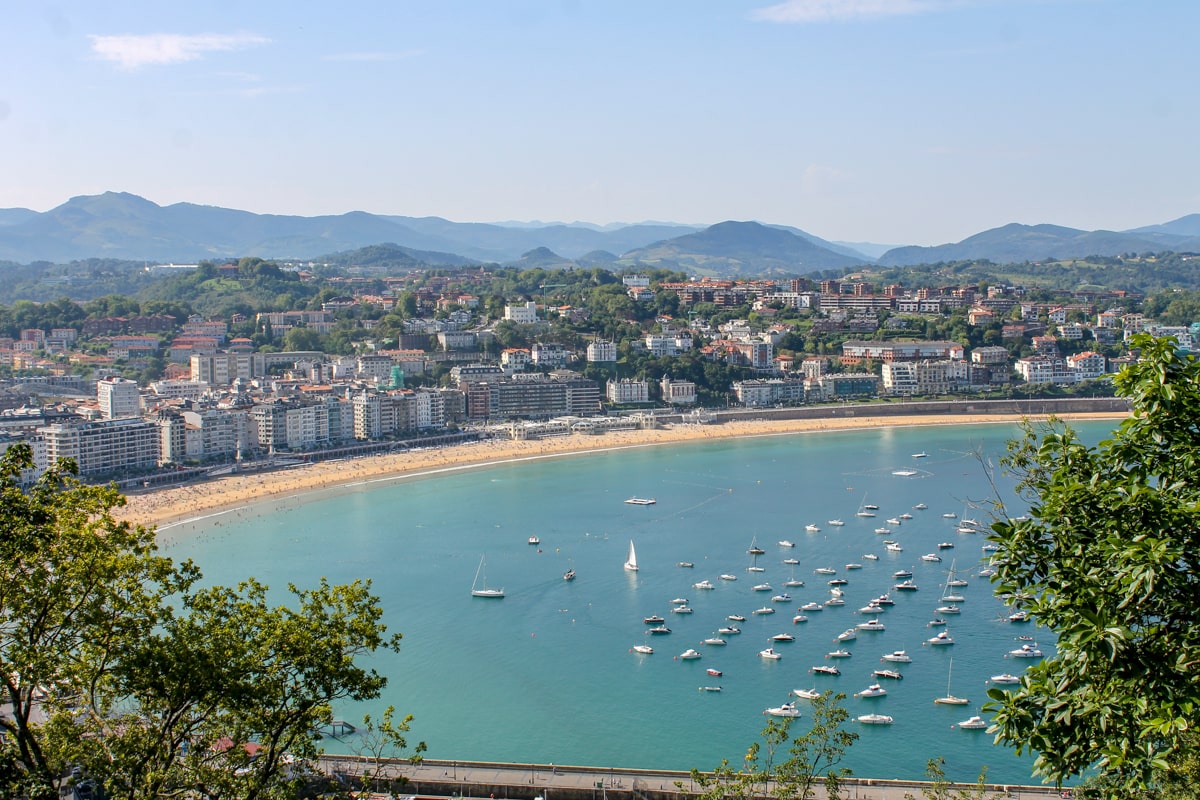
Some would consider San Sebastián one of the most beautiful towns in Spain and Lisa can see why.
When she lived in Bilbao she visited San Sebastián quite a few times and really enjoyed the vibe of the town (and having a beautiful beach so close). Don’t forget to eat some delicious Pintxos since San Sebastián is especially known for them!
The drive from Logroño to San Sebastián takes around 2 hrs by car, and between 2 and 5 hrs by public transport .
Since you are travelling between two smaller cities the connections are not that great and we would recommend planning ahead to compensate for this.
Accommodation in San Sebastián : San Sebastián is one of the most expensive towns in Spain and very popular among luxury travellers.
So, don’t be surprised if accommodations seem a little more expensive overall. That said, you can still find a great place to stay that suits your budget and style if you’re not looking for luxury.
Check here for hotels in San Sebastián .
Specifically, you can check out Casual de las Olas San Sebastián . This hotel is a bit further from the old town and beach but makes up for it in sleek decor, breakfast, and air conditioning.
If you want more of a laid-back guesthouse feel, check out Talaia HT . This authentic and cozy guesthouse is located in the heart of the old town – and has public parking nearby .
If you are looking for a hostel, you can find great hostels across San Sebastián here . Wherever you book, our advice is to book early to find deals and generally save money when booking.
Must-see Attractions in San Sebastián :
- Urgull Hill
- Plays de La Concha
- San Sebastián Cathedral
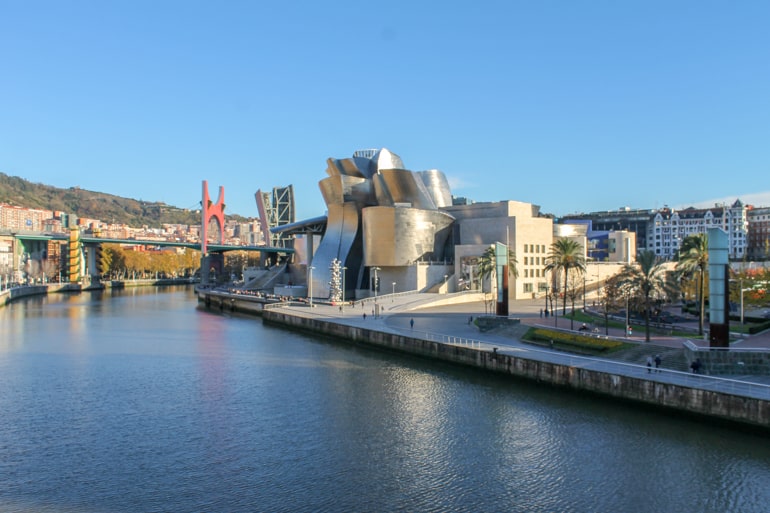
Bilbao has to be one of Lisa’s favourite Spanish cities. Not because it is especially beautiful, but because she lived there for a few months and it felt like home from the beginning. If you get the chance, take the metro to one of the beaches – you won’t regret it!
The drive from San Sebastián to Bilbao is a short and beautiful one as you will drive through some mountainous regions. By car it’ll take you approximately 1 hr 15 min and by bus the journey will be around 1,5 hours .
Bilbao also marks the end of this 5 day Northern Spain itinerary.
Bilbao is a good city to fly out of as it is one of the biggest cities in the region and well connected to bigger airports in other European cities. To get to the airport you can simply take the Airport bus from the bus station at San Mames.
Accommodation in Bilbao : Since Bilbao is a bigger city there is a wider variety of accommodations available.
Check here for apartments and hotels in Bilbao .
Specifically, Hotel NH Bilbao Deusto is a bright and simple hotel with buffet breakfast and private underground parking . Lisa had friends stay there and liked it. It’s not right in the heart of the city centre – but across the water from the Guggenheim Museum!
If you want to stay right in the heart of old town Bilbao, you should definitely check out Ercilla Hotela . This is a very stylish and popular hotel with an amazing rooftop terrace, lounge, also onsite parking , and traditional Basque food in the restaurant!
If you are looking for a cheaper place to stay, Bcool Hostel is a very “cool” hostel in Bilbao. In general, remember to book accommodations closer to the city centre/the river since the rest of Bilbao can be quite hilly!
Must-see Attractions in Bilbao:
- Guggenheim Museum
- The Old Town (Casco Viejo)
- Zubizuri Bridge
*Just so you know, we have a whole detailed guide on Bilbao things to do !
Spain Itinerary 5 Days – Southern Spain Itinerary
If you would like to explore Southern Spain instead of the north, then we would recommend the following 5-day Southern Spain itinerary.
Generally, the south is a little bit warmer than the north so maybe don’t try to do this trip in the middle of the summer heat as it can be quite exhausting!
The itinerary is just over 600 kilometres with a total driving time between 7 and 8 hours depending on your mode of transportation.
Spain Itinerary 5 Days – Southern Itinerary Overview
- Day 1: Málaga
Day 2: Day trip to Granada
- Day 3: Marbella
- Day 4: Cádiz
Day 5: Seville
Day 1: málaga.
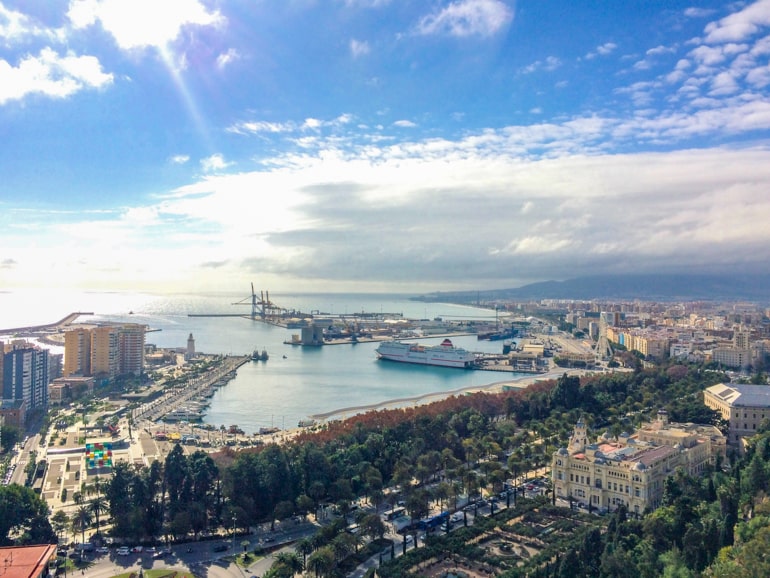
We are starting this itinerary in Málaga since it is an easy airport to fly in from other parts of Europe.
When Lisa arrived at the airport the first time she was actually kind of shocked to see that all the signs were written in German as well.
Needless to say, Málaga is a very popular destination among German tourists. It’s also an interesting city to visit in the wintertime !
Lisa didn’t like the city that much (as in wouldn’t want to live there), but it is definitely worth exploring for a day or two. It is also quite easy to get from the airport to the city centre by public transport. You can find your rental car from Malaga here .
Accommodation in Málaga: Malaga is a popular tourist destination in the south of Spain and so there are lots of different accommodation options. That said, apartment rentals are a very popular option.
Check here for apartments or hotels in Malaga .
Specifically, if you want a hotel, check out Hotel Boutique Teatro Romano . This minimalist design hotel is bright and clean and offers an excellent breakfast while being located right in the heart of the city centre.
If you are planning to stay in Malaga a bit longer, check out Apartamentos Nono . Located close to the beach and a quick walk to the city centre, these apartments have kitchenettes for smaller meals, terraces, and onsite private parking .
If you are searching for a hostel, Malaga has lots. You can search for hostels in Malaga here . When visiting Malaga with a friend, Lisa stayed at Casa Al Sur Terraza .
Even though it’s a “hostel”, it’s a popular place to stay in Malaga. They have private rooms and a lovely rooftop terrace. She and her friend stayed in a private room and loved it!
Just remember for this itinerary, wherever you book you will need to stay for 2 nights !
Must-see Attractions in Málaga:
- Alcazaba Palace
- Picasso Museum
- Cathedral of Málaga
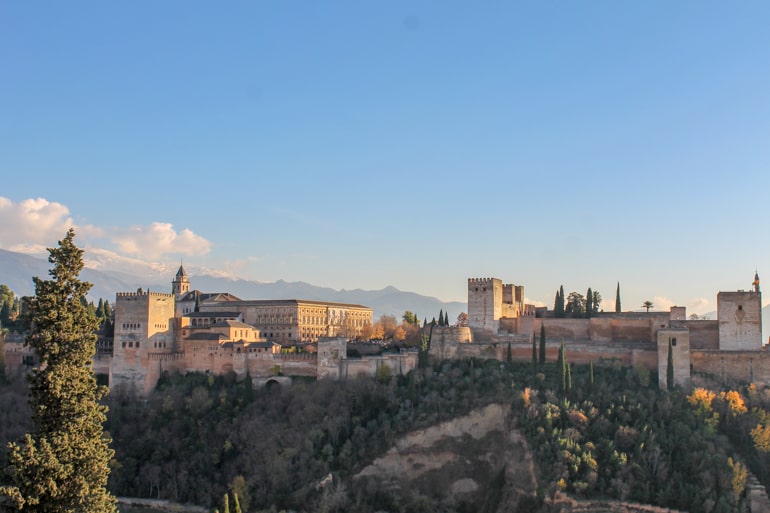
Today you’ll take a day trip to Granada. If you decided to rent a car you can do this by car, but then have to find parking in Granada. Lisa and her friend took the bus to Granada which was pretty easy to do since there are frequent buses throughout the day.
In Granada, you HAVE to go see La Alhambra. Make sure to book your ticket in advance (since there is only a limited amount of spots per day).
Lisa and her friend had to pick up her tickets at an office in the city before going to the actual attraction. Double-check your ticket since you might have to do that, too!
The journey from Málaga to Granada is approximately 1.5 hrs by car and 2 hrs by bus .
Accommodation in Granada: You won’t need a place to sleep in Granada since you’ll be returning to Málaga at the end of the day.
But IF you are curious – check out Hotel Granada Center or Granada Five Senses Rooms & Suites for two great hotels in the heart of the historic city centre!
Must-see Attractions in Granada:
- Alhambra Palace
- Albaicín District
- Cathedral of Granada
Day 3: Marbella
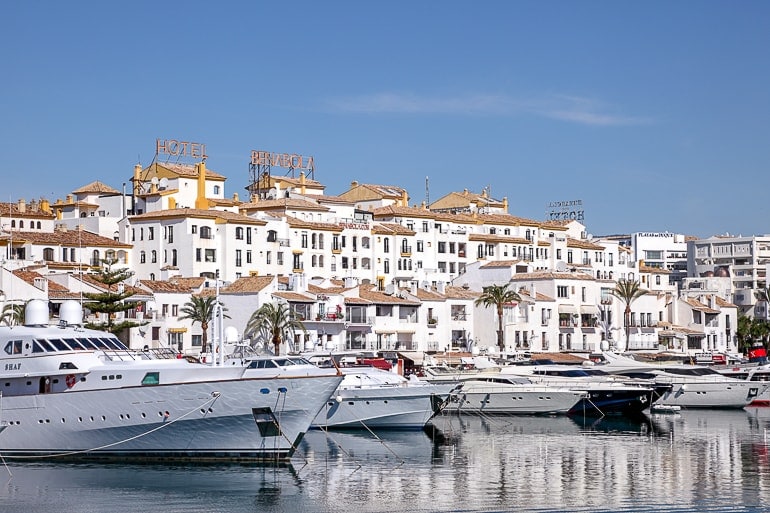
On the third day of this 5 day Southern Spain itinerary, you’ll drive from Málaga to Marbella. Marbella is a city by the water and part of the well know Costa del Sol. It is one of the most popular tourist cities in the region mainly due to its nice beaches and climate.
Since Marbella is quite close to Málaga the drive won’t be long – giving you more time to explore the city and relax at the beaches. The journey takes approximately 1 hour by car (there are different routes some of which include toll roads) and 1.5 hours by bus .
Accommodation in Marbella : Since the tourism industry is quite developed in Marbella, there are lots of amazing sunny accommodations to choose from.
Check here for hotels and apartments in Marbella .
Specifically, Paloma Blanca Boutique Hotel is a gorgeous (and affordable) boutique hotel with breakfast and free private parking onsite.
If you are looking for more of a beach resort, Amàre Beach Hotel Marbella is a beautiful all-inclusive adult-only beachside resort with breakfast, spa, pool, amazing views, and more!
Must-see Attractions in Marbella:
- The Old Town of Marbella
- Avenida del Mar
- Puerto Banús
Day 4: Cádiz
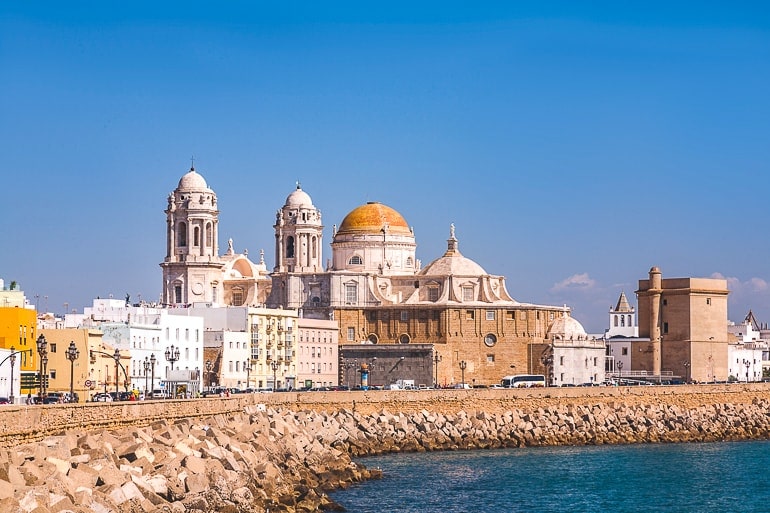
Cádiz is often considered a hidden gem in Spain. Lots of people who have been there seem to love it and Lisa is dying to visit the city.
Fun fact: Some think of Cádiz as the oldest continuously inhabited city in Western Europe. It is just slightly smaller than Marbella with lots of attractions waiting to be explored.
Driving from Marbella to Cádiz by car will take you approximately 2 hours including a toll road and slightly longer if you want to avoid toll roads.
You’ll drive along the coast for a while and could consider stopping along the way. Another option would be to make a pit stop in Gibraltar which you will pass along the way.
Unfortunately, Marbella and Cádiz do not seem to be connected well by public transport and travel between the two cities would involve going back to Málaga and/or through Sevilla (or Seville as the English like to call it).
If it is too much of a hassle for you to get from Marbella to Cádiz, consider skipping it and going straight to Seville instead.
Accommodation in Cádiz: Even though Cádiz is a smaller city, there are plenty of places to stay.
Check here for hotels and apartments in Cádiz .
Specifically, Hotel Boutique Convento Cádiz is a gorgeous hotel in the old town (close to the beach) with a great breakfast and private parking nearby .
Alquimia Albergue-Hotel is a cool and cozy hotel (also in the city centre) close to the beach and also with parking nearby. As for hostels, Cádiz does have quite a few hostels with amazing ratings. You can check here for hostels in Cádiz .
Must-see Attractions in Cádiz:
- Cádiz Cathedral
- Fortress San Sebastian
- Plaza de San Juan de Dios
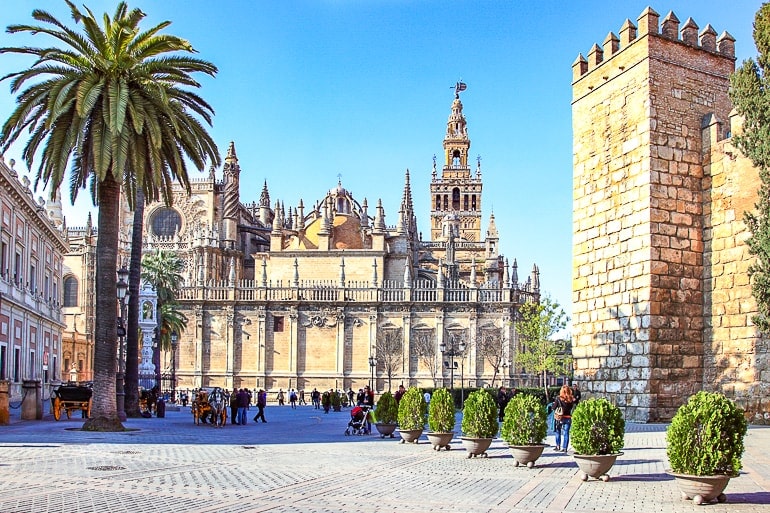
Seville is another popular destination in Spain and is often considered one of the hottest cities of the country. Therefore we would not recommend going there during July and August if you don’t like extreme heat (Lisa definitely doesn’t).
It is a beautiful city with lots of attractions to check out so be sure to have a good amount of time for exploring. If you don’t end up going to Cádiz, there is more than enough to do in Seville to keep you busy for two days!
Driving from Cádiz to Seville will take you approximately 1.5 hours by car and just slightly longer (1 hr 45 min) by bus . Seville also marks the end of this Southern Spain trip as it has a big airport which makes it super easy for you to fly back home.
Accommodation in Seville : Seville is a bigger and very popular city so there is no shortage of great accommodation options.
Check here for apartments and hotels in Seville .
Specifically, you have to see Petit Palace Puerta de Triana . This very trendy and cool design hotel offers a buffet breakfast and is located right in the city centre close to top attractions.
If you want a more historic stay, Hotel Simon is a more simple and authentic hotel. It’s located in a historic building, also does breakfast, and is also located in the heart of the city centre.
Neither of the above hotels offers parking – but few in the city centre of Seville offer onsite parking (or even public parking nearby).
If you are looking to have parking available, then you can check out La Parada del Marqués . It’s a beautiful guesthouse/hotel also centrally located and offers breakfast options and good connections to public transit!
If you are looking for a hostel, you can search for hostels in Seville here . Again, since Seville is so popular we would advise booking ahead – especially during the high season!
Must-see Attractions in Seville:
- Seville Cathedral
- Plaza de España
Spain Itinerary 7 Days
If you have slightly more time to explore Spain, we have also created two 7-day Spain itineraries for you. You’ll see that once again we give you two options since seven days are – in our opinion at least – still not enough to see the whole country.
Therefore, you’ll find a 7-Day Western Spain Itinerary and a 7-Day Eastern Spain Itinerary below. As always, feel free to modify them to make them fit your exact plans!
Spain Itinerary 7 Days – Western Trip
For this itinerary, the total driving time would be around 14 hours and the distance would be around 1300 km .
These estimates account for the Toledo day trip (and back to Madrid) AND finishing with ONE of either Seville OR Malaga from Córdoba. So, in theory, it could be shorter or longer than we have indicated here on the map!
We’ve already covered some of the places above, but we will mention the important parts again to make it easier for you to plan your exact trip.
Please note that we won’t actually include any places on the west coast of Spain – that would be a whole other trip in itself. Your 7-Day Western Spain Itinerary could look something like this:
Spain Itinerary 7 Days – Western Trip Overview
Day 1: Bilbao
Day 2: burgos.
- Day 3: Salamanca
- Day 4: Madrid
- Day 5: Madrid / Day trip to Toledo
Day 6: Córdoba
Day 7: seville or málaga.
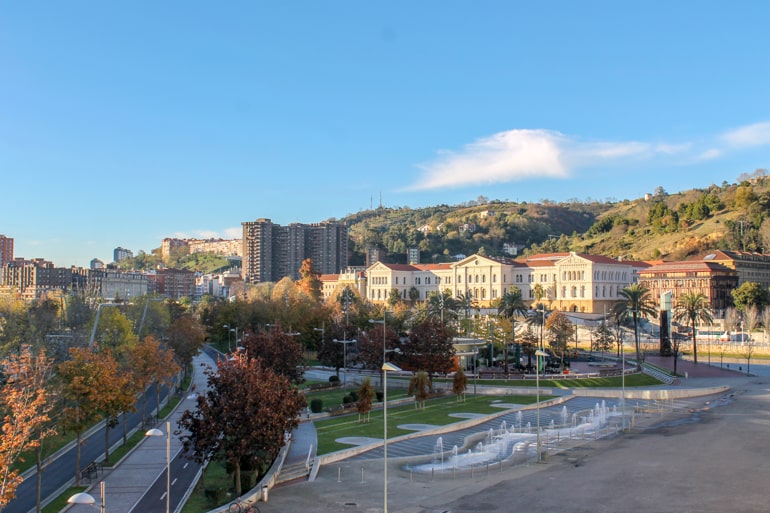
Similarly to how we ended the five-day itinerary in Bilbao, we’ll start this itinerary there as it is a relatively easy airport to fly into from other places in Europe. If you’re starting your longer Spain trip, you can find your rental car in Bilbao here .
Make sure to use your time to explore the Casco Viejo (the Old Town) and walk along the river! There are some great Pintxo places in the Old Town that you should absolutely check out!
Accommodation in Bilbao : Bilbao is a larger city so there’s quite a variety of accommodations available.
Check here for hotels in Bilbao .
Specifically, Hotel NH Bilbao Deusto is a bright and simple hotel with good breakfast and underground private parking . Friends of Lisa stayed there and said they enjoyed it. It’s close to the river across from the Guggenheim Museum but still a quick walk to the old town.
To stay in the heart of old town Bilbao, you have to see Ercilla Hotela . This is a very stylish and popular hotel with a lovely rooftop terrace and lounge, onsite parking , and they even serve traditional Basque food!
As for hostels, Bcool Hostel is a very “cool” hostel in Bilbao. In general, remember to book any hotels or accommodations somewhat closer to the city centre/the river because Bilbao can be quite hilly around the edges!

Burgos might not be a city that is immediately on your radar for places to visit in Spain but we would recommend a stop there on your way south.
Lisa visited Burgos with friends on a day trip from Bilbao so she knows how easy it is to get there. Burgos is a nice city but since there is not a ton to see, one night is the perfect amount of time in our opinion.
Getting from Bilbao to Burgos takes approximately 1.5 hours by car and 2 hours by bus .
Accommodation in Burgos : Burgos is not an overly big city, but you can still find lots of great accommodations.
Check here for hotels in Burgos .
Specifically, Hotel Puerta de Burgos is a popular, trendy, and affordable hotel with private underground parking at the hotel. This makes it a great option if you have a car because it’s a little further from the centre (still quite close) and just off the motorway.
Another great hotel closer to the city centre/attractions is NH Collection Palacio de Burgos . This is an elegant hotel with a great breakfast and private parking, too.
If you want to stay in a hotel that physically faces the famous Burgos Cathedral, check out Hotel Mesón del Cid !
Must-see Attractions in Burgos:
- Burgos Cathedral
- Las Huelgas
- Museum of Human Evolution
Day 3: Salamanca
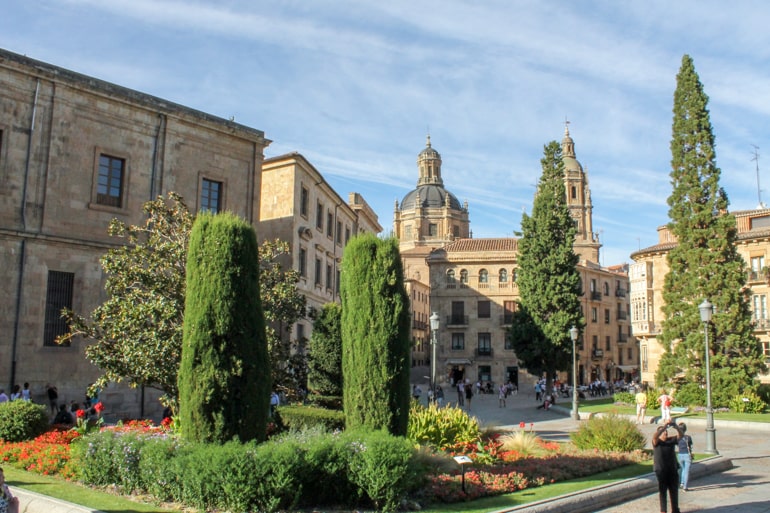
From Burgos, your journey continues to Salamanca – another one of Lisa’s favourite cities in Spain. Salamanca is sometimes called “The Golden City of Spain” and you’ll understand why.
The many sandstone buildings get illuminated beautifully by the sun – making it appear golden. Be sure to bring your camera because you’ll want to use it in Salamanca. Our tip: Cross the river to get amazing photos of the cathedral.
Getting from Burgos to Salamanca is easy and will take approximately 2.5 hours by car or 3 hours by bus .
Accommodation in Salamanca: Salamanca has lots of great accommodations in the city.
Check here for hotels in Salamanca .
Specifically, Hospes Palacio de San Esteban is an authentic-style hotel in the city centre with an incredible breakfast and onsite private parking .
If you are looking for a very affordable hotel with views of the Cathedral, Hotel San Polo is for you. The popular hotel is in a location that doesn’t get much more central! There’s no parking available – making it great if you travel by bus and train only.
When Lisa visited Salamanca on a weekend trip, she stayed in a hostel with friends close to the Old Town and loved it. You can check out the good selection of hostels in Salamanca .
Must-see Attractions in Salamanca:
- Salamanca Cathedral (Old + New)
- Plaza Mayor
- Salamanca University
Day 4: Madrid
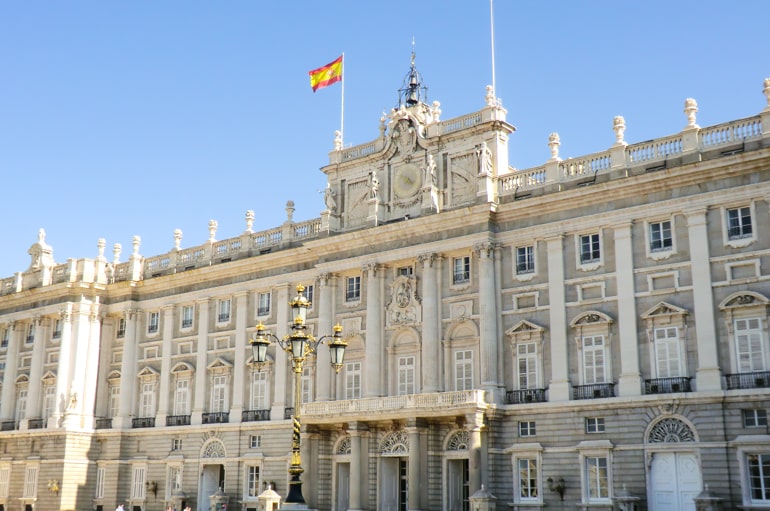
Since Madrid is the capital of Spain you shouldn’t miss it on your itinerary. Conveniently it is also quite close and easy to get to from Salamanca.
Since there is so much to see in Madrid one day to explore might not be enough for you. That’s why you might opt for spending two days in Madrid instead.
Lisa has been to Madrid two times now and still hasn’t seen everything there is to see. But at least you’ll get a good sampler!
As mentioned, getting from Salamanca to Madrid is easy. The journey will take approximately 2 hrs 12 min by car (including a toll road) and 3 hours by bus .
Madrid’s main bus station is actually underground which is kind of cool and caused a lot of confusion for Lisa and her friends when they tried to find it the first time.
Accommodation in Madrid : Being the capital city of Spain, Madrid is a popular city with lots and lots of accommodation options. Keep in mind that Madrid has many “hostals” which are technically guesthouses but are basically hotels.
Also, if you have a car don’t be surprised if parking is in a public lot for a high fee – that’s just Madrid.
Check here for apartments and hotels in Madrid .
Specifically, you might want to check out Room007 Select Sol . This charming and trendy hotel is right in the heart of the city, has air conditioning, and serves breakfast at a cafe next door!
If you are looking for a simple stay right in the centre, check out Hostal Madrid . This authentic guesthouse is so centrally located with top attractions and a metro station around the corner.
It’s such good value for money that the two times Lisa travelled to Madrid she actually stayed here both times!
Should you be on the hunt for an actual hostel, you can check here for hostels in Madrid . Keep in mind wherever you book, you will be booking accommodation for two nights.
Must-see Attractions in Madrid:
- Museum Reina Sofia
- Puerta del Sol
Keep in mind we have a whole separate detailed guide on amazing things to do in Madrid !
Day 5: Madrid or Day trip to Toledo
As mentioned, you might opt to spend another day in Madrid since there is so much to see.
If that’s the case read our Madrid guide linked above to get more recommendations. Alternatively, you could opt to go on a day trip to Toledo, a beautiful small city not too far from Madrid.
If you don’t want to drive there yourself, you can choose to book a day tour which includes a tour of Toledo among other things. If you want to drive yourself the journey will take you approximately 1 hour by car and the same amount of time by bus .
Must-see Attractions in Toledo:
- Toledo Cathedral
- Monasterio de San Juan de los Reyes
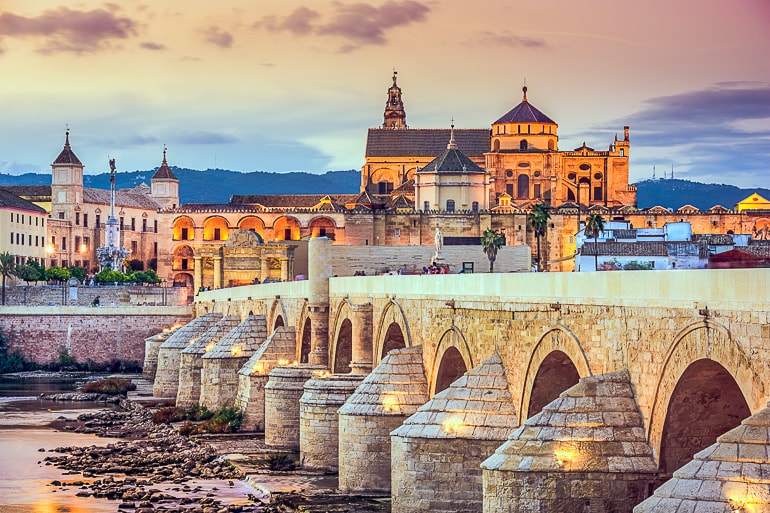
The next day you will drive to Córdoba, a city in Andalusia known for its famous flower street – among other things of course. There is a lot of history to be found in Córdoba so consider taking a walking tour if you want to learn more about it.
This is one of few routes where you will actually be faster taking public transport as if you were to drive yourself since there is a good train connection between Madrid and Córdoba.
Driving by car takes approximately 4 hours while the journey by train would be slightly shorter with 2 hrs 15 min .
Accommodation in Córdoba : If you’re looking for a hotel, there are lot of options to choose from.
Check now for hotels in Córdoba .
Specifically, Maciá Alfaros is an authentic hotel located right in the heart of the city centre with an incredible swimming pool and easy parking onsite.
Hotel Cordoba Center is an elegant hotel located outside the heart of the centre. It’s still very walkable to the centre, is very close to the train station, and has a rooftop pool with amazing views!
There are quite a few hostels with very good ratings in Córdoba so you can check here for hostels in Córdoba .
Must-see Attractions in Córdoba:
- Mosque–Cathedral of Córdoba
- Alcázar de los Reyes Cristianos
- Historic Center of Córdoba
For this itinerary, you can decide in which city you would like to end your trip. For some, it might be more convenient to fly out of Seville while for others Málaga might be the better option. So it’s really up to you and your preference!
The journey from Córdoba to Seville takes approximately 1 hr 40 min by car and 45 min by train . The time it takes to get from Córdoba to Málaga isn’t much longer with 1 hr 50 min by car and 50 min by train .
Accommodations in Seville : As mentioned above, Seville is a popular city so there is always accommodations to choose from.
Specifically, check out Petit Palace Puerta de Triana . This trendy design hotel offers a buffet breakfast and a really great location in the city centre.
For a historic stay, Hotel Simon is a more simple and more authentic hotel. It’s located in a historic building, does breakfast, and is also located in the city centre.
Neither of the above hotels have parking – but fewer properties in Seville offer onsite parking (or even public parking nearby).
If you are travelling by car and want parking available, then check out La Parada del Marqués . It’s a beautiful guesthouse/hotel also centrally located with breakfast options and good connections to public transit!
If you want a hostel stay, you can search for hostels in Seville here . Regardless of what type of accommodation you book, Seville is popular so we would advise booking ahead – especially during the high season!
Accommodation in Málaga: Malaga is a popular destination in the south of Spain with lots of different accommodation options. That said, apartment rentals are very popular.
Specifically, for hotels, you can check out Hotel Boutique Teatro Romano . This design hotel is bright and clean and offers breakfast while being located right in the heart of the city.
If you are planning for a longer stay, check out Apartamentos Nono . Located close to the beach and a quick walk to the city centre, these apartments have kitchenettes, terraces, and onsite private parking .
If you want a hostel, Malaga has lots. You can search for hostels in Malaga here . When visiting Malaga with a friend, Lisa stayed at Casa Al Sur Terraza .
Even though it’s a “hostel”, it’s a popular place – with private rooms and a lovely rooftop terrace. Her and her friend stayed in a private room and loved it!
Spain Travel Itinerary 7 Days – Eastern Trip
If the other 7-day Spain itinerary doesn’t really appeal to you and you would like to stay closer to the coast, maybe this itinerary is more to your liking. The driving time would be just shy of 11 hours and would be approximately 1000 km driving distance !
Spain Itinerary 7 Days – Eastern Trip Overview
- Day 1+2: Barcelona
Day 3: Valencia
- Day 4: Alicante
- Day 5: Murcia
Day 6: Granada
Day 7: málaga, day 1 + 2: barcelona.
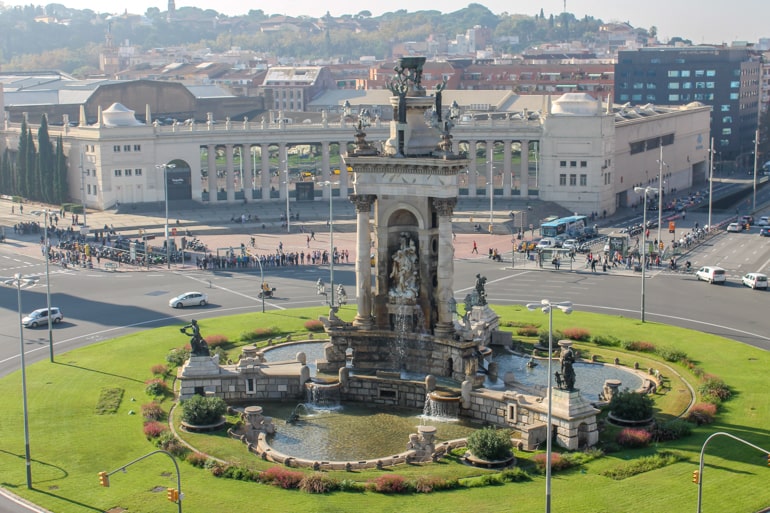
Once again, this itinerary starts in Barcelona since it is one of the easiest airports to fly into. Since you have a little bit more time with this itinerary you’ll stay in Barcelona for two days.
There is lots to see so you still won’t see everything, but definitely more than in just one day. To then continue on with this itinerary through Spain, you can find your rental car in Barcelona here .
Accommodation in Barcelona: As mentioned above, there are lots of hotels and apartments in Barcelona.
For hotels, you might like Catalonia Born Hotel with a boutique style and rooftop pool close to the beach in the city centre.
If you travel by car, Sallés Hotel Pere IV is an affordable hotel with spa in the heart of the city with a private parking garage .
As for hostels, you can check here for Barcelona hostels . We liked Kabul Hostel . Wherever you stay, remember to book in advance because the city does fill up and it can get expensive! And remember, you’ll be staying at this place for two nights .
- Las Ramblas
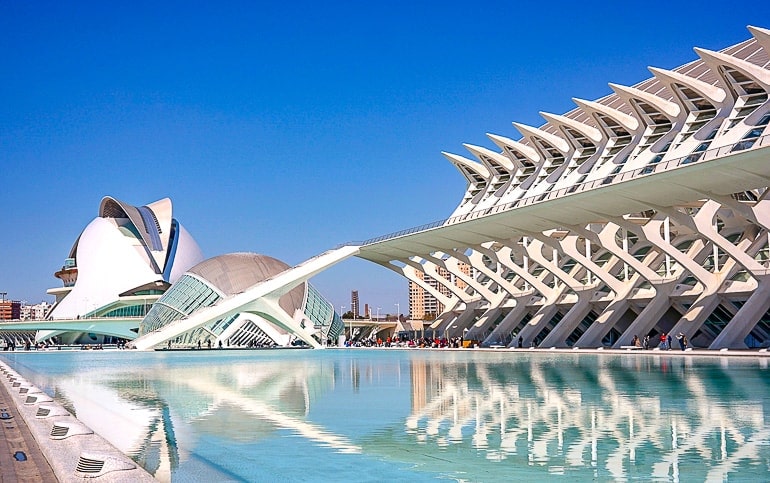
The third day of this Spain itinerary will take you from Barcelona to Valencia which is another city on Lisa’s favourite list.
It was actually the first Spanish city she visited and she fell in love with the city and its people right away. Her favourite part is that there is a huge part in what was formerly a river that stretches through a big part of the city.
In order to get from Barcelona to Valencia, you’ll drive along the coast for 3.5 hours by car and around 3 hrs 15 min by train.
Accommodation in Valencia: Since Valencia is a bigger city, you are sure to find accommodations that work for you.
Check here for hotels in Valencia .
Specifically, Petit Palace Ruzafa is a bright and boutique hotel right in the city centre.
They offer healthy breakfast options and free bike rentals. There’s no parking making this a great hotel for those travelling without a car.
If you want a place right on the beach, check out Hotel Miramar . This cool beachfront hotel has a bar and restaurant right downstairs and has paid parking onsite . If you are looking for a hostel, you can check here for hostels in Valencia .
Must-see Attractions in Valencia:
- City of Arts and Science
- Lonja de la Seda
- Cathedral of Valencia
Day 4: Alicante

Alicante is a popular holiday town that lots of Europeans visit to enjoy the nice weather and the beaches. Maybe you have heard of the name Costa Blanca?
Alicante is part of that exact region. When you’re there don’t forget to check out some of the nice beaches – but of course, there are also lots of other things waiting to be explored.
Getting from Valencia to Alicante won’t take overly long. The drive will take approximately 2 hours by car and 1.5 hrs to 2.5 hours by train or bus respectively.
Accommodation in Alicante: Alicante is a popular city due to its great location on the coast.
Check here for hotels in Alicante .
If you want to stay directly on the beach, Hotel Almirante is a bright and stylish hotel with breakfast buffet. It’s a bit farther from the city centre, but there is free onsite parking if you have a car.
If you want more of a resort style, Melia Alicante is also located right on the beach with stunning views over the water. It’s much closer to the centre of the city and has good amenities (pool), paid parking next door, and a really good breakfast!
You can also find a good mix of hostels in Alicante. In any case, don’t forget to book ahead in the summertime since it can get very crowded.
Must-see Attractions in Alicante:
- Castle of Santa Barbara
- Casco Antiguo (Old Town)
- Beaches such as Playa Postiguet
If you’re heading for Alicante to get some sunshine, we’ve got a guide on things to do and see in Alicante that includes some great food tips for you to check out!
Day 5: Murcia
Murcia is a city in the southeast of Spain and the capital of the region with the same name. Travellers who don’t know much about Spain (yet) might not have heard of the city before but this doesn’t mean it is not worth a visit.
The drive from Alicante to Murcia is quite short with 1 hr by car and 1 hr 10 min by bus . This will give you a good amount of time to explore the university city and get a rest from all the driving.
Accommodation in Murcia: Since Murcia is a less touristy city you’ll find great places to stay and (generally) fewer crowds.
Check here for hotels in Murcia .
Specifically, the Hesperia Murcia Centro is a clean and modern hotel right in the city centre near the Cathedral. There’s also private onsite parking and a tasty breakfast.
If you want to stay closer to the coast – you could stay in Cartagena (about 30 minutes away from Murcia). Here, check out NH Cartagena – with bright, sea views and parking all in a great location.
Must-see Attractions in Murcia:
- Murcia Cathedral
- Floridablanca Gardens
- Monteagudo Castle
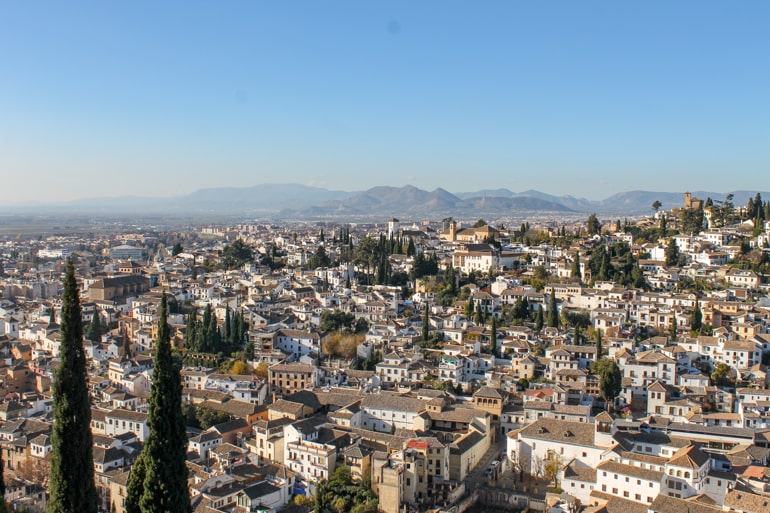
From Murcia, your journey will continue to Granada, a city which we have mentioned quite a few times by now so we won’t go into details again. If you haven’t yet, make sure to get your Alhambra tickets in advance!
Driving from Murcia to Granada will be a slightly longer trip with 2 hrs 45 min by car and around 3.5 hrs by bus .
Accommodation in Granada: Since Granada is a popular travel destination, many accommodations are available.
Check here for hotels in Granada .
Specifically, Hotel Granada Center is a VERY popular hotel with great breakfast, a very central location, and private underground parking onsite .
Also situated in the city centre is Granada Five Senses Rooms & Suites – a sleek and modern hotel with small rooftop pool with great views of the historic old town! If you are looking for a hostel, you can check here for hostels in Granada .
Since we have mentioned Málaga countless times above, there is not much to add. As you probably know by now Málaga has a great airport to fly out of so this is where this 7-day Eastern Spain itinerary ends.
The journey from Granada to Málaga is approximately 1,5 hrs by car and 2 hrs by bus .
Accommodation in Málaga: Malaga is a popular tourist destination in Spain so there are lots of available accommodations – with apartments being the most popular.
For hotels, check out Hotel Boutique Teatro Romano . This minimalist design hotel is bright and offers a great breakfast while being located right in the city centre.
For longer stays, check out Apartamentos Nono . Located close to the beach and to the city centre, these apartments have kitchenettes for small meal prep, terraces, and onsite private parking .
If you are searching for a hostel, you can search for hostels in Malaga here . When visiting Malaga with a friend, Lisa stayed at Casa Al Sur Terraza .
It’s a popular place to stay in Malaga with private rooms and a great rooftop terrace. She and her friend stayed in a private room and really liked it!
Spain Itinerary – 14 Days
This road trip would be a beast. As planned above with the scheduled day trips you’d cover around 2600 kilometres .
The driving time would be around 27 hours and 30 minutes – but of course, this varies by traffic and which day trips/stop days (beach days) you opt to take, etc.
If you swung down to Gibraltar at the end and then went to Granada and Malaga, it could very well be a tad longer.
You should also consider the price of renting a car for two weeks to see if there are any companies that offer discounts!
Compare prices for your car rental from Bilbao here .
Since you have read about most of these places in some of the itineraries above we’ll keep this one short.
Our version is written from north to south, so from Bilbao to Málaga. As with most of our itineraries, you can reverse the direction if you feel like it So, to really see the whole country, your updated 14-day Spain itinerary might look something like this:
14-Day Spain Itinerary Overview
- Day 2: Day trip to Santander, Vitoria-Gasteiz or Beach Day
- Day 3: Donostia-San Sebastián
- Day 4: Zaragoza
Day 5+6: Barcelona
Day 7: valencia, day 8+9: madrid.
- Day 10: Toledo or Córdoba
Day 11: Seville
- Day 12: Seville or Day trip to Cádiz/ Gibraltar
- Day 13: Málaga (or Granada)
- Day 14: Málaga
Once again we are starting this itinerary in Bilbao since it is an easy city to get to. There are quite a few things to see and delicious foods to try so with this itinerary you have slightly more time to explore the city!
Accommodation in Bilbao: Once again, Bilbao is a bigger centre in Spain so you’ll find lots of accommodations to suit many different styles and budgets.
Specifically, Hotel NH Bilbao Deusto is a bright hotel with breakfast and underground private parking . Friends of Lisa stayed here and enjoyed it. It’s the river from the Old Town – but it’s a nice area and a quick walk to everything.
To stay in the centre of Bilbao’s historic old town, check out Ercilla Hotela . This is a very stylish hotel with a great rooftop terrace/lounge, onsite parking , and food onsite, too.
If you are wanting a hostel, Bcool Hostel is a great option in Bilbao. Just remember: when booking any accommodations in Bilbao, try to book in the centre or near the river since the edges of the city can be very hilly!
Since the next day in this itinerary is a day trip we’d suggest booking your accommodation in Bilbao for two nights !
Day 2: Day Trip to Santander, Vitoria-Gasteiz or Beach Day
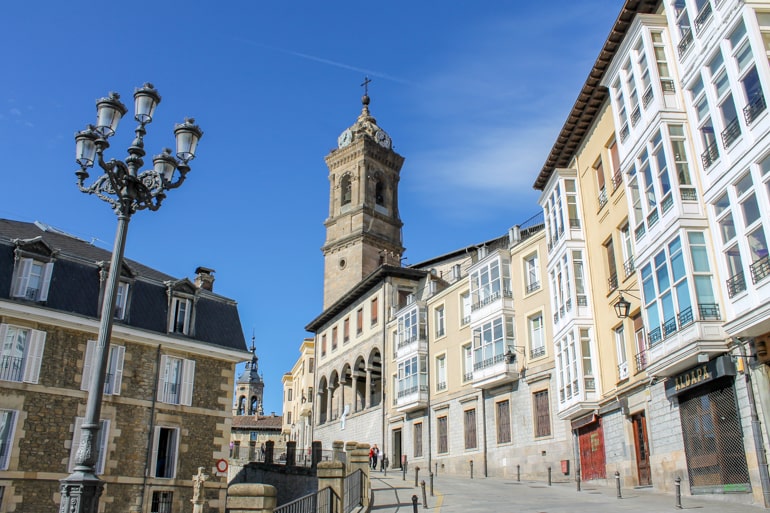
To give you the chance to see a bit more of the region we recommend a day trip to either Santander or Vitoria-Gasteiz, the capital of the Basque Country.
Alternatively, you can also opt to spend the day at the beach if the weather is nice (more on that below!) or use the time to see more of Bilbao.
Getting to Santander from Bilbao takes approximately 1 hr 15 min by car and 1.5 hrs by bus . The journey to Vitoria-Gasteiz is slightly shorter, taking approximately 1 hr by car and the same amount of time by bus .
Must-see Attractions in Santander:
- Palacio de la Magdalena
- Centro Botin
- Sardinero Beach
Must-see Attractions in Vitoria-Gasteiz:
- Catedral de Santa María
- Iglesia de San Miguel
If you opt for a beach day instead, we would recommend Sopelana beach. It is easy to reach by metro. Just take the line no 1 in the direction of Plentzia and get off at the Sopelana stop.
From there you can either walk or take the bus to the beach. It’s Lisa’s favourite beach in the Bilbao area since it looks beautiful and is not too crowded. It’s also a great stop to try some surfing.
Day 3: Donostia-San Sebastián
The next stop on your 14-day Spain itinerary is San Sebastián – a city we have already mentioned before. Beautiful beaches and delicious pintxos await you!
The drive from Bilbao to San Sebastián takes around 1 hr 15 min by car and 1.5 hrs by bus . There are very frequent buses by lots of different operators between these two cities.
Accommodation in San Sebastián : San Sebastián is one of the more expensive towns in Spain. It’s also very popular among luxury travellers. So, don’t be surprised if accommodations seem a little more expensive overall.
Specifically, check out Casual de las Olas San Sebastián . This hotel is a bit further from the old town and beach but makes up for it with sleek decor, breakfast, and air conditioning.
If you want more of a laid-back feel, check out Talaia HT . This authentic and cozy guesthouse is located in the heart of the old town – and has public parking nearby .
If you are looking for a hostel, you can find hostels across San Sebastián here . Wherever you book, our advice is to book accommodations early. Generally, you save money when doing that.
Day 4: Zaragoza
Day 5 of this itinerary will take you to Zaragoza, a city mentioned in the 5 day Northern Spain itinerary. The drive will be a bit longer but you’ll still have enough time to check out some of the attractions Zaragoza has to offer.
Driving from San Sebastián to Zaragoza will take approximately 2 hrs 45 min by car (including a toll road) and around 4 hrs by bus .
Accommodations in Zaragoza: Zaragoza is a smaller city but there are still lots of really great accommodation options.
Specifically, check out Hotel Sauce . This bright hotel is located right in the city centre and has buffet breakfast, air conditioning, and private parking onsite for those with a car in Spain!
If you want a hotel with a rooftop pool, Hotel Palafox is for you! Also situated right in the heart of the city, the hotel has a unique decor, city views, a nice breakfast, and also has parking and air con!
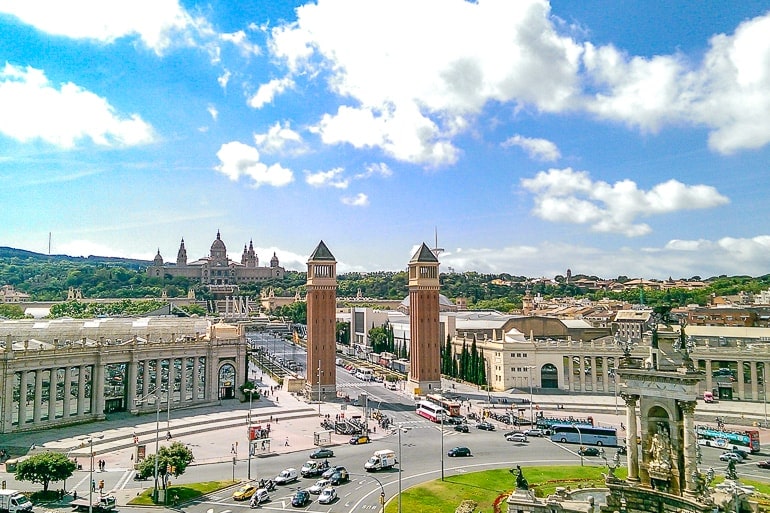
A tour across the country wouldn’t be complete without including Barcelona. Since there is so much to see you’ll be spending two nights in the city to give you enough time.
The drive from Zaragoza to Barcelona will take you approximately 3 hrs 10 min by car (includes a toll road), 3.5 hrs by bus and 1.5 hrs by train .
Accommodation in Barcelona : As mentioned above, you’ll find loads of great hotels and apartments in Barcelona.
If you are looking for a hotel, check out Catalonia Born Hotel with a boutique style and rooftop pool in the city centre (also close to the beach).
If you travel by car, Sallés Hotel Pere IV is a lovely and affordable hotel with a spa that is located in the heart of the city and has a private parking garage onsite .
As for hostels, you can check out Barcelona hostels here. Specifically, we enjoyed Kabul Hostel . Hostel or hotel – just remember to book early because Barcelona is a popular city. Also remember that for this itinerary, you’ll be staying over for two nights .
And we’re back in one of Lisa’s favourite cities. The drive from Barcelona to Valencia will be a bit longer but it is worth it (in our opinion at least).
Driving from Barcelona to Valencia will take around 3.5 hrs by car (including a toll road), 3 hrs by train and 4 hrs 15 min by bus .
Accommodation in Valencia: Since Valencia is a bigger city, you’ll find accommodations that work for your style and budget.
Check now for hotels in Valencia .
Specifically, Petit Palace Ruzafa is a boutique hotel very much in the lovely city centre. They offer healthy breakfast, free bike rentals, and no parking – making it great for travellers without a car!
If you’re looking to stay right the beach, you’ll likely love Hotel Miramar . This cool beachfront hotel has a bar/restaurant right downstairs, ocean views, and has paid parking onsite . If you want to stay in a hostel, you can check now for hostels in Valencia .
Must-see Attractions in Valencia:
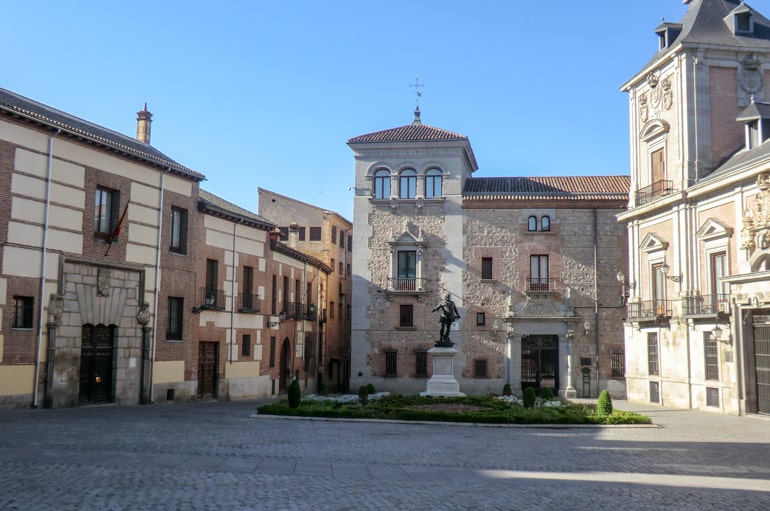
Of course, you can’t forget about the capital of the country when going on a trip through Spain.
Since there is so much to see and do you will spend two nights in Madrid. This will also give you some time to recover from the long driving days you’ve had.
Driving from Valencia to Madrid takes approximately 3.5 hrs by car and slightly less than 2 hrs by train .
Accommodation in Madrid : Being the capital city of Spain, Madrid is a popular city with lots of accommodations.
Keep in mind that Madrid has “hostals” which are technically guesthouses but are basically hotels. Also, parking can be very expensive per day but that’s just Madrid for you.
Specifically, check out Room007 Select Sol . This charming and trendy hotel is right in the heart of the city, has air conditioning, and serves breakfast at a cafe next door. You are very much in the city centre here!
If you are looking for more of a guesthouse stay right in the centre, check out Hostal Madrid .
This authentic accommodation is so centrally located with attractions and the metro close by. It’s good value for money – the two times Lisa travelled to Madrid she actually stayed here both times!
Should you want an actual hostel, there are loads of hostels in Madrid. You can check here for hostels in Madrid . Keep in mind wherever you book, you will be booking this accommodation for two nights if you are following this itinerary.
*We have written in-depth about many of the attractions you can visit in Madrid in our things to do in Madrid guide!
Day 10: Toledo or Córdoba
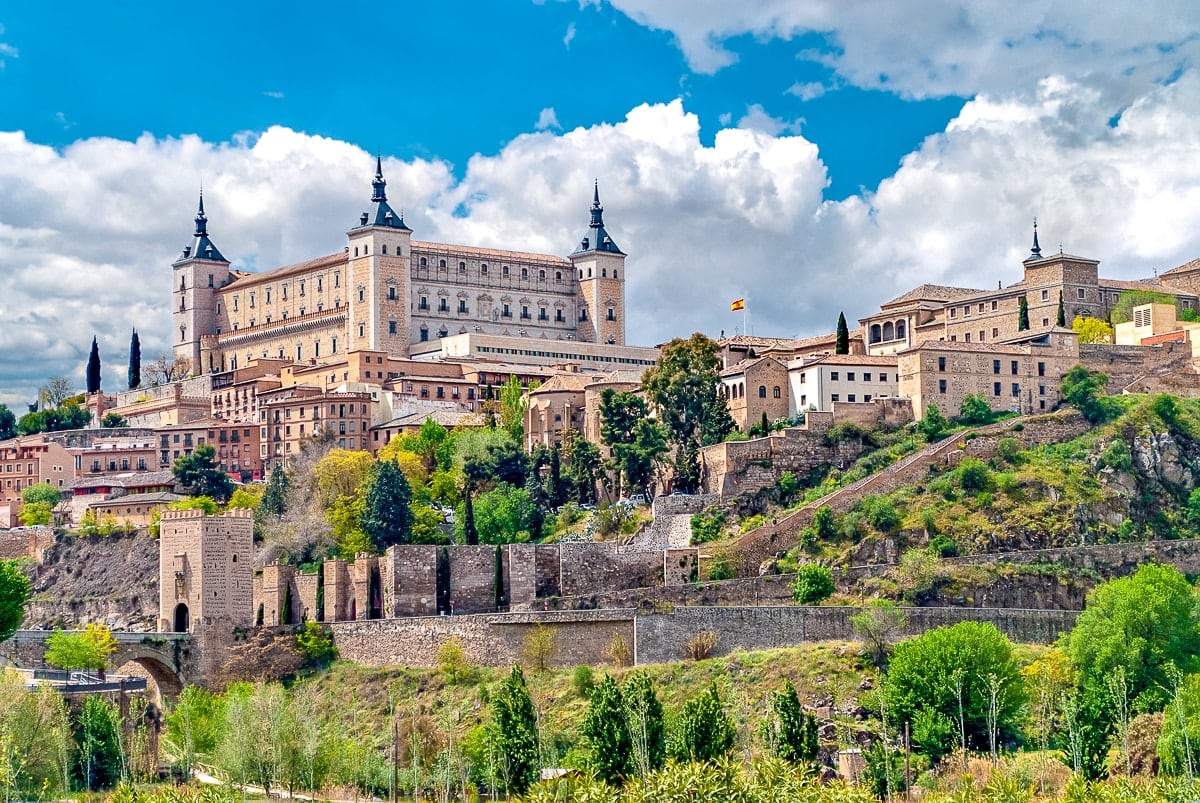
For the next stop on your itinerary, you can decide where you would like to stop. From Madrid you are driving further south and both Toledo and Córdoba would be great options for a stop on the way to Seville.
The drive from Madrid to Toledo will be short and only take an hour by car or bus . The drive from Madrid to Córdoba is a lot longer and takes approximately 4 hrs by car and 2 hrs by train .
While this drive would be longer, your drive the next day would be significantly shorter from Córdoba than from Toledo.
Accommodation in Toledo: If you choose to stay in Toledo, you can check here for hotels in Toledo .
Specifically, you have to check out Hotel Santa Isabel – an authentic and charming Spanish hotel in the heart of the city with an incredible rooftop terrace, good breakfast, and private parking under the hotel if you need it.
Accommodations in Córdoba: If you end up in Córdoba, you can check now for hotels in Córdoba .
Specifically, Maciá Alfaros is an authentic hotel located right in the heart of the city with a nice swimming pool and parking onsite.
Hotel Cordoba Center is an elegant hotel located just a short walk to the centre. It’s location is very close to the train station – and there is a lovely rooftop pool with city views!
There are also many hostels with very good ratings so you can check here for hostels in Córdoba .
On day 11 you will drive from either Toledo or Córdoba to Seville – a city we have mentioned multiple times now because it is very much worth the visit.
If you ended up staying in Toledo, it’ll take you 4.5 hrs by car and 4 hrs by train to get to Seville. If you stayed in Córdoba it’ll only take you 1.5 hrs by car and 45 min by train to get to Seville.
Accommodation in Seville : As we have mentioned above a bunch of times, Seville is a big and popular city so you’ll have no shortage of accommodations to pick from.
Check here for hotels in Seville .
Specifically, we like the look of Petit Palace Puerta de Triana . It’s a trendy design hotel with a buffet breakfast located right in the city centre close to top sights!
If you want more of a “historic stay”, Hotel Simon is a simple and authentic hotel located in a historic building!
They also do breakfast and are also located in the city centre. So you know: neither of the above hotels have parking – but not that many hotels in the city centre offer onsite parking (or even nearby public parking).
If you have/rent a car and need parking available, we’d say check out La Parada del Marqués . It’s a beautiful guesthouse/hotel also quite conveniently located but they also have parking, breakfast options, and good connections to public transit!
Should you be looking for a hostel, you can search for hostels in Seville here .
Again, since Seville is very popular so we would advise booking any accommodations ahead of time – especially during the high season! Remember, you’ll stay for two nights if you follow this itinerary!
Day 12: Seville or Day trip to Cádiz/ Gibraltar

Since there is a lot to see and do in Seville, you have the option to stay another day to explore more of what the city has to offer.
If you’d prefer to see a different place you can consider day trips to either Cádiz or Gibraltar. Know that Gibraltar is not officially part of Spain but belongs to the United Kingdom instead.
It’ll take you around 1.5 hrs by car or train to get from Seville to Cádiz. To get from Seville to Gibraltar it’ll take between 2 and 3 hrs by car .
There does not seem to be any public transport between Seville and Gibraltar since it is another country, but you can participate in an organized tour from Seville to Gibraltar .
Must-see Attractions in Gibraltar:
- Rock of Gibraltar
- Great Siege Tunnels
- The Old Town
Day 13: Málaga (or Granada)
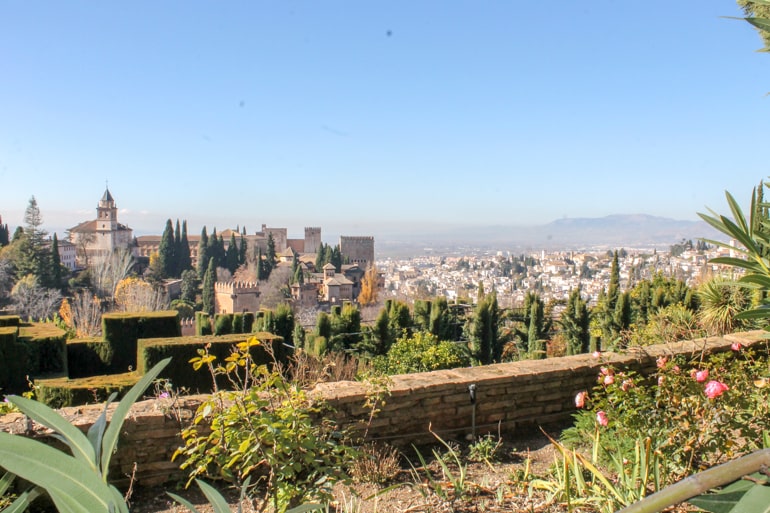
On your second to last day of this itinerary, you will drive from Seville to Málaga, a route we have mentioned quite a few times by now up above.
If you really wanted to visit Granada you could also drive there instead. You could then make the trip to Málaga at the end of the day or the next day.
The journey from Seville to Málaga will be approximately 2.5 hrs by car and 2 hrs by train. Whatever city combo you choose, just remember to book the right amount of nights in cities (one or two) for the end of your itinerary (keeping in mind where you fly out)!
Accommodation in Málaga: As a popular city in the south, Malaga has lots of places to choose from when it comes to accommodation options.
For hotels, have a look at Hotel Boutique Teatro Romano . This lovely design hotel offers breakfast – and it’s very centrally located in the heart of the city!
For an apartment rental (maybe for a longer stay), check out Apartamentos Nono . Located close to the beach and a quick walk to the city centre, the apartments have kitchenettes, terraces, and private parking onsite (if you travelling by car).
Malaga also has lots of hostels if you like. You can search for hostels in Malaga here . Lisa stayed at Casa Al Sur Terraza when travelling to Malaga with a friend.
For a “hostel”, the Casa is a very popular place to stay with private rooms and a sunny rooftop terrace. Lisa and her friend booked a private room and enjoyed it!
Accommodation in Granada: Since Granada is popular, many accommodations are available.
Specifically, Hotel Granada Center is a VERY popular hotel with a great breakfast, a very central location, and private underground parking onsite if you have a car.
Also situated in the city centre is Granada Five Senses Rooms & Suites – a modern hotel with a small rooftop pool with views of Granada’s old town! If you want to book a hostel, you can check here for hostels in Granada .
Day 14: Málaga
And this is the end of your two weeks Spain itinerary. Once again Málaga is the city you fly out of since there are lots of great flight connections to other places in Europe.
Alternatively, you could also stay in Seville and visit Málaga on a day trip if the airport in Seville works better for you.
Things to Consider When Travelling in Spain
Before you dive into Spain trip planning, you’ll want to consider a few details. From the currency they use (the Euro) to the weather, public transport, and the best time to visit, we cover a few key areas below to help you prepare.
Best Time of Year to Visit Spain
Spain is a destination that can be visited year-round – you just have to set your expectations right. Lisa visited Malaga with a friend in December and it was quite warm but of course not warm enough to go swimming.
Since the country is quite big and has a diverse geography, there are actually a lot of different climate zones in Spain. Generally, the summers are hot and dry while the winters are mild and quite rainy.
The average maximum temperature for July and August is 30 °C and 17/16 °C in December and January. However, this can vary greatly depending on which city you are visiting (e.g. Granada is always a little bit colder).
We would recommend that you avoid the south – especially Seville – and Madrid in July and August since it can get VERY hot.
And according to Lisa’s Spanish teacher in Bilbao, it would probably also be a good idea to avoid visiting the Basque country during the winter months since it can rain a lot.
In our opinion, the perfect months for visiting Spain would be from March to June and September to the end of October.
Public Transportation in Spain
Spain has a very well-developed long-distance bus system. Lisa was especially impressed by that since in Germany long-distance buses didn’t exist until a few years ago and sometimes it can still be a bit chaotic or unclear.
In Spain, almost every major city has an actual bus station (and not just a signpost). One of the biggest bus companies in Spain is Alsa .
Lisa has used them quite a few times when living in Spain (to go from Madrid to Bilbao for example) and always had a pleasant experience.
In addition to buses, Spain also has a pretty good rail system. You can check the train connections and prices on the RENFE website here .
We would recommend that you always check both buses and trains as sometimes they take approximately the same amount of time and the bus can be significantly cheaper.
In a few areas (such as parts of the Basque country), the buses can be actually a lot faster than the train.
You can reach all of the places mentioned in these Spain itineraries with public transport.
So if you don’t feel comfortable with renting a car in a foreign country you can still follow all of these itineraries. The bus and train stations are often very centrally located so it shouldn’t be a hassle to get into the centre in any of the cities.
Car Rental in Spain
If you would like to rent a car and make these itineraries a road trip that is a great option, too.
Driving in Spain is generally pretty safe – but it can get a little crazy in bigger cities like Barcelona or Madrid. Spaniards also like to speed – but if you are a confident yet careful driver then this shouldn’t be an issue.
Since Spain is such a popular destination, there are lots of different rental car agencies available. Make sure to read the fine print about additional costs in case there are any issues.
You can compare prices for your Spain trip with this handy comparison tool .
In Spain, there are quite a few toll roads which start with an ‘AP’ in the name. If you want to avoid paying tolls you can often find a road that runs in a similar direction.
Generally, your driving time will be longer if you avoid toll roads but you never know which hidden gems you come across on your way.
Travel Insurance for Spain
When visiting Spain you – and especially when renting a car – should get travel insurance.
While you’ll probably be fine, accidents do happen (and Spaniards are more reckless drivers than in other countries) and they can be expensive. That’s why we always travel with insurance.
If you live in a European country and have European health insurance, you can get the blue EU Health insurance card with which you are covered in emergencies. If you don’t have that option, we recommend that you get private travel insurance.
Related Posts
If you are planning your visit to Spain, check out our other posts on travelling, working, and studying in Spain!
- 12 Need to Knows When Travelling to Spain for the First Time
- 11 of The Most Beautiful Cities in Spain
- 17 of the Top Attractions in all of Spain
- Catalonia Road Trip Itineraries
And there you have it – 5 epic itineraries around Spain! Whether you need 5 days or 14, we think you’ll have lots to work with to plan that perfect trip. Lisa is so happy to be able to provide you with her knowledge of the country.
There is still so much to cover – but we think that these itineraries are a great starting point – you may even do the routes as is and see how they go!
As always, Happy Waddlin’, – L&E
- Compare flights on Skyscanner
- Check for Hotel Deals or Book A Hostel
- Get A Rental Car (depending on the destination)
- Research plug types and possibly get a travel adapter
- Go over our packing list
Pin it for later!

As an Amazon Associate we earn from qualifying purchases.
Destinations
Privacy policy
Disclaimer & Affiliate Disclosure
Terms of use
© 2024 Creativlier Media Inc.
Highlights of Spain: 3 great travel itineraries to make the most of your visit
Jul 21, 2022 • 9 min read

Be inspired to travel Spain with these great itineraries © Getty Images / iStockphoto
Seductive Spain attracts travelers to its diverse land, comprising 17 distinct regions. To help you decide where to start, here are three of our best itineraries to inspire you.
See the highlights of Spain on this 14-day itinerary
To understand why many visitors fall in love with Spain and never want to leave, look no further than its vibrant, passionate, beautiful cities. This 14-day tour takes you through the best Spain has to offer.
Days 1–3: Admire Modernista marvels in Barcelona
So many Spanish trails begin in Barcelona , Spain’s second-biggest city and one of the coolest places on earth. You’ll need at least three days to explore the main attractions here, including nightlife and restaurants. From the standout Gaudí highlights – the incomparable Sagrada Família and colorful Casa Batlló – to its wonderful art museums of Picasso and Miró and the historic sights hidden among the narrow streets of the Gothic Quarter, there’s more than enough to keep you coming back for more. Dine on Catalan classics in the Ciutat Vella, tapas in hip El Born and international delights in the neighborhood of Gràcia.

Days 4–5: Eat your way through paella in Valencia
Catch the fast train down the coast to Valencia in just three hours for a dose of paella, nightlife and the 21st-century wonders of the Ciudad de las Artes y las Ciencias . Spend some time exploring the narrow winding streets and charming plazas of the Ciutat Vella, then hit the city’s fabulous modernist Mercado Central for some local treats. Hire a bike to tour the lush Turia Gardens set in an old riverbed, before relaxing on Malvarrosa Beach with a traditional paella valenciana at Casa Carmela .
Days 6–7: Tour Madrid, the captivating capital
A fast train whisks you inland to the capital, mighty Madrid , in just two hours where you will find irresistible street energy, pretty plazas and one of the richest concentrations of art museums on the planet. Soak up the atmosphere in the grand Plaza Mayor with some chocolate-dipped churros from Chocolatería San Ginés , then make your way to Madrid’s Golden Triangle to marvel at the collections of the Reina Sofia , Prado or Thyssen-Bornemisza art museums. In the afternoon, relax in the vast Parque del Buen Retiro before hitting the stands at the Mercado de San Miguel or the famous bars on Calle Cava Baja.
Day 8: Admire the beauty of Córdoba's Mezquita
Yet another two-hour fast train takes you deep into Andalucía , with Córdoba your entry point into this wonderful corner of Spain; the most obvious highlight is the city’s 8th-century Mezquita . Local dishes to try include a traditional flamenquín (a breaded and deep-fried wrap filled with ham, cheese and pork) and salmorejo (a thick cold gazpacho-like soup of tomato and garlic).
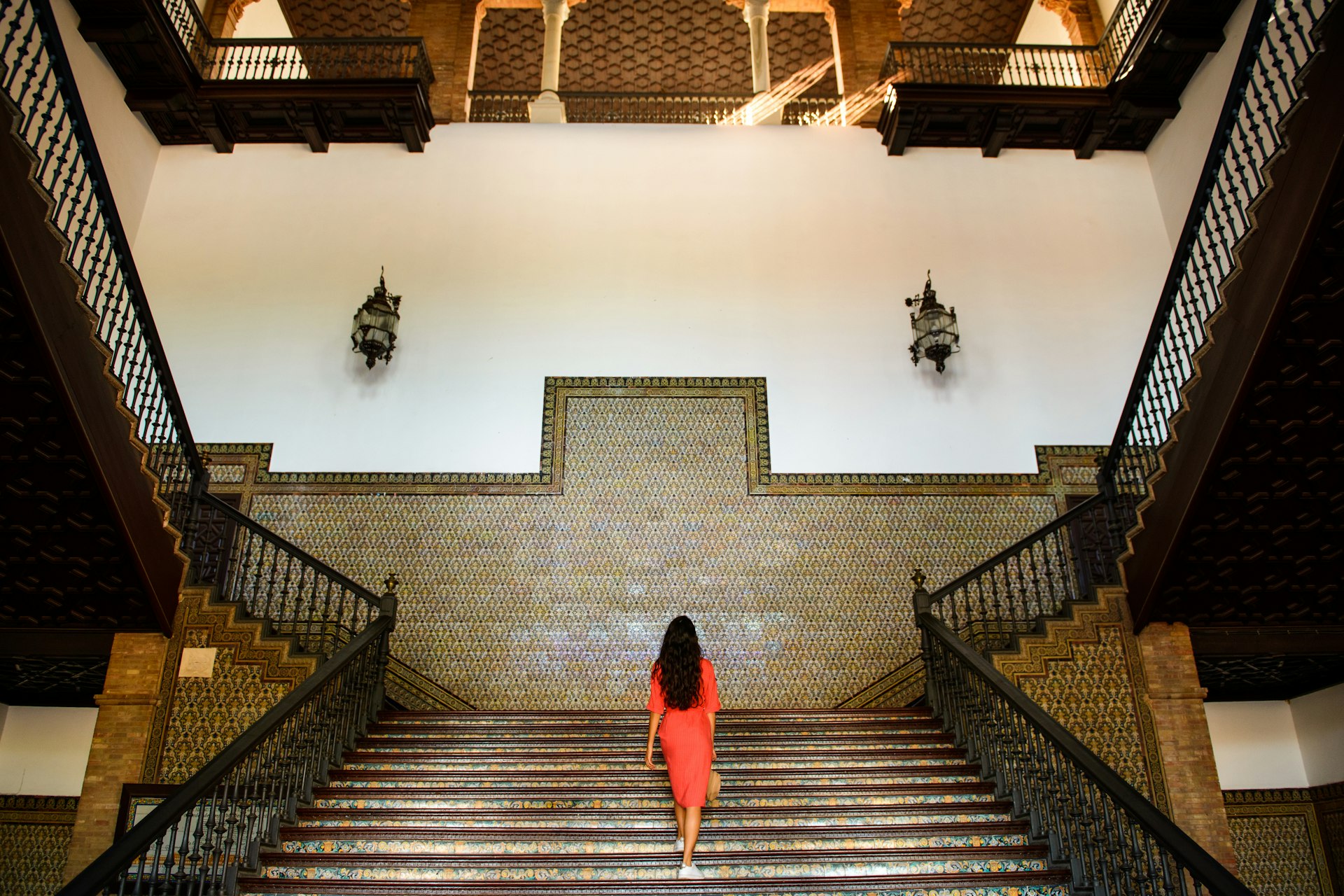
Days 9–11: Be spellbound by Seville
From Córdoba, it's a short hop (just 50 minutes by train) to fabulous Seville . You’ll want at least two days in this most romantic of southern Spanish cities or even three, if you can spare it. Climb to the top of La Giralda , the cathedral’s Moorish minaret for the incredible views, followed by more Moorish discoveries at the opulent Real Alcázar . On your second day in the city, head to the gorgeous grand sweep of Plaza de España and its exquisitely tiled pavilions, before hopping over the river to check out the atmospheric neighborhood of La Triana , where most of Seville’s tiles were once created. Andalusia serves up some of the best tapas in the country and, as its capital, Seville’s offerings are second to none. Make your way around the old Jewish neighborhood of Santa Cruz to dine in its fountain-filled plazas.
Day 12: Get to know Málaga
Another short train ride takes you down to Málaga , often merely a stopping point on the way to the beach resorts of the Costa del Sol, but definitely a city that warrants a little more exploration. Discover the palatial fortification of the Alcazaba , visit the childhood home of Pablo Picasso , then head to the chiringuito (beach bars) for some classic grilled fish, cooked right on the sand.
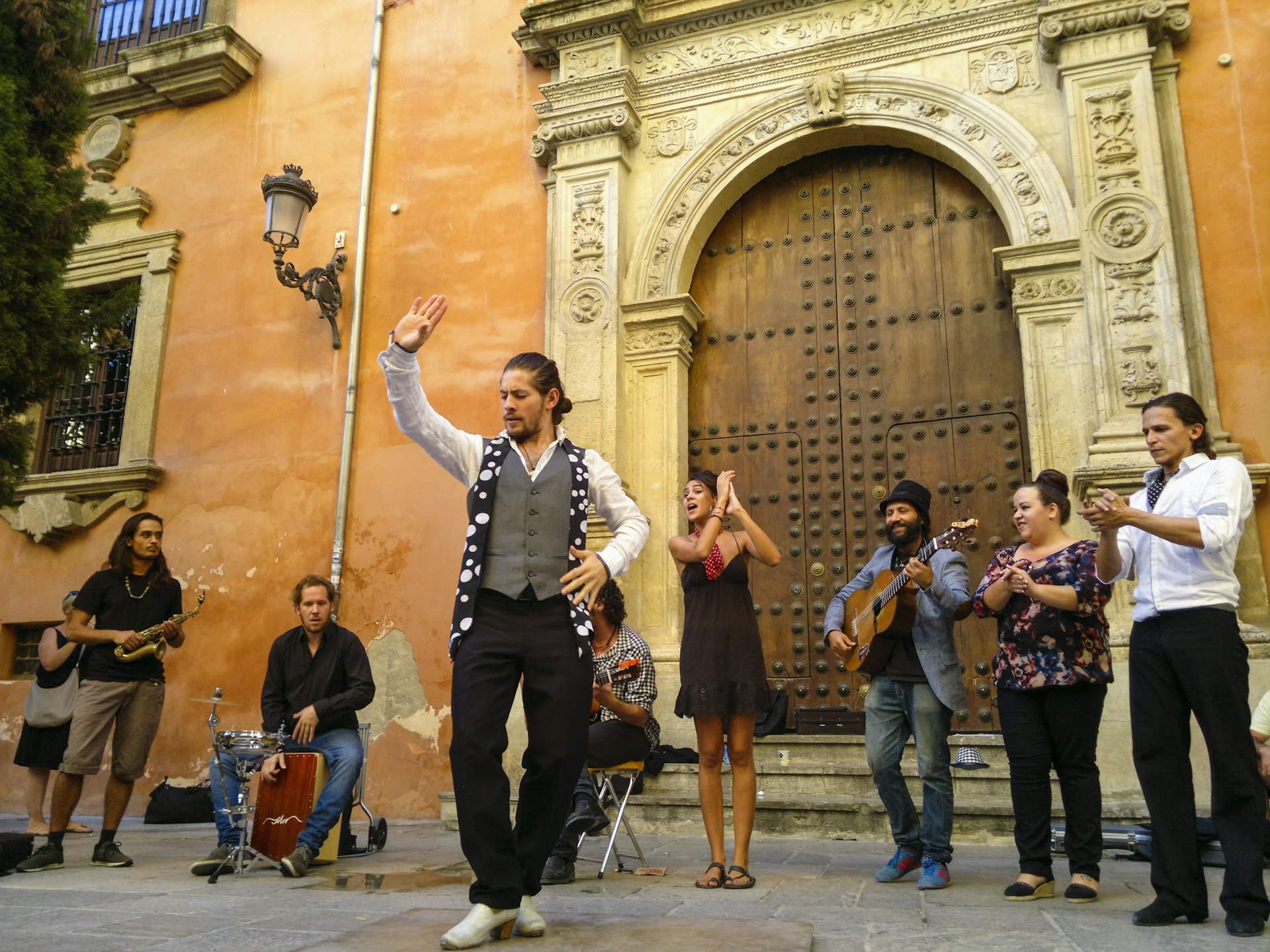
Days 13–14: Enjoy flamenco, food and palaces in Granada
We’ve saved the best until last: Granada boasts the extraordinary Alhambra , its soulful alter ego the Albayzín, and an eating and drinking scene that embraces Spanish culinary culture in all its glorious variety. Bar hop your way along Calle Navas for free tapas bites with each drink, then head up to the caves of the Sacromonte neighborhood for a traditional flamenco show.
Got just 10 days? Then you'll need this itinerary to Northern Spain
Is 10 days enough for Spain? Well, it might not be enough to see the whole country, but it’s plenty to explore a particular section in depth. Spain's Mediterranean coast may get the crowds, but the country's northern coastline from San Sebastián to Santiago is one of the most spectacular in Europe. Here’s how to see northern Spain in just 10 days.
Days 1–2: Have a food tour of San Sebastián
There is no finer introduction to the north of the country than San Sebastián , with its dramatic setting and extraordinary food scene. Two nights is a minimum here. Begin with a stroll around the sweeping bay of La Concha to see the impressive Peine del Viento sculptures by the famous Basque artist Eduardo Chillida, then learn all about Basque culture at the Museo San Telmo . Later, make your way around the Old Town stopping for pintxos bites along the way, followed by the best baked Basque cheesecake for dessert at La Viña .

Days 3–4: Discover the delights of the Guggenheim in Bilbao
West of San Sebastián, three hours by train, Bilbao is best known as the home of the showpiece Museo Guggenheim and warrants at least a night, preferably two. After visiting the masterpieces inside Frank Gehry’s titanium ship, there’s much more art and architecture to see, including Philippe Starck’s Azkuna Zentroa building and the city’s innovative street art. In the evening, go barhopping for tasty pintxos in the Casco Viejo. If you have two days in the city, spend your second day at nearby Arrigunaga Beach learning how to surf the waves.
Day 5: Drive through coastal Cantabria
Leave Bilbao behind and head west through Cantabria and Asturias. To make the most of the coast, you'll need a car. Cantabria's cobblestone Santillana del Mar , the rock art at Altamira and the village of Ribadesella will fill one day.

Day 6: Hike in the Picos de Europa national park
Drive south into the steep gorges and soaring peaks of the Picos de Europa , one of Spain’s largest and best national parks . Spend your time here hiking through the verdant green valleys or up into the clouds and, if you’re lucky enough, you may spot golden eagles, wild boar and brown bears.
Day 7: See historic architecture and sample local cider in Oviedo
Head to irresistible Oviedo , the capital of Asturias, known for its historic medieval old town and its Unesco World Heritage 9th-century stone churches. Make sure to take a break to visit a traditional sidrería for a glass of local Asturian cider.
Day 8: Explore the wild shores of Galicia
Tackle Galicia's coastline, one of Spain's great natural wonders, punctuated by secluded fishing villages and stunning cliffs. Don't miss Cabo Ortegal peninsula where the Bay of Biscay meets the Atlantic Ocean, the Glass City of A Coruña with its gorgeous galerías and the dramatic Costa da Morte . Along the way, stop for a traditional plate of pulpo a feira (Galician-style octopus sprinkled with paprika).
Days 9–10: Meet with pilgrims in Santiago
For the last two nights, linger in the thoroughly Galician city of Santiago de Compostela , a place of pilgrim footfalls, fine regional cuisine and a cathedral of power. There’s plenty to see here besides the cathedral however, including several impressive monasteries and convents. Feeling hungry? Make your way to Bar La Tita for – dare we say it – the tastiest tortilla de patatas (potato omelette) in Spain.
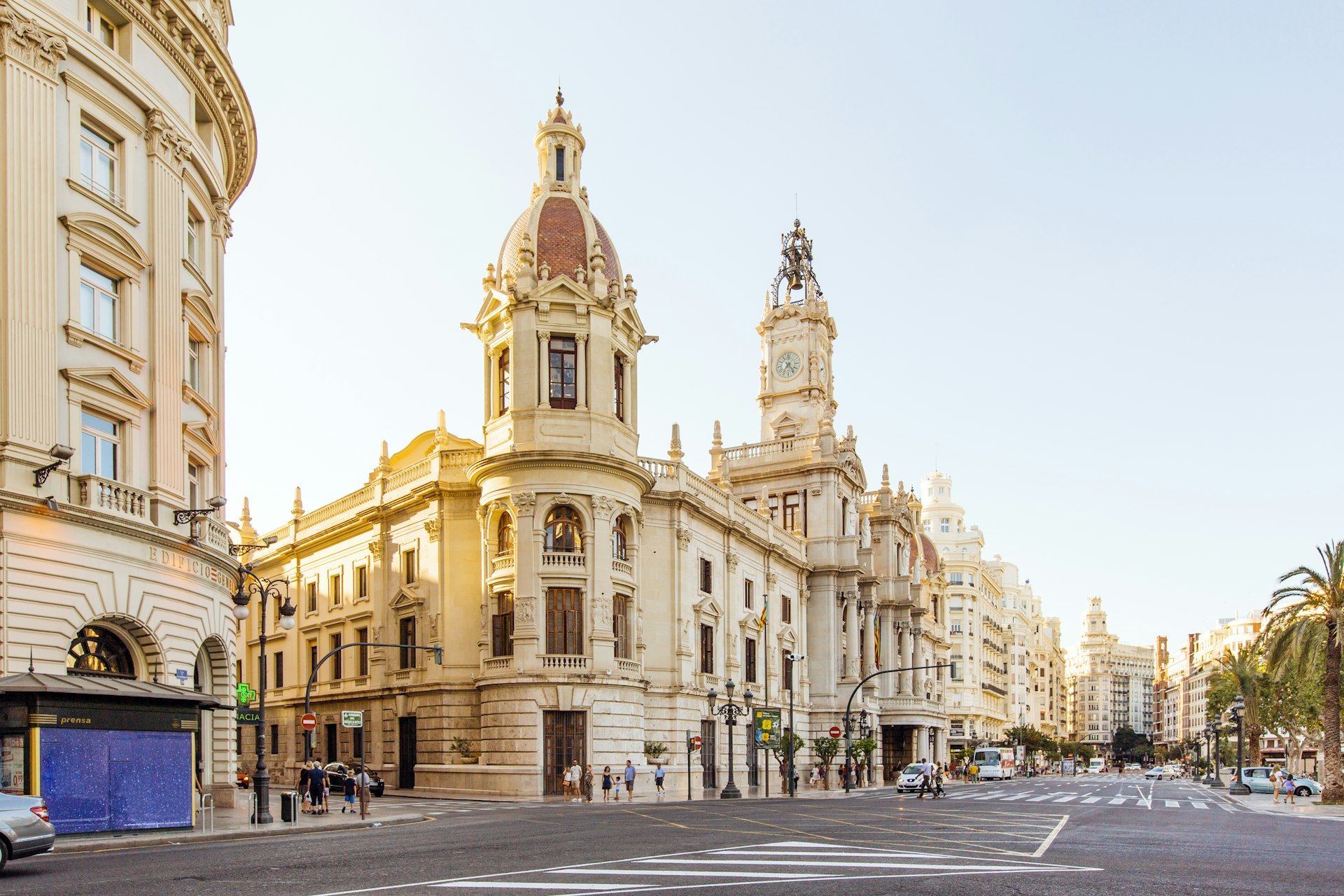
This 14-day itinerary takes you from Valencia to the Balearics
This journey takes you from the shores of the Mediterranean in Valencia to Mallorca, Ibiza and their hip little cousin, Formentera, three of the most beautiful islands anywhere in the Med. You'll need a car to explore the two bigger islands.
Days 1–2: Tour futuristic architecture and scoff paella in Valencia
Begin in Valencia , that most appealing of Mediterranean cities, which is worth staying in for a couple of nights. Spend your first day looking around the Old Town, the impressive Cathedral to search for the Holy Grail, the large Modernist food market and the exquisite Unesco La Lonja de la Seda . On day two, marvel at the futuristic Ciudad de las Artes y las Ciencias (The City of Arts and Sciences). If the heat gets too much, cool down with a traditional glass of horchata (tiger nut milk) at the 200-year old Horchatería Santa Catalina .
Days 3–4: Discover the best of Mallorca’s capital
Fly or catch a boat to Palma de Mallorca , the capital of the Balearics and a dynamic city with stirring architecture and world-class food. It’s well worth a couple of nights here before you head to the countryside and the beaches. Visit the city’s landmark La Seu Cathedral , explore the Casco Antiguo and tour the opulent Palau de l’Amudaina . There are plenty of museums and great restaurants to occupy your time too. When you need a break, stop for a delicious powdered-sugar-covered ensaimada (a typical Mallorcan pastry swirl).

Days 5–6: Drive through the mountains and orange groves in central Mallorca
After a couple of nights, take two days to drive Mallorca's west coast and the Serra de Tramuntana mountain range. Stop for one night in the charming mountain village of Valldemossa and the other in pretty Sóller , surrounded by orange groves and just a short hop to the coast.
Days 7–8: Relax on the beaches of Port de Pollença
Base yourself in Port de Pollença to explore the island's north for a couple more days, including the idyllic Cap de Formentor and the historic town of Alcúdia, surrounded by old medieval walls. Return to Palma to catch the ferry to Ibiza .
Days 9–10: Take in Ibiza’s Old Town
On arrival, take a couple of days to soak up the considerable charms of Ibiza Town's fortified old town of Dalt Vila and its superb nightlife. Here it’s more chic outdoor cocktail bars and romantic candlelit restaurants than thumping discotheques.
Days 11–12: See the quiet side of Ibiza
Leave it all behind for Ibiza's quiet and natural north coast, stopping in Sant Llorenç de Balàfia, with its great restaurants where you can order the traditional bullit de peix (fish stew), remote little Sant Mateu d'Aubarca, and artsy Santa Gertrudis de Fruitera.
Day 13–14: Spot wildlife in Ses Salines Natural Park
When you can tear yourself away, head for the Parc Natural de Ses Salines, some of the wildest and most beautiful country in Mediterranean Spain. Comprising both sea and coastal ecosystems, these salt flats and wetlands are home to over 200 bird species including pink flamingos, cormorants and ospreys.
Day 13–14: Experience island life on Formentera
Head back to Ibiza Town to catch the ferry (35 minutes) over to the tiny former hippie island of Formentera for your last two nights before heading home. It’s the perfect place to explore by bicycle, just 19km (12 miles) long and crisscrossed with many bike lanes and green routes.
Explore related stories
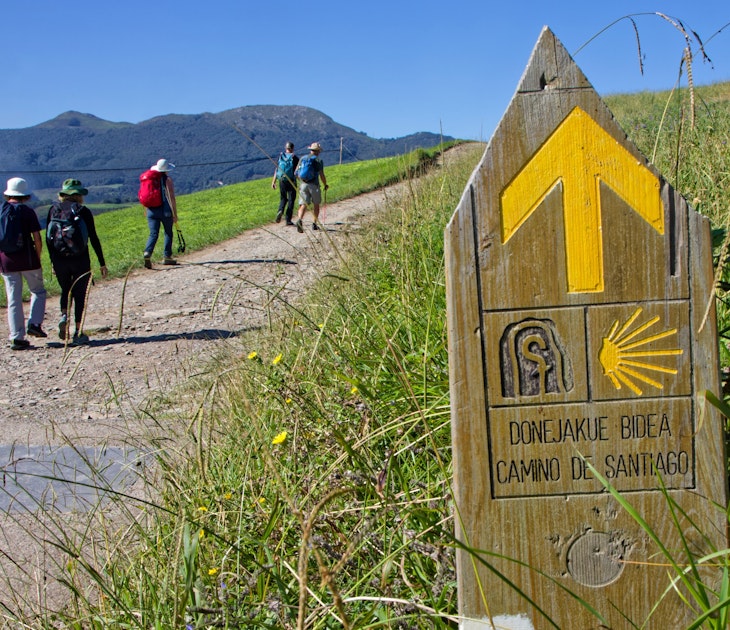
Mar 25, 2024 • 6 min read
Hundreds of thousands walk the Camino de Santiago pilgrimage in Spain every year: here are the most popular routes.

Mar 9, 2024 • 5 min read

Mar 7, 2024 • 10 min read

Feb 28, 2024 • 3 min read

Feb 10, 2024 • 7 min read
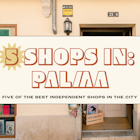
Feb 2, 2024 • 6 min read
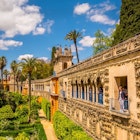
Jan 7, 2024 • 13 min read

Nov 1, 2023 • 15 min read

Sep 22, 2023 • 11 min read

Aug 22, 2023 • 7 min read

Best Of Spain Itinerary: 14 Days In Spain [2024]
- Post author: Nicoletta
- Reading time: 144 mins read
- Post last modified: February 25, 2024
- Post comments: 10 Comments

Spain is a very diverse country. It’s culturally & historically rich , has beautiful nature , and delicious food in every corner. I lived in Spain for 2 years and traveled extensively through the whole country. Thanks to my experiences , I’ve compiled this ultimate itinerary showing you the highlights.
I’ll take you to the cities reflecting many cultures and rich histories . You’ll have a chance to relax on beautiful beaches , see stunning nature, taste the delicious Spanish cuisine , and experience an authentic tapas crawl .
Ready for the exciting Spanish journey? Come and explore Spanish culture with me on this Spain itinerary for 8, 10, and 14 days.
✈ Travel Resources For Your Trip ✈
Here are some of my favorite travel resources I use for my travel adventures.
Overview Of The Spain Itinerary 14 Days & Map
Here is an overview of what you can expect from this Spanish itinerary each day:
How Many Days Are Enough To Explore Spain?
Spain is a huge country; you need at least 10 days to explore it. However, it all depends on what you want to see and what you want to do in Spain.
If you only want to explore major cities such as Barcelona, Madrid, Valencia, Bilbao, and Sevilla, 10 days would be enough to visit Spain.
In case you want to do more activities such as hiking, wine-tasting, cooking class, olive oil farm, surfing, or immersing into Spanish culture, I suggest spending at least 14 days in Spain .
✅ This itinerary is ideal for those who want to explore the highlights of Spain . With this itinerary, you can be sure to see it all and get the perfect overview of Spanish history and culture , do a cooking class, and enjoy its beaches and natural wonders.

How To Get To Spain
You can get to Spain by plane, train, or bus .
Flying to Spain is the most convenient, fastest, and often the cheapest. Just be aware of the luggage charges, especially if you book your flight with budget airlines such as Ryanair and Wizzair.
Taking a train is also great, and it takes less time to get to Spain than by bus. But you’ll have to change trains at least once.
Taking a bus is great as there are direct bus connections from other major cities. If you’re a budget traveler , you can also save up on accommodation for a night as you’ll travel overnight.
Flying To Spain
If you’re traveling from overseas , the best way is to fly to major Spanish cities like Barcelona, Madrid, Seville, or Bilbao. For this itinerary, you’ll fly to El-Prat Airport in Barcelona .
Also, if you’re in Europe, take advantage of cheap flights from other major cities such as Milan, Paris, Vienna, or Budapest.
You can fly with Ryanair or Wizzair , which always have great flight deals . However, be aware of the luggage allowance (with cheap flights, there are huge charges for extra baggage).
➡ Check out Skyscanner for the best flight deals to Barcelona here.
Getting To Spain By Train
You can take a train if you’re visiting Spain from nearby countries such as France and Switzerland . For any longer distances, it’ll be cheaper and faster to fly.
RENFE (Spanish railways) and SNCF (French railways) are the companies that run these routes.
You can get to Barcelona by train from the following cities:
- Marseille – 5 hours & 10 minutes to Barcelona (1 change)
- Nice – 8 hours to Barcelona (1 change)
- Paris – 7 hours to Barcelona (1 change)
- Geneva – 9 hours & 20 minutes to Barcelona (2 changes)
➡ Get the best train tickets via Trainline by clicking this link.
Getting To Spain By Bus
Alternatively, you can also get to Spain by bus. I recommend booking a bus with Flixbus or OUI companies . They have the best and fastest connections.
The advantage of taking a train and a bus is that there are no restrictions on how much luggage you can take.
You can take a bus to Barcelona, Spain, from the following cities:
- Paris – 15 hours to Barcelona (direct)
- Marseille – 7 hours & 30 minutes to Barcelona (direct)
- Geneva – 12 hours & 40 minutes to Barcelona (direct)
➡ Search the best bus connections via Busbud here.
How To Get Around Spain & Make This Itinerary
As for transportation, for each day, I provide how many hours it takes to get from one city or place to another. For this itinerary, half of it you’ll travel by train and you’ll rent a car for the rest in Andalusia .
Traveling By Train In Spain
I recommend you stick to train travel for longer journeys between cities like Barcelona, Valencia, and Madrid. So, travel by train on this itinerary from day 2. until day 5. when you get to Madrid . You’ll take the following 2 train connections on this itinerary:
🚇 Barcelona – Valencia (day 3.) 🚇 Valencia – Madrid (day 5.)
Look for train connections on Trainline . It’ll show you the fastest and best train deals for these three trains you’ll take.
PRO TIP: Make sure to buy the tickets in advance as Spain gets crowded and trains, especially during the summer (July and August).
Trains In Spain
The national railway company in Spain is called RENFE . For this itinerary, you’ll mainly travel on the high-speed trains called AVE . Trains in Spain are awesome. They’re reliable, you can get almost everywhere by train, and the journey is comfortable.
So I’m sure you’ll love traveling by Spanish train on this itinerary.
➡ Check out Trainline website and buy your tickets for AVE trains here.
Traveling By Bus In Spain
Bus connections are perfect in Spain. You’ll get by bus pretty much anywhere. The only disadvantage is that getting to a destination takes a lot of time .
You’ll only take a bus on this itinerary on day 7. for a day trip to Toledo and on day 8. when traveling from Madrid to Granada . There is no train connection from Madrid to Granada, so you must take a bus. Or you can rent a car already in Toledo if you want to.
Buses In Spain
The national bus company is called Alsa . You’ll take the Alsa bus for all your travels in Spain. Alternatively, you can also take Flixbus if it covers the route.
➡ Check out Busbud website and buy your tickets for Alsa bus here.
Renting A Car
It’ll be best to rent a car for the rest of this itinerary as it’ll give you much flexibility. Plus, train and bus connections in Andalusia (southern Spain) are not the best. I recommend renting a car in Granada on day 10 and returning it to Sevilla on day 13 of this itinerary.
So book a rental car for 4 days via Discover Cars . They have great deals:
RENT A CAR FOR YOUR ITINERARY

Rent A Car Via Discover Cars – best prices and big selection of car rentals. PRO TIP: Check ratings of the company you choose before booking ( ratings can be off ). Go on Google, see ratings of the car rental company, then book on Discover Cars.
Where To Start & Finish Your 14-Day Spain Itinerary
We’ll start this trip in Barcelona. So first, fly to Barcelona, which has 2 airports: El Prat or the Girona Costa Brava airport.
All international flights will get you to El Prat Airport in Barcelona .
How To Get From El Prat Airport To Barcelona City Center
Once you land at EL Prat Airport in Barcelona, you have 4 options to get to the city center of Barcelona:
- RENFE train
You can take the Aerobus , a blue bus shuttle from El Prat, directly to the city center ( Plaza Catalunya ). The bus will take you to the city center in 35 minutes.
You can also take a metro L9 every 7 minutes between El Prat airport and Zona Universitaria. Get off at Torassa (with a connection to the L1 metro line). It takes about 30 minutes to get to the center.
Or take a RENFE train that stops at Barcelona Sans, Passeig de Gràcia, and Clot. The train ride takes about 25 minutes.
A taxi ride from El Prat to Barcelona center can cost anywhere between 30 EUR and 35 EUR. It’ll take you to the city center between 25 and 40 minutes.

End Of Your Itinerary
We’ll finish our route in Sevilla . The city also has excellent international connections. So you can fly away from Spain from Sevilla easily.
Alternatively, you can take a train to Portugal and explore another country.
Travel Itinerary Planning Services
1. day: barcelona.
Our itinerary starts in the second-biggest Spanish city, Barcelona. Let yourself sort things out once you arrive. Go to your accommodation and get some snacks or a late breakfast because we’ll be exploring this lively city today.
We’ll start the sightseeing right in the center, Plaza de Catalunya . These are the sights I suggest you see today.
Sightseeing In Barcelona
🔅 La Rambla 🔅 La Boqueria Market 🔅 Plaza Espa ñ a 🔅 National Palace 🔅 Poble Espa ñ ol 🔅 Olympic Stadium 🔅 Montju ï c Castle 🔅 Magical Fountain Performance ( Plaza Espa ñ a )
🔅 Plaza De Catalunya
Plaza de Catalunya is the main square in central Barcelona. It divides Gracia and the old town of Barcelona . The square is the perfect start for our walking tour today.
You can easily reach it by metro or walk from your hotel.
If you need a coffee boost at the beginning of your walk tour, there are several coffee-stop options: Cafe Zurich, Hard Rock Cafe, or Starbucks at the corner.
🔅 La Rambla
La Rambla is the main shopping and touristy street in the city. Walking through the street, you’ll experience various artists, souvenir shops, and historical buildings.
Some of the most important historical buildings are Gran Theatre de Liceu, Casa Bruno Cuadros, and Principal Theatre.
🔅 La Boqueria Market
La Boqueria Market is one of my favorite places in the city . It’s a bustling food market in the middle of La Rambla. You can buy fruit juices and pieces and taste delicious Spanish products such as tapas, fresh fish, seafood, bread with delicacies, and sweets.
Go in and get lost in the market. Then, buy some treats for the rest of your walking tour of Barcelona. Entrance is free of charge .

🔅 Plaza España
Plaza España is hands-down the most beautiful square in Barcelona . It prides itself on a stunning fountain and a street leading up to the National Palace with a magical fountain in the middle.
It also has an arena that used to serve bullfighting until the activity was banned in Catalonia in 2012. Nowadays, it’s a shopping center.
🔅 National Palace
When you walk from Plaza España towards the magical fountain, the beautiful National Palace will spread in front of you. Nowadays, it hosts the Catalan Museum of Archaeology. You can go inside if that’s something you’re interested in. The walk is stunning, with beautiful views and fountains, so enjoy it.
➡ Click here to get the skip-the-line tickets for National Palace (discounted).

🔅 Poble Español
What I highly recommend is visiting Poble Español nearby. It’s a small Spanish village featuring regions of Spain with their points of interest , architecture , typical food , and sights .
This village has a unique atmosphere and will give you the perfect introduction to the Spanish culture and cities we’ll visit on our 14-day Spanish trip. It’s my one of my favorite sights in Barcelona.
➡ Get skip-the-line tickets for Poble Español by clicking here and don’t waste time in the crowd.
🔅 Olympic Stadium
After, walk further up and check out the impressive Olympic Stadium in Barcelona. It was built in 1927 for the International Exhibition in the city, and authorities wanted it to be the stadium for the Summer Olympic Games in 1936. But, unfortunately, the award got Berlin. So after, they renovated the stadium in Barcelona, and it eventually hosted the Summer Olympic Games in 1992 .
🔅 Montj uïc Castle
Montjuïc Castle is a unique fortress that is used to protect the city from invaders. During the Spanish Civil War , it served as a prison .
The translation of this name is literally ‘ Jewish mountain ,’ and you’ll see a Jewish cemetery inside the fortress.
➡ Book this guided tour of Montjuïc and visit it on an E-Bike with local guide here.
🔅 Magical Fountain Performance
In the evening, I highly recommend seeing the performance of the magical fountain near Plaza España. It starts at 7 pm or 8 pm , depending on the time of the year. It’s a free 20-minute show with waterfalls, colors, and dramatic music.
Check their official website for updated information about the magical fountain and its performance, as it changes yearly.

How To Get To Montjuïc Castle
If you don’t want to walk all the way up from Plaza España to Montju ï c Castle, you have other 2 options:
Montjuïc Funicular
When you take the metro at Drassens station , you’ll get off at Parar-lel station . There is a connecting funicular , which takes you to the Montju ï c hill (close to the Olympic stadium).
So you’ll still have to walk 20 minutes from the Olympic stadium to Montju ï c Castle or take the bus n. 150 . You don’t have to pay anything extra for the funicular, you can use your regular metro ticket for it.
Teleferic De Montjuïc
It’s a cable car that will take you straight up to the Montjuïc Castle. You’ll also get off at Parar-lel metro station , where the cable car station is located. However, this option is quite pricy and touris ty. If you walk, you’ll get to enjoy it more and see more things.
➡ Get skip-the-line tickets for Montjuïc cable car here (round-trip).

👉 READ ALSO: Best Of Barcelona Itinerary 3 Days
Where To Stay In Barcelona: My TOP TIPS For Accommodation
If you want to stay in the Old City (Ciutat Vella):
PARK HOTEL MERCER HOTEL BARCELONA
If you want to stay in Barcelonetta (next to the beach and port):
BARCELONA PORT RAMBLAS W BARCELONA
If you want to stay on Las Ramblas (main tourist street leading to the main square):
HOSTAL OPERARAMBLAS HOTEL BAGUES (SMALL LUXURY HOTEL)
If you want to stay at the Plaza Catalunya (main square):
H10 METROPOLITAN 4* SUP OLIVIA PLAZA HOTEL
If you want to stay at the Passeo de Gracia (main shopping street), in the heart of Barcelona close to all attractions:
UMA SUITES PASSEIG DE GRACIA ME Barcelona
If you want to stay close to Sagrada Família:
ABSOLUTE SAGRADA FAMILIA RADISSON BLUE 1882 HOTEL
2. DAY: BARCELONA
Good morning to Barcelona. I hope you slept well because we’ll see as much of Barcelona as possible before departing to another wonderful part of Spain.
Get a good breakfast at your hotel if you don’t have it included even better. Head to a local bakery (they are everywhere) and grab some fresh bread or pastry with coffee.
Our sightseeing starts again at Plaza Catalunya and goes through the old city of Barcelona .
🔅 Basilica de Santa Maria del Pi 🔅 Plaza de Sant Felip Neri 🔅 Plaza de Sant Jaume 🔅 Barcelona Cathedral 🔅 Sagrada Familia 🔅 Arc de Triomphe 🔅 Parc de la Ciutadella 🔅 Port Olimpic 🔅 Barceloneta
Barcelona Guided Tour On Segway
Book this guided tour of Barcelona on a segway and see all the sights within 3 hours with a local guide.
🔅 Basilica De Santa Maria Del Pi
Today, we’ll explore the old town of Barcelona and its Gothic Quarter. First, admire the basilica and its beautiful Gothic Catalan architecture . It was built in 1391 and is one of the oldest buildings in the city.
🔅 Plaza De Sant Felip Neri
This square reflects Barcelona in the Spanish Civil War when it was bombed by a fascist plane. 42 people lost their lives here. Nowadays, you can see the buildings damaged by the bombing in this square .
🔅 Plaza De Sant Jaume
Plaza de Jaume is one of my favorite little squares in Barcelona. It hosts a tourism office, tiny shops with local goods, cute souvenirs, and cafes. So spend time here, shop for souvenirs , or make a coffee stop .
🔅 Barcelona Cathedral
Barcelona Cathedral is the most impressive building in the city’s old town that you can’t miss. You can see the crypt of St. Eulalia . She was a significant saint as she didn’t want to renounce Christianity and was persecuted , tortured , and murdered by the Roman soldiers.
Besides, you must check out its gardens and the 13 geese walking around , which is pretty special for it being a cathedral.
➡ Book skip-the-line entrance tickets for Barcelona Cathedral here.
🔅 Sagrada Familia
After visiting the Barcelona Cathedral, walk to the Plaza Catalunya . From there, take a metro to Sagrada Familia (purple line).
Welcome to Sagrada Familia, one of the most impressive architectural buildings ever. Antonio Gaudi , the famous Spanish architect, designed it. The construction started back in 1882, and imagine, it is still not finished . So, unfortunately, its maestro didn’t get to see his masterpiece in its full beauty.
➡ Get this skip-the-line ticket with audioguide for Sagrada Familia and secure your spot.

🔅 Arc De Triomphe
Once you finish visiting the Sagrada Familia, take a metro to Placa de Tetuan . Then, walk to the next monument, Arc de Triomphe. Alternatively, take a taxi or an Uber.
This stunning monument was built in 1888 for the World Exhibition and was an entrance to the World’s Fair . It has the typical architecture in southern Spain ( Andalusia ). Walk through until you reach Parc de la Ciutadella.
🔅 Parc de la Ciutadella
I absolutely love this park. You can have a picnic or just walk through and enjoy its special atmosphere.
🔅 Port Olimpic
Now, we’re coming to the party sight of Barcelona with many clubs , restaurants , cafes , and a beautiful promenade .
Take your time to walk alongside the beaches on the promenade and enjoy the breeze in Barcelona. You can stop by some restaurants and grab some food. Walk until you reach Barcelona.

🔅 Barceloneta
Barcelona is one of the most popular parts of Barcelona, where people come to socialize , enjoy food and drinks , and swim in the sea. So in the evening, come here and enjoy a delicious dinner , have some drinks, and reflect on your Barcelona walking tour.

Top Experiences In Barcelona
Between the old town walking tour, I also highly recommend visiting the top sights such as Park Guell and Gaudi’s Casa Batllo.
You can visit Casa Batllo after Barcelona Cathedral. Then visit Sagrada Familia and make your way up to Park Guell . After, continue the walking tour from Arc de Triomphe.
For these 2 sights, getting skip-the-line tickets is essential ; otherwise, you won’t get in. Click on the names below and book your tickets asap.
➡ PARK GUELL – get tickets here ➡ GAUDI’S CASA BATTLO – get tickets here

👉 READ ALSO: Top 8 Road Trips From Barcelona
3. DAY: BARCELONA ⇒ VALENCIA
Today, we’re going to take a train from Barcelona to Valencia, the birthplace of Paella .
Distance Barcelona ⇒ Valencia: Train ride takes about 3 hours (operated by RENFE) ➡ Book your train tickets here.
Once you arrive in Valencia, take some time to get to your accommodation . We can start the tour once you are ready.
Sighseeing In Valencia
🔅 Central Market 🔅 Valencia Old Town 🔅 Plaza de la Reine 🔅 Valencia Cathedral 🔅 Miguelete Bell Tower
🔅 Central Market
At the beginning of our exploration of Valencia, let’s try some Spanish specialties. At the Central Market, you’ll feel the laid-back style of the Spaniards , enjoying their tapas and talking. One drink you can try is called horchata . It’s a typical drink of Valencia.
🔅 Valencia Old Town
From the Central Market, we’ll head to explore the rest of the sights in Valencia’s old town . These are mainly the Cathedral of Valencia and its stunning Miguelete Bell Tower.

🔅 Plaza De La Reina
Plaza de la Reina is my favorite square in Valencia. It has many cafes and restaurants , from which you can admire its impressive cathedral and the bell tower. So make a coffee stop here, admire its surroundings, and take some photos .
🔅 Valencia Cathedral
Interestingly, this cathedral was built on the mosque . Nowadays, it’s a Gothic cathedral featuring different architectural styles such as Renaissance, Baroque, and even some Neoclassical elements. It’s dedicated to Saint Mary.
🔅 Miguelete Bell Tower
Head up to the Cathedral’s Bell Tower and admire the stunning views of the city. It’s 50.58 meters high and offers the best views of Valencia .
Traditional Valencian Paella & Beach Walks
For the evening, we’ll let ourselves have a peaceful walk alongside the beach and try the local Paella. Believe it or not, you can get a good Paella on the beach. Head to the Platja de la Marva-rosa to get a traditional Paella Valenciana or much more.
Casa Carmela Restaurant
The restaurant I recommend you to go to is on Platja de la Marva-rosa, called Casa Carmela. They have many kinds of Paella, including the traditional one – Paella Valenciana . You can’t leave Valencia without eating Paella.

Where To Stay In Valencia: My TOP TIPS For Accommodation
VENECIA PLAZA CENTRO – budget-friendly (city center) HOTEL VALENCIA ALAMEDA – mid-range hotel (close to the City of Arts & Science) ANKA BEACH APARTMENT – luxury apartment (at the beach)
4. DAY: VALENCIA
Today is all about Valencia and science, as we are heading to the famous City of Arts and Science .
City Of Arts & Sciences
The City of Arts and Sciences is a complex museum in Valencia. Depending on your interests, you can visit only a few parts and buy tickets separately (or visit it all). It consists of 6 parts :
- L’Hemisferic – It was designed to remind you of a giant human eye and has a 3D cinema. You’ll get 3D glasses with a speaker, enabling you to watch whatever is on in your own language.
- L’Oceanographic – Experience the largest glass water tunnel in Europe, see dolphins and the Sea Life.
- Science Museum of Principe Philip – The musem hosts various exhibitions, which are also great for children, as it offers many activities.
- L’Umbracle – This part of a complex is free to enter. It’s a walk packed with local plants.
- Palace Of Reina Sofia Arts – The Palace of Reina Sofia Arts is an opera house and a theatre that you can visit inside the City of Arts & Sciences.
- L’Agora – An exhibition space, hosting many sports events.

What To Visit In City Of Arts & Sciences
You can choose to visit whatever part of the complex interests you. It may just be the L’Oceanografic or the L’Hemisferic . Or maybe you don’t want to pay and will only go through the L’Umbracle.
Sometimes, there are also some food markets to get some food. If not, there are restaurants and a supermarket in the shopping center across the street, where you can get lunch.
Valencia City Of Arts & Science Tickets

Get 3 in 1 access to the City of Arts & Sciences in Valencia and visit the highlights of it with this skip-the-line ticket .
Afternoon & Shopping In Valencia
Have a lovely free afternoon if you’ve managed to see what you wanted in the City of Arts and Science. Walk through Valencia, or maybe shop if it fulfills your soul. There are many shopping spots in the center.
Relax On Beaches In Valencia
Another option is to have a beach afternoon. Relax on one of the great Valencian beaches – Platja de la Marva-rosa or Platja de las Arenas .
Have some more Paella if you become slightly addicted as I did :D. Tomorrow, we’re leaving this great city to see more Spanish highlights.
Spanish Festivals Near Valencia
Valencia also hosts two famous Spanish festivals , and I highly recommend you to be part of it. It’s the Las Fallas festival , annually held in March.
Another Spanish festival, La Tomatina , takes place in the small town of Buñol, located just 30 minutes by car (1 hour by train) from Valencia. It takes place in August every year.
So, if you’re in Valencia in March or August , plan your visit and participate in these celebrations.
Read about these 2 festivals by clicking on the image below:

5. DAY: VALENCIA ⇒ MADRID
We’re now heading to the capital of Spain, Madrid. As the largest Spanish city, Madrid has also been declared the European cultural capital .
It has plenty of famous museums to explore, so don’t wait any longer. Let’s travel to the center of Spain by train.
Distance Valencia ⇒ Madrid: Train ride takes about 2 hours (operated by AVE) ➡ Book your train tickets here.
We can start our Madrid city tour after you check in to your accommodation.
Below, I suggest the top places you can see in Madrid . Many museums are included, so choose one or two based on your interest.
Tomorrow, you’ll have an entire day in Madrid, so you can also do some sightseeing for the next day.
First, I recommend visiting some museums. Choose from the 3 museums I listed below. If you aren’t so much into the museum , enjoy Madrid’s atmosphere. Admire the stunning old buildings and have some churros.
Sightseeing In Madrid
🔅 Prado Museum 🔅 Reina Sofia Museum 🔅 National Archaeological Museum 🔅 Royal Palace 🔅 El Retiro Park 🔅 Puerta del Sol 🔅 Churrería San Ginés 🔅 Plaza Mayor 🔅 Mercado San Miguel
🔅 The Prado Museum
If you’re unsure which museum to visit but want to see at least one, opt for the Prado Museum. It has a full collection of Spanish and European art from the 12th to the early 20th century .
You can explore the masterpieces of many artists from the Baroque and Renaissance epochs.
➡ Get skip-the-line tickets for Prado Museum by clicking this link. ➡ Book a guided tour of El Prado incl. tickets here.
🔅 Reina Sofia Museum
Inside the Reina Sofia Museum, you’ll find Spanish art masterpieces from authors such as Miro , Dali , and Juan Grid . It displays the most famous Spanish pieces in the world.
If you love art and want to see more Spanish art, visit this museum.
➡ Get skip-the-line tickets for Reina Sofia Museum here. ➡ Book a guided tour of Reina Sofia Museum by clicking this link.
🔅 National Archaeological Museum
The museum was founded by Isabel II of Spain back in 1867. You can learn a lot of history about Spain, the Spanish Reconquista , and how the Spanish Kings Ferdinand and Isabell II. fought against the Moors and saw many artifacts from the period.
So, if you’re a history lover , this museum is for you.
➡ Book tickets for National Archaeological Museum incl. audio guide here.
🔅 Royal Palace
The Royal Palace in Madrid is the largest palace in Western Europe and one of the biggest in the world. It was home to all Spanish Kings .
This is the best place to learn about Spanish history , the life of Kings, and famous historical battles . For me, Spanish history is one of the most interesting after the French one, and I absolutely loved visiting the palace.
➡ Get skip-the-line ticket for Royal Palace Madrid here. ➡ Book a guided tour of Royal Palace and learn about the history with a local here.
🔅 El Retiro Park
El Retiro Park is my favorite place in Madrid. It’s a nice place to relax after your sightseeing . You can walk around, have a picnic , or even ride a boat on a lake . Take some time to chill inside the park before you continue to the main square.
🔅 Puerta del Sol
Puerta de Sol is one of the most beautiful squares in Madrid . It links many important streets and has some cafes and shops. In the middle, you can admire the statue of King Charles III .
Pay attention to the main post office building . It was built in 1786, and its huge clock plays a special role in the city. It always rings during special occasions and announces New Year during Spanish celebrations. Try to find the Kilometer Zero Plaque , which marks the center of Spain.
This square is also perfect for a coffee stop and eating traditional churros .
🔅 Churrería San Ginés
Something you can’t miss when you’re in Puerta del Sol is traditional Churrería San Ginés . It’s a churro and chocolate store where they serve traditional churros with chocolate .
This is the best place (perhaps in the country) to try churros . So take some time, order churros with chocolate, and enjoy the sun.
🔅 Plaza Mayor
Plaza de Mayor is the main square in Madrid, built between the 16th and 17th centuries during the reign of King Philip II. Unfortunately, local buildings were destroyed several times by fire . And so what you see nowadays is a renovated version.
In the past, the square was used for many purposes , including royal celebrations, bullfighting competitions, soccer games, and crowning ceremonies. On Sundays, it hosted traditional markets .
Nowadays, you can enjoy cafes and restaurants , where you can also experience beautiful Christmas Markets in December .

🔅 Mercado San Miguel
If you want to eat tapas or enjoy Spanish cuisine , I highly recommend ending your walking tour at the San Miguel Market. It’s located near Plaza Mayor and is Madrid’s first gourmet market .
Many locals come here to eat and drink with their friends and socialize. The building is stunning, and the atmosphere inside the market is amazing. So even if you don’t want to eat, it’s worth visiting it and seeing local specialties .
👉 READ ALSO: Christmas In Spain: Complete Guide With Traditions & Best Places
Madrid Nightlife & Best Clubs
Madrid has excellent nightlife , so head to the streets in the evening and enjoy your time here.
Here are some of the best night clubs in Madrid:
- Teatro Kapital
- Goya Social Club
- LAB theClub
If you want to learn more about the city and its history, check out some guided walking tours below:
Madrid Guided Tour

Book this guided tour and learn more about the history and culture of Spain’s capital with a local guide.
Where To Stay In Madrid: My TOP TIPS For Accommodation
HOSTAL PALACIO LUNA – budget-friendly hotel HOTEL LIABENY – mid-range hotel ORIENTE PALACE APARTMENTS – luxury apartments
6. DAY: MADRID
Take your time to enjoy another day in Madrid. You have the entire day to explore what you didn’t manage yesterday.
May it be your museum’s round day or just chilling in Retiro Park , get the most out of Spain’s capital.
I also highly recommend doing a cooking class in Madrid . Experience the cuisine hands-on with a local. Learn how to prepare Spanish dishes and eat them afterward. It’s a lot of fun:
Cooking Class In Madrid
Book this cooking class in Madrid and learn how to prepare paella or Spanish tapas. The Paella class is in the morning with a market visit. The Tapas class is in the evening.
7. DAY: TOLEDO DAY TRIP
Let’s explore another charming Spanish city. Today, we’ll make a day trip from Madrid to Toledo . It’s my second favorite city in Spain (right after Seville). I’m sure you’ll love it , too.
You can choose to visit Toledo by yourself from Madrid (by bus) or join an organized day trip from Madrid to Toledo, which I recommend at the end of this day.
Distance Madrid ⇒ Toledo: Bus ride takes 1 hour (operated by Alsa Bus) ➡ Book your return bus tickets here.
Sightseeing In Toledo
Toledo features a mixture of cultures, Christian , Jewish , and Moorish sites , and their architecture will surely capture you. You can explore the following sites in this enchanting town.
🔅 Toledo Cathedral 🔅 Alcázar de Toledo 🔅 Monasterio de San Juan de los Reyes 🔅 Mirador del Vale
🔅 Toledo Cathedral
This Gothic-style cathedral is the main church in Toledo, dating back to the 13th century . For over 370 years , Toledo was mainly occupied by Muslims. So the cathedral used to be a mosque in the past. Only when Alfonso IV., King of Castile and Leon (a region in the north of Spain) peacefully reclaimed this city the church became the main cathedral in the city.
🔅 Alcázar De Toledo
As you already know, Spain was occupied by Muslims called Moors . These Moors came from Africa and settled in southern Spain (Granada). After, they wanted to claim more of the Spanish territory and started going north.
They also captured Toledo , and so that’s why you can explore the Jewish, Catholic, as well as Moorish cultures in many cities in Spain. Toledo hosts one of the most impressive Alcazar, a fortress that protected the city.
Nowadays, it’s a military museum displaying various weapons .

🔅 Monasterio De San Juan De Los Reyes
The monastery was built as a celebration of the victory in the Battle of Toro . The Catholic Monarchs, Isabel II. and Ferdinand commissioned the construction in the Jewish quarter in Toledo. It commemorates the victory of Spanish Kings against Portuguese King Alfonso V, who wanted to take over the Castille region in Spain.
🔅 Mirador Del Vale
If you want some beautiful photos of Toledo , head to the Mirador del Vale for the views and photo shooting.
Best Views In Toledo
Except for the Mirador del Vale viewing point, there is one more interesting spot for views of Toledo. Go up to the library and Cafeteria in Alcazar . You can get the best views of the entire city from this spot.
Walk around and get lost in the thousands of tiny streets and admire the architecture of the buildings. Toledo will take you back to medieval times .
PRO TIP: Try the Suckling pig at a restaurant, which is the local specialty of Toledo .
Organized Tour To Toledo (From Madrid)
Join this organized guided tour to Toledo from Madrid. You won’t have to plan anything and can visit it with a guide.
8. DAY: MADRID ⇒ GRANADA
Our itinerary continues to the south of Spain . Today, another travel adventure awaits us, traveling to a brand-new autonomous community. Indeed, the biggest one is where we stay and explore its hidden germs until the end of our trip.
In the morning, travel from Madrid to Granada, the birthplace of Spanish flamenco . There are only buses runing to Granada, no trains .
Alternatively, you can already rent a car in Toledo , if you don’t want to take a bus.
Distance Madrid ⇒ Granada: Bus ride takes about 4 hours & 30 minutes (operated by Alsa) ➡ Book your bus tickets here.
Welcome to Andalusia (southern Spain), the largest Spanish region (autonomous community). You have now arrived in Granada, an important city in Spanish history. Don’t wait any longer; check in to your accommodation, and prepare to explore.
Like Toledo and other Andalusian cities we’ll visit on this trip, Granada reflects the culture and co-living of three cultural and religious groups – Christians , Jews , and Moors .
Under the Moorish rule, many Andalusian cities, including Granada, achieved social, ethical, and spiritual integration of these three groups in one place.
👉 READ ALSO: Best Of Southern Spain Itinerary For 10 Days
Sightseeing In Granada
🔅 Alcaicería 🔅 Granada Cathedral 🔅 Royal Chapel 🔅 Corral del Carbón 🔅 Albaicín 🔅 San Nicolás Square 🔅 Sacromonte
🔅 Alcaicer í a
We’ll start our walking tour visiting this historical Moorish bazaar in the heart of the city (close to the cathedral). It used to be a silk market during the Moorish times.
Nowadays, it’s a typical Arabic market with traditional products , clothes, and souvenirs. I love the atmosphere of this market, so check it out even if you don’t want to buy anything.
🔅 Granada Cathedral
The cathedral was built on the small mosque constructed here during the Moorish times.
Once the Catholic Monarchs from Castile and Leon finally fought back the Moors and took back the territory of Granada and Andalusia, they undertook strict measures .
All Moors had to convert to Catholicism or were expelled from the city .
The cathedral symbolized Catholic reign in Andalusia and remains so until now.
➡ Get this skip-the-line ticket for the Cathedral & Royal Chapel. ➡ Join this guided tour of Cathedral and learn about the Spanish Monarchs & Inquisition
🔅 Royal Chapel
As a memory of the victory over the Moors, the Royal Chapel is the burial place of the Spanish Monarchs , Queen Isabell I. and King Ferdinand. You can see the crypt inside the chapel.
➡ Get this skip-the-line ticket for the Cathedral & Royal Chapel. ➡ Join this guided tour of Royal Chapel and learn about the Spanish Monarchs & Inquisition
🔅 Corral Del Carbón
Corral del Carbón is the oldest traditional Andalusi building, dating back to 1336. It served as a Coal yard, a warehouse of goods , and a shelter for merchants coming to Granada.
After exploring the Catholic parts of the city, it’s time to see Granada’s Arab Quarter , where you can explore beautiful Moorish architecture . It’s the one side of Granada that makes the city so special. It’s also the oldest neighborhood of Granada . Stop by Taberna 22 for the best tapas in the city.
After, head up to San Nicolas Square for the best views of Granada.
🔅 San Nicolás Square
San Nicolas is my favorite place in Granada . It offers the best views of Alhambra and the spectacular Sierra Nevada mountain behind it. So take some time for great photos, sit in a local cafe, and enjoy the views.

🔅 Sacromonte
Sacromonte is a traditional neighborhood of Granada, which became home for gypsies after the Moors were expelled.
This is the spot to go to if you want to see an authentic flamenco performance. Scroll down to see the flamenco performance I recommend seeing today in the evening .
Granada Walking Tour
Book this walking tour of Granada and explore Albaicin with Sacromonte with a local guide.
Tapas Culture In Granada
Granada is the perfect place for tapas hunting . Once you go to a bar, order a drink, and in most places in Granada, you’ll get small tapas for free .
Tapas can be anything from pimiento (peppers), Spanish tortilla, patatas bravas (baked potatoes with salsa), deep-fried eggplant (Granada’s specialty) , or calamari, croquettes, or olives with Jamón (Spanish dry-cured ham).
Best Tapas Bars In Granada
- La Botilleria
- Bodegas Castañeda
- Bar Casa Julio (seafood tapas)
- La Riviera (surprise tapas)

Flamenco Show In Granada In The Evening
Andalusia is the birthplace of Flamenco, a Spanish traditional dance. There is no better spot than experiencing the Flamenco show here in Granada. The best spot for it is the Sacromonte .
I recommend the following Flamenco show in a unique cave setting.
Where To Stay In Granada: My TOP TIPS For Accommodation
FLORENTIA HOMES – budget-friendly U-SENSE GRANADA CATHEDRAL – mid-range hotel ALHAMBRA PALACE HOTEL – luxury hotel
9. DAY: GRANADA & ALHAMBRA
Good morning to Granada. Today, we’ll explore the impressive Alhambra ; your afternoon will be free.
Alhambra is a town alone within Granada. Take at least half a day to see it. It has many statuses, from fortress to palace, castle, and summer retreat.
Alhambra complex was built back in the 1200s during the Muslim reign in Andalusia . The Nasrid dynasty lived in Alhambra for many years until the Spanish Monarchs conquered and expelled Moors from Andalusia and Spain.
Alhambra then became the royal residence of the Spanish Catholic Monarchs . Nowadays, it’s a top attraction to visit in Europe and serves mainly as a museum.
Skip-the-line Tickets Necessary For Alhambra
Tickets for Alhambra tend to be booked way in advance (more than 3 months before the visit) . I highly recommend you plan the visit ahead of time and reserve the tickets for Alhambra at least 3 months before . But you might be lucky even later on.
I also highly recommend booking a guided tour , it’ll give you a much better experience than just walking around by yourself.
Get the tickets below and book in advance:
Alhambra Tickets & Guided Tour
Alhambra free of charge.
If you’ve missed booking your ticket in advance and can’t go inside the Alhambra complex, or don’t want to pay for it, don’t worry. There are many areas to explore within the complex free of charge .
Just enter the main gate, walk through the beautiful Generalife gardens with fountains, and admire Alhambra’s surroundings.
Free Afternoon In Granada
Enjoy your free afternoon exploring the rest of the places, walk through Granada’s Great Bazaar , Alcaiceria , and don’t forget to go tapas hunting .
For best sunset views, go up to the Plaza San Nicolás and its viewing point.
👉 READ ALSO: Do You Need Spanish To Travel To Spain? My Experience
10. DAY: GRANADA ⇒ MÁLAGA
Today, we’re going further south to the famous Costa del Sol . We’ll rest from sightseeing and enjoy the small towns with great beaches for you to relax.
Now it’s also the time to rent a car for 4 days. So in the morning, rent a car in Granada and drive to Málaga, the birthplace of Picasso .
RENTAL CAR: You’ll rent a car for 4 days (and return it in Sevilla on day 13. of this itinerary).
Distance Granada ⇒ Málaga by car: approx. 1 hour 40 minutes (132km/82 miles).
I’ve taken you to Málaga, a great central point on the Costa del Sol , from where you have connections to get to the lovely places around. You can unpack your suitcases for a while, as we’ll stay 3 days here . It’ll serve as the base for our daily excursions .
Check in to your accommodation and have an excellent free day in Málaga . You can go to the beach to relax or stroll through the city.
Sightseeing In Málaga
🔅 Picasso Museum 🔅 Picasso’s House 🔅 Alcazaba 🔅 Roman Theatre 🔅 Málaga Cathedral 🔅 Castilo De Gibralfaro 🔅 Ataranzas Market
Málaga is the birthplace of Picasso , so if you like his art, check out the Picasso Museum and see the collections of his paintings. You can also visit Picacco’s House at the Plaza de la Merced .
Don’t forget to check out the Ataranzas Market to see how locals hang out and try local specialties.

Best Beaches In Málaga
You can spend your afternoon chilling on one of Málaga’s beaches. Playa la Malagueta is directly in front of the city (walking from the city center). Or you can go to a smaller Playa de la Misericordia . But it’s further from the city center (30 minutes by bus).
- Playa la Malagueta
- Playa de la Misericordia
Málaga Guided Walking Tour
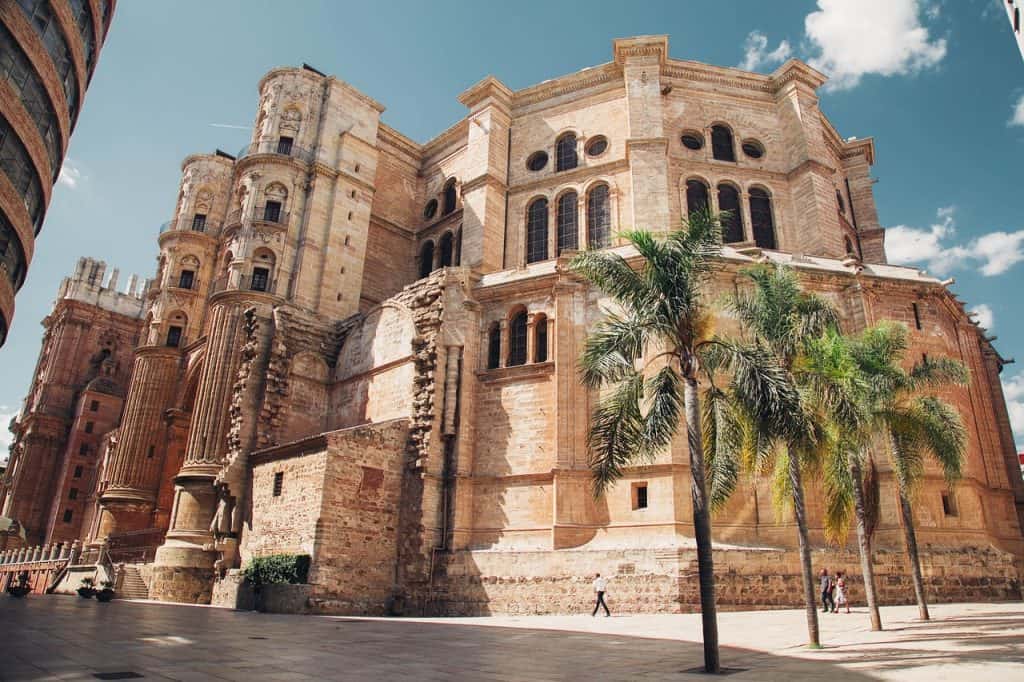
Book this guided tour of Málaga to learn about the stories from Piccaso and the history of this part of Spain.
Where To Stay In Málaga: My TOP TIPS For Accommodation
We are here on the southern coastline of Spain with great beaches, and it’s time to treat ourselves a bit.
Since we are also staying in Málaga for 3 nights, I recommend you stay in one of these beautiful boutique resorts and enjoy the atmosphere of la Costa del Sol :
BEACHFRONT VILLA TORROX COSTA HOTEL BOUTIQUE VILLA LORENA BY CHARMING STAY
If you still want to stay in the centre of Málaga, here are my recommendations and top accommodation tips:
HOTEL PALACETE DE ALAMOS ROOM MATE VALERIA
11. DAY: Day Trip To NERJA BEACH/GIBRALTAR
Today, you have two options for a day trip from Málaga.
You can go to Nerja and enjoy its beautiful beach (one of the most beautiful beaches in Costa del Sol). Or you can go south and visit Gibraltar , the only spot to see monkeys in Europe .
Day Trip To Nerja
In the morning, drive from Málaga to Nerja . This seaside town has a few beaches where you can relax.
Playa Burriana is the most touristy, but there are also smaller, very nice beaches such as Playa de Carabeillo or Playa del Carabeo (these 2 are amazing).
Besides, it is famous for its Balcon de Europa viewing point with the sights of the Mediterranean Sea.
There are some nice restaurants along the beach, too. Rest and reflect on your trip and the sites you have seen so far. Enjoy the Spanish atmosphere.

Day Trip To Gibraltar
If you aren’t a beach person, there is something for you as well. Visit Gibraltar, the last British territory in mainland Europe. It’s also the only place in the entire Europe where you can see monkeys.
Take a passport with you as there are controls on the border when you come to Gibraltar.
How To Get To Gibraltar
There is no train running to Gibraltar. You can only get there by bus or by car. However, I don’t recommend you go by car . It can be a struggle driving within Gibraltar as it’s quite tiny.
With the regular bus from Málaga, it takes relatively a lot of time to get to Gibraltar. So the best option for you is to go to Gibraltar with an organized guided tour .
PRO TIP: When you decide to drive from Málaga , you can get furthest to La Linea de la Concepcion , a small city before the Gibraltar border . Leave the car there, then cross the border on foot (which is not a problem).
Sightseeing In Gibraltar
Go to the famous Rock of Gibraltar for stunning views and monkey watching. Hopefully, you won’t get too annoyed by them…
In the past, Gibraltar belonged to Moors. You can also visit the Moorish Castle and Mosque at the end of the peninsula.
PRO TIP: As a British territory , in Gibraltar, you have to pay using British pounds . Some shops accept euros, too, but the exchange rates are not really good. But you can pay by card , it’s just that you know :).
Dolphin Watching In Gibraltar
Another great activity you can do in Gibraltar is dolphin watching . You’ll be watching them from a catamaran with comments from local guides. Check it out and book your dolphin-watching excursion to guarantee your spot.
➡ Join this dolphin watching cruise in Gibraltar by clicking here.
Organized Tour To Gibraltar
Join this organized excursion to Gibraltar from Malaga if you don’t want to plan. A local guide will take you there on a transfer and care for everything. It includes dolphin watching , too.
👉 READ ALSO: Best Of Southern Spain Itinerary 10 Days – for more day trip ideas from Málaga
12. DAY: Day Trip To CAMINITO DEL REY
Today, we’ll visit an incredible Gorge Desfiladero with its thrilling pathway , located 40 minutes from Málaga.
The Gorge is about 3km/1.8 miles long and only 10meters wide. The wooden path was constructed on the side of the Gorge to provide access to the hydroelectric plant . King Alfonso XIII walked through this pathway to officially open the reservoir.
As a result, it was named the Caminito del Rey – The little pathway of a king.
Let’s enjoy the walk alongside the Gorge with stunning views of the River Guadalhorce and its reservoir.
How To Get To Caminito Del Rey
In the morning, drive from Málaga to Caminito del Rey (North Access). There is a car park just 10 minutes from the official starting point of the Caminito.
Then you have to walk about 10 minutes through a forest path until you reach the start of El Caminito.
Enjoy your Caminito. It is 7.7km/4.7 miles long , and the whole walk will take 2 to 3 hours , depending on your stops. Stroll through slowly and admire the stunning nature around you.
In the afternoon, head back to Málaga. Enjoy the free afternoon in this city, or relax at the beach. Tomorrow, we have another travel day to the capital of Andalusia.

How To Book Tickets In Advance For Caminito Del Rey
You’ll have to book the tickets in advance as the Caminito del Rey has become very popular over the past years. You have to choose a specific time slot for walking through the pathway.
This way, they regulate the number of visitors entering the Caminito. So don’t go here without having a pre-booked ticket . You’ll most likely not be accepted for the walk as it’ll be fully booked for the day.
➡ Book skip-the-line tickets for Caminito del Rey here.
Organized Tour To Caminito Del Rey
Join this organized tour to Caminito del Rey from Málaga if you don’t want to plan and want to have fun in a group with a local guide. It includes entrance tickets , too.
13. DAY: MÁLAGA ⇒ SEVILLA
Are you ready for our last destination of this trip? Pack your bags and head to your rental car. Drive from Málaga to Sevilla, the birthplace of tapas .
Distance Málaga ⇒ Sevilla by car: approx 2 hours 20 minutes (210km/130miles)
Welcome to Sevilla , the center of trade and exploration of the Americas in the 1500s. At the time, it was also the wealthiest Spanish city . We’ll spend the rest of our Spanish trip in this fantastic city.
Check in to your accommodation and head to the center to explore it.
Interesting Fact About Tapas
Maybe you might want to go straight into a bar for some tapas for your lunch ? Right at the beginning, I have an interesting fact for you:
For this afternoon, check my suggestion on day 14 for what to see and do in Sevilla. Plan your stay accordingly. You might do some sightseeing today and cover the majority tomorrow.
Tapas Crawl In The Evening
Today is the day for a real TAPAS EXPERIENCE. Join a Tapas Crawl and enjoy the best bars and evening atmosphere of Sevilla. Where else should you do a tapas tour if not in the birthplace of this Spanish tradition?
➡ Join this Tapas Crawl in Sevilla with a local guide and have fun!
Where To Stay In Sevilla: My TOP TIPS For Accommodation
atLUMBRERAS 16 UMA SUITES PARADA DEL MARQUES HOTEL ALFONZO XIII LUXURY COLLECTION
14. DAY: SEVILLA
This city will let you finish your itinerary in the best way possible. It hosts sights of diverse cultures such as Moorish, Christian, and Jewish.
Sevilla is also the burial place of Christoph Colombus . Besides, it’s the birthplace of tapas .
If you still haven’t bought some memories to take back home, you can do so here. Sevilla is also famous for its azulejos tiles – ceramics with colorful tiles.
Today, you’ll get the chance to explore this fantastic city. It’s one of my top 3 favorite cities in Europe .
Sightseeing In Sevilla
🔅 Sevilla Cathedral 🔅 La Giralda 🔅 Barrio Santa Cruz – Jewish quarter 🔅 Real Alcazar 🔅 Plaza de España 🔅 Maria Luisa Park 🔅 Triana
NOTE: For some sights (Sevilla Cathedral, La Giralda, and Real Alcazar), it’s necessary to book skip-the-line tickets in advance . Otherwise, they’ll be fully booked.
🔅 Sevilla Cathedral
Welcome to the largest cathedral in the world . It has 80 chapels, which is like, wow, I can’t image how they fit into this building. One of the highlights is the tomb of Christoph Colombus . You can explore it inside the cathedral.
Afterward, you can also head up to the Giralda and get the city’s best views.
➡ Book this skip-the-line ticket for Sevilla Cathedral + La Giralda
🔅 La Giralda
Get the best views of Sevilla from the top of the bell tower. Under the Moorish reign, it used to serve as a minaret , from where Muezzin was calling inhabitants for the prayer .
For the cathedral and Giralda, it’s necessary to get skip-the-line tickets , as it’s always super crowded.

🔅 Barrio Santa Cruz – Jewish Quarter
Seville used to have the largest community of Jews . However, in the 14th century, they were forced to convert to Christianity . If they resisted, they were forced to leave the city under the threat of death.
Nowadays, it is a charming neighborhood with tiny streets, cafes, and restaurants.
🔅 Real Alcazar
Real Alcazar is located in the Jewish quarter . It’s the original Moorish palace and was built to protect the Muslim authorities in the past. Admire its Mudejar architecture (Moorish architecture style) and its stunning green courtyard. Nowadays, it’s used by the Spanish Royal family.
➡ Get this skip-the-line tickets for Real Alcazar .
🔅 Plaza De España
It’s one of the prettiest squares in the entire Spain. Plaza España was built for the World Exposition in 1929. Its tile illustrations (made by typical Sevilla’s azulejos) depict many Spanish places, food, and autonomous communities.
So hop on a little Spain tour around this Spanish square in Sevilla. It’s one of my favorite places in Sevilla.

🔅 Maria Luisa Park
After, have a nice walk through this green park next to Plaza España and a little rest from the sightseeing.
Opposite the old city and across the River Guadalquivir is the neighborhood Triana. See Flamenco’s monument at the Plaza de Altozano and shop for ceramics with tiles azulejos , famous for Sevilla.
Sevilla Guided Tour
Book this guided tour of Sevilla and visit the Cathedral, La Giralda, and Real Alcazar with a local guide. Hear interesting stories and get further tips.
Practical Tips For Your Spain Itinerary
I’ve got some travel tips for you to help you plan your itinerary even more in detail. So check the best time to make this itinerary, what to pack, how to communicate with locals, and what you could do if you have less time for Spain.
Best Time To Visit Span & Make This Itinerary
The best time to visit Spain is May, early June, late September, and October . December is also a great time to visit Spain as you can enjoy fewer crowds, lower prices, and some of the beautiful Christmas Markets and traditions.
These months are less crowded so you’ll enjoy the places more. Prices also drop as it’s the shoulder season. In particular, accommodation will be cheaper than during the summertime.
You’ll still benefit from great weather as temperatures range between 20°C/70°F and 27°C / 80°F . Southern Spain (Sevilla, Granada, Malaga) will be hotter than Barcelona in Madrid, but it’ll still be pleasant even for swimming .
What To Pack For Your Spain Itinerary
I recommend you pack the following necessary clothes for this itinerary in Spain. Pack everything else essential for you, but these are the basics you should have in your backpack/suitcase:
- swimming suit
- mat/blanket for beach
- skirt and dresses
- sportsclothes
- light jumper/long-sleeve shirt
- good walking shoes
- waterproof jacket
Budget For Your 14-Day Spanish Itinerary
The budget for this itinerary for 14 days per person ( mid-range traveler ) is $2160 . This is a very realistic budget for mid-range travelers who want to stay in nice hotels, rent a car to travel conveniently, and enjoy each location’s activities.
Here is a breakdown of this itinerary budget for each travel category:
So the total budget for a 14-day trip to Spain , without restricting yourself too much and enjoying everything the country offers, is $2160 per person .
Budget Breakdwon For Each Traveler Type
Here is a quick overview of a budget for every type of traveler:
➡ 14-day itinerary budget for backpackers and travelers on the budget: $800 ➡ 14-day itinerary budget for mid-range travelers : $2160 ➡ 14-day itinerary budget for luxury travelers : up to $4500
NOTE: This is an approximate budget based on my calculations and spending during my 14-day trip to Spain. The budget will vary based on every traveler’s preferences .
Is Spain Safe?
Spain is a pretty safe country . I lived in Barcelona for 2 years and went for a run at night alone, but I never felt danger. When you use your common sense , you’ll be safe.
One thing you need to be aware of is pickpockets . They are especially in the metro and trains in Barcelona and Madrid. Or in any other bigger city .
So watch out for pickpockets. But if you keep your bags closed when walking around, you’ll be fine. Also, don’t walk around with too many valuables and avoid attracting the pickpockets.
What To Do With More Or Less Time In Spain
I’ve got a few more itineraries for Spain for you in case you have less time. Check out these itineraries for 10 days or 8 days and plan your trip accordingly.
Spain Itinerary 10 Days
Spain itinerary 8 days, how to speak spanish when traveling spain.
I love foreign languages, and learning them is a lot of fun. It can be easy to get to fluency if you have the right strategies .
Knowing a few Spanish words will help you connect with locals and make your experiences on this itinerary much more memorable . So I’ve also prepared a guide for you where you can learn how to order food and drinks when traveling in Spain.
Get my Spanish Food Guide here or by clicking the link below and have fun learning Spanish words you can use while traveling to Spain.

I’ve also answered some of the most frequently asked questions to help you plan even more. So check them out below.
Is 14 Days In Spain Too Long?
No , 14 days in Spain is the perfect time to explore the country; it’s a short time. Spain is a huge country, so you need at least 2 weeks to enjoy the best spots and activities. So follow my itinerary and see the highlights of Spain in 14 days. It’s the best time.
How To See Spain In 2 Weeks?
Spain in 2 weeks offers a lot you can explore. You can see Barcelona , Valencia and Madrid as the big and interesting cities. After, you can make a day trip to Toledo and travel south to Andalusia.
Then, spend a few days in southern Spain , visiting the most beautiful cities like Granada , Cordoba , Sevilla , and Malaga . Make day trips to Caminito del Rey , Nerja Beach , or Gibraltar .
What Month Is Best To Visit Spain?
The best month to visit Spain is October . Prices drop significantly, and there are fewer crowds, too. Temperatures are still pleasant, and the weather is great, around 20°C/68°F . So you’ll enjoy the places with fewer tourists around for better prices , and mild weather, not too hot.
How Much Cash Do I Need For 2 Weeks In Spain?
As a budget traveler , you’ll need around $800 for 2 weeks in Spain.
As a mid-range traveler , you’ll need around $2000 for 2 weeks in Spain.
And as a luxury traveler , you can spend anywhere up to $4000 in 2 weeks in Spain, depending on what you want to do and where you’ll stay.
Should I Go To Madrid Or Barcelona?
If you want to enjoy more sightseeing , go to Barcelona and if you want to enjoy more Spanish culture and nightlife , go to Madrid .
Overall, I think Barcelona is better than Madrid because it has more to offer and the city is so much fun. But you’ll experience more authentic Spanish culture in Madrid than in Barcelona because Barcelona is in Catalonia, and the culture is slightly different.
WRAP-UP: Spain Itinerary 14 Days
This is my Spanish itinerary 14, 10 or 8 days for you. I hope you’ll get the most out of Spain , see its highlights, and enjoy your life. Spain is one of my favorite European countries (top 4), and I’m sure you’ll fall in love , too.
If you have any questions or need further travel tips, contact me at info(at)voicesoftravel.com. I’ll gladly help you or design a customized travel itinerary for your needs and preferences.
Happy Travels!
More Tips For Spain Travel
Looking to visit more places in Spain? Check out my related articles:
Best Of Barcelona Itinerary For 3 Days
Best Of Southern Spain Road Trip Itinerary 10 Days
Top 8 Road Trips From Barcelona
6 Best Spanish Festivals You Need To Experience
Is Seville Worth Visiting? 14 Reasons To Visit & Tips
How Far Is Morocco From Spain? Complete Guide
How Far Is Barcelona From Paris? Complete Guide
Spain In December: Best Things To Do & See
Christmas In Spain: Complete Guide With Traditions & Best Places
27 Best Places To Visit In Europe In November
Is Portugal In Spain? Ultimate Guide
Do You Need Spanish To Travel To Spain? My Experience

About the author: Nicoletta is a travel enthusiast and passionate language learner. While traveling, she loves to connect with locals using her language skills to learn about new cultures. Look for her skiing, hiking in the mountains, or exploring new destinations as she designs travel itineraries for her clients.
SPAIN : Interested in more articles about Spain? Check out my Spain Travel Page :

You Might Also Like
![travel itinerary spain Read more about the article Best Of Southern Spain Itinerary: 10 Days In Andalusia [2024]](https://voicesoftravel.com/wp-content/uploads/2021/11/southern-Spain-itinerary-10-days-300x213.jpg)
Best Of Southern Spain Itinerary: 10 Days In Andalusia [2024]
![travel itinerary spain Read more about the article 9 Medieval Castles In France You Must Visit To Perfect Your Itinerary [2024]](https://voicesoftravel.com/wp-content/uploads/2022/04/medieval-castles-in-France-300x213.jpg)
9 Medieval Castles In France You Must Visit To Perfect Your Itinerary [2024]
![travel itinerary spain Read more about the article 12 Best Day Trips From Tirana Albania [2024]](https://voicesoftravel.com/wp-content/uploads/2023/12/best-day-trips-from-Tirana-Albania-1-1-300x213.jpg)
12 Best Day Trips From Tirana Albania [2024]
This post has 10 comments.
Some of my favourite spots in Spain on your itinerary. We have been to Spain many times but know there are still many spots we need to visit. Valencia and Toledo definitely need to be on a return visit plan. The beaches are always a big draw. But the history and architecture draws us to the cities. We went by train on most trips. So maybe a car would let us get out in the country more.
I am glad that the itinerary consists of some of your favourite places, Linda :). I think travelling Spain by train is still a great choice. Only in Andalusia, I would suggest everybody to rent a car to get around.
Wow this a very ambitious list! I think it took me twice as long to hit these spots because I spent so many days just eating churros ;p
Hahaha, Nina, love your comment. You’re right; it is quite ambitious. I’ve tried to pack the most amazing places together, and you can see that the itinerary will be pretty intense. But I believe you’ll come from Spain with so many memories, feeling like you’ve seen pretty much the most important parts of the country :). And of course, churros have to be on program every day 😀 :D.
This is a complete and detailed guide; I don’t think you missed a thing. Great travel tips. I’m saving this one for future travels!
Hi Lorry, I am glad you like it. Hope it will be useful for you once you visit Spain :). Let me know how the travel is with this itinerary.
I have only visited Barcelona so far in Spain, and I loved it! You should add Parc Guell to your list, it’s amazing! Gaudi has a lot of incredible architecture throughout the city to see. I hope to go back again.
Hi, Kat. Many thanks for the tip. Yes, you’re completely right. Parc Guell should be on the list. However, it is quite difficult to put all the beautiful sites in Barcelona together in 2 days. So that’s why I’ve created a 3-day itinerary with everything to see and do in Barcelona, which also contains Parc Guell. You can check it out. You guys can then decide how many days you want to spend in Barcelona and what you want to see based on this 3-day Barcelona itinerary .
This post comes just in time. I’m currently planning a trip to Spain – which I might postpone due to the current covid situation. Nevertheless, this gives me even more time for extensive planning so I don’t miss out on any important landmark. Your post is the perfect base to start my itinerary 🙂
Hi Renata. Awesome, I am happy it comes in handy for you. Hope it will give you a lot of inspiration, and you’ll have a perfect time in Spain. Let me know which destinations you’ve visited.
Leave a Reply Cancel reply
You must be logged in to post a comment.

5 Days in Spain: Where to Go in Spain & 3 Unique Itineraries
Spain is a country unique to all of Europe. No wonder it’s one of the most popular travel destinations in the world. If you’re planning 5 days in Spain soon, this guide on where to go in Spain with 3 unique Spain itineraries will make your travel planning a breeze.
The diverse geography, rich heritage, and famous Spanish monuments offer travelers everything they desire, from beautiful beaches and medieval castles to luxurious party islands.
Before you dive into the plethora of possible Spain travel itineraries, it is wise to learn a little bit about Spain, like weather, currency, transport, and best travel destinations. Once you’ve learned the basics, all there’s left to do is pick the best Spain Itinerary for your Spanish vacation.
How to Get Around in Spain – 5 Days in Spain Itinerary
Getting around Spain has become much easier thanks to the excellent public transport options. These include long-distance buses, high-speed trains, and internal flights. Don’t worry. The options aren’t too overwhelming, and having such variety makes planning a trip to Spain easier.

Traveling by Bus in Spain
Buses are the most economical way to get around Spain, although long distances could be uncomfortable. If you’re interested in exploring smaller towns and villages, often the only option will be local buses (or private transfers).
Most of the time, you can buy your bus ticket from the driver as you get in, but long-distance routes can be booked in advance. The Movelia website makes it easy to search for buses online.
Traveling by Plane in Spain
If you’re pressed for time, budget airlines may be the best way to hop between cities. When traveling to the Balearic or other islands, flying is the fastest and often the cheapest way to get there. The cheapest airlines are EasyJet and Ryanair . Keep in mind that checked luggage is not included in the price and will cost an additional fee per bag.
Renting a Car in Spain
Renting a car is a great way to determine your own route and pace while traveling through Spain. However, even though the cost of renting a car can be low, there are a lot of additional costs to consider, like parking fees, fuel, toll gates, and an international driving license.
Tip: Check out Discover Cars for great car rental options when traveling in Spain.

Traveling by Train in Spain
Spain has a well-connected rail system with both high-speed and regular trains. Tickets can be quite cheap and save a lot of time, but booking in advance is often necessary. A train from Barcelona to Madrid on a high-speed train only takes 2.5 hours and can cost as little as 30 Euros ($33 USD).
Check out our post to learn more about traveling by train in Spain !
Hitchhiking
Europe is a safe and popular destination for hitchhikers, although this would require a lot of flexibility and could be uncomfortable. Online guides for travelers who want to hitchhike through Europe are great sources of information while you’re on the go.
The Best Time to Visit Spain
Spain is a lovely destination year-round, with the best time to visit Spain being Spring (March to May) and Fall (September to November).
Peak season is during the summer, from June to the end of August. Prices are higher, it gets crowded, and many accommodations may be booked out, so it’s best to make reservations and plan your 5 day Spain itinerary in advance. This time of the year is best for beach hopping and partying.
Spain has a very moderate temperature, and even in winter, it doesn’t get too cold. The only snowfall occurs in the North, usually only in the Spanish Pyrenees and the Sierra Nevada mountains.
Tip: Get inspired by these unique places to visit in Spain .
Should I Get Insurance for My Trip to Spain?
Although Spain is a relatively safe country, accidents do happen. Travel insurance is invaluable, especially if renting a car or doing more extreme activities like taking on Camino de Santiago while hiking in Spain .
Check with your insurance company if you are covered while traveling. If not, World Nomads is a very reputable company popular amongst travelers.
5 Day Itinerary, Spain – Best Cities in Spain
Spain is a diverse country with world-famous cities, quaint towns, charming villages, and stunning beaches. It also boasts culturally rich regions and over 50 beautiful provinces and islands.
Lest you give your life to exploring all the nooks and crannies of Spain, you won’t be able to see all the country has to offer, especially not with a short Spain 5-day itinerary. To make your travel plans simpler, and to ensure you see the best of Spain, we’ve gathered the top 10 places to see in this magnificent Mediterranean country.
1. Barcelona
The mesmerizing seaside capital of Catalonia is embedded with rich culture, fantastical art and architecture, and a world-renowned food scene. The city has found a way to merge its ancient Roman history with 20th-century Modernist architecture by Antoni Gaudí. Barcelona holds up to its title as one of the most attractive cities in Europe and one of the best cities in Spain.
Read more about the major sights like the historic Gothic Quarter and the famous Las Ramblas in this guide to Barcelona .
The capital city is famous for its lively nightlife, large museums, and flavourful tapas. Daytime can be spent viewing famous artworks in Prado, the largest museum in the world, or touring Palacio Real, home of the Spanish royal family.
To experience the magical energy of Madrid, you’d have to wait until the sun starts to set in the summertime. This is when the city is most vibrant.
Tip: Get skip-the-line tickets to the Prado museum to make the most of your Spain tour.
Sitting neatly on the Costa del Sol, Málaga is the soulful hub that gifted the world Pablo Picasso. The city is buzzing with youth culture, new art houses, and a culinary scene that would excite any foodie. The revamped city still has a rich history, with remnants scattered across Málaga, including Moorish Citadels and a Roman Amphitheatre.
The sandy beaches of Málaga are also ideal for relaxing and experiencing the local culture on your Spain trip.
4. Valencia
The futuristic architecture of Valencia’s City of Arts and Sciences includes a planetarium, oceanarium, and interactive museum. The innovative buildings may seem like science fiction, but the beautiful beaches, authentic paellas, and Old Town will remind you of the deeply ingrained Spanish culture of the city.
Read more about what to do in Valencia and Valencia’s castles .
Bilbao will transform your idea about what port cities look like. Located in Northern Spain and surrounded by lush green mountains, the capital of Basque Country is home to the Guggenheim Museum Bilbao.
The titanium structure of the museum receives more accolades than the famous contemporary art it houses. Bilbao is the perfect addition to any Northern Spain itinerary.
Seville is the largest and most popular destination in Andalusia. The student city boasts colorful streets, grand architecture, and buzzing festivals.
One of the main attractions is the Cathedral of Seville , a UNESCO world heritage site and one of the largest churches in the world. There are also monuments dedicated to different regions of the country and the Jewish Quarter to explore.

Known as “The Moorish Jewel,” Granada is tucked between the foothills of the Sierra Nevada mountains. Experiencing its Arabic culture and Islamic architecture is like watching a masterful showpiece, with the Granada Palace, Alhambra , being the star of the show.
8. Salamanca
The sandstone buildings of Salamanca radiate with such beauty that the city has been nicknamed La Dorada, The Golden One. Its ancient history dates back 2000 years to the Celtic era.
It has picked up Romanesque, Gothic, Moorish, Renaissance, and Baroque architecture along the way. It’s also home to the third oldest university in Europe, founded in 1218.

For centuries, Christians, Jews, and Arabs have co-existed in Toledo, awarding it the title of “the city of three cultures.” Marvel at the diversity of the Old Quarter as you wander past Gothic cathedrals, Horseshoe-arched mosques, Sephardic synagogues, palaces, and fortresses.
The city was also home to El Greco, who was one of the most famous artists of his time and still is to this day. Toledo is one of the best cities in Spain to visit for immersion in all the country’s best offerings, such as diverse culture and delightful wines.
10. Córdoba
During the 10th century, Córdoba was the greatest capital city in Europe, leading in architecture, art, and academia. The historical Andalusian city is most famous for its UNESCO-listed mosque, La Mezquita. Córdoba also has a fascinating Jewish and Moorish heritage, charming streets, artisan crafts, and gastronomy.
A Complete Spain Travel Itinerary: 5 Days in Spain
It’s an overwhelming process to decide what to see in Spain in 5 days. We’d be lying if we said you could create a 5-day Spain travel itinerary that covers the whole country.
Instead, we’ve created three 5-day Spain itineraries to pick from. All the itineraries can be done in reverse or combined and include minimum travel time in order to explore and absorb the rich Spanish culture.
There really is no best one-week Spain itinerary since each route is spectacular in its own right. Regardless of which you choose, you’ll be astounded by the rich history, amazing gastronomy, and vibrant nightlife.
The best Spain itinerary is the one you choose!
Southern Spain Itinerary: 5 Days From Granada to Seville
Southern Spain is an ideal region to soak up the sun and explore the remnants of Moorish rule. It is also home to some of the best cities in Spain to visit. The route spans 388 miles and takes you through some of the most beautiful and historic cities in Spain.
If traveling by car, you’ll have the luxury of stopping at places en route like Alcalá de los Gazules and the white sand beaches of Marbella. If you’re flying to Southern Spain, start your trip in Málaga, where there is an airport, and take a day trip to Granada.
Day 1: Granada
Your trip starts in Granada, one of the pearls of Spain, home to perhaps the most important remnants of Moorish rule, The Alhambra . A limited number of tickets are sold per day, so book your spot in advance.
Things to see:
- Royal Chapel of Granada
- Catedral de Granada
Accommodation: Hotel Granada Center is great value for price and is located just a 10-minute walk from the Granada Cathedral.
Day 2: Málaga

Start your day early to make the journey from Granada to Málaga, which is approximately 2 hours by bus. Málaga is the largest city on the Costa del Sol and is firmly rooted in Spanish culture and history.
- Picasso Museum
- Catedral de la Encarnación de Málaga
- Roman Amphitheatre
Accommodation: Hotel Sur Málaga is in the center of Málaga, close to the Picasso Museum and Alcazaba. For backpackers, The Lights Hostel is an option where you can get a budget-friendly breakfast or dinner.
Day 3: Cádiz
The trip to Cádiz can take anything from 2 to 4 hours, depending on your mode of transportation. The cheapest and fastest way to get there is to rideshare.
Cadíz is known as the most important port in Spain. It is the meeting point of the Mediterranean and Atlantic Seas. The port city links trade between Europe, Africa, and America.
- Cádiz Cathedral
- Torre Tavira
- Castle of Santa Catalina
Accommodation : Plazas de la Luz Cadiz lies in the heart of the Old Town and is a very affordable option for couples. Backpackers may prefer Casa Caracol , where you can enjoy the hammocks on the rooftop terrace and free breakfast.
Day 4: Seville

Traveling to Seville can be done via bus, train, or ridesharing. All options take under 2 hours.
This Andalusian capital is famous for the Plaza de España and being the birthplace of Flamenco dancing. Don’t miss the opportunity to watch a performance in the Triana neighborhood and dine on tasty tapas.
- Royal Alcázar of Seville
- Plaza de España
- Catedral de Sevilla
- Las Setas De Sevilla
- Parque de María Luisa
- Torre del Oro
Accommodation : Hotel Patio de las Cruces is set in the Jewish Quarter and is only a 10-minute walk to the city’s cathedral. Backpackers looking for good vibes and rooftop jams should check out La Banda.
Day 5: Córdoba
The journey to Córdoba only takes 45 minutes by train, whereas driving would more than double the travel time.
As the final stop on your itinerary for Spain, Córdoba signifies the tumultuous history of Spain. It was a major Islamic Center in the Middle Ages whose magnificent 784 A.D. mosque became a church in 1236. The city is also the birthplace of the Roman philosopher Seneca.
- Mosque-Cathedral of Cordoba
- Alcazar of the Christian Monarchs
- Roman Bridge of Córdoba
- Medina Azahara – Conjunto
Accommodation : If you’re looking for a clean and modern hotel with parking, Sercotel Hotel Selu is ideal. Córdoba Bed and Be is a popular hostel amongst backpackers, offering free breakfast, a kitchen, and a rooftop terrace where you can soak up the sun.
Northern Spanish Itinerary: Barcelona to Basque Country
This iconic route of Northern Spain spans approximately 447 miles. The trip conveniently starts in Barcelona, where many flights land and trains from across Europe stop. If planning to fly out of Spain, consider going to San Sebastian before heading to Bilbao since the city has a major airport.
Day 1: Barcelona
If you only have a day in Barcelona, it’s important to have a plan to ensure you see as much as possible. There are plenty of things to do in Barcelona . To simplify touring through the city center, consider getting a Hop-on Hop-off bus .
- Sagrada Familia
- Passeig de Gracia
- Placa Catalunya
- Casa Batlló and Casa
- Las Ramblas
- Barceloneta
Accommodation : For convenience’s sake, book accommodation near Placa Catalunya. There are plenty of hotels and hostels in Barcelona. We really like Catalonia Born Hotel and One Paralelo Hostel. Both offer both dorm and private rooms.
Day 2: Zaragoza
On day two of your 5 days in Spain, eat breakfast at one of the many cafés in the tourist area before making your way to Zaragoza. Remember to book your train ticket in advance if traveling by rail. The train takes under 2 hours compared to a 3-hour drive or longer bus ride.
Zaragoza has over 2000 years of history, with Romans, Christians, Jews, and Muslims all leaving their mark on the city.
Things to do:
- Basílica del Pilar
- Aljafería Palace
- Cathedral San Salvador
- Goya Museum
Accommodation : Zaragoza is much smaller than Barcelona but still has ample accommodation options. We recommend Silken Reino de Aragón for its excellent location in Zaragoza’s Old Town. There are fewer hostel options, but Albergue Zaragoza Hostel has a well-equipped kitchen and free breakfast.
Day 3: Logroño
The journey to Logroño takes approximately 2 hours, regardless of your transportation option. The cheapest option would be to rideshare or take a bus.
Logroño is a stop for pilgrims en route to Santiago de Compostela. The town is famous for its wine and pintxos (Basque tapas) bars.
- Co-Cathedral of Logroño
- Church of San Bartolomé
- Museo de la Rioja
- Parroquia de Santiago Real
Accommodation : Eurostars Fuerte Ruavieja is a charming hotel with a wellness facility, including a sauna, available to guests. Backpackers can stay at Winederful Hostel , one of the only hostels in the city.
Day 4: Bilbao
The cheapest and fastest way to get to Bilbao is by bus, and takes approximately 2 hours.
Bilbao is a beautiful port city with towering skyscrapers downtown, beaches reachable via the metro, and mountains surrounding the city. Its most famous attraction is the titanium-clad Guggenheim Museum building.
- Guggenheim Museum Bilbao
- Bilbao Cathedral
- Zubizuri Bridge
- Arenal Gardens
- Teatro Arriaga
- Plaza Nueva
Accommodation : Santiago Apartments Bilbao offers large apartments with private kitchens, washing machines, and other facilities. It is also conveniently located close to the bus stop and taxi rank. A good backpacker option is the contemporary Ganbara Hostel , which includes a free breakfast and guest kitchen.
Day 5: San Sebastian

The final stop on your 5-day itinerary of Northern Spain is a bus ride under 2 hours away. San Sebastian is famous for its pintxos, cobblestone Old Town, resort beaches, and for having the highest concentration of bars in the world!
- San Sebastian Cathedral
- Mount Urgull
- Castillo de la Mota
- Cristina Enea Park
Accommodation : The film-themed Hotel Estoria7 is set by the River Urumea in the former Astoria Cinema. Each room is uniquely dedicated to an actor or director who has visited the city. Only 656 feet from Zurriola Beach, Koba Hostel , offers backpackers a cool space to hang out with a surfer atmosphere and free breakfast.
Spain by Train Itinerary: Barcelona, Valencia, and Madrid
This route is nearly 621 miles but only takes 5 hours via high-speed train to complete. It gives you a tour of the best that Spain has to offer but allows a reasonable amount of time to spend in the three biggest cities in Spain.
- La Sagrada Familia
- Casa Milá and Casa Batlló
- The Gothic Quarter
- Mercado de La Boqueria
- Plaça de Catalunya
- Magic Fountain on Montjuïc
- Cathedral of Barcelona
Accommodation : Catalonia Born Hotel and One Paralelo Hostel are both brilliant options for solo and group travelers alike.
Day 2: Barcelona to Madrid
The high-speed train from Barcelona to Madrid only takes 2.5 hours to cover 388 miles! The train can be taken throughout the day so you can spend the morning in Barcelona, covering places you missed the day before.
If you want to cut costs, consider taking a 6-hour night train and save on paying for accommodation for the night.
Day 3: Madrid
Welcome to the capital of Spain, where elegant boulevards and expensive shops adorn the city. Madrid is an art hub, housing works from all the Spanish masters, including Goya and Veláquez. It’s also possible to eat at the oldest restaurant in the world !
- Plaza Mayor
- Royal Palace of Madrid
- Museo Nacional del Prado
- El Retiro Park
- Mercado de San Miguel
- Temple of Debod
Accommodation : Madrid has plenty of accommodation options, although it can be quite pricey. An affordable but quality option is Amor de Dios 17 Luxury Suites set in the center of Madrid, less than a mile from Puerta del Sol.
Backpackers also have a variety of options. We recommend the boutique hostel, The Hat Madrid , for its cool atmosphere, free events, and eco-conscious approach.
Day 4: Madrid to Valencia
The fastest train in Spain is from Madrid to Valencia, covering 233 miles in just over 1.5 hours. The journey itself is an experience worth having! The train departs every hour, so you can choose how long to stay in Madrid before traveling to Valencia.
Day 5: Valencia
Valencia is the final stop on your itinerary of Spain by train. The city is one of the most cultural, cosmopolitan, and vibrant in all of Europe. If there is one thing not to miss, it’s the cultural and architectural complex of The City of Arts and Sciences.
- Ciudad de las Artes y las Ciencias
- L’Oceanográfic
- The Central Market of Valencia
- Valencia Cathedral
- Torres de Quart
- Torres de Serranos
- La Lonja de la Seda
- Palace of the Marqués de Dos Aguas
Accommodation: Hotel Malcom and Barret offer stylish and affordable accommodation within walking distance of the center. Backpackers can stay in the heart of the city at Center Valencia Youth Hostel . This fun place has a communal kitchen, daily walking tours, pub crawls, and, most importantly, free breakfast!
Final Thoughts on Our 5-Day Spain Itinerary
We hope this article guides you through this beautiful country and helps you create a unique travel itinerary for Spain. It is a truly amazing country, and you are guaranteed to have a blast regardless of which itinerary you choose. ¡Buen viaje!

Day Trip From Madrid to Valencia | How Far Is It + Travel Tips

Spain in July: Weather, Activities, & More
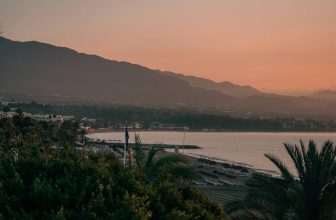
Marbella in October: Activities & Marbella’s Temperature

Madrid in November: Weather & Things to Do
Leave a reply cancel reply.
Save my name, email, and website in this browser for the next time I comment.
- 8 Luxury Hotels in Gran Canaria | Boutiques, 5-star, & Resorts
- Málaga To Ronda Day Trip | Is It Better By Train, Plane, or Car?
Traveling in Spain aims to help tourists and locals find the best adventures, and tours in Spain. We collect live prices from trusted tour and ticketing operators. We’ll sometimes link out to our affiliate partners, such as Amazon LLC, and make a small commission at no extra cost to you.
Privacy Overview

Shopping cart
Wanderlust Travel & Photos
Seeing the world one trip at a time.
- Work With Me
- Travel Journal
- Privacy Policy
- Browse by Continent
- Thailand Travel
- Australia Travel
- Peru Travel
- Browse by Region
- East North Central
- East South Central
- Mid-Atlantic
- New England
- South Atlantic
- West North Central
- West South Central
- Central America
- North America
- South America
- Travel Vlog
- Instagram Photos
The Ultimate Guide to a Perfect Two-Week Spain Travel Itinerary
This Spain travel itinerary guide post contains my Hotels.com, Expedia, Vrbo, and Viator affiliate links. I may receive a commission when you book a hotel or tour from this article, though at no additional cost to you. I hand-pick and recommend only the hotels and tours I have thoroughly researched and feel comfortable recommending.
With a wealth of incredible cultural sites, spectacular beaches, and some of Europe’s best food scenes, Spain has long been one of Europe’s top travel destinations. When planning a trip to Spain, the challenge isn’t finding things to see and do. Instead, it is deciding which amazing things to leave off your list. My hope is that this two-week Spain travel itinerary will take some of that stress off of you.
If you have 16 days to travel, this Spain travel itinerary will make sure you hit some of the country’s most can’t-miss spots. You will get to tour Antoni Gaudí’s masterpieces in Barcelona and enjoy authentic tapas and a Flamenco show in Seville. You will see the spectacular gardens in Ronda and be amazed by the beauty of the Alcázar de los Reyes Cristianos in Córdoba. And that is just the tip of the iceberg when it comes to the incredible sights you’ll see on this itinerary.

Plan a Trip of a Lifetime Without the Stress
Planning a trip this big can be stressful, but it doesn’t have to be. I have been planning travel for over a decade and I have personally visited all of the places on this itinerary. Not only will this guide help you plan a once-in-a-lifetime trip to Spain, but it will also make the planning process much easier for you.
I cover the critical entrance requirements for Spain, share my packing recommendations and checklists, and even link to a detailed visitor guide for each destination you visit on this itinerary. With this information in hand, you can be confident in your planning without having to go through all the stress.
Spain Travel Itinerary Overview

Please use the menus that I have provided to help navigate between the different sections of this Spain travel itinerary. I have provided sections on when to visit and where to start and end your trip to make your travel easier.
I also provide you with some packing advice, as well as some important information on making sure you meet Spain’s entrance requirements. Finally, I have provided you with a fun-packed 16-day itinerary that visits some of the most popular attractions in Spain.
Best Times to Visit Spain

Like most places in the world, there are more enjoyable times of year to visit Spain than others. For this reason, one of the most important decisions you will need to make is when to plan your trip. The time of year you choose, as well as the days of the week you are in each city, will impact what you can see and do.
To assist you in deciding when to plan your trip, I have included some valuable climate information for you to review below. This includes the average temperature and rainfall in this itinerary’s hub cities throughout the year. Using this information, you can plan your travel to Spain during the time of year that is most comfortable for you.
Average Temperature (°F)
While the temperature doesn’t get too cold throughout the year in much of Spain, there are areas where it can drop below freezing during winter. Even the weather in the southern part of the country can get chilly during the winter months. For this reason, I suggest avoiding December through February when planning your trip. Although, if you do decide to visit during this time, you will have very few crowds to contend with.
The summer months of June through August are quite the opposite. In many parts of Spain, the weather can be unbearably hot during the summer. On top of that, this is the peak of tourism season in Spain, so there are typically large crowds to contend with. While it isn’t the ideal time to visit Spain, the weather is typically nice if you can stand the heat.
Average Precipitation (Inches)
For travelers who want to maximize the amount of nice weather they see while visiting Spain, you will be interested in the average rainfall data that I have included below. As you can see in the chart, the summer months of June through August tend to be the driest months of the year in much of Spain.
Conversely, the months of April and October tend to be the rainiest months of the year in much of Spain. For those who are looking to enjoy a lot of outdoor time while visiting Spain, I suggest avoiding these months when you plan your trip.
Best Months to Visit
If you are looking for advice on which months of the year to visit Spain, you have come to the right place. I have included a chart that lays out which months of the year are best to visit in my Spain travel itinerary guide below.
In my opinion, the spring months of April and May, as well as the autumn month of September are the best months to visit Spain. During these months you will find mild temperatures and nice weather, and you will avoid the big crowds of the peak tourism season.

Where to Start and End Your Trip

While you can visit the destinations on this Spain travel itinerary in any order you want, I recommend visiting them in a specific order to maximize your time in the country. By either starting in Barcelona and ending in Madrid or vice versa if you prefer, you will avoid backtracking as you make your way through Spain. Which option you choose is entirely up to your personal preference.
The Four Hub Cities on this Itinerary
To minimize the amount of time you will spend checking in and out of hotels, this Spain travel itinerary is centered around four cities that you will use as hubs during your visit. Not only will you explore these cities themselves, but you can take day trips from these cities to see other destinations without having to lug your suitcases with you. I have included a map that lays out the four hub cities and the itinerary route options for you to review below.


Getting to Spain from Within Europe
Once you have decided where you will start and end your trip, the next step is figuring out how you will get to Spain. While flying is always an option, for those who are visiting Spain from elsewhere in Europe, you have the option of using the rail system as well.
If you are starting to plan your travel to Spain from elsewhere in Europe, I have included a chart with the travel times to the hub cities in Spain from other nearby European cities below.
Travel Time by Train to Spain Hub Cities from Destinations in Europe
Getting to spain from outside europe.
For those who will be visiting Spain from outside of Europe, flying into the country is likely to be your best option. While I recommend starting and ending your trip in the cities of Barcelona and Madrid, there are many international airports in Spain for you to choose from. For your reference, I have included links to the major airports in the four hub cities for this Spain travel itinerary below.
- Josep Tarradellas Barcelona-El Prat Airport (BCN)
- Adolfo Suárez Madrid–Barajas Airport (MAD)
- Valencia Manises Airport (VLC)
- Seville International Airport (SVQ)
Choosing Your Transportation
You will need to make many big decisions as you start to plan your trip to Spain. For instance, one such decision is how you will get around while in the country. Spain has an extensive and convenient rail system that I suggest looking into. No doubt, it can save you time and money in many situations. However, certain destinations are difficult to get to by rail. This makes a car rental an attractive option in some circumstances.
If you are using this Spain travel itinerary to plan your trip, I recommend using the rail system to travel between the hub cities. Trains run frequently between these cities, so you will have plenty of options. There are also high-speed rail routes between these destinations, so it can save you time as well. Not to mention, you won’t worry about having to find parking at your hotels.
I also outline the best way to get to the other outlined destinations in this Spain travel itinerary. For many of these destinations, using the rail system is an excellent option. However, some of the destinations are harder to get to by rail. In these cases, I outline other options that you will have available to you for transportation. This could be a car rental or guided tours that offer transportation.
Driving in Spain

If you are planning on renting a car to get around while you are visiting Spain, there are some things that you will need to know before you arrive. To help you prepare for your trip to Zaragoza, I have included some valuable driving tips for visitors in my Zaragoza, Spain travel guide below.
You must carry your valid primary driver’s license and an international driving permit (IDP) to drive in Spain. There are also several pieces of safety gear that you are required or recommended to have in the car at all times. For an overview of the required licenses and gear you will need, please see the list I have included below.
Required Equipment for Driving in Spain
- Driver’s license and IDP (required)
- Insurance documents (required)
- Car title or rental documents (required)
- Fluorescent jacket for all occupants (required)
- Two warning triangles (required)
- An extra pair of glasses, if you wear them (required)
- Fire extinguisher (recommended)
- First-aid kit (recommended)
In addition to the necessary permits and gear, there are also several driving regulations that you will need to be aware of while driving in Spain. These regulations include the following:
Passengers in the front and back seats are required to wear seat belts at all times.
Driving Age
In Spain, you must be 18 years old to drive a car and 21 years old to rent a car. Even if you have a valid driver’s license from the United States, you won’t be able to drive in Spain unless you are 18 years of age or older.
Alcohol Consumption
The legal limit for blood alcohol to drive in Spain is 0.05 percent or 0.25 milligrams per liter in exhaled air. You will want to pay extra care to obey this law as the penalties for drunk driving in Spain are very severe.
Cell Phone Usage
The use of cell phones while driving, unless you are using a hands-free system without headphones, is strictly prohibited. You are also not allowed to use screen-based navigation systems while driving in Spain.
In residential areas, avoid parking next to a yellow line or your vehicle will be towed.
In Spain, leaded gasoline is called Super or Super 68, unleaded gasoline is called “sin plomo 98” or “Eurosuper 95”, and diesel is called “gasoleo”.
Moving Violations and Tickets
Unless you have a residence in Spain, you will likely be asked to pay all fines and tickets immediately upon receipt while visiting Spain.
All children under 10 years of age or less than 4 feet, 5.5 inches (135 centimeters) must ride in a car seat.
Emergencies
Dial 112 from anywhere in Europe to be put in touch with Emergency services.
When driving in Spain, you will want to always be aware of the speed limit, even when you don’t see a posting. As a general rule of thumb, the speed limit for roads in Spain can be summarized as follows (unless marked otherwise):
Speed Limit Guidelines in Spain
- Expressways and major highways – 75 miles per hour (120 kilometers per hour)
- Other roads – 56 miles per hour (90 kilometers per hour)
- Urban areas – 31 miles per hour (50 kilometers per hour)
- Residential areas – 15 miles per hour (24 kilometers per hour)
Driving Time Between Destinations in Spain
If you plan to rent a car while visiting Spain, I have included a table listing the drive time between the destinations outlined in this Spain travel itinerary for you to review below.
Using the Train System in Spain

If you do not wish to rent a car while visiting Spain, the other popular mode of transportation with tourists is Spain’s incredible rail system. The rail network in Spain, and throughout Europe, is quite extensive, so you can get to most places by train if you want to. If you are considering using the rail system, I have included some tips for you to review in my Zaragoza, Spain travel guide below.
Tips for Using the Rail System in Spain
- If you plan on taking three or more long train rides while in Spain, a rail pass will likely save you money. Otherwise, you are probably better off just buying your train tickets without a rail pass.
- The two rail pass options you can purchase are the Spain Eurail Pass (good for use just in Spain) and the Eurail Global Pass (good for use in 33 countries).
- Rail passes for Spain cover all travel on trains run by Renfe , Spain’s national railway.
- Many train routes require a paid reservation, which must be paid even if you have a rail pass. This is why it may not make sense to purchase a rail pass if you aren’t planning on taking many longer, expensive rides.
- Rick Steves has a great article on whether it makes sense for you to get a rail pass for your trip to Spain that I would recommend reviewing.
- When purchasing rail tickets, purchasing a round-trip ticket instead of two one-way fares can save you up to 20% of the cost.
- Advanced purchase discounts for AVE trains are available about 60 days ahead of departure, so purchasing your tickets well in advance can save you money as well.
Train Travel Time Between Destinations in Spain
Suppose you plan to utilize the rail system while visiting Spain. In that case, I have included a table listing the travel time by train between the destinations outlined in this Spain travel itinerary for you to review below.
* All routes to Gibraltar include bus rides
What to Pack for Spain

One thing that often causes travelers stress as they prepare for a trip is deciding what to pack. Like most destinations, packing for a trip to Spain requires some forethought. This is especially true if you are going to be traveling for a few weeks. If you aren’t prepared, it can ruin your trip really fast.
To make sure you have everything you need for your trip, I have included some of my popular packing reference guides for you to review below. In addition to packing advice, they include handy checklists that you can use to ensure you have what you need in your checked and carry-on luggage.
Spain Entrance Requirements

While all of the pre-trip planning advice that I outline in this Spain travel itinerary is important, nothing is more important than making sure you meet the entrance requirements. If fail to meet an entrance requirement, it can delay or even force you to cancel your trip.
To make sure this doesn’t happen to you, I have linked to my guide on meeting the Spain entrance requirements below. I strongly suggest that you review this guide carefully. I even included a handy checklist in the guide to help you with your planning.
Spain Travel Itinerary Outline

Spain is one of the top travel destinations in the world year after year for a reason. With a wealth of incredible cultural sights, spectacular food, and some of the nicest beaches in Europe, it has it all.
In fact, there is so much to see and do in Spain that it can be a little overwhelming planning a visit. That is why I put together this perfect 16-day Spain travel itinerary. Below, you will find a map overview of the itinerary, followed by detailed sections for each day of the trip.

View Larger Map
Day 1: Fly to Barcelona

On your first day in Spain, you will be arriving in Barcelona. If you plan on doing this itinerary in reverse, then you will want to arrange travel to Madrid. You will likely be a bit jet-lagged on your first day, so I don’t have much planned on the first day of this Spain travel itinerary other than to get checked into your accommodations and get settled.
Where to Stay in Barcelona
To assist you in finding the right place to stay while in Barcelona, I have included a list of recommended hotels, hostels, and VRBO properties at different price points for you to review below.

Day 2: Explore Gaudí’s Barcelona

The second day of your trip, or the first full day, is when all of the fun begins. Today, you will be exploring the incredible works of Antoni Gaudí in Barcelona. Through his architecture, Gaudí did more to shape the city of Barcelona than perhaps any other person in history.
Incredible buildings like the La Pedrera-Casa Milà, Casa Batlló, and the spectacular La Sagrada Familia are legendary. Make sure you don’t miss the amazing Park Güell, which I think is one of his best designs. For more information on Antoni Gaudí’s works, check out my Barcelona travel guide linked below.
Day 3: Explore the Rest of Barcelona

After spending a fun day exploring the works of Gaudí, on your second day in Barcelona, you will get to explore the city’s other treasures. Between shopping on the amazing La Rambla street, strolling through Ciutadella Park, and grabbing a bite to eat at the Mercado de La Boqueria, there is a lot to see and do. If you have the time, you can even take a short day trip to see the incredible Montserrat monastery nearby.
Day 4: Travel to Valencia

On the fourth day of this Spain travel itinerary, you will be packing your bags and leaving beautiful Barcelona. The next stop on your incredible Spain adventure is the amazing city of Valencia. Located on the coast, Valencia is a popular European beach destination. It also has several incredible cultural treasures for visitors to enjoy. Once you arrive, check into your hotel and start to explore this amazing city.
Travel Time to Valencia
I would suggest using the rail system for your transportation between Barcelona and Valencia. The drive between the two cities will take you roughly 3 hours and 40 minutes, while the train ride is nearly an hour quicker. There are also plenty of scheduled trains each day, which makes the train a convenient option as well.
Where to Stay in Valencia
To assist you in finding the right place to stay while in Valencia, I have included a list of recommended hotels, hostels, and VRBO properties at different price points for you to review below.

Day 5: Explore Valencia

On your first full day in Valencia, you will get to really see what makes this city so special. With some of Europe’s most beautiful beaches, the city is a beach lover’s dream. If you are interested in just spending your day at the beach, there are a number of great ones to choose from.
For those who want to explore, the city is a treasure trove for tourists. The beautiful Plaza de la Reina is a central spot that is near many of the city’s iconic attractions. This includes the Valencia Cathedral, which is one of the alleged resting spots of the Holy Grail. For history lovers, you will also enjoy stopping at the infamous silk exchange, which played a central role in the silk trade during the days when the Silk Road from China was active.
However, my favorite spot in Valencia is undoubtedly the L’Oceanogràfic. Not only is it the largest aquarium in Europe, but it is one of the most unique and beautiful buildings that I have ever seen. No visit to Valencia is complete without touring this incredible place. For more ideas on things to do while you are in Valencia, make sure you check out my Valencia travel guide linked below.
Day 6: Travel to Seville

After spending several incredible days in Valencia, this Spain travel itinerary will take you into the beautiful region of Andalusia on your sixth day. Your destination is the amazing city of Seville. As the birthplace of tapas and Flamenco dancing, Seville is widely considered to be one of the cultural capitals of Spain.
You certainly won’t have to venture far to find the wealth of cultural attractions that Seville has to offer. After checking into your hotel and getting settled, you can start to explore this amazing city.
Travel Time to Seville
Travel between Valencia and Seville is even quicker and more convenient by train than travel to Valencia from Barcelona. Driving to Seville from Valencia will take you nearly 6 hours and 30 minutes, while the train will get you there over two hours faster.
The high-speed routes from Valencia to Seville take roughly 4 hours and 23 minutes. Not only that but there are enough daily trains from Valencia to Seville to make train travel the convenient option as well.
Where to Stay in Seville
To assist you in finding the right place to stay while in Seville, I have included a list of recommended hotels, hostels, and VRBO properties at different price points for you to review below.
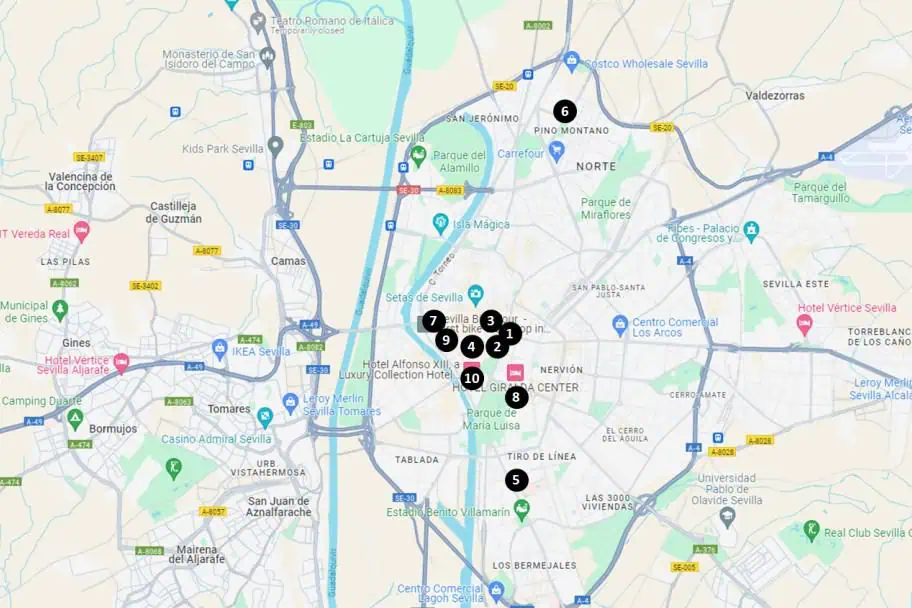
Day 7: Explore Beautiful Seville

Today is all about exploring the treasures that Seville has to offer. And believe me, there is no shortage of amazing things to see in the city. Between the incredible Royal Alcázar, the historic Torre del Oro tower, the breathtaking Plaza de España, and the historic bull ring, you will have an action-packed day of sightseeing.
When you have finished your sightseeing for the day, I recommend grabbing a bite to eat at one of the city’s many amazing restaurants. Then, after you have had a nice meal, you might want to purchase tickets to see an authentic Flamenco dance show. Seville has many incredible venues in which to enjoy these beautiful shows, but the Tablao Flamenco El Arenal is my favorite.
Day 8: Take a Day Trip to Córdoba

Now that you have spent some time exploring the beautiful city of Seville, the next three days will be spent exploring some of the surrounding cities. First up on that list is the amazing city of Córdoba. Once referred to as the “Pearl of Moorish Spain”, the city of Córdoba is chock full of spectacular cultural sights that you will want to explore.
One of the most popular attractions in the city is the Mosque-Cathedral of Córdoba. This cathedral, turned mosque, turned back into a cathedral is one of the most spectacularly beautiful holy sites you will find in all of Spain. It alone is worth a visit to Córdoba. However, it isn’t the only incredible attraction to see in the city.
Another of my favorite places in the city is the stunning Alcázar de los Reyes Cristianos. With some of the most beautiful gardens I have ever seen, the Alcázar is certain to amaze you. But these two sites are just the tip of the iceberg. I also outline several other amazing things to see and do in my Córdoba travel guide linked below.
Best Way to Get There
Most of the train routes from Seville to Córdoba will get you there in roughly 45 minutes, which makes Córdoba an easy day trip from Seville. Unless you have a car rented for other reasons, I would suggest taking the train.
There are enough options daily for you to pick and choose when you want to plan your trip. There are also some good day trip tours to Córdoba from Seville, with transportation included. I have linked to some recommendations for you to review below if interested.
Day 9: Take a Day Trip to Ronda

Out of all the destinations on this Spain travel itinerary, the city of Ronda is my absolute favorite. Not only is it one of the prettiest cities in Europe, if not the world, but it is absolutely steeped in history and tradition. The entire city is built on bluffs overlooking a river gorge, which creates the most stunning landscape you will see on this trip.
Beyond its beauty, the city is also home to one of the oldest bull rings in all of Spain. The bullfighters who have come out of Ronda are legendary, as are some of the patrons who have taken in bullfights here.
The likes of Ernest Hemmingway, Orson Welles, and James Joyce have all spent a considerable amount of time in Ronda. For more information on this incredible city and what to see and do there, make sure you check out my Ronda travel guide, linked below.
Ronda is a little bit more difficult to visit on a day trip by train than some of the other destinations on this itinerary. Some trains run from Seville to Ronda, but they aren’t direct. Instead, you will need to make a connection, which means it will take longer to get there. Not only that but there aren’t as many options to choose from each day.
For that reason, I recommend renting a car to visit Ronda or booking a tour that includes transportation. If you do rent a car, you will be able to use it to visit Gibraltar as well, which I cover next on this itinerary. It is even more difficult to get to by train than Ronda. If booking a tour to visit Ronda sounds appealing to you, I have included some recommended options for you to review below.
Day 10: Take a Day Trip to Gibraltar
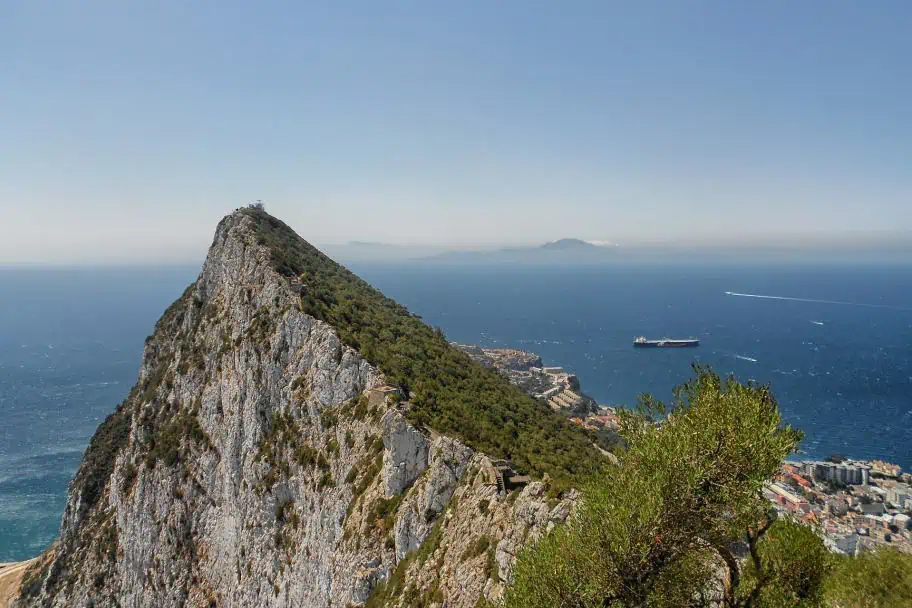
Today you will take your final day trip from Seville, and today’s trip will be one of the more unique and interesting days of your trip. Today will be the only day on this Spain travel itinerary when you leave the country of Spain. That’s because you will be visiting Gibraltar, which is an overseas territory of the United Kingdom. That’s right, instead of tapas and Flamenco, you will have a day of fish and chips and red phone booths.
During your tour, you will learn about the history of Gibraltar and its strategic importance to the British. You will also have a chance to peer across the Strait of Gibraltar to see the continent of Africa. In fact, if you have the time, you can even take a ferry across the strait and visit Morrocco. For more information on the adventures that await you when you visit this iconic destination, make sure you check out my Gibraltar travel guide linked below.
If you decide to rent a car to visit Ronda, that rental will come in handy when you visit Gibraltar. Of all the destinations on this Spain travel itinerary, Gibraltar is the most difficult to get to. There isn’t a train station in Gibraltar, so you need to take a train to the towns of Algeciras or San Roque-La Linea. From there, you can take a bus to Gibraltar. So, if you rent a car, it is definitely easier to drive to Gibraltar than take the train.
Another popular option is to book a guided tour of Gibraltar to Seville that includes transportation. This will allow you to visit Gibraltar for the day without having to rely on public transportation or rent a car. If this sounds like an attractive option for you, I have linked to some recommended tour options for you to review below.
Day 11: Travel to Madrid

While I am sure you wish you had an endless amount of time to explore the Andalusia Region, today is the day you move on. However, don’t fret because you will be visiting another iconic region of Spain.
You will be heading to Central Spain, where you will spend the remainder of this Spain travel itinerary exploring Madrid and the country’s iconic castle region. After arriving in Madrid, get settled into your final hotel of the trip and start exploring this incredible city!
Travel Time to Madrid
After spending several incredible days in Andalusia exploring Seville and the surrounding cities, you will make your way back North to spend some time in Madrid. Once again, it is much quicker and more convenient to use the rail system to travel than it is by car. Driving, it would take you roughly 5 hours and 15 minutes to travel from Seville to Madrid. Using the high-speed rail, you can make that trip in approximately 2 hours and 42 minutes.
Where to Stay in Madrid
To assist you in finding the right place to stay while in Madrid, I have included a list of recommended hotels, hostels, and VRBO properties at different price points for you to review below.

Day 12: Explore the Highlights of Madrid

On your first full day in Central Spain, you will be exploring the incredible city of Madrid itself. Even though the city is thousands of years old, you may be surprised to know that it has only been Spain’s capital since the 16th Century. Now, it is one of Europe’s largest cities and one of the continent’s cultural capitals.
If you are looking for things to fill out your itinerary for Madrid, I have linked to my Madrid travel guide for you to review above. It includes all of the top things to see and do in Madrid, as well as where to eat and what tours you might want to consider. Tapas tours are trendy in Madrid, and they are a great way to hop around and see the city. If you have the time, I highly recommend booking one!
Day 13: Take a Day Trip to Zaragoza

You are in for a real treat on this day of my Spain travel itinerary. Today, you visit one of the lesser-known gems of Spain. While Zaragoza doesn’t get the attention that some of the country’s top tourist destinations get, it is one of the most beautiful and historically significant cities in all of Spain. Not only is it one of Spain’s oldest cities, but it is also home to one of the world’s most beautiful cathedrals.
With attractions like the breathtaking Basílica del Pilar, ruins of the oldest Roman forum in Spain, and a museum with the masterpieces of famed artist Francisco Goya, there is no shortage of incredible things to see in Zaragoza. For more information on what to see, where to eat, and what tours are popular in the city, please see my Zaragoza travel guide linked below.
After spending your first day in Madrid exploring the city, on your second full day, you will take your first-day trip. Getting to Zaragoza from Madrid is fairly quick and convenient by train, so I would strongly recommend using the rail system.
It will only take you 1 hour and 15 minutes to travel each way, which isn’t too bad. You can spend a full day in Zaragoza and then head back to your hotel in Madrid at the end of a fun day of exploration.
NOTE: The city of Zaragoza is equally close to Barcelona and Madrid by train. So, if you would prefer to visit Zaragoza on a day trip from Barcelona instead of a day trip from Spain, you can easily do that.
Day 14: Take a Day Trip to Toledo

After spending a splendid day touring the beautiful city of Zaragoza, today you will take a short trip to visit the stunning city of Toledo. Not only is the city of Toledo beautiful, but it is also one of the oldest and most unique cities that you will find on this Spain travel itinerary. In fact, it was the capital of Spain before Madrid and is still widely considered to be the country’s cultural capital to this day.
With a gorgeous old town that will rival any you will find elsewhere in Spain, the city of Toledo absolutely brims with historical landmarks. Not only that, but it is renowned for its wonderful festivals that date back centuries. For more information on this amazing city, please check out my Toledo travel guide linked below. You will find suggestions on what to see, where to eat, and some fun activities you can do while you are there.
The next day trip you will take from Madrid as part of this Spain travel itinerary is a fun visit to the city of Toledo. Like with Zaragoza, the train ride to Toledo is very quick and painless. It will only take you an hour to travel each way by rail, so it is definitely the most convenient way to get there.
However, if you would like to explore a guided tour with transportation, there are plenty of great options. If you are interested, I have included some highly rated guided day trips to Toledo from Madrid for you to review below.
Day 15: Take a Day Trip to Segovia
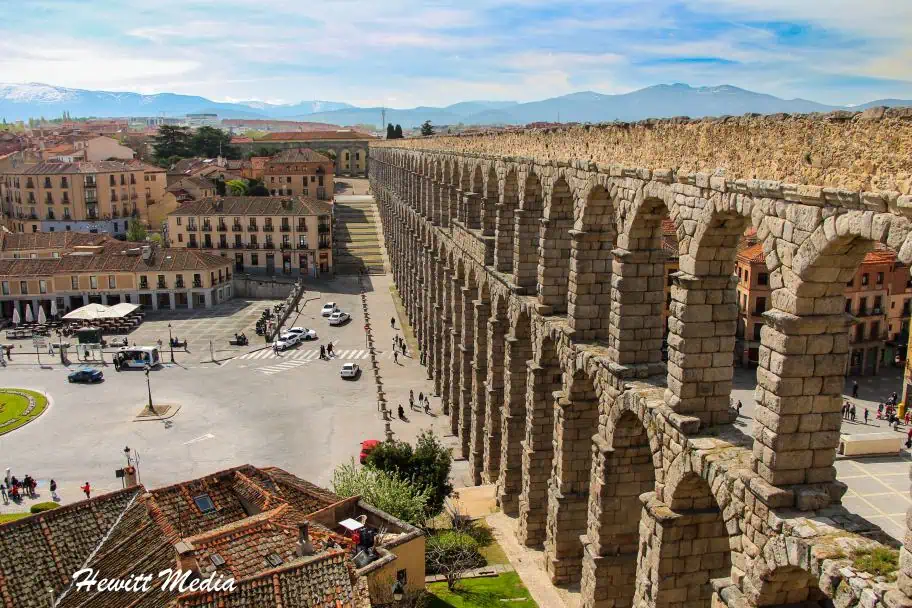
I have left what might be the best stop of your trip for the last day of this Spain travel itinerary. Today, you get to visit the incredible city of Segovia in Spain’s Castile and León region. Renowned for its rich architectural legacy and wealth of historical structures, it is one of the most interesting cities in Spain to tour.
The city is home to the incredible Alcázar of Segovia, which was one of the primary inspirations for the Walt Disney Castle. Not only that, but you will also find the spectacular Roman Aqueduct of Segovia when you visit. Spanning over 800 meters, it is one of the largest and best-preserved Roman aqueducts in the world.
However, these amazing things are just the tip of the iceberg. For more information on what to see, where to eat, and what to do when you visit Segovia, please check out my Segovia travel guide linked below. Soak up every minute of your adventure in the city because your trip is winding down.
Once again, the rail system in Spain really shines. It is incredibly easy to visit Segovia from Madrid on a day trip using the rail system. With just an hour ride each way, and plenty of trains running each day, it is a quick and convenient train ride.
However, like with Toledo, there are also a lot of organized tours from Madrid to Segovia as well. If you are interested in one of these, I have included links to some highly rated ones for you to review below.
Day 16: Fly Home

Unfortunately, all good things must come to an end. After fifteen spectacular days, this is where this Spain travel itinerary comes to a close. On day sixteen, you will head to the airport to make your way back home.
If you begin your trip in Barcelona, you will fly home from Madrid. For those who followed this itinerary in reverse order, you will be flying home from Barcelona. Either way, I sincerely hope you found this itinerary useful and were able to plan a trip of a lifetime to Spain!
Don’t Forget to Subscribe to My Adventures!
Type your email…

Let Me Help You Save On Your Next Adventure!
‘start exploring today’ merchandise available now.
Published by Josh Hewitt
Avid traveler and photographer who loves to see new places, meet new people, and experience new things. There is so much this world can teach us, we just need to explore! View all posts by Josh Hewitt
Related Articles

Planning an Epic Eastern National Parks Road Trip

Argentina Entrance Requirements: A Guide for Travelers

How to Anticipate the Perfect Moment in Wildlife Photography
Leave a reply cancel reply.
Wonderful & very informative article. I think these tips and advice are much helpful. Great Sharing, Thank you for such…
[…] during off-peak seasons when hotels offer incentives like free breakfast or spa credits 39. Choosing locations slightly removed from major…
Exploring the beautiful Phuket, Thailand area offers an array of stunning beaches, cultural landmarks, and exciting activities. Wander On can…
Visiting Shimla and Manali in November offers stunning autumn views, pleasant weather, and fewer crowds, making it perfect for a…
Discover more from Wanderlust Travel & Photos
Subscribe now to keep reading and get access to the full archive.
Continue reading

Subscribe To My Adventures!
Let's be friends! Sign up receive our monthly newsletter with updates and new in-depth guides.

2 Weeks in Spain: How to Plan an Amazing Spain Itinerary
Wondering how to spend two weeks in Spain? Or maybe your time is shorter or longer than two weeks and you’re trying to figure out how to make the most of your trip to Spain. You’re in luck! We recently spent more than a month in Spain – mostly southern Spain – and wrote this detailed guide to help you plan an amazing Spain itinerary for anywhere from 7 days to 2 weeks or more.
We loved Spain, and can’t wait for a return trip to explore some of the parts of northern Spain that we missed.
Because this guide is based on our experience, it is essentially a southern Spain itinerary. You’ll visit Spain’s major cities – Madrid and Barcelona – along with some of the highlights in Andalucía, which is our favorite part of Spain.
It needs to be said at the beginning of this guide – Spain is a huge, diverse country with a bunch of fascinating regions with their own distinct identities. You’re not going to be able to see even close to everything in two weeks.
Even with over a month in Spain we still had to put some places on the list for our next trip.
This guide to planning your Spain itinerary is meant to help you narrow down where to visit, and help you figure out how to organize your visit to Spain based on our personal experience and what we enjoyed.
Don’t worry if you have less than two weeks – below the main itinerary, we have ideas on how to condense the itinerary into shorter time frames. We DON’T think you should try to visit the same number of places in a shorter time, and instead would recommend choosing less places and spending the same amount of time exploring each.

Disclaimer: Some of the links in this post, like hotel links, are affiliate links, meaning at no additional cost to you, we make a little bit of money if you click through and book. That being said, we would never recommend something to you that we don’t stand behind 100%.
How Much Time Do You Need in Spain?
Well, the answer to this question is essentially, as many as you can spare!
If you have 14 days in Spain, you’ll have enough time to see both the highlights and some of the destinations that most tourists never make it to. However, two weeks still isn’t really that much time, so there are going to be times you’re going to say “I guess we’ll have to do that next time.” We certainly did, and we had over a month!
With that in mind, we strongly recommend that you focus on picking four to five cities or regions in Spain rather than spending a night in each place and trying to fit it all in. That trip will be exhausting, and you’ll be missing so much richness and history by shortchanging each individual place.
Our recommendation for you is to focus your time on: Barcelona (and Catalonia), Madrid (and the surrounding area), Granada , and Seville .
That means your itinerary is going to be heavily focused on southern Spain, which we think is the best introduction to Spain, and you’ll have to come back to explore northern Spain like Basque country and Asturias another time.
If you’re visiting Spain with less time, we’d cut down on the number of places you’re visiting rather than spending a day or two in each place and still trying to fit them all in. I know, it feels weird to go all that way and only see a couple of cities and their surrounding areas.
But we’d strongly recommend opting for fewer places and more time in each place, which will give you a deeper understanding of the city, the culture, and the people and allow you to get a level deeper than just seeing the main sights.
If you have 7 or 10 days in Spain, we have suggestions on how to spend that time below the main itinerary.
Where to Start and End Your Trip to Spain
We’ve organized this trip going east to west from Barcelona to Seville, but you could easily do it the opposite direction.
If you follow it as written, you’ll want to fly in and out of different airports on what’s called an “open jaw” flight. This will save you a 5 to 6 hour train ride to return to Barcelona or Seville at the end of your trip, though the flight might cost a little bit extra (not always, though).
If you do this as a one-way journey working from east to west, that means you’ll want to fly into Barcelona and out of Seville .
Barcelona has a very nice international airport with plenty of domestic and international flights available, and Seville’s, though smaller, will still give you plenty of options (though you’ll need to connect if you’re flying back to the US or Canada – not a whole lot of direct flights go from Seville to North America).
If you find a cheap flight deal (we use Scott’s Cheap Flights , which sends you flight deals from your home airport to your inbox, and love it!), you can absolutely fly in and out of the same city.
But you’ll have to organize your time in a way where you make your way back to the airport you’re flying out of, which is going to mean extra train time and cost over the course of your trip.
The price might work out though, depending on how cheap the flight is!
Getting Around Spain
Once you’re in Spain, you should plan on using the efficient and affordable rail network to get between places.
Occasionally, like from Madrid to Segovia, the bus is actually more efficient, but we took trains between cities and on day trips and always had a great experience. The train is a fantastic way to travel, and we wish we had a better high-speed rail network back home in the US.
You shouldn’t fly domestically between Spanish cities. It’ll be more expensive and once you’ve gotten to the airport a couple of hours in advance, it’ll likely take longer than the train, where you can show up 20 minutes ahead of time and still have time to grab coffee before boarding (in most cases).
Plus, it’s generally more expensive and time consuming to get from the airport to the city center (or vice versa).
Our point is that trains are easier in almost every way.
We often ran into issues with the website of Spain’s rail network, Renfe, where it wouldn’t take our credit cards no matter how many times we tried.
After being frustrated several times, we turned to Omio , a private company that presents all the bus and train options in a significantly more user-friendly package (an app with tickets available offline, no glitches with payments, and it’s all in English). You’ll pay a small service fee, but we think it’s worth it for the significantly better experience.
Should You Rent a Car in Spain?
For context, we did not rent a car, used exclusively trains, and had a lovely time exploring the country.
However, there is one place where it might be nice to rent a car and have a little more flexibility to explore at your own pace, and that place is Andalusia. If that sounds like something you’re interested in, our advice is to pick up the car as you’re leaving Madrid, and drop it in Seville the day you arrive .
You won’t need a car in Barcelona or Madrid, and the day trips to Toledo and Girona are very easily accessible using the train.
Check prices and book on AutoEurope , which is our go-to rental car company in Europe. We used them twice on our three month European adventure – including in Sicily – and it was perfect both times.
The Route for a 2 Week Spain Itinerary
If you have two weeks, we’d recommend starting in Barcelona, making your way to Madrid, heading down to Granada, and ending in Seville.
Here’s what that looks like in map form .
You’ll notice that this itinerary is missing HUGE swaths of the country, but two weeks really isn’t enough time to see everything. Instead, we’d recommend taking the time in the places you do visit to really get a feel for each place and go deeper on the unique histories and cultural quirks, which is what makes each place special.
Here’s a day-by-day breakdown of what that trip looks like.
- Day 1 : Arrive in Barcelona (and sleep)
- Day 2 : Barcelona
- Day 3 : Girona Day Trip
- Day 4 : Barcelona
- Day 5 : Barcelona & Late Train to Madrid
- Day 6 : Madrid
- Day 7 : Madrid
- Day 8: Toledo Day Trip
- Day 9 : Granada
- Day 10 : Granada
- Day 11 : Seville
- Day 12 : Seville
- Day 13 : Córdoba Day Trip
- Day 14 : Seville & Fly home
Obviously, you have a little bit of flexibility in terms of which days you choose to do a day trip, how many days to spend in each place, and more. But this is how we’d do it if it was our first time in Spain.
Two Weeks in Spain: A Complete Guide to Planning a 14 Day Spain Itinerary
Alright, now that we’ve covered logistics and given you an overview of what the itinerary below looks like, time to get into the details.
Days 1-5: Barcelona

Barcelona is one of the most famous cities in Europe, and it’s not really that hard to understand why when you’re immersed in its charm. It has a great food and drink scene, plenty of fun neighborhoods to explore, and is a hub for some great day trips.
And, of course, there’s the fingerprints of Antoni Gaudí, the Modernist architect who has had such an impact on the look and feel of various parts of the city, from Modernist buildings along Passeig de Gràcia, to the Sagrada Familia, one of the most impressive religious sites we’ve seen.
You really can’t visit Spain without including Barcelona. We think Barcelona is worth a full three days, and we think a day trip to Girona to get deeper into Catalonia and see one of our favorite cities in Spain also deserves a place on your visit to Spain. So that’s four full days in and around Barcelona.
Please note that we’re assuming you arrive on the first day of this itinerary, probably sometime in the afternoon depending on where you’re coming from.
If you’re coming from outside of the EU, that means you’re going to have some jetlag to deal with, which means that the first day is largely lost. If you’re not dealing with jetlag, lucky you! You can probably spend one less day in Barcelona, and take that day and use it somewhere else later in the itinerary.
What to Do in Barcelona
Here are some of the things to do in Barcelona that we think should be staples on your trip. Obviously, there are a ton of other things to do, see, eat, and drink, but these were the highlights for us.
For more detail, head over to our guide to planning a Barcelona itinerary .
One important note : Tickets for the Sagrada Familia and Parc Guell – especially in high season – sell out. Sometimes months in advance. After you book your place to stay in Barcelona, those should be the next things you book if you want to see them.
The Sagrada Familia
Of all the churches we saw on our three month European adventure that took us to Italy (including Sicily), Spain, and Portugal, this was our favorite of them all.
The reason? The amount of thought and care that has gone into every single element – the two facades, the interior, everything – is staggering.
It’s a masterpiece, and it’s well worth having the audio guide or a guided tour to enrich your experience and learn more about Gaudí’s masterpiece, which is still in-progress (though is due to be completed in 2026, 100 years after his death). Y
ou can get tickets on the official site .
If they’re sold out for your dates, look at Get Your Guide for skip-the-line tickets , or join a guided tour (we’d recommend this one with Take Walks, our favorite tour company in Europe).

Another Gaudí masterpiece, this is a park up on the hill behind the Gràcia neighborhood with great views back towards the city and water.
It’s going to be crowded at any hour, but it’s worth braving the crowds for the Modernist architecture.
Tickets here .
Explore Barcelona’s Markets
There are three markets in Barcelona that we liked (though we went to a couple of the more local markets that are found in each neighborhood and enjoyed those too).
First, and most famous, is La Boqueria , which is right on Las Ramblas. It’s the biggest, and because of its location, it’s always crowded with tourists. Go early in the morning for the best experience, and get some fresh fruit or fruit juice for breakfast (Satan’s Coffee Corner a few blocks away is where you should go to get coffee).
The other two – Santa Caterina and Barceloneta – are within fifteen minutes on foot, and are smaller. But both are more enjoyable and are more evenly split between tourists and locals going about their shopping.
Learn About Catalonian History
We really enjoyed the Museu d’Historia Catalunya , a relatively small multi-floor museum in Barceloneta by the beach.
It’s a dive into the history of both Spain and specifically Catalonia, which is something we had never really learned about in school.
You’ll come away with a deeper understanding of the region and its complex history and origins of its unique culture.
Discover the Secret to Perfect Paella
We love to cook (and eat, of course), and when we sat down to talk about the best things we did in Spain, our cooking class with Clara where we learned the secrets to a good paella was at the top of the list for both of us.
You’ll meet Clara at her family’s house up in Gràcia and learn how to make two different kinds of paella in a beautiful outdoor garden.
Plus, Spanish wine and a variety of tapas to enjoy while it cooks, and the opportunity to connect with Clara and fellow like-minded travelers.
Click here to check prices, reviews, and availability .
A Day Trip to Girona
We loved Girona, which is 100km northeast of Barcelona and is a deeper dive into Catalonia and its unique culture. Plus, it’s a gorgeous small town set on a river (multiple rivers, actually) and Game of Thrones filmed a bunch of major scenes from Season 6 in Girona.
We have an entire guide dedicated to planning a day trip to Girona from Barcelona , which you should read for more details. Otherwise, here are the highlights.
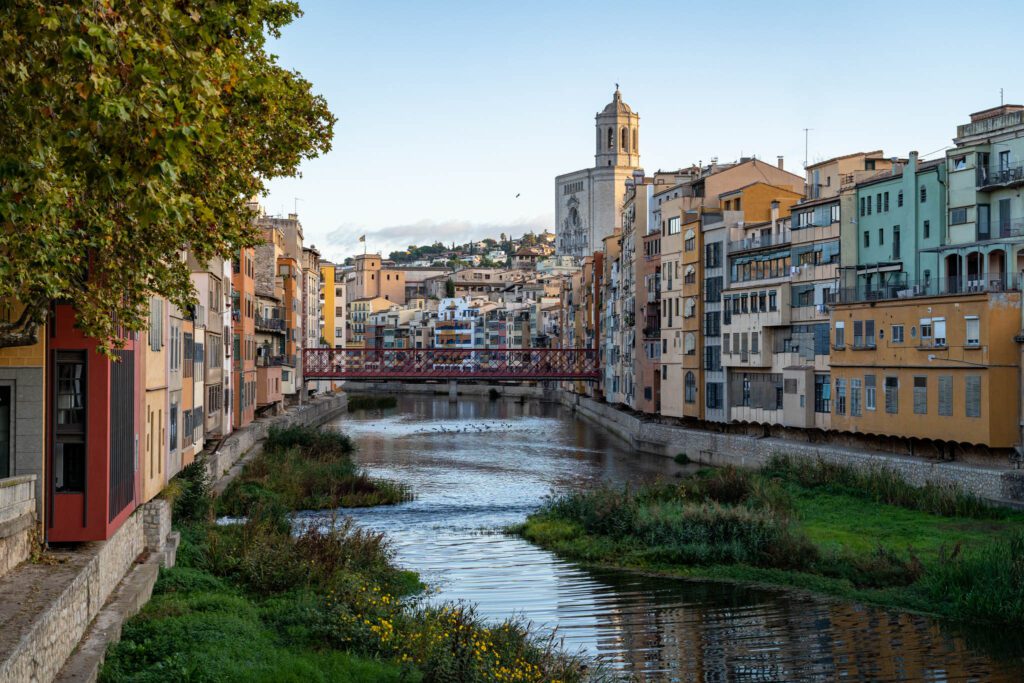
Take the high-speed AVE train from Barcelona-Sants to Girona , which takes just 40 minutes each way. Book tickets either directly through Renfe , or through Omio for a much more user-friendly experience (that comes with a small service fee).
- Arrive early and walk the city walls before it gets packed. You can get up onto the walls from the Jardins de la Francesa behind the massive cathedral ( here on Google Maps), and they continue alllll the way around back to right around Plaça de Catalunya (though you can get off the walls at several points between those two spots). Don’t miss climbing up into at least one of the towers along the way for great views of the city and cathedral!
- Head down to Espresso Mafia for the best coffee in Girona and a pastry or two, or over to their sister cafe La Fabrica if you’re in the mood for a more hearty brunch.
- Join our favorite walking tour in Spain at 10:30 am. And the best part is, you have two options! We loved the history-focused walking tour we did with Raquel, whose knowledge about Girona and Catalonia as a whole was impressive, and it’s the one we’d recommend for most people. However, they also do a Game of Thrones Tour , which fans of the TV show (minus the last season of course, which was hot garbage) will appreciate because it takes you to places in the city where they filmed pieces of Season 6.
- After the tour, grab lunch somewhere in the old town (ask your guide for a recommendation!).
- During the siesta, where the entire city basically shuts down for a few hours in the afternoon, hit the informative Jewish History Museum , which covers the history of the Jewish population in Girona, which shaped the city prior to being expelled in 1492, and then the Girona Cathedral , which is home to an impressive cloister, a huge nave (with no arches in the middle, which is unique) and the Tapestry of Creation from the 11th (ish) Century.
- Afterwards, spend the rest of your time wandering the old town and stopping into any place that catches your eye before catching your train home!
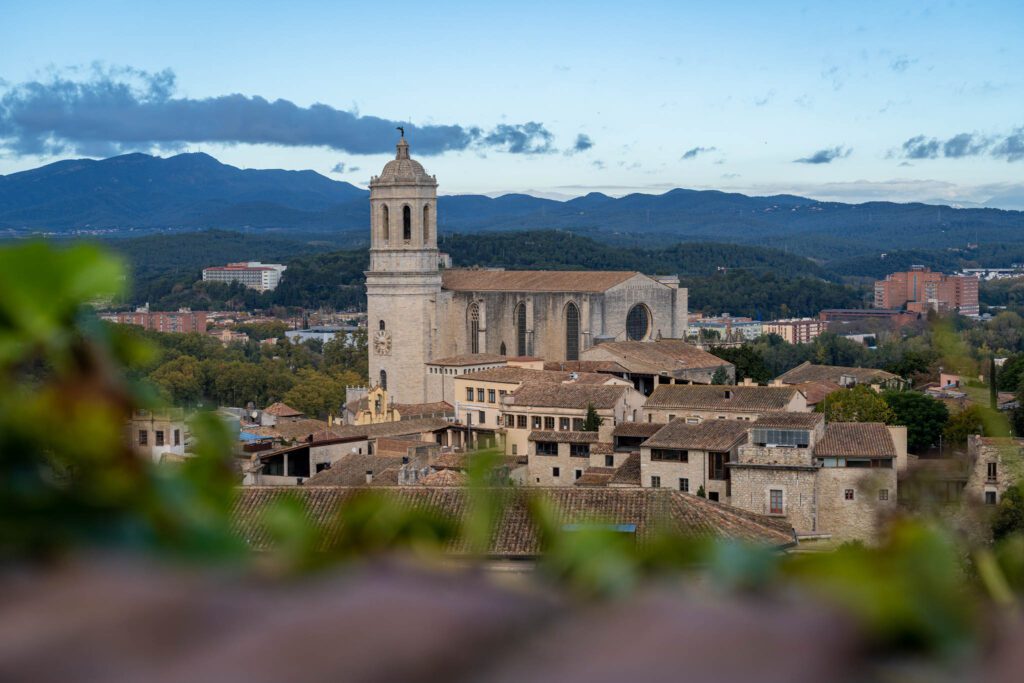
Where to Stay in Barcelona
There are, essentially, two main options in our minds here.
We have a guide to choosing where to stay in Barcelona that goes through five neighborhoods, in detail, with pros and cons for each to help you find the right place to stay for your group, style, and budget. If you want more detail, make sure to read that.
Now, back to those two areas. They are Gràcia , a more residential and low-key area north of the city center (our personal favorite), and l’Eixample .
Staying in Gràcia: Endlessly Charming with Great Food and Drinks
Like we mentioned above, Gràcia is our personal favorite neighborhood in Barcelona. It’s a little further out, sure, but we stayed there for the majority of our time on our latest trip, and found that the metro made it easy to get everywhere we needed to go, and fast.
You’re going to want to invest in the fabulous Hola Card if you stay here, which gives you access to unlimited transportation from between 24 hours and a week (in 24 hour increments).
Once you get off of the bustling wide boulevard of Passeig de Gràcia and into the narrower streets in the core of the neighborhood, you’ll start to see why we like it so much. It used to be a separate town from the city of Barcelona, and has very much retained its own unique character despite being swallowed up by the Catalonian capital.
It’s charming, full of locals with their kids and dogs (or both), and has a great selection of bars, restaurants, and coffee shops and cafes. In other words, all of our favorite things.
- If you want a mid-range hotel : Stay at Casa del Sol
- If you want a boutique hotel : Look at Hotel Barcelona 1882
- If you want an apartment : Check out Be Mate Paseo de Gràcia
- If you want a hostel: Casa Gràcia and Generator Hostel are basically tied in our books.
Staying in l’Eixample: Central, Walkable, and Well Connected
L’Eixample is the area between the Ciutat Vella (old town), the site of the original Roman city dating back two thousand years, and the outlying neighborhoods like Gràcia that used to be separate towns. It was created to connect the two and modernize Barcelona, which is why it has wide boulevards with multiple lanes of traffic, and a grid layout (versus narrow, winding alleys).
It’s a great compromise between location (and therefore, convenience) and calmness. It’s still very busy, don’t get me wrong, but not nearly as chaotic as staying in a place like the Gothic Quarter, which is swarming with tourists at all hours of the day.
We really like the range of places to stay in l’Eixample too. There are great options from affordable hostels all the way to luxury hotels, and just about everything in between.
- If you want a hostel : Yeah Hostel Barcelona (they have private rooms and dorms)
- If you want a fun, mid-range hotel : Look at the Praktik Hotels ( Garden , Vinoteca , and Bakery in particular), which are designed with the modern traveler in mind and give you everything you need at a relatively affordable price tag. Each property is centered and designed around a theme (like wine or gardens), which we’re into!
- If you want a boutique hotel : Stay at Casa Bonay . Period. The end.
Days 6 & 7: Madrid
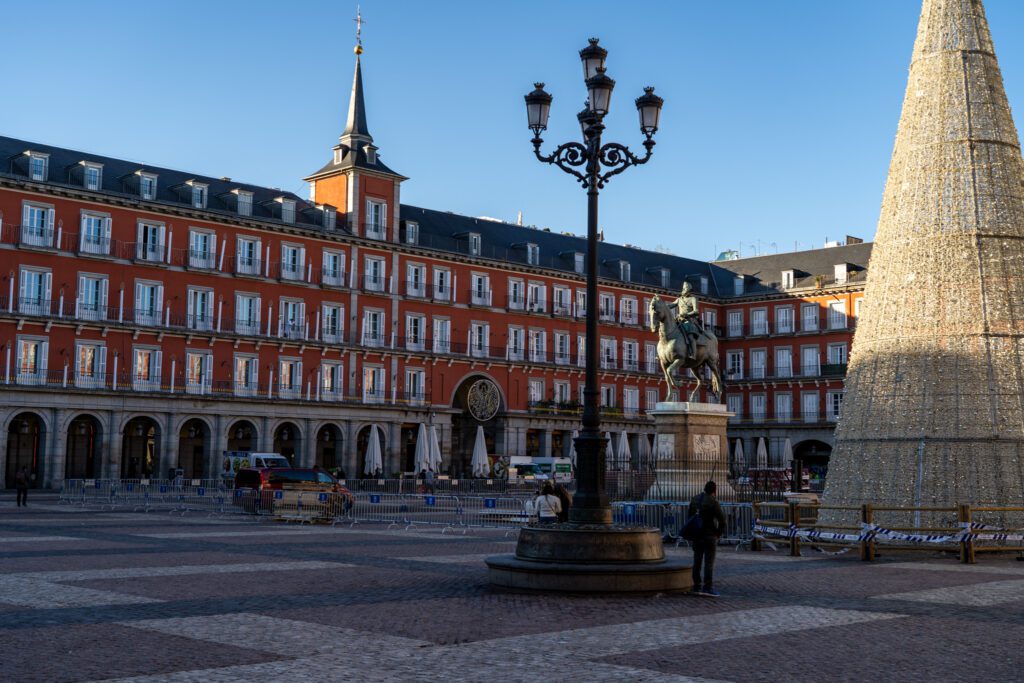
As a second stop in Spain after Barcelona, Madrid is going to be quite the contrast. You’ll get to see the stark differences between the Spanish capital city and its most famous city (the latter being Barcelona). Madrid feels distinctly more livable, with dense housing and sprawling green spaces, and the biggest difference we noticed is that we heard far, far fewer people speaking languages other than Spanish.
The other thing we noticed is that Mardillenos say “vale” (which means “okay,” roughly) about every three words. We love those funny language quirks.
We enjoyed Madrid, and think two days in the city itself is a perfect amount of time to see the highlights and get a feel for the bustling capital.
However, there are some great day trips to be had from Madrid – Toledo, Segovia, and Avila, to name a few.
We’d highly recommend spending an extra day to do a day trip to Toledo from Madrid , where you’ll see a city shaped by Muslim, Jewish, and Christian cultures over the course of centuries. You could also spend the night in Toledo, but it is going to mean extra time on your trip to Granada.
Getting to Madrid
The best way to get to Madrid is by train.
There are multiple direct high-speed trains a day running between Barcelona-Sants and Madrid Puerta de Atocha, which are the stations you’re going to want.
It takes roughly three hours and costs around 40 Euros per person to start, more if you book closer to your travel dates. So try to book your long-distance train tickets as far in advance as possible to save money!
One other thing to note – the best way to get from Atocha Station to the center is using the regional train system (called “Cercanías”), and your train ticket includes a transfer to that system.
You have to scan your long-distance train ticket at a special scanner – ask an attendant how to do it if you can’t figure it out. More information here .
Click here to see prices and timetables for the journey from Barcelona to Madrid on Omio .
What to Do in Madrid
Madrid has fewer major tourist attractions than, say, Barcelona, but it’s an equally enchanting city, with fun, lively neighborhoods full of people that actually live there (versus Barcelona, which feels like it might actually just be 100% tourists in places like the Gothic Quarter).
The most famous of the things to do in Madrid is the Museo del Prado, a collection of mainly paintings that was shaped by the Spanish royal family at the peak of their power between the 16 th and 19 th Centuries. We have an entire section on the Prado below, because we think it’s that important.
Here are some things that you shouldn’t miss while you’re in Madrid.
Visiting the Prado Museum

I want to preface this section with the fact that we’re not really art museum people. But thanks to an expert guide who helped make sense of the huge collection at the Prado, it was still a highlight of our trip to Spain.
The Museo del Prado is the premier attraction in Madrid, and it made its way onto our list of our favorite art museums in Europe.
For that reason, you’ll find that tickets are competitive in the same way that the Sagrada Familia is, and you’ll want to buy tickets well in advance to ensure that you get to see it. Tickets are known to sell out in the high season.
There are a couple of themes in the Prado Museum, the main ones being the Spanish collection, featuring some of Spain’s most famous painters like Goya and Velasquez, the Italian collection, and the Flemish collection, which was our favorite.
Flemish art is imaginative, vibrant, and… dark. Very dark. It’s a very, very unique style, and the Prado Museum is one of the best places in the world to see it. There are entire rooms dedicated to the Flemish masters, and we would make sure to cover it on your visit.
The Prado is massive. You could easily spend a full day here and not see everything.
Like most of the main art museums across Europe, we think the Prado is best experienced with a knowledgeable guide who knows something about art history. Which is how we experienced the museum.
After considering a bunch of tours, we picked this tour with Jaime , whose knowledge about Spanish and art history turned our experience from “those are some cool paintings” to a much deeper understanding of the pieces of art, including the context around them in terms of Spanish history, and the artist’s life.
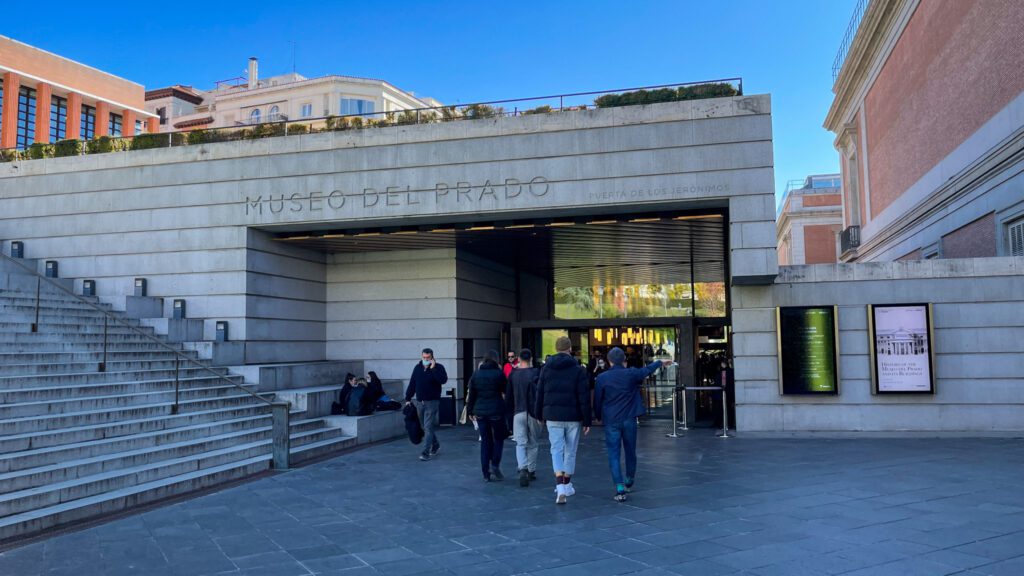
Perhaps the most important thing a guide brings to the table is curation. There are thousands of pieces of art in the Prado, and we certainly would’ve had no idea where to start. Jaime picked out a few important pieces in each section, and we went deep on those rather than trying to see everything.
If you’re interested in a guided tour , we’d recommend this one with Jaime (the one we did), or if Jaime isn’t available, this tour that was on our shortlist.
Visiting the Prado independently : If you want to visit on your own, you can find tickets on their official website . You’ll need to choose a timeslot for your visit – we heard that the later afternoon times tend to be the least busy, but it’s generally always full in peak season.
Pro-tip : Leave the backpack at home – you’ll need to check it in the coatroom, and the lines are notoriously long.
Tickets sold out for your dates? You have a couple of options. Show up on the day you want to go when the ticket office opens to buy tickets for that day. Check Get Your Guide to see if they have any skip-the-line tickets available. Or join a guided tour that includes tickets .
The Royal Palace
One of the biggest in Europe, the Madrid Royal Palace is built on the site of the original Muslim city. Madrid became the capital of Spain in the 16 th Century, and the Royal Palace as we know it today was built around that time.
Sort of, it has burned down a couple of times and has been rebuilt. Buy your tickets in advance to avoid the huge ticket lines .
Tickets are available on their official website .
Tapas in La Latina
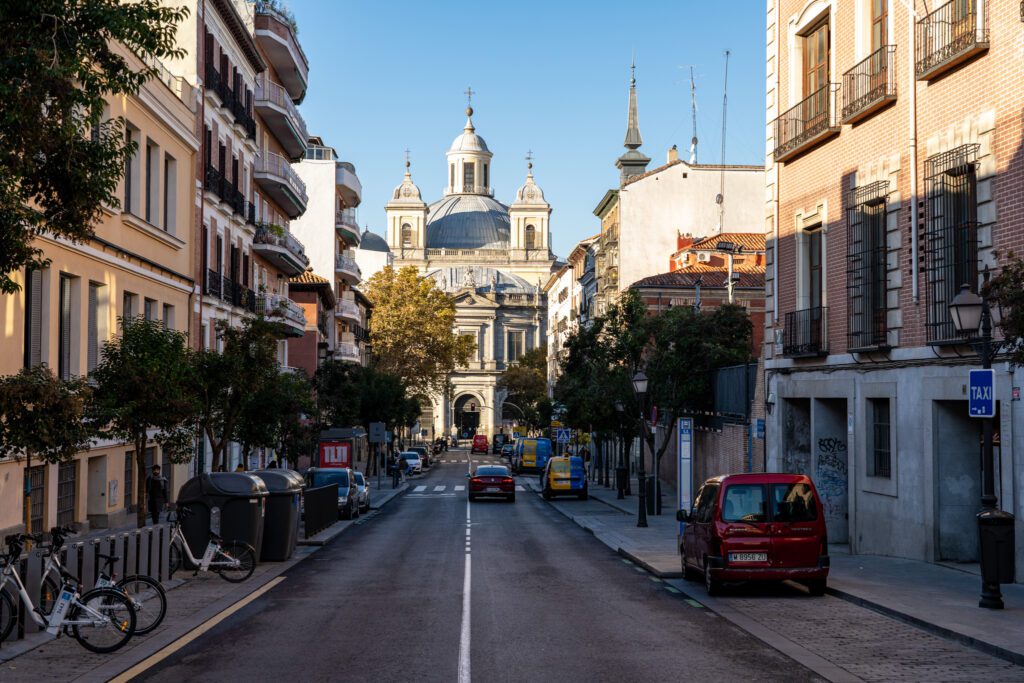
Tapas qualify as a must-do in Madrid, and there’s a particular street in La Latina, a very fun neighborhood just south of the main center, that is famous for tapas bars.
It’s called Calle Cava Baja , and it’s lined with all sorts of different tapas joints of varying qualities and styles. It’s particularly popular around lunchtime and in the late afternoon before dinner.
A Walking Tour through Medieval Madrid
To understand the context around Madrid and its role in Spanish history, we’d recommend connecting with a local expert.
You’ll learn about how Madrid wasn’t much of a big city until the 16 th Century when it became the capital, and all the shenanigans that have happened since.
We have two personal recommendations here. First, the walking tour we did with Bradley , an American with a PHD in Spanish history, which covered the origins of Madrid and the evolution of the city over the centuries.
Second, Jaime’s version of a similar walking tour . Jaime was our guide for the Prado, and he was born and raised in Madrid and has an encyclopedic knowledge of Madrid’s history, culture, and art.
Parque El Retiro
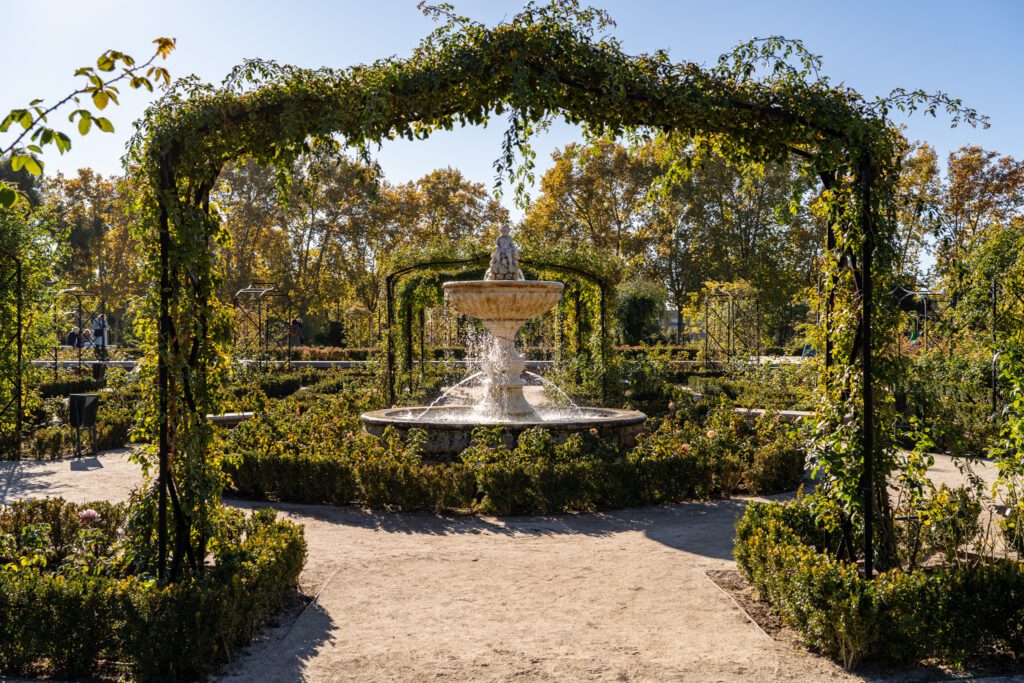
Madrid’s best green space, located on the eastern side of the city near the Prado Museum. There’s a rose garden, a lake, and all sorts of lovely greenery that provide a nice break from the bustling city streets.
Start from the northwestern corner at Puerta de Alcala, and make your way south to the rose garden, passing the lake and Palacio Cristal along the way.
Where to Stay in Madrid
While there are a bunch of fun, unique places to stay in Madrid (you can read all about them in our guide to the best places to stay in Madrid ), two areas rise to the top for very different reasons.
Staying in Malasaña: Our Favorite Neighborhood in Madrid
Malasaña is the hipster haven just north of Gran Vía, the main artery running east to west through the heart of Madrid. It’s charming, hip, and full of amazing places to eat and drink at all hours of the day, from morning coffee to midnight mojito.
Here are some specific places to consider:
- If you want an upscale hostel : Stay at Bastardo Hostel
- If you want a boutique hotel: Stay at 7 Islas Hotel
- If you want an apartment : Stay at limehome Madrid Calle de la Madera
Staying in Sol-Gran Vía: As Central as it Gets
Sol-Gran Vía is much more about the central location than how charming it is. It’s where we stayed, and we basically walked everywhere we went in Madrid. It’s 15-20 minutes to both the Royal Palace and Prado Museum, and 10 minutes to the heart of Malasaña and La Latina, two of our favorite places to hang out in Madrid.
Plus, Plaza Mayor is going to be just a few minutes away (it’s inside the boundaries of the neighborhood).
- If you want an upscale hostel : Stay at TOC Hostel
- If you want a boutique hotel : Stay at Vincci The Mint
- If you want an apartment : Stay at Smartrentals Centric Gran Vía ( where we stayed )
Day 8: A Toledo Day Trip

Before Madrid rose to prominence in the 16 th Century, Toledo was actually the most important city in the region. Today, it’s one of the best examples (outside of Andalucía, I suppose) of the coming together of the three prominent religions and cultures in Spanish history – Muslim, Jewish, and Christian.
It’s one of the few places in Spain where you can see a cathedral, a synagogue (two, really), and a mosque.
Plus, Toledo is a beautiful city, with the alcazar perched atop a hill overlooking the Tagus river below. Even the walk to the center from the train station is gorgeous – you cross a bridge with the center of Toledo across the river from you, towering above you.
To Day Trip, or Not to Day Trip?
Because it’s just a 30 minute train ride from Madrid, Toledo is absolutely doable as a day trip from Madrid. In fact, that’s exactly how we did it.
However, we also think that it’s worth investing some extra effort to be in Toledo early in the morning and late in the afternoon, when the pesky day trippers aren’t around and the city is at its most beautiful.
You’ll get to see the city at its best, when only a fraction of the day’s tourists are around, and you’ll have a little more time to go a level deeper and really appreciate the coming together of the three cultures in Toledo.
We see the merits of both approaches, and this one comes down to your personal preferences. It is worth noting that you have a somewhat long train ride down to Granada, and to do it from Toledo you’d actually have to go back to Madrid (even though Toledo is located towards Granada) and connect from there.
That alone might make it worth doing it as a day trip, but it’s up to you.
How to Spend a Day in Toledo
Here are the best things to do with a day in Toledo.
We would actually skip the interior of the Toledo Cathedral , which, while spectacular, costs more than 12 Euros to enter, and even more if you want to go up into the belltower and cloister. It’s a church! Sure, it’s massive and monumental, and beautifully decorated with works from famous Spanish artists like Goya, but we think 12 Euros is still steep.
The Alcazar & Military Museum
The Alcazar of Toledo – which is a castle with roots in the 3rd Century – is perched on a hill overlooking the Tagus River (which runs all the way to Lisbon in Portugal) and is now home to a military museum. But it’s not actually about the military, really.
The best part of this museum is the detailed chronicle of Spain’s history in six chapters. Which does include a lot of things focused on the military, but uses a much wider aperture to explore the history of the country.
They also have some collections of guns and swords and stuff like that, which isn’t that unique or impressive, in my opinion.
It’s well worth the couple of hours it’ll take you to go through Spain’s history. The museum is free on Sundays!
The Two Synagogues
There are two synagogues in Toledo that are worth visiting, and they represent two of very few old synagogues left in Spain.
The first, Sinagoga de Santa María La Blanca , is the more famous one, and I was a little surprised at the lack of information inside. Still, the arches and in the dimly lit interior are quite something.
It’s technically no longer a synagogue after it was confiscated when the Jews were expelled in 1492. Today, it’s owned by the Catholic Church, who has yet to return it to the Jewish community despite them asking the church to do so.
The second is the Sinagoga del Tránsito , which is very different – far less ornate – and has a small but mighty museum (the Sephardi Museum) on the history of Judaism on the Iberian Peninsula.
We enjoyed the Mudejar style, which takes inspiration from Islamic architecture and was often created by Muslim artists for non-Muslim buildings and patrons. More on that style when we get into Andalucía.
The Monastery of San Juan de los Reyes
Just down the street from the two synagogues is a nice monastery whose main attraction and highlight is undoubtedly the multi-floor cloister in the middle.
Originally, it was supposed to be the burial place of Queen Isabella and King Ferdinand – the royal couple responsible for bringing the two Spanish kingdoms together – but they ended up deciding on Granada later in life after they conquered the last Muslim kingdom in Granada in 1492.
Make sure to do the ground floor and upper floor of the cloister, and check out the gargoyles on the upper floor.
You’ve seen Christianity, you’ve seen Judaism, now for the last of the three main monotheistic religions, Islam. There’s a small (former) mosque in the center of Toledo near Puerta del Sol that was built in 999 AD.
Throughout our time in Spain, particularly in Andalucía, we were struck by the contrast between the grandeur of cathedrals and churches, which were very much meant to project power first and foremost, and mosques, which are more humble places of worship.
This former mosque, called the Mosque of Cristo de la Luz, is small compared to any church in the city, and it was converted into a church when the Christians conquered the city (SURPRISE).
Days 9 & 10: Granada
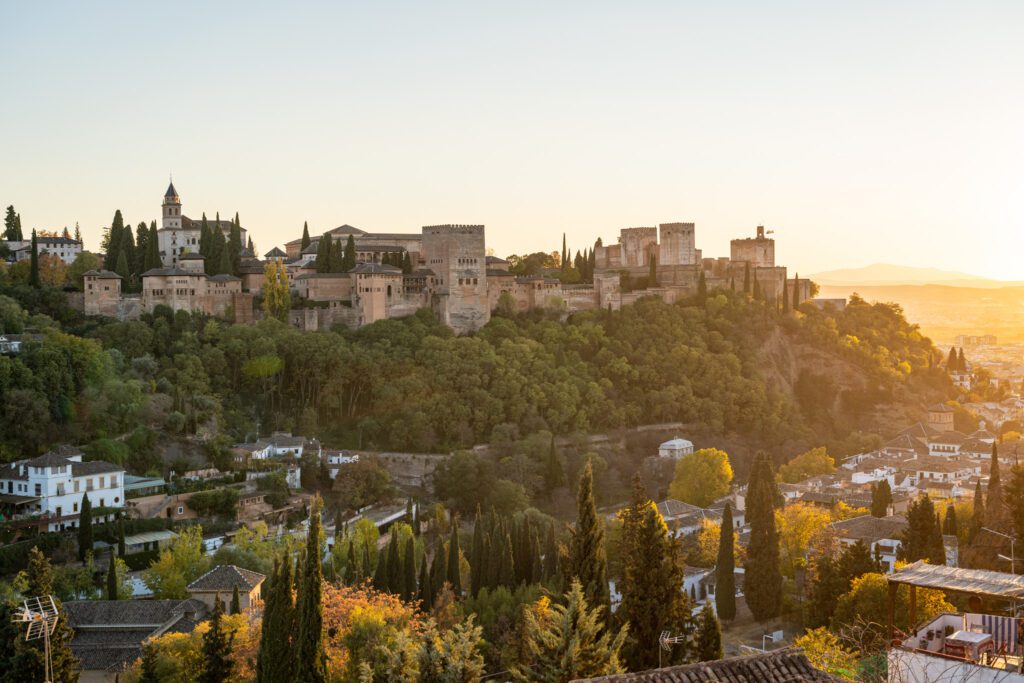
Granada was one of our favorite stops in Spain for a couple of different reasons. First, the Alhambra is an impressive feat of architecture, and it’s well worth half a day exploring the former fort turned palace at the top of the hill. The gardens of Generalife, the former summer palace of the Nasrid family, and the Nasrid Palaces in particular are stunning.
However, Granada is more than the Alhambra, which is why we’d recommend spending a couple of days here rather than coming, doing the Alhambra, and then leaving.
Granada was the last Muslim stronghold on the Iberian Peninsula, falling in 1492 to the Christian monarchs after many centuries as part of a Muslim caliphate. The impact of those centuries of a strong Muslim community are immediately evident as you walk the streets of Granada, particularly in the Albaicín, the Muslim Quarter.
From mosques that have been turned into churches but still retain some unique architectural elements, to countless tea houses (Alysha’s favorite!), Granada is a city worth exploring beyond just the Alhambra to understand how the different cultures have mixed over the centuries.
For more information on Granada, make sure to check out our guide to 2 days in Granada , which has everything you need to know to spend a couple of days in the city, including how to see the Alhambra.
Getting to Granada
From Madrid, Granada is a bit of a journey. It’s basically due south, and the Sierra Nevada Mountains make the journey a little longer and more circuitous than it should be. Along the train ride, you’ll pass olive trees as far as the eye can see.
No, seriously. Almost the entire train ride is just views of row upon row of olive trees.
It’s going to take you three and a half hours or so to get from Madrid to Granada, but we think it’s worth it and the train ride is pretty beautiful. Tickets can be expensive, so book as far in advance as you can.
Check prices and train times for your dates on Omio , which is what we used in Spain to book trains and buses when the official Renfe website wouldn’t take our American credit card (which happened at seemingly random times).
We like Omio because it’s a more user-friendly experience, giving you all the train and bus options in one place, and it’s all in English. You’ll pay a small service fee, but we think it’s worth it.
Things to Do in Granada

Like we mentioned, Granada is more than the Alhambra, though we definitely think you should see the Alhambra while you’re there.
The Alhambra

One of the most popular tourist attractions in Spain, the Alhambra was built by the Nasrid dynasty, the last Muslim territory on the Iberian Peninsula. It’s part defensive castle, part royal palace, and there are three parts of the complex.
The Generalife (summer palace and gardens), the Alcazaba (the castle part), and the Nasrid Palaces (the most unique and beautiful part).
You can get a ticket that covers all three, but the Nasrid Palaces require a timed entry reservation, while the other two can be visited at any time on the day your ticket is for.
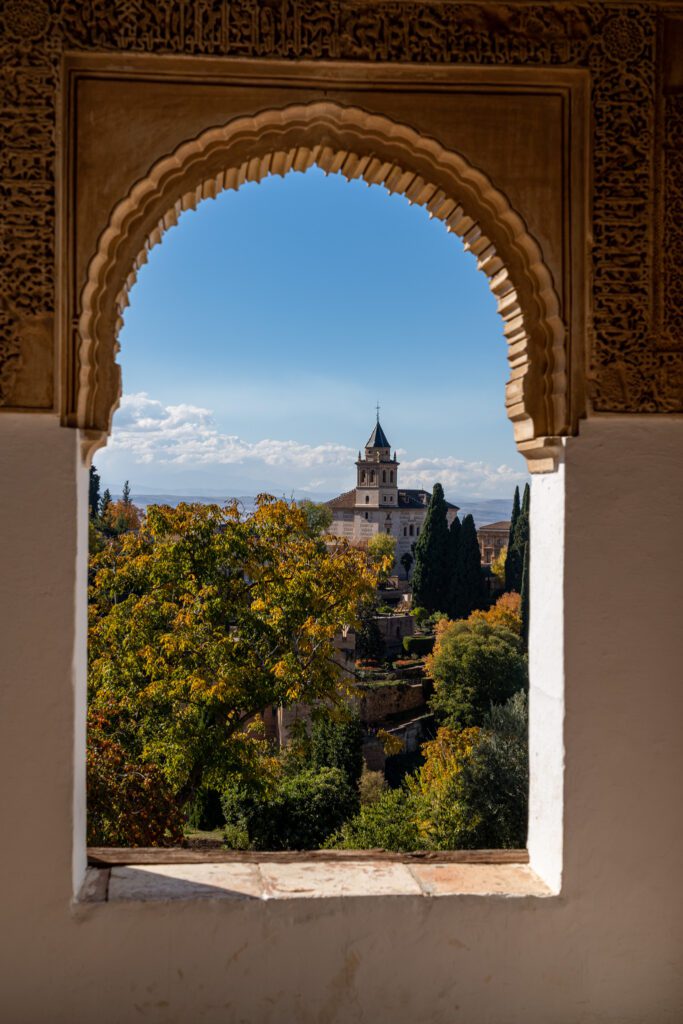
All three are a must-visit, and you should get the ticket that gives you access to the entire complex.
Buy tickets on the official website as far in advance as possible to visit independently, but we’d recommend a guided tour to get the context you need to really understand what you’re looking at.
We did this guided tour , and really enjoyed it.
Pro-tip : Bring water, sunscreen, comfortable shoes, and a hat if you’re visiting in the summer.
Alhambra Tickets sold out for your dates? You have a couple of options. Show up on the day you want to go when the ticket office opens to buy tickets for that day. Check Get Your Guide to see if they have any skip-the-line tickets available. Or join a guided tour .
Albaicín at Sunset
The Albaicín is the most romantic and charming part of Granada, at least in our view.
The Muslim Quarter of Granada sprawls up the hill, which used to be the home of the ruling family’s palace before it was moved to the Alhambra under a new ruling family.
It’s full of narrow streets and open plazas, some of which have spectacular views of the Alhambra across the valley.
It’s particularly stunning at sunset.
Go to The Mirador de San Nicolás ( here on Google Maps), which is more popular and full of people, or the nearby Mirador de la Vereda de Enmedio ( here on Google Maps) which is where we ended up, and there were only a small handful of people around as the golden light washed over the Alhambra.
We loved this walking tour of the Albaicín , where we got to learn more about the history of the neighborhood.
Experience a “Tetería”
Alysha isn’t a coffee drinker, but she LOVES tea. And the place to get tea in Spain is at one of the teterías – tea houses – in Granada.
One of the unique things you’ll find in Granada (and other parts of Andalusia, though not nearly as prominently as in Granada), are tea houses, which are a clear example of the influence of the seven centuries of Muslim rule in Granada.
We had a favorite that we went to multiple times over our time in Granada – La Tetería del Bañuelo ( here on Google Maps).
The Granada Cathedral and Royal Chapel
We had heard from the guide on our walking tour that the Royal Chapel was the best part of the Cathedral complex to visit, and we’d have to say we agree with that assessment.
Inside the Royal Chapel, the first Catholic monarchs of Spain (Isabella and Ferdinand) are buried, along with their children (Joana and Phillip). You can walk down into the crypt to see where they’re buried beneath the ornamental mausoleums in the center of the Chapel.
It costs 5 Euros, and there’s a handy audio guide in English.
Where to Stay in Granada
Granada is relatively compact, though we’d recommend staying somewhere near Plaza Nueva, which will give you access to everything you’ll want to see within about 15 minutes on foot.
We stayed at Limehome in Granada , which was one of our favorite places that we stayed during our entire month in Spain. Spacious, light-filled apartments with kitchens, and our particular apartment had a little terrace where you can catch a glimpse of the Alhambra.
If we returned, we’d probably stay in the endlessly charming Albaicín , but it’s a little less convenient because it’s hard to access with a car, and it’s uphill if you’re walking (which can be a problem if you’re lugging bags).
Days 11 – 14: Seville
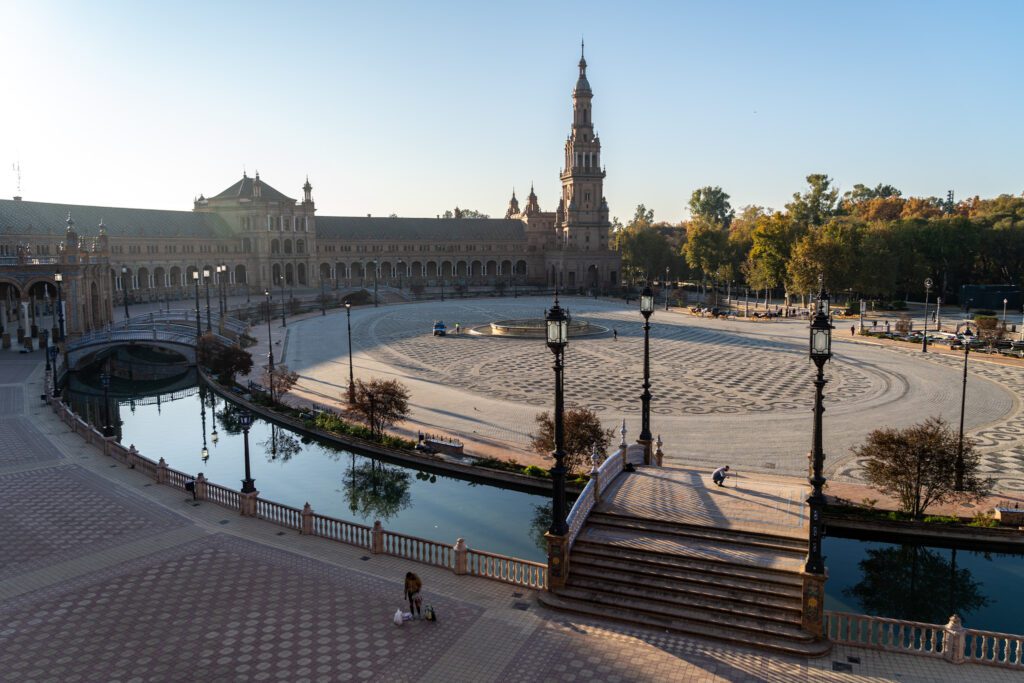
Seville has a very important place in world history, and the city is a fascinating example of multiple cultures coming together, mixing and blending over time.
Before we can really talk about Seville – the capital of Andalucía – as a Spanish city, we have to talk about its origins. Because before coming to Seville, we had a very different picture in our heads of a city that is distinctly “Spanish,” more than any other city in Spain.
After visiting, we realized that this quintessentially “Spanish” city is a product of a rich history with a diverse cast of characters, which has resulted in a fascinating city.
Seville’s history begins long before the Romans, but that’s where we’re going to start this fast-paced meander through history. Seville was an important city in Roman times, and if you don’t believe me, emperors Hadrian and Trajan were actually born in nearby Italica.
Julius Caesar himself was responsible for the construction of the original city walls of Seville, which are long gone as the city expanded well past the original Roman city’s boundaries.
Next came the Visigoths and Vandals, who were in Seville for a few hundred years, before the most consequential period in Seville’s history began in the 8th Century.
That, my friends, is when the Umayyad Caliphate arrived, which kicked off a period of Muslim rule on the Iberian Peninsula that lasted for almost eight centuries in total, though Seville was conquered by the Spanish Christians in 1248.

There’s a reason why I think it’s important to know Seville’s history going into your trip.
The entire time you’re in Seville, you’re going to be seeing the impact of the mixture of the different cultures on modern-day Seville. The main sights – the Alcázar (whose name itself is a good example of the mixing of cultures) and the Seville Cathedral have elements from both the Islamic period and various Christian periods that came afterwards.
In fact, the majority of both buildings are expansions that were built around structures that were built during the period of the Caliphate.
Putting the history aside, Seville is a lovely place to spend a few days. Vibrant, orange tree lined plazas with people eating and drinking their hearts out, gorgeous architecture (especially Plaza de España, which you shouldn’t miss), and tons of green spaces in the city make for a perfect end to your Spanish adventure.
Psst ! We have an entire detailed guide dedicated to helping you plan the perfect 2 day Seville itinerary .
Getting to Seville
From Granada, there are high speed trains that will take you to Seville in about two and a half hours. Some journeys have a change in Antequera-Santa Ana, which we did twice and is a relatively easy station to navigate.
Don’t be scared off by a change there, but know that it will likely be a bit longer with the change (but also a bit cheaper).
What to Do in Seville
There are a few things we think you shouldn’t miss while you’re in Seville.
This list is obviously not exhaustive, and for more detail you should head over to our guide to 2 days in Seville , which goes deeper on the city and what to do and see while you’re there. The Cathedral, Alcázar, and Archivo de Indias (the latter of which isn’t really worth visiting) form a three-part complex that is a UNESCO World Heritage site.
We do think that you should devote one day to Córdoba , which is a 40 minute train ride away and is home to one of the most important Muslim sites in Spain – the Mosque Cathedral.
It forms a triumvirate of important pieces of the Muslim history of Andalucía with the Alhambra in Granada and the Royal Alcázar of Seville. It’s worth making an effort to see all three during your time in Spain.
Royal Alcázar of Seville
This was our first stop in Seville, and it’s a great introduction to the history of the city because it’s a palace (with an Arabic-inspired name) built for a Christian king predominantly by Muslims, in a style that blends Muslim and Christian characteristics.
All of this happened immediately after said Christian king conquered the city from the Muslim rulers who had been there for five centuries before he arrived.
The entire thing is one big mashup of different architectural styles, cobbled together over several centuries with Gothic, Renaissance, Mudejar, and other styles all blended together. There are actually three structures here, along with a nice set of gardens where there’s a water organ – one of only a few in the world – that plays every hour, on the hour.
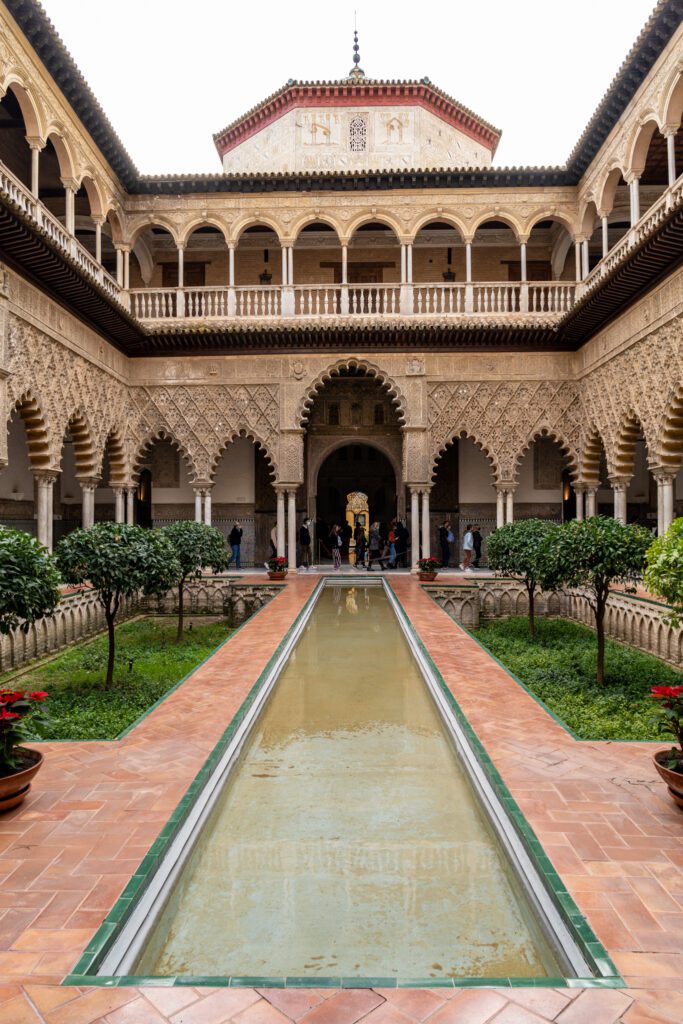
The most interesting of the structures, by far, is the Palace of Peter, where parts of season five of Game of Thrones were filmed (mainly the parts that take place in Dorne).
We did this guided tour with Jose, and think it’s well worth it to have someone to help you get a deeper understanding of exactly what you’re looking at, which would be a bit confusing on your own.
The Seville Cathedral
The Seville Cathedral was built on the site of a mosque, and provides a contrast between the part of the building that used to be a mosque – a humble place of worship made of affordable materials – and the addition of a massive cathedral that is equal parts worship and power projection.
Christopher Columbus (or at least part of him), famous for basically making one big mistake, is also buried here. The highlight is climbing the bell tower, known as the “Giralda,” for a nice view over the city. The way you get to the top is unique too.
Rather than stairs, which is what you find at most cathedrals, you’ll climb 35 ramps.
Tickets here .
Plaza de España
All of Spain’s major cities seem to have one, but Seville’s is the most spectacular, we think. I mean, parts of Star Wars: Attack of the Clones (by far the worst of the first six movies) were filmed there, so you know it has to be good.
It was built back in the early 20th Century before the Ibero-American Exposition, which was meant to strengthen ties between the Americas and Spain but turned out to be a flop given the global financial crisis that was unfolding at the time.
Still, the architecture is spectacular, with two towers, canals, and four bridges – each bridge representing a former kingdom of Spain.
A Day Trip to Córdoba
Córdoba is a perfect place to spend a day, and the Mosque-Cathedral is sure to be one of the most interesting places you’ll visit on your trip to Spain.
With a high speed train connecting Seville and Córdoba, you can easily do a Córdoba day trip from Seville and see the main sights in a day.
For a more relaxed pace, spend the night and see the city once all the day trippers have gone home.
We loved Córdoba, and have a guide to a day trip to Córdoba that you should read if you’re interested.
Absolutely do not miss the Mosque-Cathedral , and do the gardens of the Alcázar too.

Where to Stay in Seville
Seville is a relatively compact city that is also very flat, which means you’ll essentially be able to walk everywhere if you stay central. We’d recommend staying in one of the central neighborhoods that makes up the Casco Antiguo , Seville’s charming old town core. We particularly like the charming Jewish Quarter called Santa Cruz .
We stayed at Come to Sevilla – Casa de las Especias , which is a set of serviced apartments (like a cross between a hotel and an apartment complex) in the heart of the old town.
If you want an apartment, we’d recommend it. They also have two other properties in the city, one in Arenal (near the river) and one on the border of Santa Cruz .
If you’re looking for a boutique hostel – that’s a cross between a hotel and a hostel with private, hotel-style rooms and the social aspects you’d expect from a hostel – look at TOC Hostel . We stayed at TOC in Barcelona and enjoyed it, and they’re known for providing a great experience.
What to Do with More Time in Spain
The way we see it, the answer to this question has two possible paths you could go down.
The first path is adding more places along this general route, which is the one we’d recommend (and is essentially what we did on our trip).
The second path would be to pick another region – like Asturias in the northwest or Basque Country in the northeast (or even Mallorca, an island off the south coast of Spain), and spend your extra time there. We would only recommend this path if you have another week in Spain – so three weeks total. Otherwise, the travel time to get there probably isn’t worth it.
If you’re up for the first path, here are some other places that would make a great addition to your itinerary, along with how much time to allocate to each place.
- Ronda (1-2 days): One of the more charming towns in Spain, Ronda is one of the famous Andalusian white hilltop towns. It’s probably not worth more than two days, and there’s no major tourist attractions, which makes it a great place to relax, walk around, and take in the atmosphere. It is definitely worth hiking down to get a good view of the famous bridge, though.
- Montserrat (1 day): A day trip from Barcelona for hikers and people who love religious sites.
- Avila or Segovia (1 day): Two more great day trips from Madrid, Avila is known for its intact medieval city walls (and defensive towers), while Segovia is known for its Roman aqueduct.
- Cadiz or Malaga (1-2 days): If you’re looking to spend a few days at the end of your trip on the beach, these are two good options in southern Spain. Both are easily accessible from Seville or Granada, and would be a great, relaxing way to end your trip.
What to Do with Less Time in Spain
If you have somewhere between 7-10 days in Spain, you can do a condensed version of this itinerary, so you’ll be able to use the detailed information in the relevant sections to plan your trip. We’ll give you two 10 day Spain itinerary ideas, and two 7 day Spain itinerary ideas.
If you have 7 days, we’d focus on two cities (e.g. Barcelona and Madrid, or Madrid and Granada). If you have 10 days, we’d expand that to three cities (e.g. Barcelona, Madrid, and Granada). Use a single city as a home base for the region to cut down on packing up your bags and moving around, which is a big lesson we learned on our three month trip to Europe. Packing sucks, so do it as little as possible!
7 Days in Spain: Two 7 Day Spain Itinerary Ideas
Here are two ways to organize a week in Spain, one that focuses on Madrid and Barcelona, which provide a nice contrast, and one that focuses on Madrid and Andalusia, some of the most “Spanish-feeling” parts of Spain.
Madrid and Barcelona in 7 Days
Focus on Spain’s two major cities – Barcelona and Madrid – and use them as a home base to do a couple of day trips.
- Day 1: Arrive in Barcelona
- Day 2: Barcelona
- Day 3: Girona Day Trip
- Day 4: Early train to Madrid
- Day 5: Madrid
- Day 6: Day Trip to Toledo
- Day 7: Madrid & Fly Home
Madrid and Seville in 7 Days
Start your trip in Madrid, Spain’s capital, and make your way south to Seville, the capital of Andalusia, over the course of seven days.
- Day 1: Arrive in Madrid
- Day 2: Madrid
- Day 3: Toledo Day Trip
- Day 4: Train to Seville
- Day 5: Seville
- Day 6: Seville
- Day 7: Seville & Fly Home
10 Days in Spain: Two 10 Day Spain Itinerary Ideas
With 10 days, you have a bit more time, but not quite enough to fit Barcelona, Madrid, and Andalusia all into your trip.
Barcelona, Madrid, and Granada in 10 Days
In this version, you’re skipping Seville (one of our favorite places in Spain) in favor of Barcelona, Madrid, and Granada. Granada and the Alhambra gives you a taste of Andalusia, which you can come back to on a dedicated trip later.
- Day 4: Barcelona
- Day 5: Early train to Madrid
- Day 6: Madrid
- Day 7: Day Trip to Toledo
- Day 8: Granada
- Day 9: Granada
- Day 10: Fly Home from Granada
Madrid and Andalusia in 10 Days
In this version, spend the bulk of your time in Andalusia, with a couple of days in Madrid at the beginning and a full week split between Seville and Granada, where you’ll be able to dive a little deeper into the complex, intertwined history of the Muslim and Christian periods in southern Spain.
- Day 4: Madrid
- Day 5: Granada
- Day 6: Granada
- Day 7: Seville
- Day 8: Seville
- Day 9: Seville
- Day 10: Seville & Fly Home
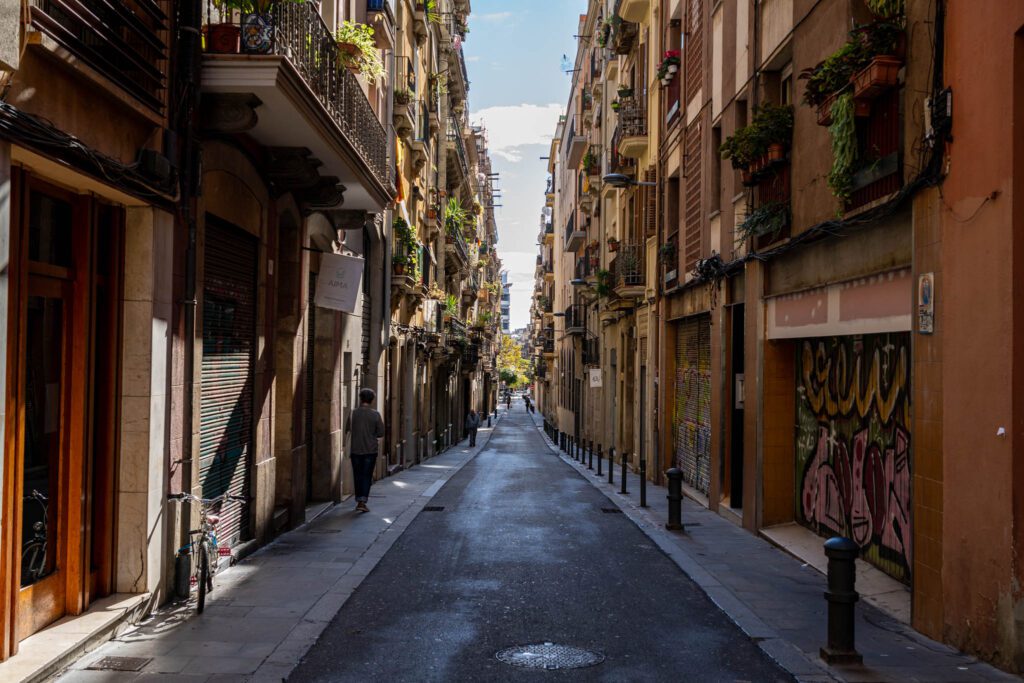
Let Us Help You Plan Your Amazing Trip to Spain!
We’ve got plenty of other detailed guides for our favorite places in Spain – from Barcelona, to Madrid and Andalusia – that we wrote to help you plan an incredible trip.
P.S.: If the link isn’t there, it means we’re still working on it and the guide will be up shortly. It takes a lot of time and effort to put together these detailed guides! Bear with us.
- Two Weeks in Spain: How to Plan an Amazing 14 Day Spain Itinerary
- 4 Days in Barcelona: How to Plan the Perfect Barcelona Itinerary
- Where to Stay in Barcelona: A Complete Guide to 5 Great Areas
- Gluten Free Barcelona: A Complete Guide for Celiacs
- Exactly How to Take an Amazing Day Trip to Girona From Barcelona
- 2 Days in Madrid: A Complete Guide to Planning Your Madrid Itinerary
- Where to Stay in Madrid: A Complete Guide to 5 Great Areas
- Gluten Free Madrid: A Complete Guide for Celiacs (Restaurants + Bakeries)
- Taking A Day Trip to Toledo From Madrid: A Complete Guide
- 2 Days in Granada: A Complete Guide to the Best Things to Do in Granada
- 2 Days in Seville: A Complete Guide to Planning a Seville Itinerary
Matt is the founder and main writer behind Wheatless Wanderlust, which he started back in 2018 as a way to share his gluten free travel guides with his fellow Celiac travelers.
Since then, Matt and his wife Alysha have visited 18 national parks, spent three months in Europe and six weeks in Colombia, and have explored every corner of the Pacific Northwest, which is where Matt grew up.
He writes super detailed guides to the places they visit, bringing together personal experience and historical context to help YOU plan an amazing trip.
I’m planning a trip to Spain next summer and have really enjoyed your blog! Your suggestion Madrid And Andalusia In 10 Days is just about perfect for us, thank you!
That sounds like an incredible trip – enjoy!
Thanks for this truly informative guide. I will have 3 wks in Spain next month and am booking everything so last minute. I’m set on Madrid, Barcelona, San Sebastian and a bit torn between Granada, Valencia & Seville. My Barcelona-based friend suggested the Canary Islands, too. I saved so many of your tips for museums, walking tours, neighborhoods to stay in and much more. THANK YOU! Glad you had such an amazing trip!
Hey Laurel! Thanks for the kind words – hope your trip is amazing. For what it’s worth, we really loved Granada and Seville. Cheers!
We have 14 days (not counting travel time from SFO and back) and hoping to see both Portugal (Lisbon & Porto) and Spain. I’m having such difficulty limiting number of region/cities in Spain to tackle. I’m looking at Barcelona, Madrid and so torn whether to do Seville or Granada.
From your extensive travel experience, does it make sense to start trip in Barcelona and fly back to SFO from Lisbon?
Your thoughts?
Hey Mylene! First of all, I want to say that this comment inspired me to start working on a Spain + Portugal guide, because multiple people have asked this, which must mean there are many more out there wondering how to combine the two!
After working through the logistics and outline for that guide, here’s what I’d do. I’d split it into six days in Portugal (just do Porto –> Lisbon, which you can read about in our Portugal itinerary), fly to Sevilla (the better flight options are from Lisbon, which is why we’d do Porto to Lisbon in that direction), and then do Sevilla (2 days + day trip to Cordoba), Madrid (2 days + day trip to Toledo), and Barcelona (2 days). If you have to cut something, probably cut Toledo.
We do love Granada, but we also loved Cordoba, which is an easy 45 minute train ride from Sevilla, and combining the two gives you a great introduction to Andalucía.
Can we see Granada and Seville without renting a car? Is there publich transport within these two cities?
Hey there! You sure can – we didn’t rent a car in Spain, and did Sevilla, Cordoba, Granada, and Ronda all without a car. The train connections are great, especially between the first three (Ronda is a little harder to get to, but still doable).
Leave a Reply Cancel reply
Your email address will not be published. Required fields are marked *
This site uses Akismet to reduce spam. Learn how your comment data is processed .

10 Days in Spain, Itinerary for First-Timers
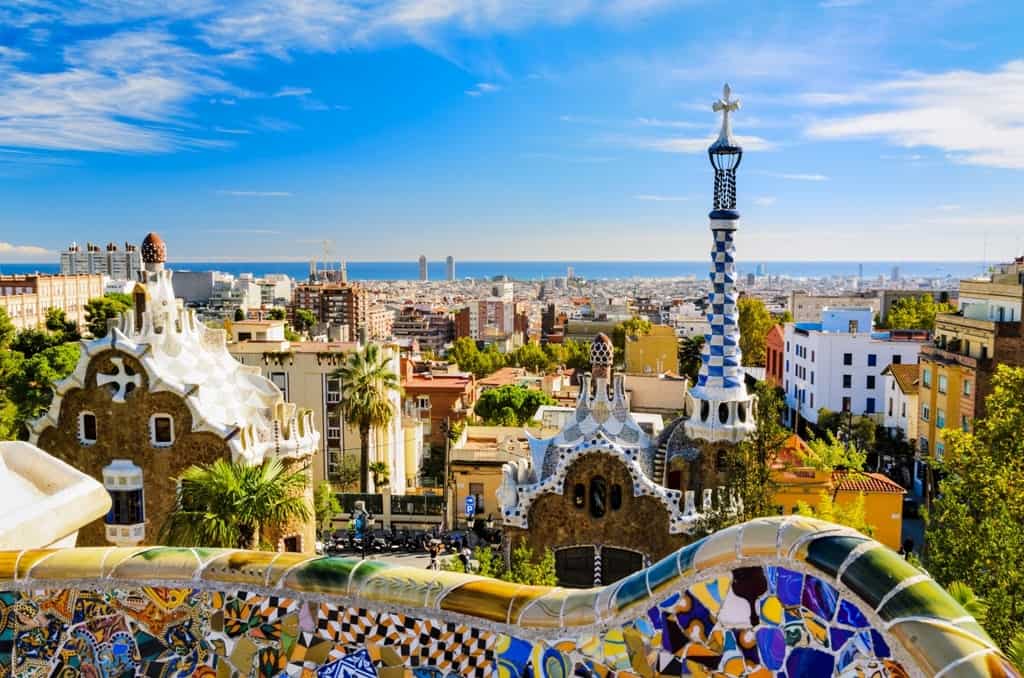
Planning to spend 10 days in Spain, a country bursting with life, color, passion, and fire? Spain is a country that caters to the needs of every traveler. From the staggering landscapes, the bustling plazas, the cities that never sleep, and the unparalleled gastronomic and cultural experiences – you’ll be spoilt for choice.
The country of Spain needs at least a few months to get around and see everything and get to actually experience the diversity that it offers, but this 10 day Spain itinerary can be a great introductory trip to get a gist of the country.
Disclaimer: This post contains affiliate links. This means that should you click on certain links, and then subsequently purchase a product, I will receive a small commission.
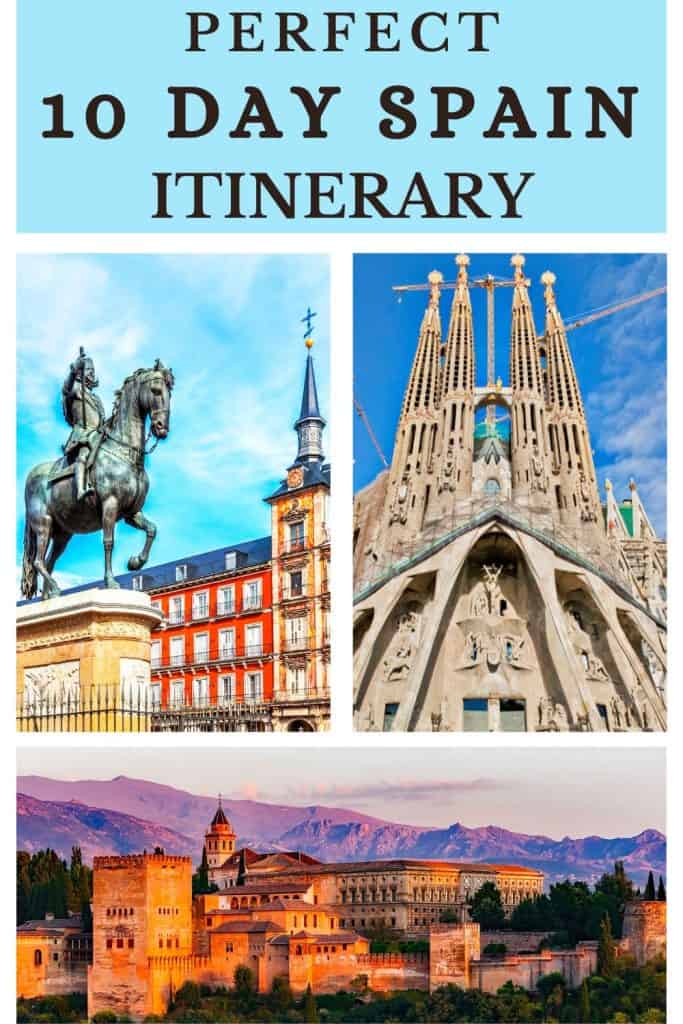
Table of Contents
10-Day Spain Itinerary: Barcelona, Madrid, Toledo, Seville & Granada
- Day 1- 3: Barcelona
- Day 4 – 5: Madrid
- Day 6: Toledo
- Day 7: Seville
- Day 8-9: Granada
- Day 10: Fly home
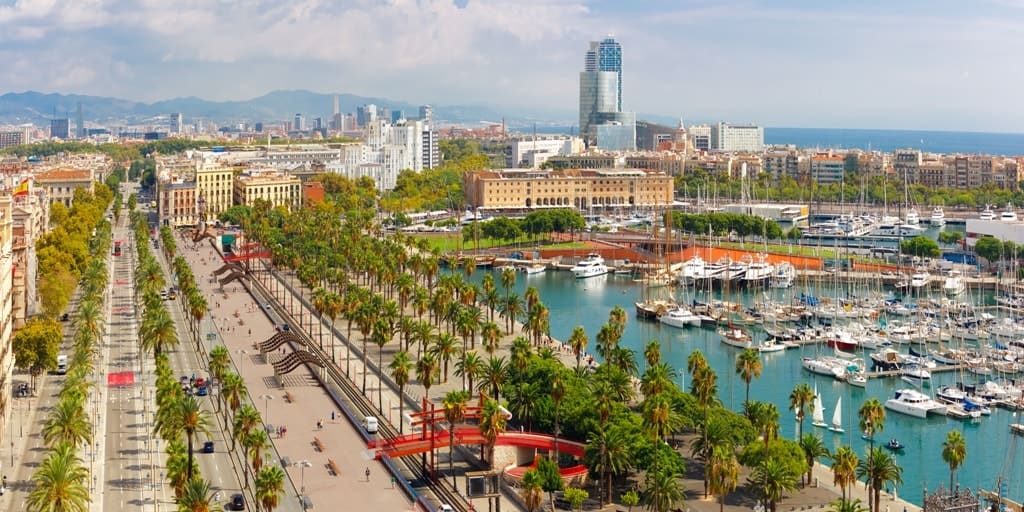
Barcelona Go City Pass
A good way to save time and money is to invest in a Barcelona Pass . With the pass, you can save up to 50% on the top Barcelona attractions.
The Barcelona Pass is all-inclusive and provides access to popular attractions, like:
- Casa Batlló
- Sagrada Familia Guided Tour
- Park Güell Guided Tour
- Barcelona Bus Turístic
- FC Barcelona – Immersive Tour
Click here for more information and to book your Barcelona Go City Pass.
Day 1 Barcelona
Your 10-day Spain itinerary starts in Barcelona. After settling down at your hotel, get ready for the first sight of the city. Barcelona is a city that teems with life unlike anywhere else in the world…A city that truly has it all.
From the azure beaches to the pumping life to the spirit of Gaudi looming over the city and manifesting itself into the city’s hypnotic façade…Barcelona will never fail to enchant you. Colorful, lively, youthful, and so international – I can guarantee that Barcelona will end up being one of your favorite cities.
Tip: Barcelona is a big city get around comfortably with a 2, 3, 4, or 5-day public transport ticket.
Where to stay in Barcelona
Petit Palace Boqueria Garden : Situated right in the Boqueria of Barcelona, this gorgeous hotel combines all the amenities needed and a central location. It’s simple, beautiful, and has a genuine atmosphere to it. Click here for more information and to check the latest prices. Ciutat de Barcelona : Huge sunlit windows, a rooftop terrace, a swimming pool, and all amenities you might need in a hotel, the Ciutat de Barcelona is a 15-minute walk from the beach and only 1 minute away from the Gothic Quarter. Click here for more information and to check the latest prices. The One Barcelona : Extremely sleek and super luxurious, the One is located in the prestigious Passeig de Gracia. The hotel looks directly at La Pedrera and boasts spacious rooms, a restaurant, and a cocktail bar, and a spa. Click here for more information and to check the latest prices.
Check here for a complete guide on where to stay in Barcelona .
Placa de Catalunya
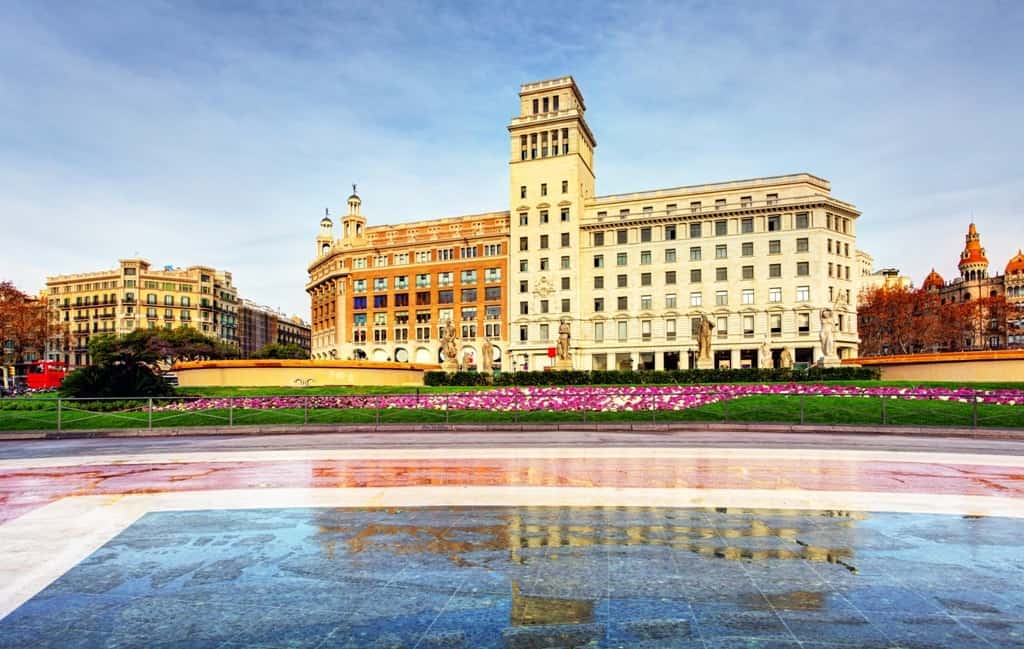
Placa de Catalunya is the pumping heart of the city, the place where all life begins, all nights end, and where LasRamblas and the Gothic Quarter also start and end. Impressive fountains, elegant statuary, large squares dotted with shops, and hoards of people from all over the world meet, greet and leave….Spend a little bit of time checking out the different shops and then head over to Las Ramblas.
You can check this Northern Spain itinerary for more inspiration.
Las Ramblas
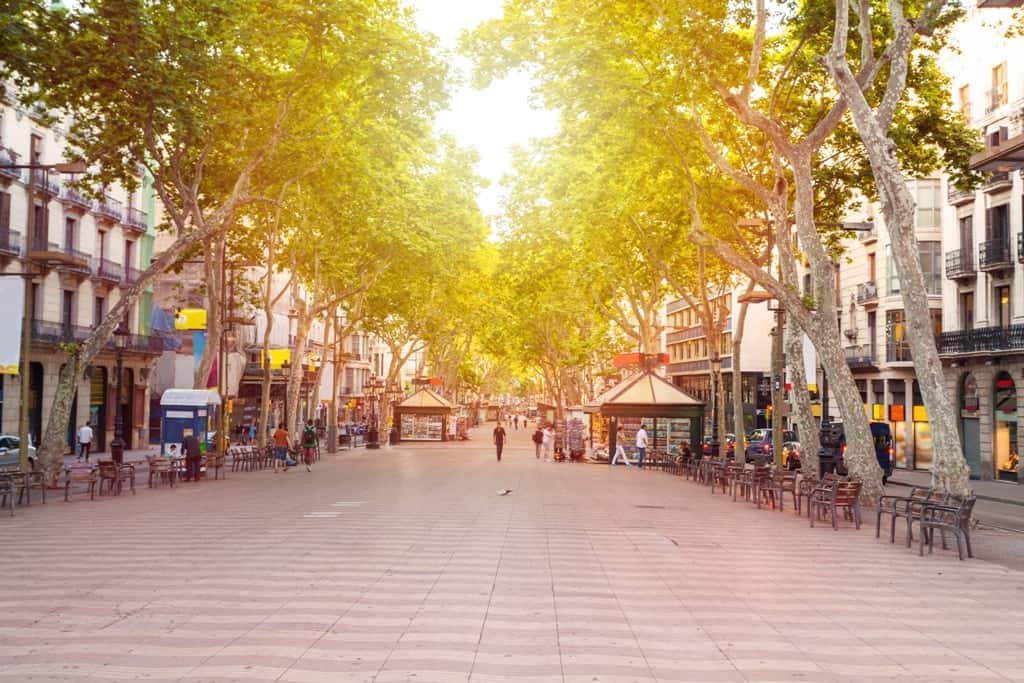
The main street in Barcelona, Las Ramblas is as energetic and as lively as it gets. It’s one of the most energetic boulevards in the world, throbbing with life, with soul, and with an array of activities, you can do. Starting at Café Zurich, you’ll be able to really get yourself into the mood where dancers, tourists, performers, and locals all mingle together to enjoy the bustle of Barcelona’s heart.
L ooking for a great tapa place in Barcelona? Check out the Tickets Barcelona Restaurant .
La Boqueria

To further get a true taste of Barcelona’s culture, you need to live it like a local. Head over to La Boqueria market in the middle of Las Ramblas, where you’ll be able to catch a glimpse of a plethora of colorful food stacked on top of each other. From exotic herbs and spices to vegetables – you’ll find it all.
Do you want to plunge deeper into the culinary repertoire of Barcelona?
🍲 Learn about the history and cuisine of Barcelona by looking at the counters at the La Boqueria food market and then walking through the alleys, squares and back streets of the Gothic Quarter and the El Born quarter on this tour
Gothic Quarter
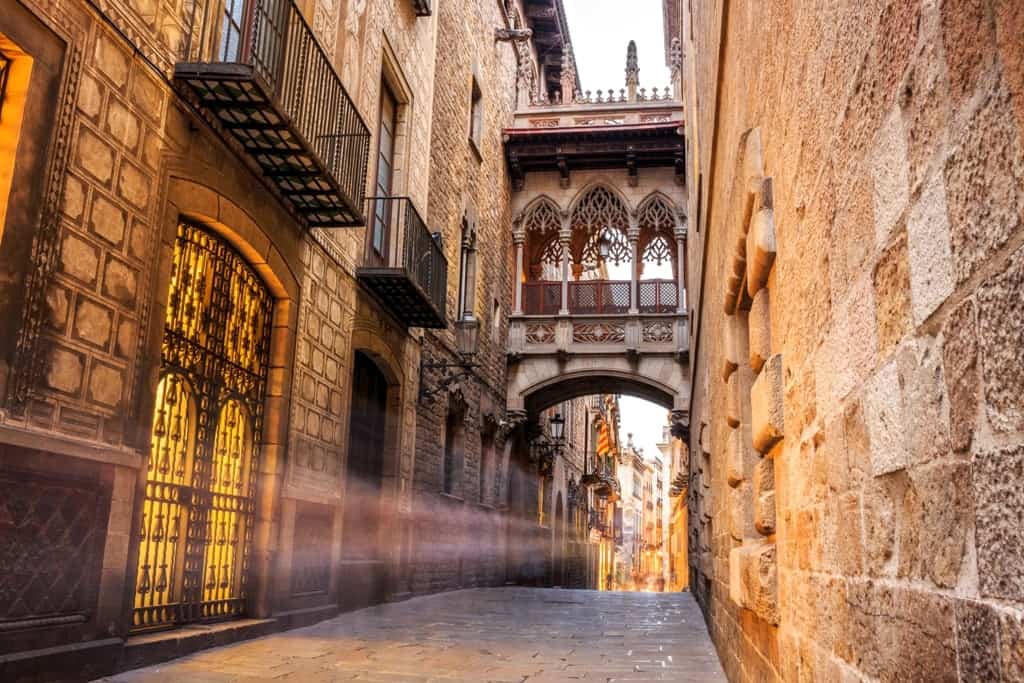
You’ll see that Las Ramblas hides dozens of different alleys that take you to hundreds of winding streets….Let me introduce you to the gothic quarter. An unbelievable blend of medieval architecture contrasting modern shops, streets that have been there for thousands of years, and a charm that will make you forget that you’re in Barcelona. This was originally the place of a Roman settlement and has now been transformed into a place dotted with bars, shops, and cathedrals.
Barcelona Cathedral
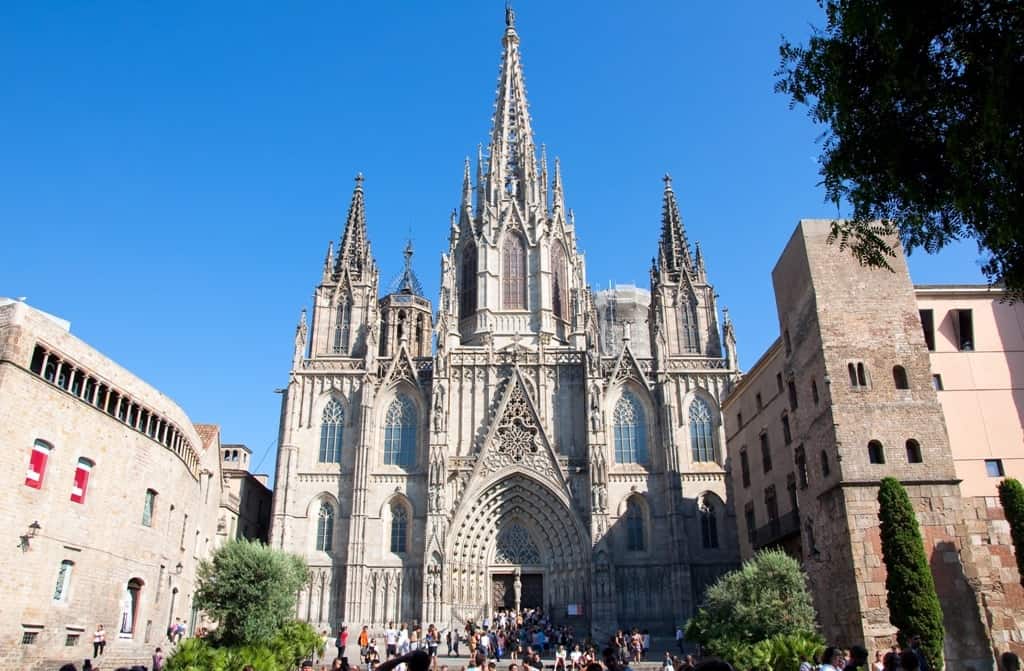
In the middle of the Gothic Quarter is the Barcelona Cathedral – soaring proudly into the sky; make sure you go there just before the sun sets. People are all huddled around the cathedral, violin players set the mood, the church bells ring, and the mood is beautiful.
You might also be interested in: Essentials travel tips to know before visiting Spain.
Day 2 Barcelona
Your second day will be all about Gaudi – after all, he had the main inspiration for what Barcelona looks like, and an iconic symbol to not only Barcelona but to Spain as well.
Sagrada Familia

Start your day by going to Sagrada Familia first thing in the morning as the lines get extremely long and the place gets incredibly crowded. I highly suggest that you buy your skip the line tickets online or book a tour in advance to avoid disappointment.
Sagrada Familia is Barcelona’s iconic symbol, it’s the Eiffel Tower of the city, a symbol of Gaudi, his masterpieces, and of both spirituality and design. Make sure to check the different exteriors that depict different stories (crucifixion, life and death, and even the birth of Jesus).
Tip: Looking for a Gaudi tour? I highly recommend the following: Complete Gaudí Tour: Casa Batlló, Park Guell & Extended Sagrada Família
Casa Milà – Casa Batlló
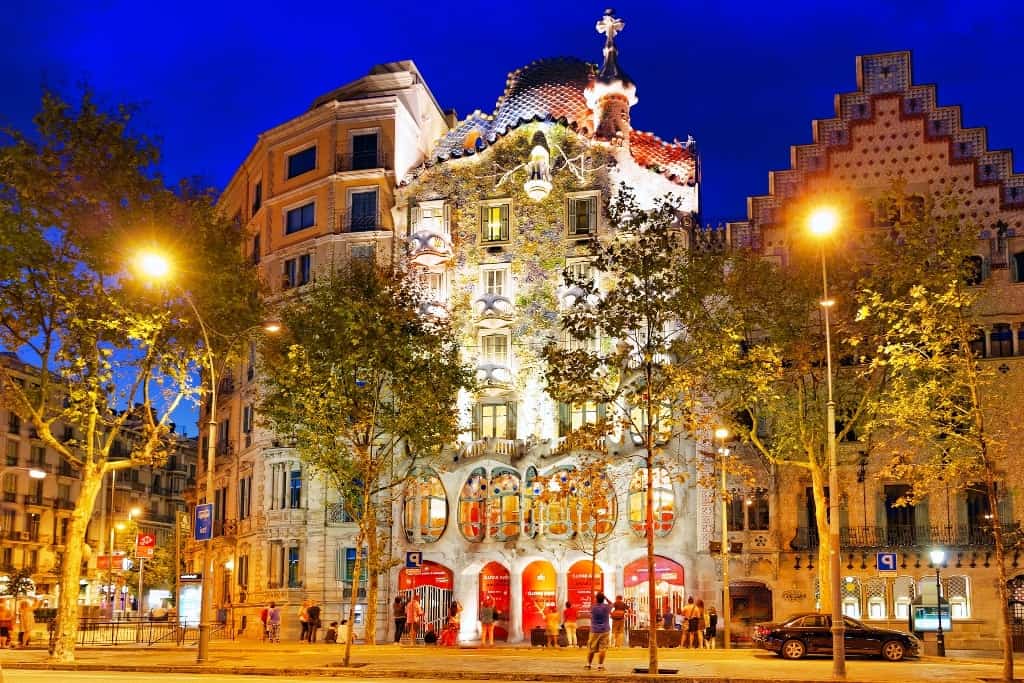
Next, head to both, Casa Milà and Casa Batlló. They are a 6-minute walk away and are both the perfect reflection of Gaudi’s eccentric architecture. Curvy walls, weird alleyways, polychromatic colors, hypnotic paintings, and much more, you’ll be able to truly get a taste of Gaudi on a more intimate level than ParcGuell. It’s a legend of architecture, of creation, the true meaning of letting your creativity run wild.
Click here to book your Casa Milà skip-the-line ticket and here to book your skip the line tickets to Casa Batlló .
Placa Reial
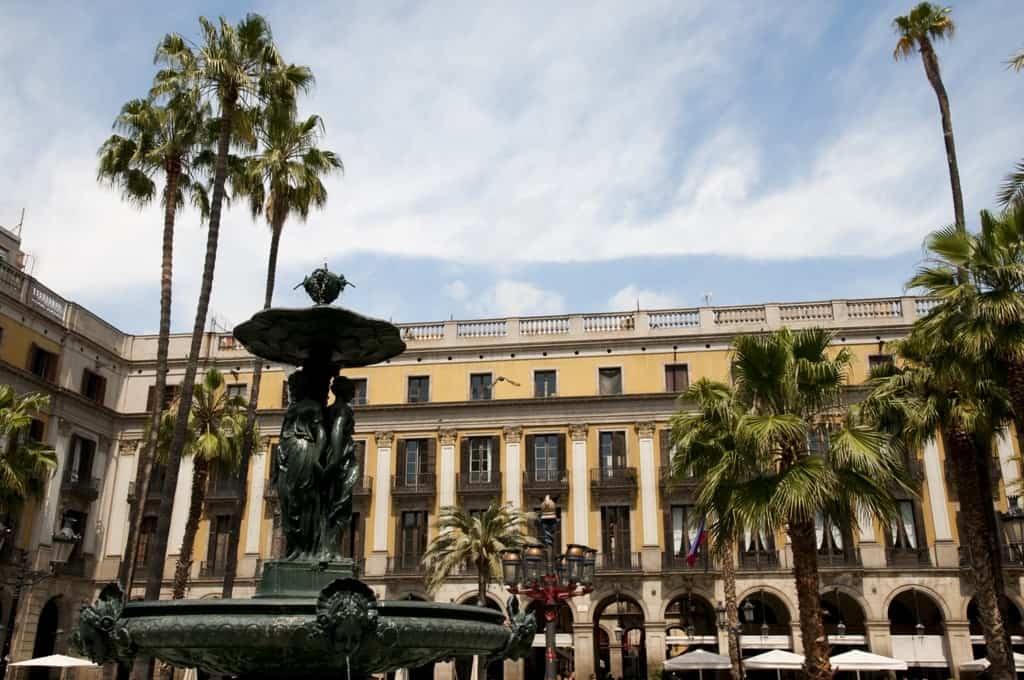
Just off La Rambla, Placa Reial is a square that is known to be filled with bars, clubs, restaurants, and all sorts of performances, people, and life. Jazzy tunes echo from the bars and twirl around Gaudi-made lamps, and cafes and restaurants keep the place booming with life. Have your lunch here, grab a cold glass of beer, and enjoy the live performers!
El Palau de la Música Catalana
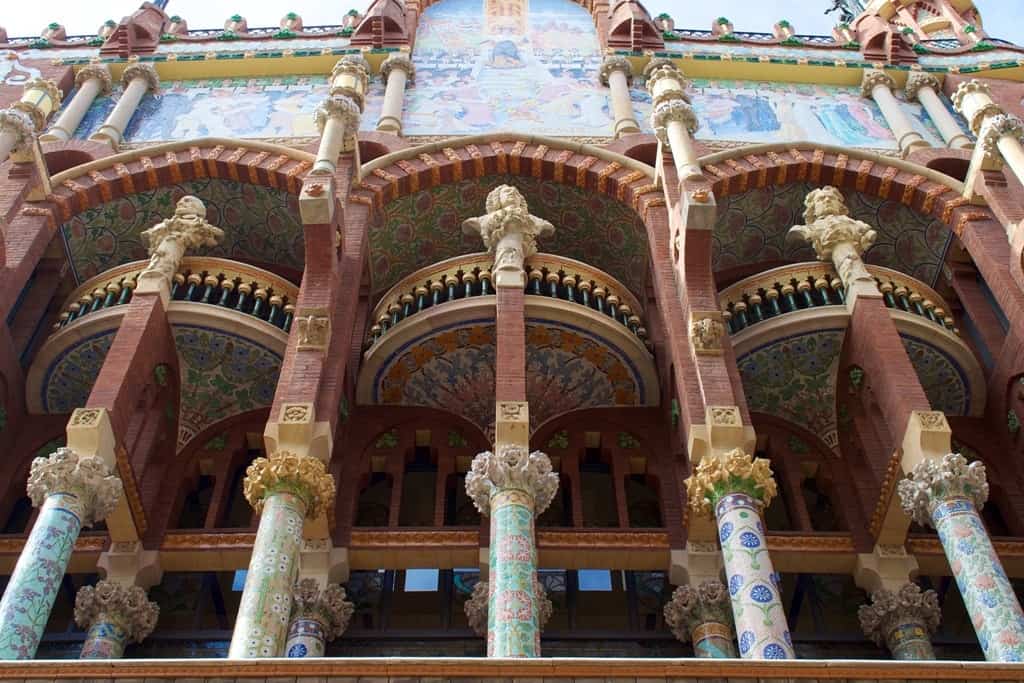
El Palau de la MusicaCatalana is only a 12-minute walk from Placa Reial. This is one of the most important concert halls in the world and an incredible reflection of Catalan art. Bright colors, intricate mosaics and a chance for you to watch a show as well!
Click here to book your Palau de la Música Self Guided Tour.
Day 3 Barcelona
Start very early in the morning and go to Park Guell and then Museo Picasso so you can have time to go to the beach later!
Offering the most incredible panoramic vistas of Barcelona and the beach, Park Guell is one of the most well-known attractions in the world. Quirky designs, colorful mosaics, great architecture, and dozens of columns with little poems on them.
Click here to buy your skip-the-line tickets to Park Güell.
Museo Picasso
An incredible look into the life of Picasso, and how Barcelona has been a major inspiration to him and his art you’ll even get to enjoy the scenic Gothic building in the museum is situated into. Hundreds of works of art by Picasso will give you that artistic fix you need!
If you are a fan of Picasso you can check the Picasso Walking Tour & Picasso Museum of Barcelona.
Head to the beach – La Barceloneta
It should be afternoon by then – the perfect time to take a stroll by the beach. Hundreds of people in swimsuits, swishing around in rollerblades and skateboards, and dozens of beach bars filled with life, clubs, bars, volleyball, and all sorts of activities are only a glimpse of what you get by being on the beach. Enjoy a cold mojito on the beach, let the sun warm up your soul, and have lunch at one of the many cafes there.
Plaza de España
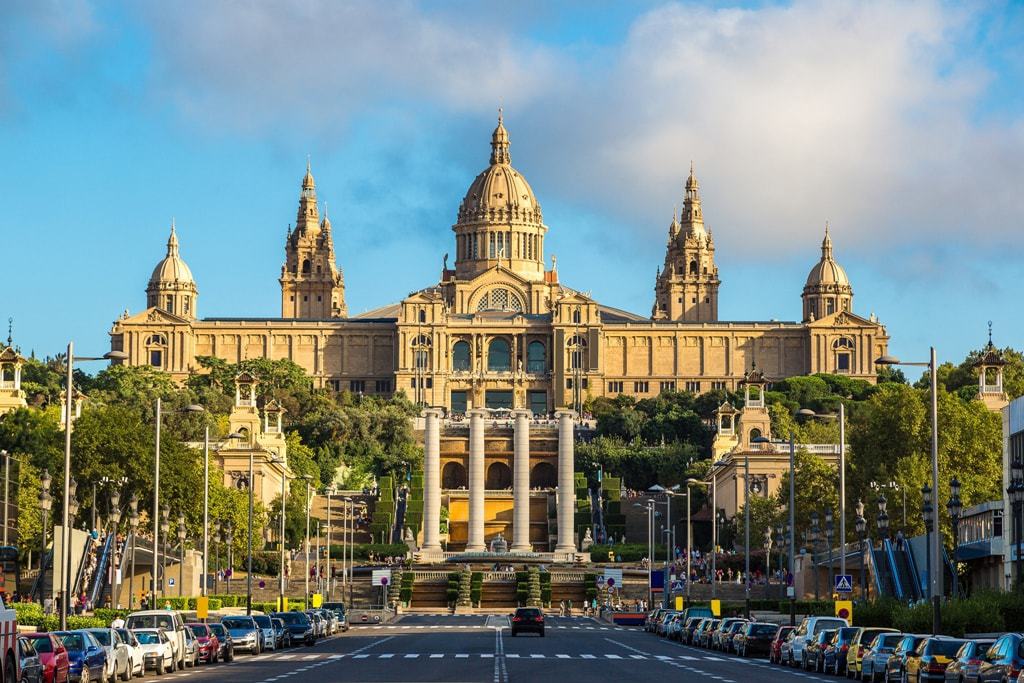
Try to go to Plaza de España before the sun sets and visit MNAC – the Museum of National Art of Catalunya. If you don’t want really to go through the gallery, then this palace is enough to put you in awe. Gorgeous fountains dance around the classical façade of the MNAC, the Montjuic mountains rise beautifully in the distance, and the views you get of Barcelona are absolutely unparalleled.
You might also like: How to spend 2 days in Barcelona .
Madrid Go City Pass
A good way to save time and money is to invest in a Madrid Pass . With the pass, you can save up to 50% on the top Madrid attractions.
The Madrid Pass is all-inclusive and provides access to popular attractions, like:
- Prado Museum guided tour
- Bernabeu Stadium Tour
- Madrid Royal Palace tour
- Madrid hop-on hop-off bus tour
- Museo Nacional Thyssen-Bornemisza
- Reina Sofía Museum guided tour
- Toledo and Segovia full-day tour
Click here for more information and to book your Madrid Go City Pass.
Day 4 Barcelona – Madrid
Now it’s time to take the plane or a high-speed train to Madrid. The train takes about 2 hours and 30 minutes, and the plane about 45 minutes.
Where to stay in Madrid
Here are my favorite accommodation options in Madrid.
Francisco I is located 250 m from Plaza Mayor and Puerta del Sol. It offers simple rooms with a private bathroom, TV, and free Wi-Fi. Click here for more information and to check the latest prices. Hostal Central Palace Madrid is centrally located and overlooks the Sabatini Gardens in Madrid’s Plaza de Oriente. Rooms have free Wi-Fi, toiletries, and a flat-screen TV. Breakfast is served in a nearby cafe. Click here for more information and to check the latest prices. Hotel Círculo Gran Vía, Autograph Collection by Marriott is an adults-only hotel located in Gran Via just 400 m away from Puerta del Sol. It offers stylish rooms with air-conditioning, flat-screen TV and coffee facilities, bathrobes, and toiletries. Other hotel amenities include a restaurant, bar, and business facilities. Click here for more information and to check the latest prices
First, settle in your hotel and then embark on your journey around Madrid in 2 days !
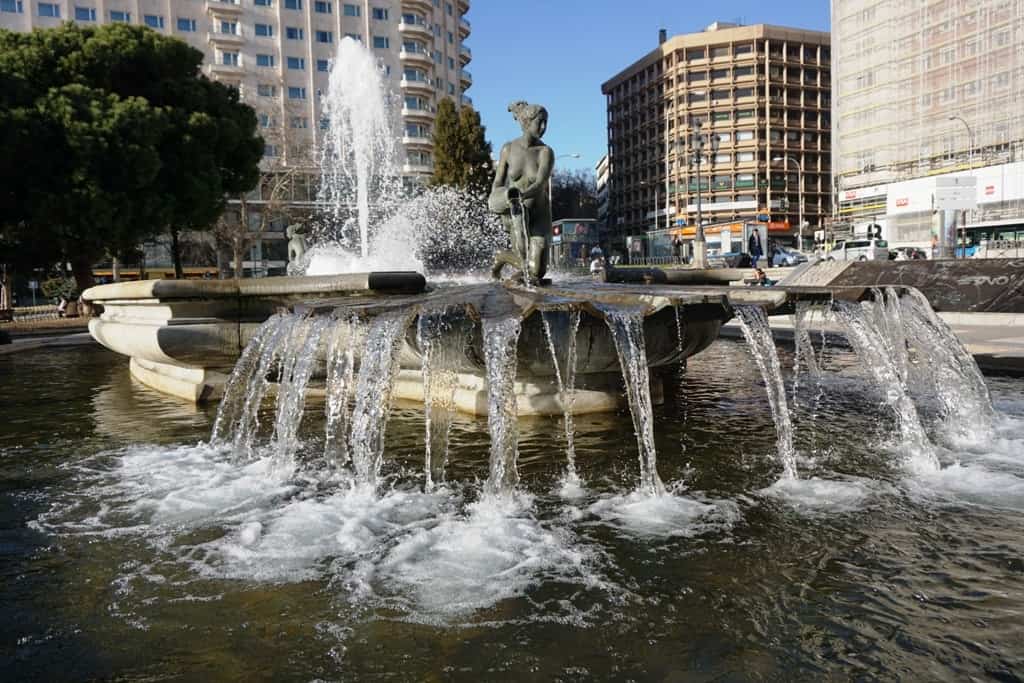
This is where you should start your day in Madrid. A place that has been there since the 18th century, you’ll get to start your trip by watching the large monument dedicated to Miguel de Cervantes, and then the stone sculpture of Cervantes – two of the most prominent Spanish people to date.
The Gran Via is the Times Square of Madrid. Art Deco façades blend with large moving billboards, elegance juxtaposes with cobbled alleyways, and of course – an endless of cafes and shops dot the street. This is your shopping hot stop – sales, hundreds of shops, and a great variety of both international and local brands.
Palacio Real
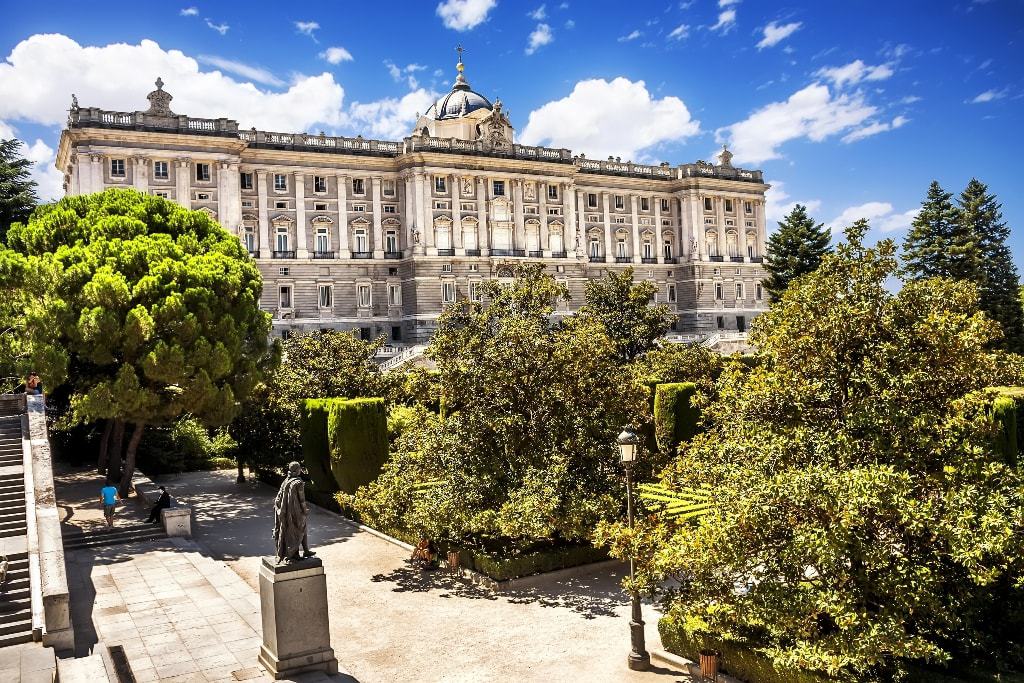
One of the most elegant and biggest palaces in Western Europe, this palace made of stone is a symbol of Madrid. Iconically perched on top, the palace overlooks the hills that are to the west of Madrid and embodies the true meaning of royalty. You’ll be exploring over 3,418 rooms (not in the same go of course!), be led by vast staircases, and explore different halls (Hall of Columns, Hall of Mirrors, and even King Charles’s room!).
Click here to book your skip-the-line tickets and tour of Madrid’s Royal Palace.
Plaza Oriente
You now get to walk to the park next to the Palacaio Real – the Plaza Oriente. An exotic park that is lined by plants, trees, and 44 statues of previous Spanish monarchs that start from the Gothic period.
Mercado San Miguel
A trip to Madrid would not be complete without the Mercado San Miguel, where you’ll be taking a journey the gastronomic vibe of Spain, and the culinary culture there. Enjoy dozens of different stalls of food – from tapas to sushi to sugary snacks. End your night with a sparkling glass of champagne!
Plaza Mayor
An old historical rectangular square that is right in the middle of the city – Plaza Mayor is perfect for enjoying the Spanish gathering culture, where people enjoy good food, good beer and live performers by sunset.
Puerta del Sol
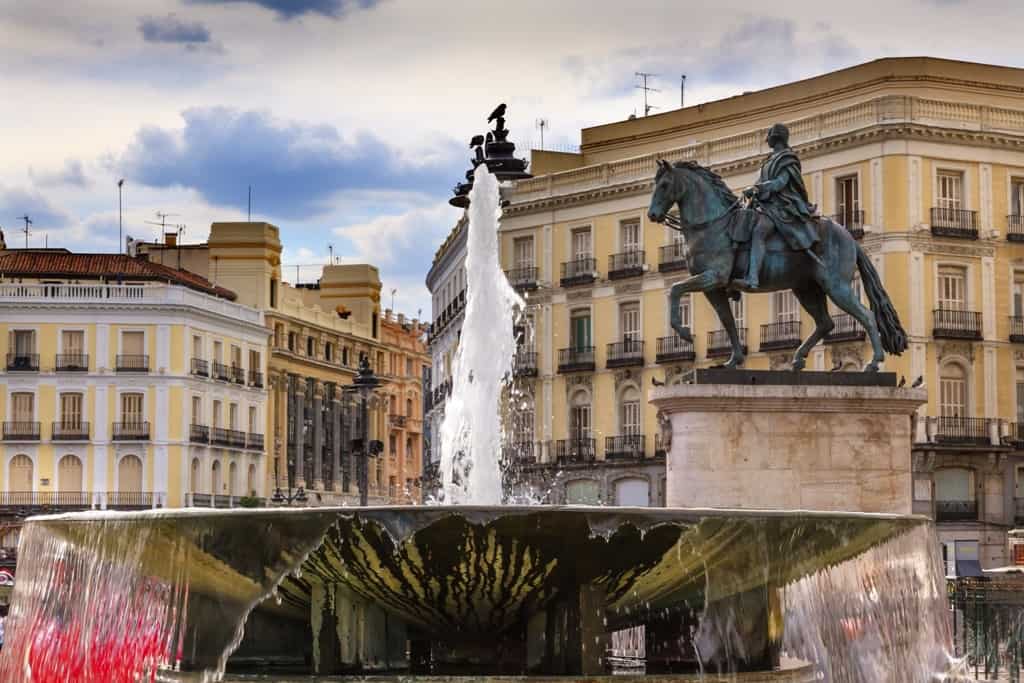
A great place to spend an afternoon or an evening – this place is the perfect way to check out shops, bars, restaurants and nearby parks. Whether you want to take a picture of the country’s kilometer 0, or enjoy the quintessential Casa de Correos or El Oso y El Madroño, you’ll be able to do both there!
Chocolateria San Gines

If you’re in Puerta del Sol, then you have to pass by Chocolateria San Gines. A churros place that looks the same since 1894 (yes, you heard that right!)and is open for 24 hours a day. Perfect for either a quick snack after a night out, or just a break from exploring…Who would say no to a rich and smooth chocolate that you can dip your churros in?
Day 5 Madrid
Retiro park.
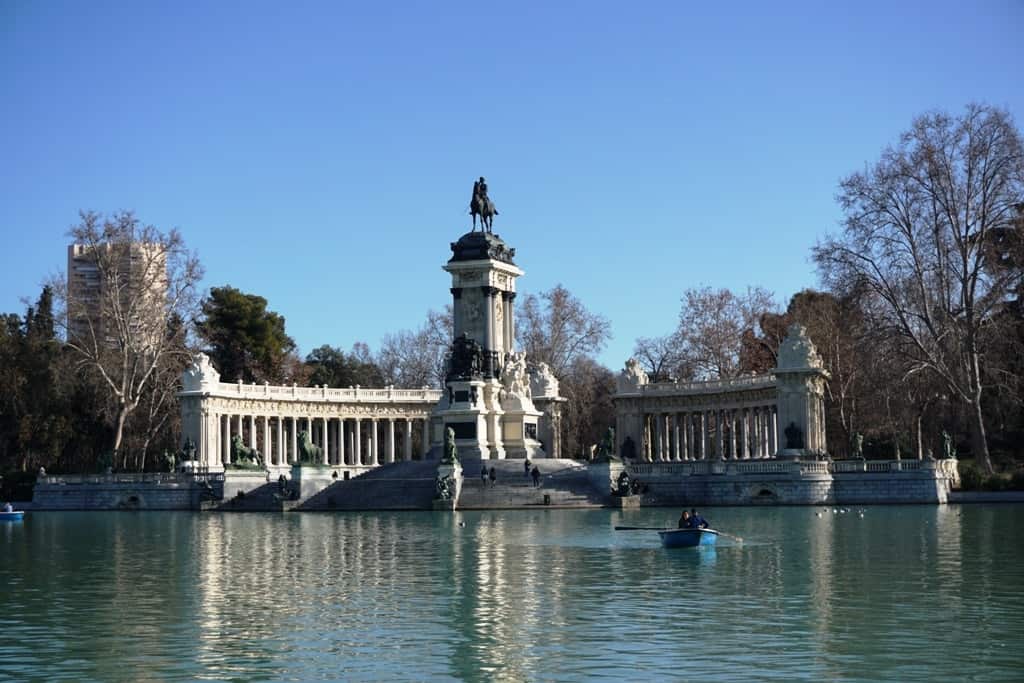
Retiro Park is the breathing lungs of Madrid, once a royal park, El Retiro now houses exhibition halls, gardens, and palaces. After soaking in the sun and the abundant greenery, make sure to visit these places:
- Velazques Palace
- Crystal Palace
- Monument to Alfonoso XII
- Walk of Argentina or the Walk of Statues
- Jardines de Cecilio Rodriguez: an enclosed garden with a lot of peacocks.
- Palacio Cristal
There are many museums in Madrid. I don’t think you will have time to visit all, but you can choose one or two depending on your taste. My favorite is Prado.
Reina Sofia
One of the most important museums in Madrid, the Reina Sofia is a great place to get a taste of Spanish contemporary art and get your dose of art and culture. From Dali to Miro to Juan Garis – there are over 20,000 works of art that it will be impossible for you to finish in just a day. You have to choose which floor you want to explore or which sort of artwork you want to get into.
Book a Reina Sofia Museum Tour.
Museo Thyssen-Bornemisza
The breadth of the collection is unparalleled as well. 1000 paintings that range from the 13th century up until the 20th century. You have to explore Museo Thyssen from the top floor and work your way downwards. You’ll find medieval art, Italian, German, and Flemish works by Monet, Picasso, Juan Gris, and much more.
Book your Museo Thyssen- Bornemisza tickets.
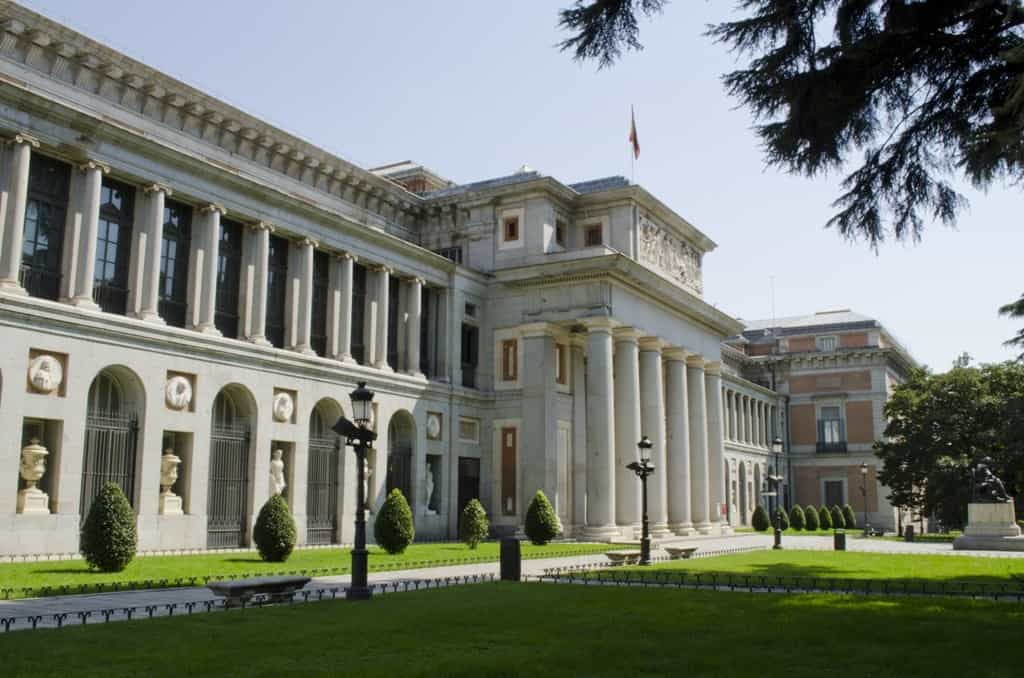
El Prado is easily the most famous museum in Madrid, hence why you save the best for last! 8600 paintings dot the place that ranges from 18th-century neo-classical sculptures to some of the most famous paintings in Europe including Las Meninas and the Triumph of Bacchus by Velazquez, the Naked Maja by Goya, the Garden of Delights by Bosch.
Click here to book your skip-the-line tickets or guided tour.
Now if you are a football fan, definitely visit:
El Bernabeu Stadium
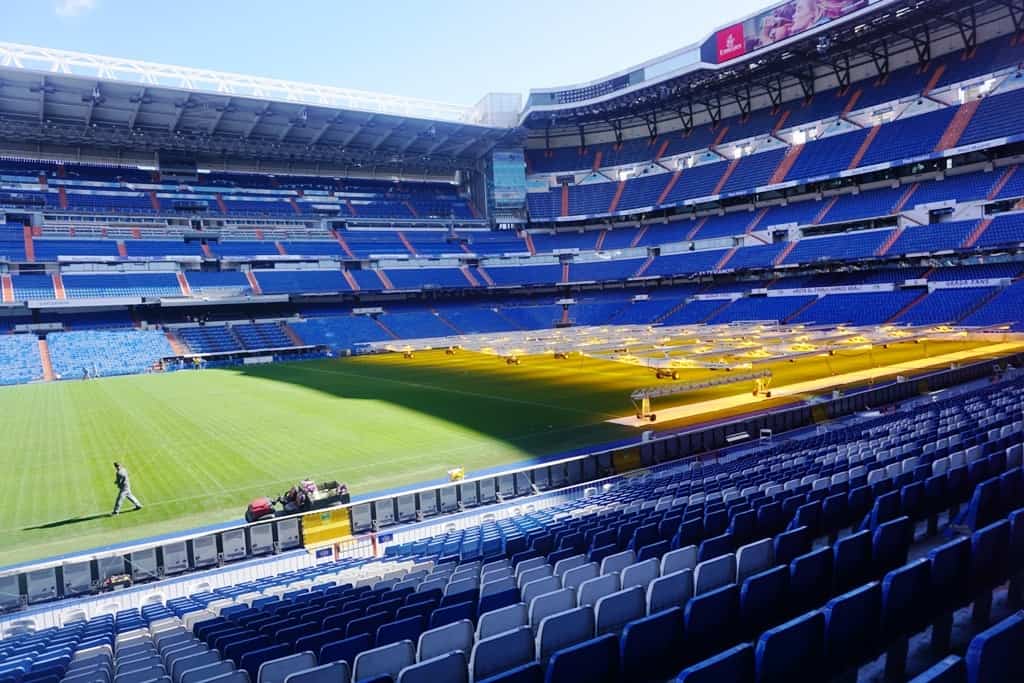
One of the world’s most elite stadiums is Bernabeu, a UEFA-classified stadium that is essential to every football fan in the world. From touring around the presidential box to getting panoramic views of the whole stadium – if you’re a football fan you’ll find this a treat!
Book here your skip-the-line tickets and tour to Bernabeu .
You might be interested in: 3 days in Madrid .
Day 6 Day trip to Toledo
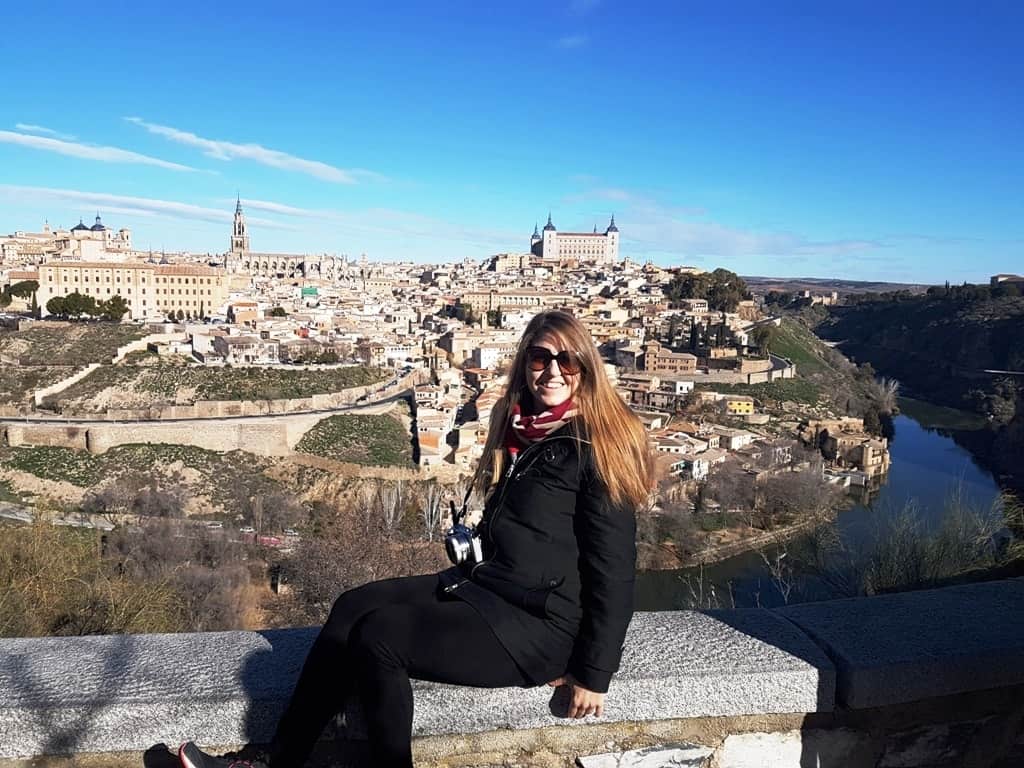
Take the train from Madrid to Toledo, which will take you about 33 minutes!
Alternatively, you can book a guided day trip from Madrid.
Toledo Full-Day Tour from Madrid. Toledo & Segovia Tour from Madrid with Alcázar Ticket
Here are some of the things you can do while you’re there:
The city of three cultures: Christian, Muslim, and Jewish, Toledo is a magnificent city that effortlessly blends mosques with gothic cathedrals; canvases of el Greco contrast the city’s glory and the city oozes in picturesque charm.
The Toledo Cathedral
The Toledo Cathedral is an incredible place in Spain and is one of the three 13th-century High Gothic cathedrals in Spain and is considered to be the epitome and personification of Gothic architecture and culture in Spain. You can check out the Chapter House, Choir, Treasury, and Sacristy. The cathedral took 286 years to build, and it towers 100 meters into the sky, creating a backdrop to the Plaza del Ayuntamiento.
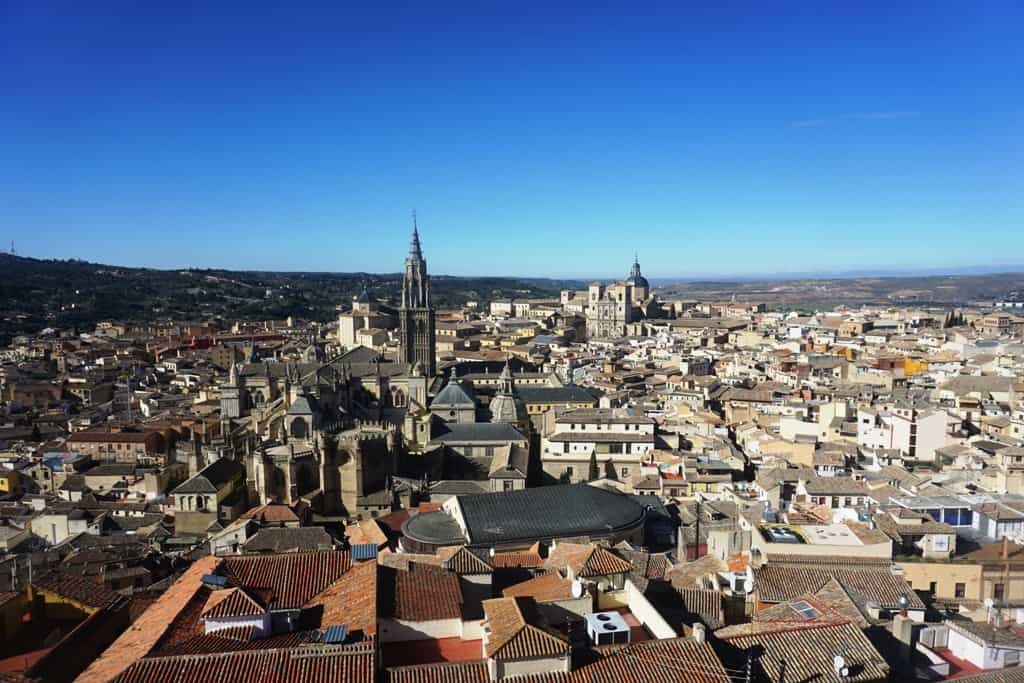
Once a stone fortification, Alcazar de Toledo is located at the highest point of Toledo. A roman palace that has been renovated multiple times – this place contains such an immense amount of history you will love the overload of it all.
You’ll find displays of uniforms, medals, military artifacts and a mixture of Islamic and Christian architecture and monuments blending together. You’ll even see the central patio, Moscardo’s office with bullet holes, and a lot more!
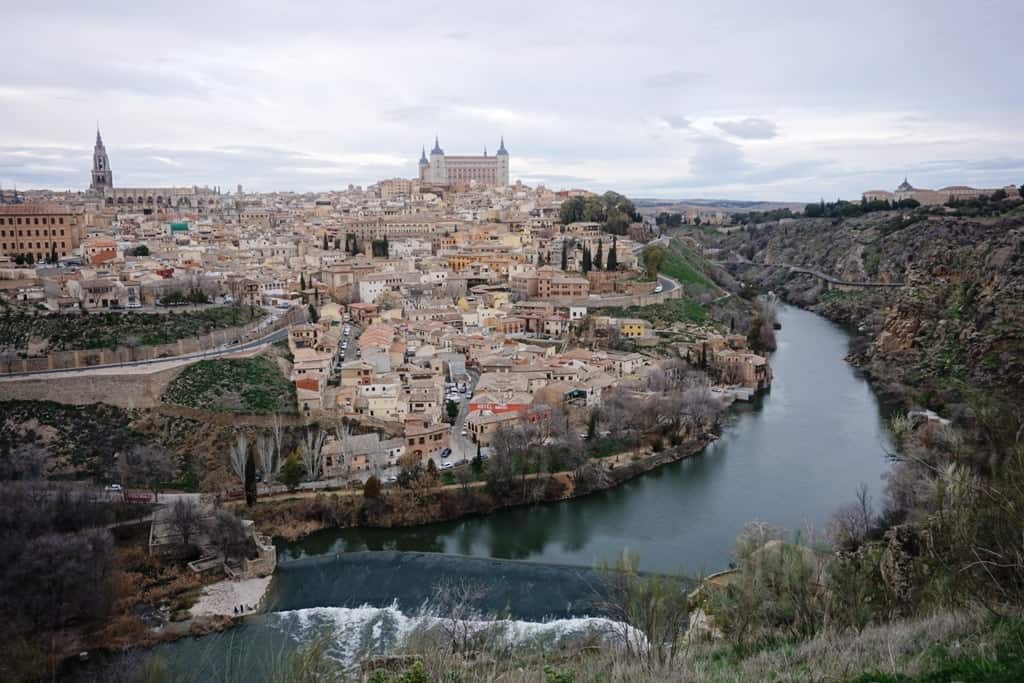
Museum of El Greco
A museum that contains all sorts of paintings by artists from the Spanish Golden Age, the Museum of el Greco is not only rich with artifacts, but it is also housed in a gorgeous Gothic house with a courtyard. You’ll find, of course, works by El Greco himself, along with a dozen other painters. This is how you get to explore the era of the 16th and 17th centuries with its furniture, ceramics, and travesties.
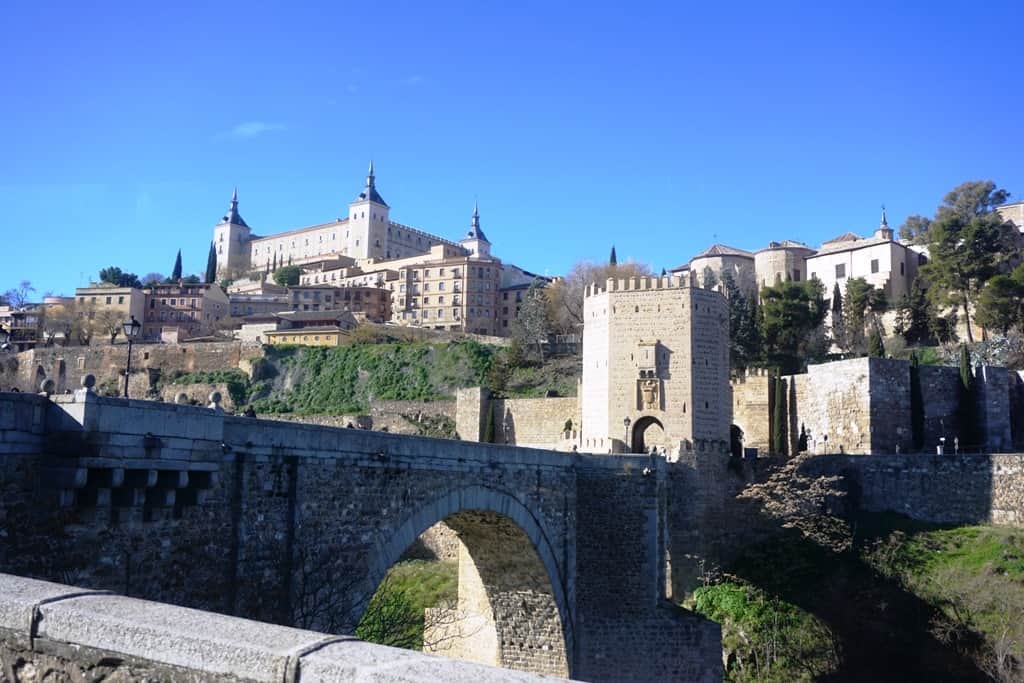
Day 7 Madrid – Seville
You can either fly to Seville (1 hour) or take the train (2 h 20 minutes). Seville, home to flashy flamenco skirts, dancers, tapas, and a fiery passion unlike any other – Seville is so quintessentially Spanish. No other place in the world embodies the Spanish culture, as well as Seville, does. The perfect place to truly enjoy some good old Spanish authenticity.
Where to stay in Seville
Hostal Plaza Santa Cruz For the easy-going traveler, this is the perfect place to be in. free luggage storage, free Wi-Fi, a guest-house feel, and access to rooftop terraces all the time – this place is the definition of cozy. Click here for more information and to check the latest prices. Hotel Fernando : Located right in Seville’s historic center, you get the perfect mixture of hotel amenities including free WiFi and modern rooms, along with your perfect dose of history. The hotel also has a rooftop terrace that offers incredible city views, a swimming pool for those hot summer days, and rooms with balconies! Click here for more information and to check the latest prices. Hotel Alfonso XIII Outdoor swimming pool, a gym, garden fountains, and beautiful elegant rooms that boast Arabic designs, this hotel is the personification of Seville’s heart and soul. Click here for more information and to check the latest prices.
Plaza de Espana
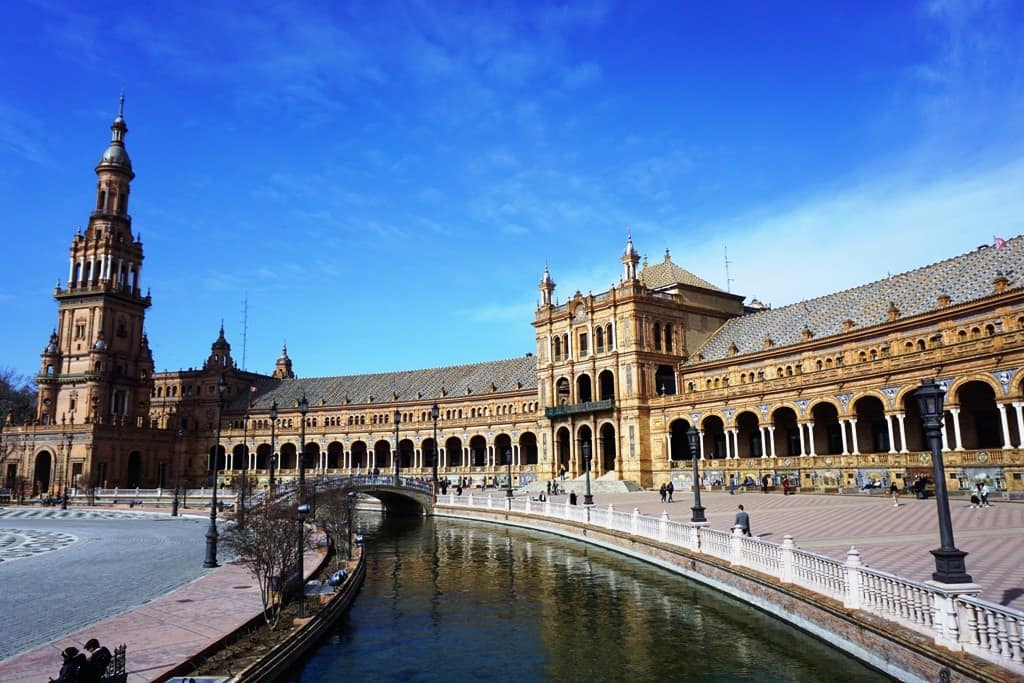
Built in 1929, this plaza is home to some of Spain’s biggest accomplishments when it comes to architecture and when it comes to boasting the accomplishments of the industry.
The plaza is a quintessential Spanish paradise with orange bridges, artifacts that reminisce over kings that long died, 48 pavilions that decorate the beauty of the place, and archeology museums that steal the show.
Cathedral of Seville
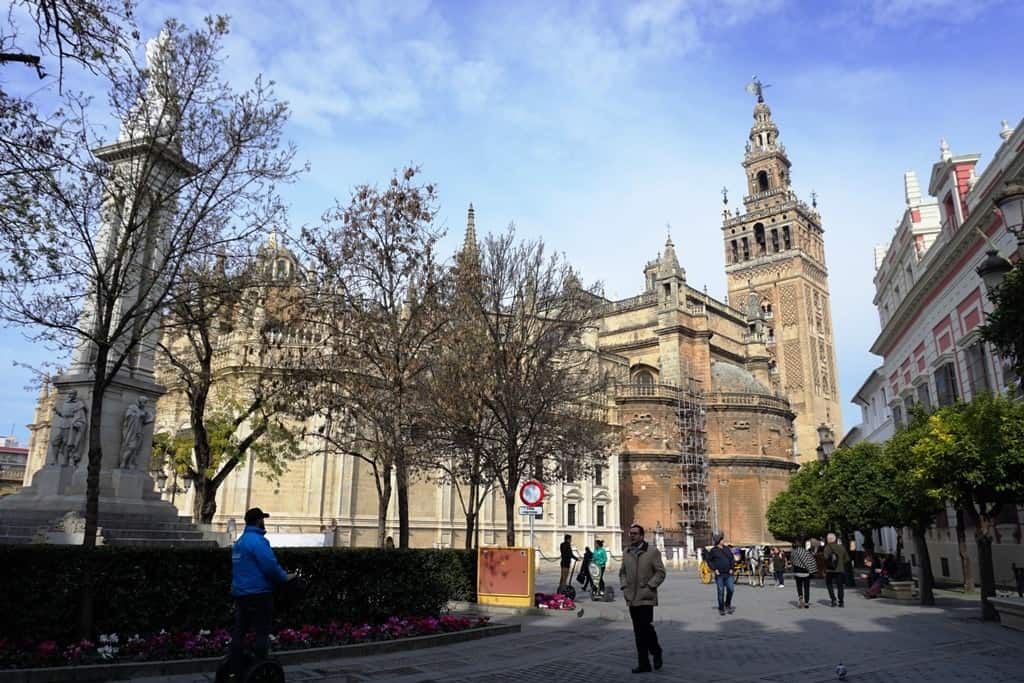
The Cathedral of Seville is a gothic church that was actually once a mosque and was transformed into a church. You’ll find all the evident Moorish influences with their sculptures, artifacts and paintings, and fountains but you’ll also find all the signs of a church, making it an otherworldly, eccentric, yet beautiful mixture unseen anywhere else.
The Giralda Bell Tower
The Giralda Bell Tower is what’s left of the Moorish Seville cathedral. A beautiful entrance that’s decorated with an ornate fountain, you’ll find that the cathedral is a great religious monument mixing both religions together. Renaissance influences blend beautifully with Moorish splendor.
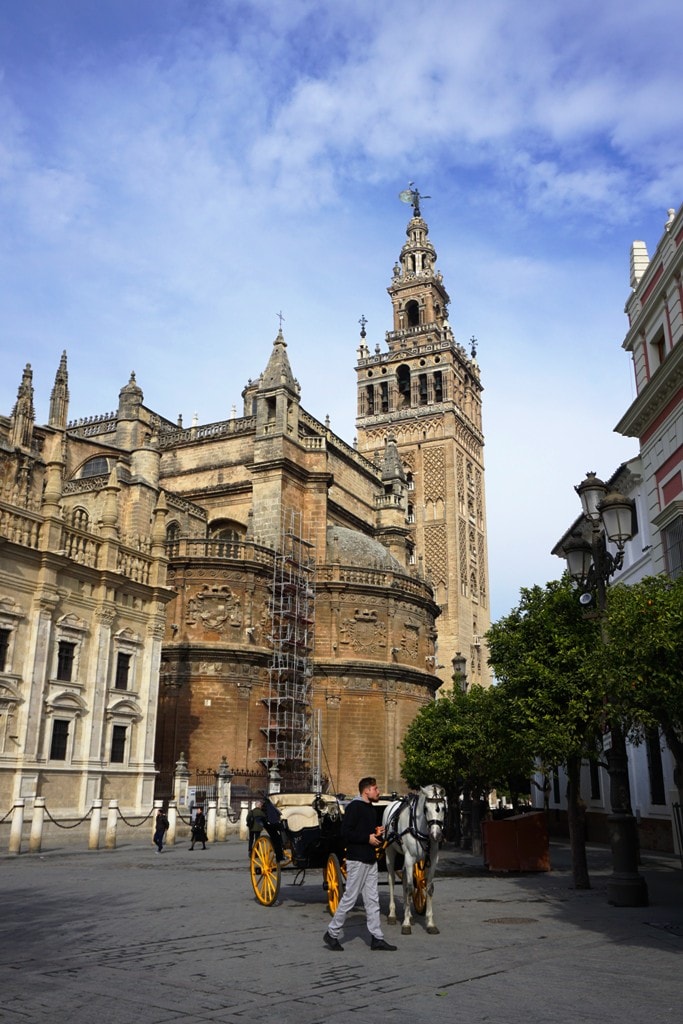
The Alcazar is one of the most beautiful royal palaces in all of Spain – an iconic monument that shows the effects of the historical evolution of the city of Seville and of Spain in general. It was developed by Moorish Muslim Kings and the Mudejar architecture is at its most intricate everywhere in the palace. This is actually one of the most visited complexes in the world, a place where culture and educational activities both blend together to put you in awe!
Tip: The lines are huge to enter the Alcazar, I had friends who didn’t even get in after waiting for hours, so book your tickets and tour in advance.
Check here for more information and to book your guided tour to the Alcázar. If you are interested in a guided tour that includes the Alcázar, the Seville Cathedral, and La Giralda I recommend a guided tour of the Alcázar, Seville Cathedral, and La Giralda.
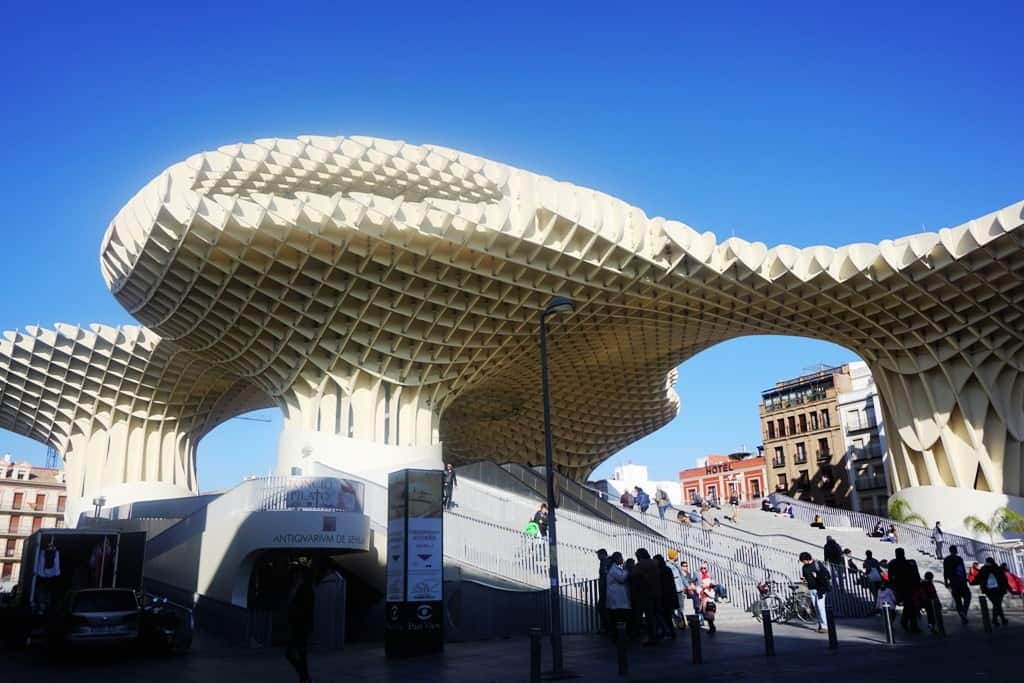
Setas directly translate to mushrooms and lie in the center of Seville. This is one of the biggest wooden structures in the world and has a museum, a marketplace, and even a public park. You have to watch the sunset from there, where you’ll get to enjoy some of the best views of Seville from up there.
Torre del Orro
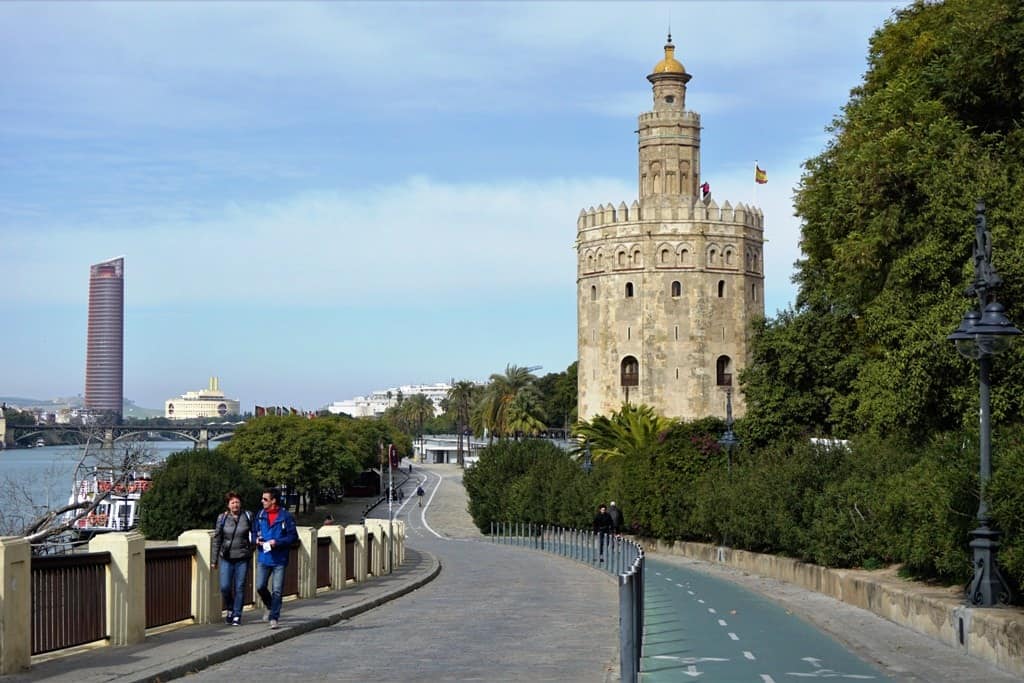
This military watchtower is right in the heart of Seville as well. Back then, it was supposed to protect Seville from Christian attacks. Built in the early 13th century, it remains one of the most important monuments in Seville up to this day.
If you have time, you can cross the river and stroll in the Trianna neighborhood. A great place to watch a flamenco show.
Trianna neighborhood
The Trianna is an emblematic neighborhood in Seville, beautifully typically Spanish, and is definitely one of the best places to eat, drink and shop! You’ll get to eat tapas like a local, watch some good old flamenco, and even visit the Museum of Tolerance r the ruins of the San Jorge Castle. It’s actually known as the “independent Republic of Triana.”
Attend a flamenco show.
It would be a waste of time if you went to Seville without enjoying some of its amazing flamenco, so better head to a flamenco bar and enjoy the melancholic yet energetic form of dance and culture!
Book your tickets for the Pura Esencia Flamenco Show in Triana.
You might also want to read: How to spend one day in Seville and how to spend 2 days in Seville.
Day 8 Seville – Granada
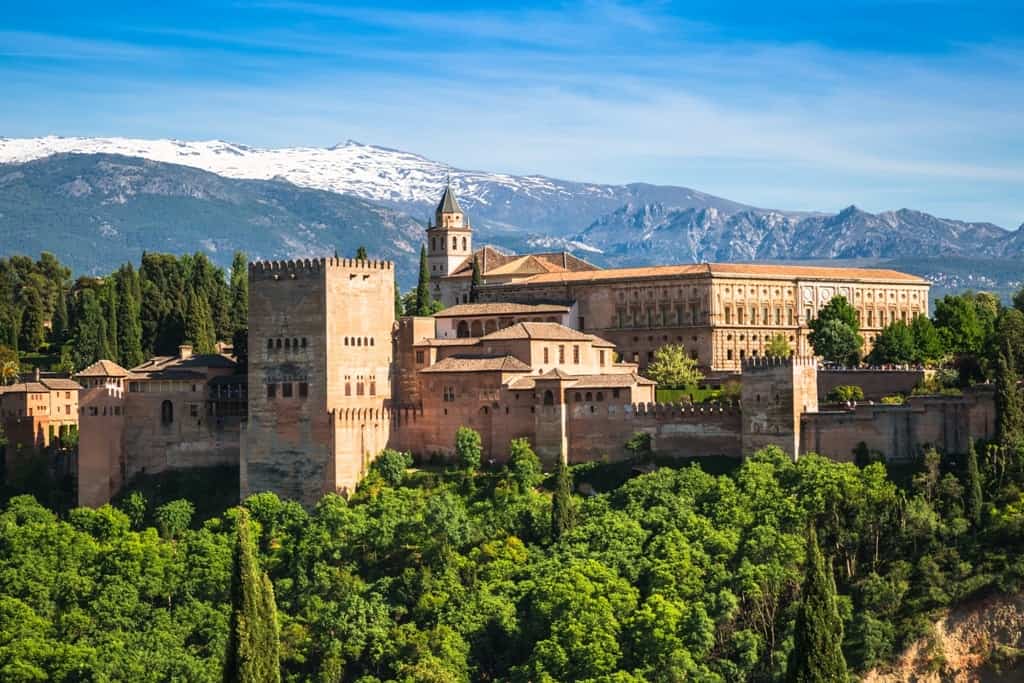
Take a train from Seville to Granada, which will take you about 4 hours, and then find some time to settle down at your hotel. You have two days in Granada, so you don’t need to be in a rush!
Where to stay in Granada
Gar Anat Hotel Boutique It is a cozy hotel that gives off a vibe of Granada’s architectural spirit but also has calm, cool, and beautiful rooms with a Granada-styled courtyard for your morning cup of coffee. The hotel is also 5 minutes away from Granada Cathedral. Click here for more information and to check the latest prices. Hotel Granada Center One of the most renowned hotels in Granada, the Hotel Granada Center is only 10 minutes away from the old town and has free Wi-Fi, great rooms, and an a la carte restaurant. You’ll also be 10 minutes from the Granada Cathedral! Click here for more information and to check the latest prices. Alhambra Palace This hotel has a location unlike any other. You’ll be enjoying the Moorish-inspired décor in the hotel while being minutes away from the massive walls of the Alhambra Palace. Mediterranean cuisine, a terrace with a garden and panoramic views, and the perfect reflection of Moorish architecture and Arab designs. Click here for more information and to check the latest prices.
Granada Cathedral
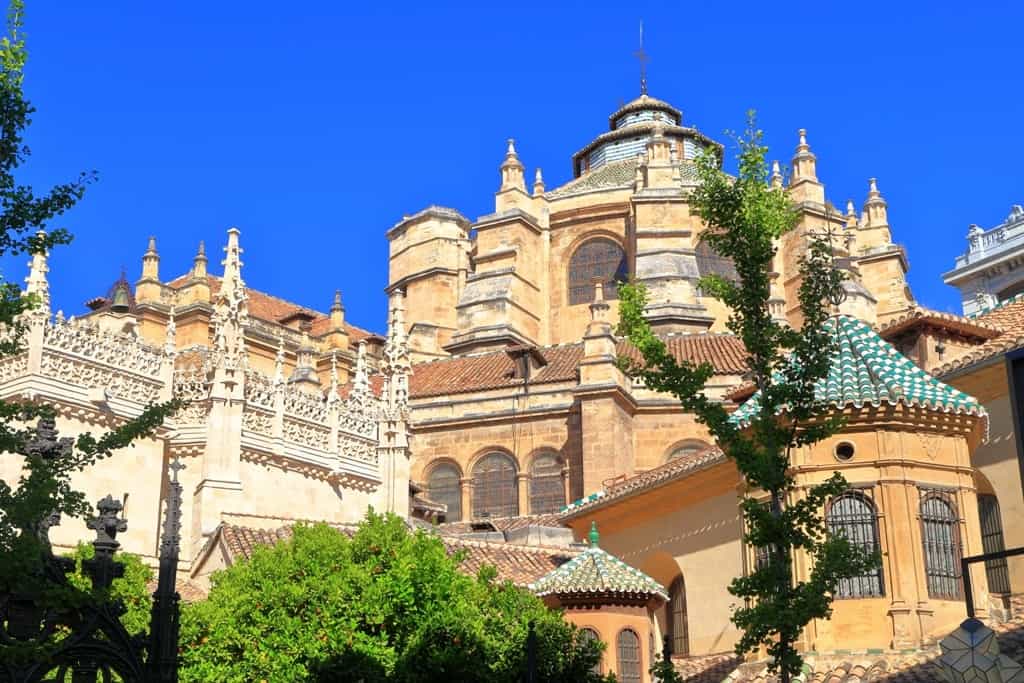
This is simply the fourth largest Cathedral in the world, an incredible personalization of the true meaning of Spanish Renaissance architecture and mixing with Gothic styles. This cathedral was built in 1523 and was actually the place of a previous mosque.
Royal Chapel
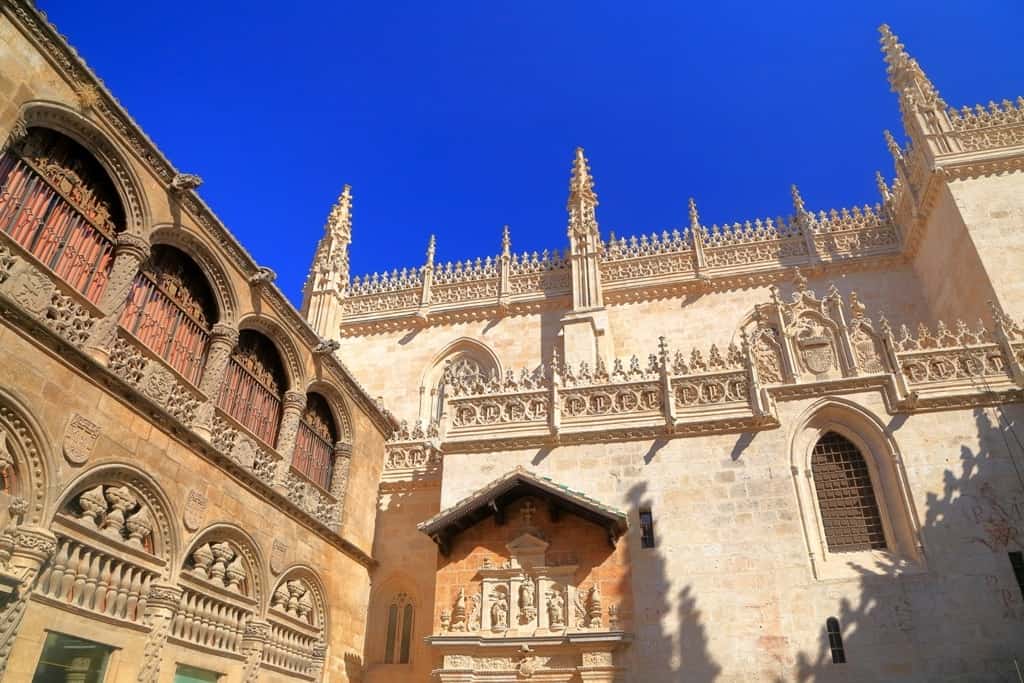
The Isabelline-style building contains the tombs of the monarchs: Isabel, Ferdinand and Juana, and Felipe. Intricate designs, gold altarpieces, and beautiful interiors all make the Royal Chapel a quintessential piece of Granada’s architecture.
Albayzin Neighborhood
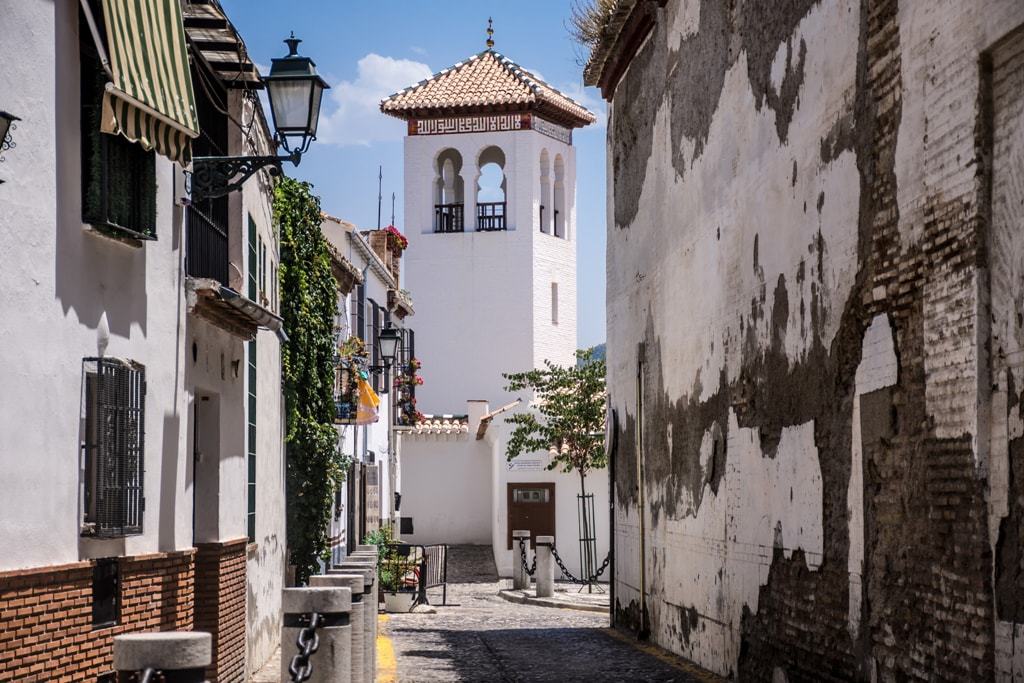
Head over to the Albayzin neighborhood after you’re done exploring the church and the chapel. Get ready to be transported to one of the most typically Arab souqs in the world – one where the smell of Arab spices seeps through the thousands of clashing colors, and where you can have little strolls around spice shops, have the ultimate Arab experiences, watch traditional houses and get the typical smell of Arabian coffee.
Day 9 Granada
The alhambra.
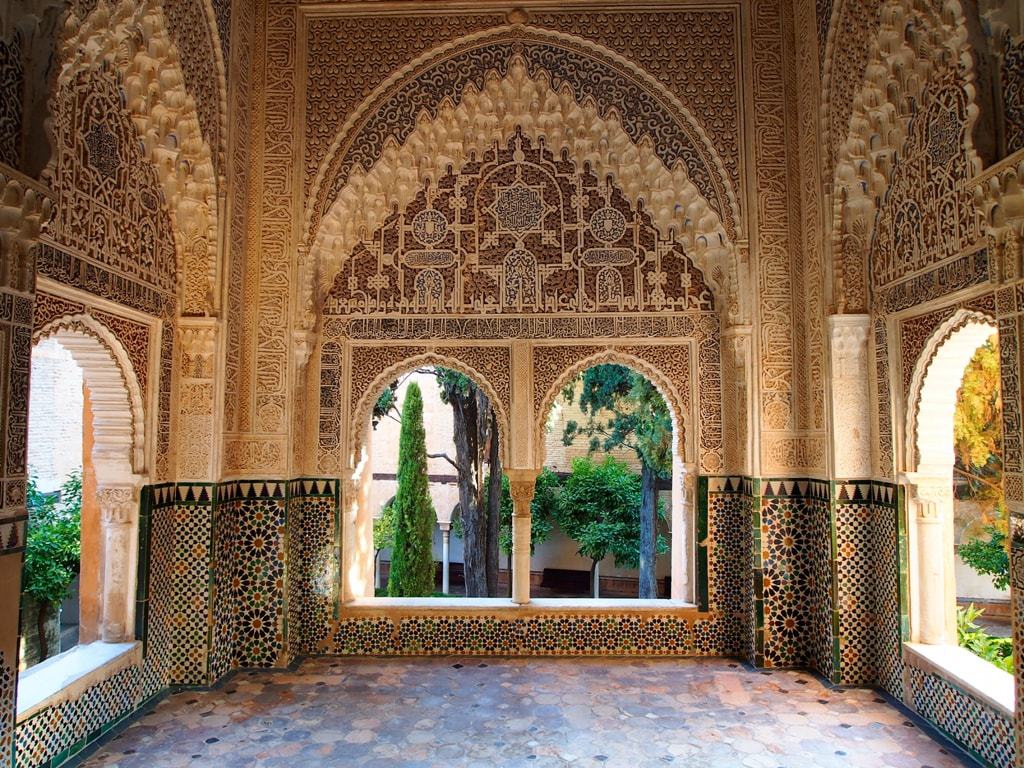
A 700-year-old fortress, an icon of Spain, an icon of Islam and Christianity, and even of Europe – the Alhambra is one of the most magnificently striking monuments you will get to see in the world. Majestically standing over the city with the snow-peaked Sierra Nevada in the backdrop, the Alhambra is iconic in every way.
From the lush landscapes and the rustling leaves, there is no Muslim palace as old as the Alhambra, and you even get to indulge in the major history lesson you’ll get just by being there. The palace was built in the 13th century, ruled by Nasrid Dynasty for 250 years, and then taken over later on.
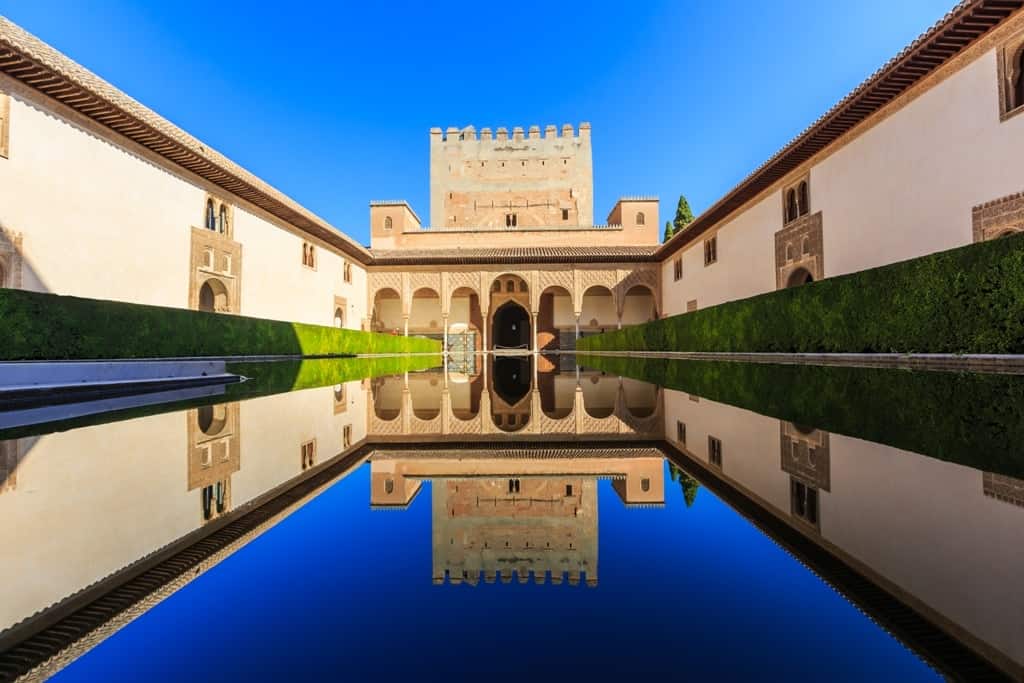
You have to check out:
- The Alcazaba (the oldest part of the fortress)
- The Courtyard of the Lions
- The Nasrid Palaces
- The Sala de los Anencerrajes
- Sala de los Reyes
- Museo de Bellas Artes
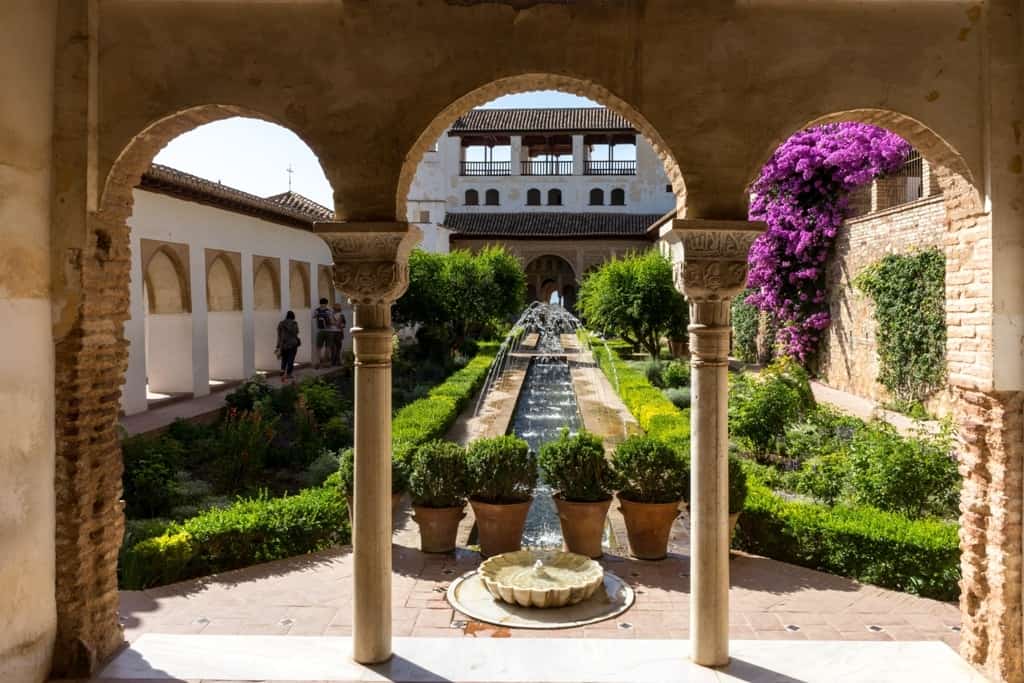
The Quran very accurately describes what heaven would look like, and it’s a major part of the Islamic religion for all Muslims. That’s why the Palacio de Generalife was modeled according to the depiction and description of paradise in the afterlife. The place is teeming with terraces, grottoes, flowerbeds, and fountains and is blessed with the backdrop of the Alhambra behind it.
Tip: The lines are usually big; to save time and get to see the Alhambra book your tickets and tour in advance.
Book your Skip-the-Line Alhambra & Generalife 3-Hour Guided Tour
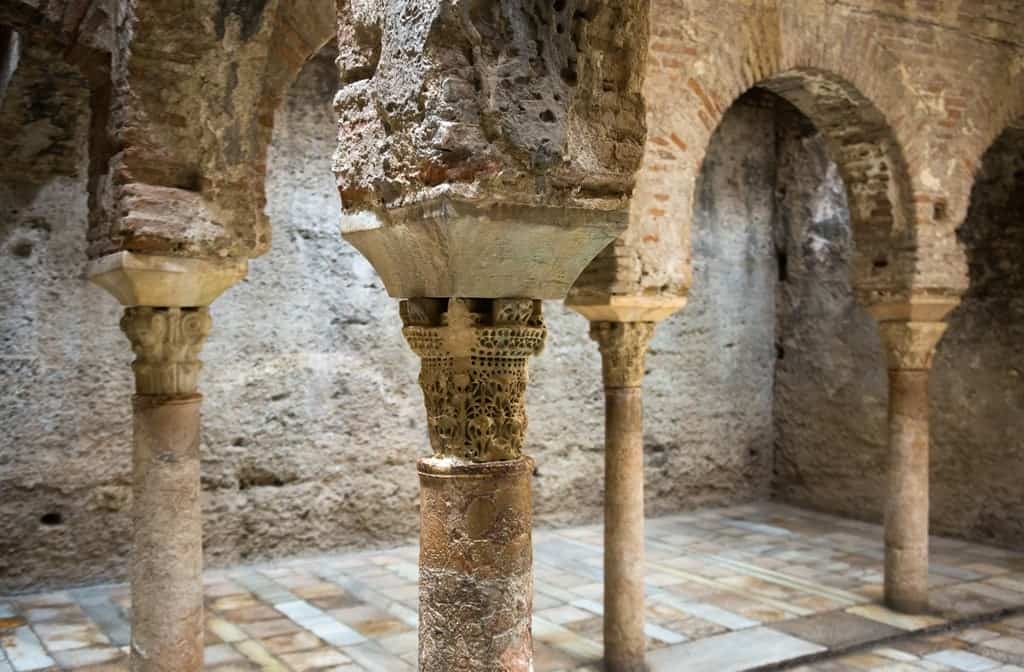
The Bañuelos was a major part of the Muslim community. That was where locals used to go hang out; people got haircuts, and women got a chance to actually get outside of the house. You can see the 11th-century Arab baths and also visit the three different rooms:
Plaza Nueva
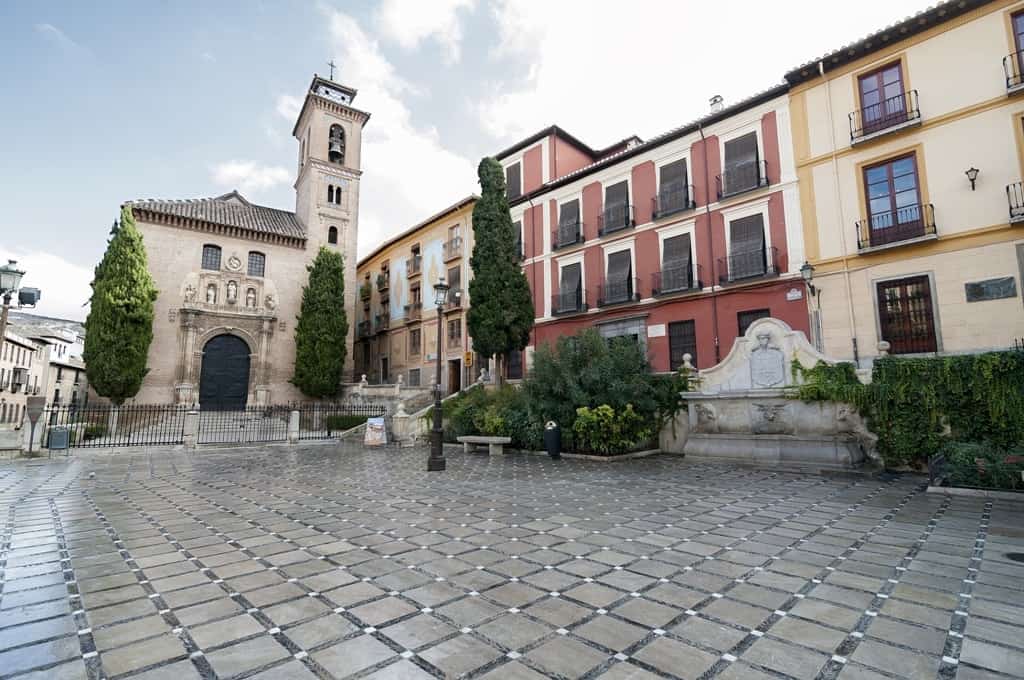
This is the oldest center in Granada and is the absolute center of the city from a touristic point of view. On one side, you have Torre de le Vela, and on the other you have Alhambra. It was formerly one of the most important parts of the cities and is now a meeting place with several fountains and cafés.
Check out: How to spend 2 days in Granada.
Day 10 Flight back home
This is the day you finally fly from Granada and Spain back to your home! I hope you enjoyed your 10 days in Spain and will come back for more.
TRAVEL TIPS
🚗 Rent your car in advance
with Rentalcars and make your trip as convenient as possible
✈️ Book your flight in advance
To find the cheapest flights and most suitable option, use WayAway
🧾 Get your tickets and tours
with Viator and get the most out of your journey
Sharing is caring!
7 thoughts on “10 Days in Spain, Itinerary for First-Timers”
Thank you soo much for sharing this post! I’m planning a trip to Spain in the fall and you gathered everything that I needed.
Happy to have helped. Don’t hesitate to contact me for further information.
I enjoyed reading your itineary. Can you please tell me how much this trip costs? Also did you book any tours or did you just go around the cities by yourself?
Thank you. The price of this trip depends on many factors, the time of year you will go, what kind of hotel you will choose etc. I usually book my tours through Get Your Guide to avoid the queues that are really big in many attractions. I moved between the cities by plane and train mostly.
This is truly helpful. I see that your day 7 is partially spent on travelling from Madrid to Seville which, as you stated, will take 2 hrs 20 mins by train and I see that day 8 is partially spent on travelling from Seville to Granada which makes me think that the time spent in Seville is less than 24 hrs if someone arrives one day and leaves the following day. Will that comfortably be enough to see majority, if not all, of the places you recommended to visit in Seville? I plan to travel with my 2 teen-aged sons. Thank you.
Hello Glenda,
Yes you can see the places I have mentioned in a day, I have done it myself. Seville is a compact city easy to walk. You just need to book your entrance to the Alcazar and Seville cathedral.
Great post on Spain! Now, I’m ready to plan another trip.
Leave a Comment Cancel reply
Save my name, email, and website in this browser for the next time I comment.
The perfect 4 days itinerary
Spain, a country on Europe's Iberian Peninsula, includes 17 autonomous regions with diverse geography and cultures. It's known for its historic cities, stunning architecture, vibrant cultural festivals, and delicious cuisine. From the art-filled streets of Barcelona to the historic heart of Madrid , the Moorish palaces of Andalusia to the rugged landscapes of the north, Spain offers a myriad of experiences for every traveler.
What to do in Spain?
This 4 days itinerary is the perfect guide to the best things to see in Spain. It includes day-by-day activities, travel tips, and the top places to visit.
Day 1: Day 1: Madrid - The Heart of Spain
Start your journey in Madrid , the capital city. Visit the Prado Museum to admire works by Spanish masters. Stroll through the Retiro Park for a peaceful morning.
Explore the Royal Palace and the Almudena Cathedral . Enjoy a traditional Spanish lunch in the Plaza Mayor .
Experience Madrid 's vibrant nightlife in the Gran Vía area, known for its theaters and shopping.
Day 2: Day 2: Barcelona - A Blend of Art and Architecture
Take a high-speed train to Barcelona . Visit the Sagrada Familia to marvel at Gaudí's masterpiece. Explore the Gothic Quarter for a glimpse into the city's medieval past.
Walk along the Passeig de Gràcia to see more of Gaudí's works, including Casa Batlló and La Pedrera . Enjoy a tapas lunch in one of the local bars.
Relax at the Barceloneta Beach or experience the city's nightlife in the El Born district.
Day 3: Day 3: Seville - The Andalusian Charm
Fly to Seville . Visit the Alcázar , a stunning example of Mudéjar architecture. Explore the Seville Cathedral and climb the Giralda for panoramic city views.
Stroll through the Maria Luisa Park and visit the Plaza de España . Enjoy Andalusian cuisine for lunch.
Experience a traditional flamenco show in the Triana district.
Day 4: Day 4: Granada - The Last Stronghold of the Moors
Drive to Granada . Visit the Alhambra , a UNESCO World Heritage site, and explore its palaces and gardens.
Wander through the Albaicín , an ancient Moorish quarter, and enjoy lunch with views of the Alhambra .
Return to Madrid or continue your journey through Spain.
Discover more Spain itineraries
Was this helpful?
- LATIN AMERICA & CARIBBEAN
- MIDDLE EAST
- US & CANADA
The Best of Spain: Ultimate 10 Day Spain Itinerary

Are you planning a trip to Spain? This popular destination has so much to see that it can be tricky to plan the perfect Spain travel itinerary for a short amount of time. The first time I visited Spain, all I knew was Barcelona and Madrid . So that’s all I visited! But after living in Spain for over two years now, I have put together this perfect Spain itinerary for ten days.

This ten day Spain itinerary of course hits the two big destinations of Barcelona and Madrid . But it also includes the arguably much more interesting destinations of Seville, Granada, and Cordoba. That way, you can return back home from Spain having seen more than just the basics!
But, I must warn you. This Spain itinerary is very detailed . Like, how-on-earth-do-you-have-time-to-write-all-this detailed. That’s on purpose. You can go to any old travel blog to get a vague “two nights in here” and “one night here,” bare-bones itinerary for Spain. But those itineraries don’t tell you what to do in each destination, or how to get from each city to city. You would have to go look that up after. But not with this itinerary.
In short, what I am trying to say is: get ready for a long article! (About a 20 minute read.) You will probably want to save this for later right now by bookmarking it or saving it on Pinterest, just in case you don’t finish all in one go. Then, sit back, kick your feet up, and let’s get to it!
The Perfect 10 Day Spain Itinerary
Let’s begin with an overview of this epic, ten day Spain itinerary, so that you can have an idea of what to expect for your trip.
What is the Best Time of Year to Visit Spain?
Spain has the reputation of eternal warmth and sunshine. It’s true Spain’s weather is quite good year round in many places. But after having lived here, I can report back that winter definitely gets chilly in many of the destinations in this ten day Spain itinerary. I can also report that summer gets unbearably hot in many of these destinations! People say that about a lot of destinations in Europe. But trust me – avoid doing this Spain itinerary in summer. Because of that, I recommend you visit Spain during the shoulder seasons of April – May and September – October . This lets you enjoy every destination in this ten day Spain itinerary in mild weather.

BUT, I do recommend avoiding the week leading up to Easter . This week, called Semana Santa, is a very big deal in the region of Andalusia (which includes Seville, Granada, and Cordoba). Streets get blocked off for daily processions that last through the night. Hours change for even the most popular of attractions. Everything shuts down except restaurants on Maundy Thursday, Good Friday, and Easter Sunday. And the cities are just very crowded overall. So unless you particularly want to see the processions (because they are quite interesting!), I recommend avoiding Easter time for this ten day Spain itinerary.
What is the Best Way to Get Around Spain?
There is a lot of debate about the best way to travel around Spain. For some parts of the country, a car is definitely ideal. But for this ten day Spain itinerary, you won’t need one. This Spain itinerary is completely car-free , relying solely on Spain’s extensive train network. You can purchase all the train journeys I mention in this itinerary in advance at the official Renfe website . You can also download their app ( Apple and Android ) so that you have all your tickets in one, convenient place.
(Finally) The Actual Ten Day Itinerary for Spain
Beforehand, I just want to let you know you can do this itinerary in the order I have it or in the exact reverse. Just look up flights and see which direction is cheaper. Also, at the very end of this page, I have a section on how to adjust this itinerary if you need to. Ready?!
Barcelona is Spain’s most-visited tourist destination , boasts unique Gaudi architecture, and is home to one of the most famous football (soccer) clubs in the world. Thus, it is an absolute must on any first-time Spain itinerary! Located towards the eastern end of Spain’s southern coast, Barcelona offers all the perks of big-city life, but in a setting of palm trees, ocean breezes, and sandy beaches . Barcelona is also the capital of Catalonia, a region which has been trying to separate from Spain since 2017 .

How to Get to Barcelona
As the starting point of your Spain trip, you will need to fly into Barcelona. Barcelona’s international airport is Josep Tarradellas Barcelona-El Prat Airport (BCN) . To get from BCN airport to the city center, you have three options.
- Option 1: Take a bus. From BCN, you can take the Aerobus to Plaça de Catalunya in the Barcelona city center. This leaves every 5 minutes during peak hours, costs €5.90 one way (€10.20 roundtrip), and takes around 30 minutes. From Plaça de Catalunya, you can either walk to your accommodation, or use the Metro to take the subway if your accommodation is further away. Be very careful of pick-pocketers in Plaça de Catalunya and on the Metro! You can find the Aerobus schedule and purchase tickets in advance at the official site . Be careful to purchase your ticket for the correct terminal (A1 for Terminal 1 and A2 for Terminal 2) if you select this option.
- Option 2: Take the train. Follow signs in the airport to the Renfe train station. (If you arrive in Terminal 1, you will need to take the free airport shuttle bus to Terminal 2 first.) From BCN, take the R2 Nord line to either the Barcelona-Sants or Passeig de Gràcia stops. This train leaves every 30 minutes, costs €4.60* one way, and takes around 25 minutes. From either of these, you can walk to your accommodation if it is nearby, or use the Metro to take the subway if your accommodation is further away. These stations are a little less central than Plaça de Catalunya. *If you select this option, consider buying the T-Causal 10-ride ticket for €11.35 instead.
- Option 3: Take a taxi. Taxis from BCN are not a fixed fare. The price ranges from €25 – €30. You can find the official yellow-and-black taxis lined up outside the arrivals terminals. The drive should take 20 to 40 minutes.
What to Do in Barcelona (Three Days)
Three days in Barcelona is the minimum amount of time to “see everything.” Take it easy on day one , since it’s the day your flight gets in. But feel free to interchange days two and three as works best for you. If you get in way too late on day one, you can tack the first three bullets onto day two and the fourth bullet onto day three.
Walking straight through this route as I have it below is 45 min (3.5km or 2.25 miles), just to give you an idea of total distance on day one.
- Plaça de Catalunya: This plaza is considered the center of Barcelona. You may find yourself here without even trying, since it’s the starting point for many tours and where many forms of transport meet. It marks the northern end of the famous La Rambla street. You should be very careful of pickpockets in this square!
- La Rambla: This wide, tree-lined pedestrian street is the most famous in Barcelona and runs right through the heart of the city. It is often referred to in the plural, “Las Ramblas,” and it marks the western edge of the Gothic Quarter. Again – be very careful of pickpockets on this extremely busy street!
- Mercat de Sant Josep de la Boquerìa: While making your way down La Rambla, be sure to stop by Barcelona’s most famous and beloved food market. It is more often simply called Marcet de la Boqueria. Here, you’ll find the quintessential €2 fruit smoothies and juices, along with other food items like jamon, empanadas, sweets, and more.
- Playa de La Barceloneta: There’s already so much to do in Barcelona, ignoring the fact that it’s on the coast. But it is indeed on the coast! I have to say, Barcelona city is not home to the best beaches in Spain. But a stop at La Barceloneta beach is still an absolute must. Even if you don’t care to walk on the sand or get in the sea, you can walk along the long promenade.
- Basilica de la Sagrada Familia: This still-under-construction church is the most famous thing to see in Barcelona. It was designed by Catalan architect Antoni Gaudí, and he is buried in the church’s crypt. He is also responsible for designing many other popular attractions in Barcelona. The Sagrada Familia is definitely his most famous work and an absolute must to visit. Be sure to purchase tickets that include both the Sagrada Família and Towers ! These come with an app audio guide and will set you back €36 per person. Definitely purchase your tickets in advance online from the official site during high season, as certain time slots do sell out.
- Parc Güell: If you’ve ever watched the Cheetah Girls 2, or had anyone on your social media study abroad in Barcelona, this is that mosaic park! This UNESCO World Heritage site is an absolute can’t-miss thing to do in Barcelona and – surprise, surprise – was designed by Antoni Gaudí. You can buy tickets, which are €10, in advance from the official site to ensure you get a time slot that works for your schedule.
- Gràcia: On your way towards the historical center from Parc Güell, wander through one of Barcelona’s most beloved neighborhoods. Gràcia is a lot calmer than the touristy parts of town, but has many less-popular Gaudí works hidden inside it.
- Casa Milà: Casa Mila is the last private residence designed by Antoni Gaudí. You can enter this UNESCO World Heritage site for €25 if you purchase tickets online from the official site , or for €3 more in person. But if you are short on time, even just admiring it from outside is better than nothing!
- Casa Batlló: Located not too far away from Casa Mila, Casa Batllo is another Antoni Gaudí masterpiece and UNESCO World Heritage site. Like Casa Mila, you can also enter. Tickets are €35 if you purchase tickets online from the official site , or for €4 more in person. Again, you can simply admire from outside if you are short on time.
- Barri Gòtic: Barcelona’s Gothic Quarter is the city’s historical center. This charming area of the city is many visitors’ favorite part of the city, due to its narrow streets and bustling atmosphere. It might be worth doing a free* walking tour of this area, depending on your group’s travel style. But whether you join a tour or wander solo, be sure to pass under the famous Pont del Bisbe while in this neighborhood! *Tips are expected at the end of these tours.
- Catedral de Barcelona: Finished in the 15th century, the Cathedral of Barcelona is worth a stop while in the Gothic Quarter. Entry is €9 and dress code (no shoulders, no knees) is enforced.
- Museu Picasso de Barcelona: Consider a stop by this museum to enjoy the work of (arguably) Spain’s most famous artist. Even if you aren’t the biggest fan of modern art, it’s fun to view his many different styles and debate works which you like best – or perhaps which works you even consider “art!” Tickets for the main collection plus temporary exhibits are €15 at the door or €14 if purchased online from the official site in advance.
- Parc de la Ciutadella: In this park, you’ll find some more iconic structures of Barcelona. These include the Arc de Triomf and the Cascada del Parc de la Ciutadella . Entry into the park is free.
Though Madrid is the capital and largest city in Spain , it is not known for as many impressive monuments as some of the other destinations in this ten day Spain itinerary. With only one week in Spain, I would actually recommend skipping Madrid. But for a ten day Spain itinerary, I really do think a quick stop in the heart of the nation is necessary! Madrid has the liveliness of a big, international city. But its tourists don’t overrun it, allowing you to feel like you are experiencing it authentically.

How to Get to Madrid
Take the high-speed AVE or AVLO Renfe train from Barcelona-Sants station to Madrid Puerta de Atocha-Almudena Grandes station . This takes between 2.5 and 3 hours. If you purchase an AVLO journey a few months in advance, it only costs €7 for the earliest AVLO train in the morning or the latest AVLO train at night! It costs €15 for the other AVLO train times. But the ticket prices increase as each fare sells out , so if you purchase on the day of, expect to pay anywhere between €40 and over €100, depending on the day of the week, time of day (more inconvenient times usually are cheaper), and the time of year (tickets sell out faster for holidays).
From within Puerta de Atocha-Almudena Grandes train station, you can take the Metro or Cercanias to get to your accommodation if necessary. Or, you can exit the station and take a taxi .
What to Do in Madrid (One and a Half Days)
As the capital of Spain, you might think Madrid would warrant more days than some of the other destinations on this ten day Spain itinerary. And while I loved living in Madrid (I could never see myself living in Barcelona!), it doesn’t boast as many tourist draws as some other cities in Spain. Between one and two days is the perfect amount of time to “see it all” and get a small flavor for the city before moving south!
I know the below will look like a lot to squeeze into just half a day in Madrid. But central Madrid is super compact ! Walking straight through this route as I have it below without stops is 50 min (3.7km or 2.3 miles), just to give you an idea of total distance you’ll be covering.
- Gran Via: Gran Via is Madrid’s most famous street. Its name translates into “Great Way,” and it boasts a host of eateries, international shops, and even Broadway hits like The Lion King. Some of Madrid’s most famous buildings line Gran Via, like the Edificio Metrópolis , the Fundación Telefónica, and the Schweppes Sign on Edificio Carrión. I recommend starting at Plaza del Callao and walking east along Gran Via until reaching the next spot on the list – Plaza de Cibeles.
- Plaza de Cibeles: Palacio Cibeles was once the headquarters for the Spanish Post Office. It is literally my favorite building in Madrid! It’s the first image of Madrid that I ever had in my head, back from when the Spanish national soccer team won the Euro Cup, then the World Cup, then the Euro Cup back-to-back-to-back. The team always passed between this building and the majestic Fuente (fountain) de Cibeles in front of it on their victory parade route. So I began to view the building as emblematic of Spain well before ever arriving! It is also where Real Madrid FC passes by during their celebration parades.
- Puerta de Alcalá: This triumphal arch was once the main entrance to the city of Madrid, putting into perspective just how much the city has grown over the centuries! It’s located right outside the most popular entrance to El Retiro Park.
- El Buen Retiro Park: This UNESCO World Heritage Site has been called “the Central Park of Madrid,” and you can understand why. Set right in the heart of Madrid, this green oasis is popular with locals and tourists alike. The most famous area of El Retiro is the artificial lake, where you should definitely rent a rowboat. I personally also love the Jardín del Parterre and would recommend either entering or exiting El Retiro park through this garden.
- Palacio de Cristal: Also in El Retiro is the Palacio de Cristal. It’s a UNESCO World Heritage Site and such a pretty building, especially from across the pond in front of it. But ironically, its history is nowhere near as pretty. The Palacio de Cristal was built as a greenhouse for plants and fauna from the Philippines, which was a colony of Spain at the time. Some sadly like to claim that was all, but it soon went on to become the site of one of Europe’s many human zoos. Igorot people were brought from the Philippines and made to live and fish in a replica village while visitors watched. To see some photographs and sketches of the human zoo, definitely check out this post .
- Museo Nacional del Prado: The Prado Museum is definitely the most famous art museum in Madrid, and probably all of Spain, too. It is home to the most extensive collection of Spanish painting in the world. Some of its most famous works include those by Murillo, Velázquez, and Goya. Tickets are €15 and can be purchased in advance online at the official site . Entry is free during the last 90 minutes (online it says the last two hours, but you must leave the building 30 minutes before close time). You should still book the free entry online to secure your time slot (they book out).
- Fuente de Neptuno: Real Madrid has the Fountain of Cibeles, and Atletico Madrid has the fountain of Neptune, located just down the road. It’s not an attraction by any means, but it’s a pretty fountain that you might as well pass by, since it’s nearby the Prado Museum.
Note on Day One : The order listed above allows you to visit the Prado during the free hours towards the end of the day. If you love paintings more than I do and want to spend several hours at the Prado Museum, consider doing this day one itinerary in the exact reverse order of how I have it above.
- Puerta del Sol: The Puerta del Sol is located smack dab in the center of Madrid. And if you’ve looked at a map, you’ll see that Madrid is located smack dab in the center of Spain! So this square is literally the center of Spain. There is even a plaque in the ground called Kilometre 0 , from which all major radial roads in Spain leave. It’s quite popular to take a picture of your feet standing at the bottom edge of the plaque! But the most famous part of Puerta del Sol is the building behind Kilometre 0 – the Casa de Correos . It is home to Madrid’s regional government, and its famous clock is part of a huge Spanish NYE tradition. Be ultra on-alert for pickpockets everywhere in Madrid, but particularly in and around Sol!
- El Oso y el Madroño: While in Puerta del Sol, be sure to check out the statue of el Oso y el Madroño (the bear and the strawberry tree). These two together are the official symbol of the city of Madrid, so keep an eye out for them as you tour the city!
- Plaza Mayor: This is Madrid’s main square and has been for many centuries. Three of the four sides of the square are lined with eateries and outdoor seating, though most will recommend that you skip a full meal here, simply opting for a coffee or another drink instead. The third side of the square boasts a pretty fresco of zodiac signs and gods.
- Mercado de San Miguel: This gourmet indoor gastronomical market is located right outside the western end of Plaza Mayor. It boasts fine foods from all of the country, and some food stands have even been awarded Michelin stars! If you’re not hungry, you can still just pass through and gaze into all the various food stands.
- Catedral de la Almudena: Be sure to stop by this cathedral while visiting the Royal Palace (they’re located right next door to each other). There is often some sort of performance happening outside the steps facing the palace. And to the side, there is also an observation deck offering sweeping views. For those who want to view the inside as well, the cathedral requests a €1 donation.
- Palacio Real de Madrid: Madrid’s Royal Palace is the largest in Western Europe by building size (i.e. gardens excluded). It was built under King Phillip V, who was born in Versailles and designed it to be his Versailles. Tickets are €12 and can be purchased in advance at the official website .
- Plaza de España: This square recently just completed a redesign to make it more pedestrian friendly! It’s now the perfect intersection between Gran Via, the Royal Palace, and the Temple of Debod. Across the square also happens to be the largest Zara in the world, for any fans of the store.
- Templo de Debod: This real-deal Egyptian temple may feel a little random on this list of things to see in Madrid! It dates back to around 200 BC and was donated to Spain by the Egyptian government. Entry is free. Afterwards, take a lap around Parque de la Montaña (where the Temple of Debod is located) to enjoy views over the Royal Palace and Catedral de la Almudena. The view is especially nice during sunset.
Located in the Andalusia* region of southern Spain, Granada is most famous for its architecture dating back to when the Muslim Moors of northern Africa ruled much of modern-day Spain and Portugal. Granada was actually the final city to be reconquered by the Spanish Catholic Monarchs from the Moors . And at certain points, you may feel like you have been transported to Morocco! Aside from the astounding Moorish architecture, Granada is also simply in a stunning location. Sitting right at the foot of the often-snow-capped Sierra Nevada mountains , Granada offers amazing vistas from all angles.

*Andalusia (or Andalucía in Spanish) is home to many of the most “typical Spanish” things. It’s the birthplace of tapas, flamenco, and bullfighting as we know them. So be sure to (ethically) take in these things in particular while in the region!
How to Get to Granada
Take the high-speed AVE train from Madrid Puerta de Atocha-Almudena Grandes to Granada . This takes around 3.5 hours and makes three stops on the way. It will be the longest travel day in this ten day Spain itinerary. If you purchase this ticket a couple months in advance, tickets can be as low as €25, depending on the day of the week. But as already mentioned, ticket prices increase as each fare sells out . So if you purchase on the day of, expect to pay anywhere between €80 and over €100.
What to Do in Granada (Two Days)
Feel free to interchange day one and day two however you like.
- Basílica de San Juan de Dios: Even if you don’t enter this pretty baroque church, the little courtyard in front is worth a peek while en route to the city center from the train station. Tickets are €7 and can be bought in person.
- Monasterio de San Jerónimo: This historic monastery began to house monks in the early 1500s. The building warrants a visit from even just the outside, but tickets to enter are €5. You can purchase them in person on the day of or in advance from the official site .
- Plaza de Bib-Rambla: Also known as Bibarrambla, this is the main square in central Granada. Take a stroll around and perhaps stop for a drink at one of the many cafes.
- Alcaicería: Originally located across Granada’s old mosque (and now its main cathedral), the Alcaicería is an open-air, Arabic-style bazaar. It features little alleys, full of vendors selling colorful shawls, hats, purses, lamps, jewelry, and so much more.
- Catedral Santa María de la Encarnación: Granada’s most famous cathedral is hard to miss. It was built shortly after Spain’s reconquest of the city from the Moors, right atop a destroyed mosque. Tickets are €5 and can be purchased on the official site for all Granada’s main Christian buildings.
- Capilla Real de Granada: Adjacent to the cathedral is the Capilla Real (Royal Chapel). This chapel houses the tombs of King Ferdinand of Aragon and Queen Isabella of Castille. They ruled during the end of the reconquest and are considered Spain’s first great royals. Tickets are €5 and can be purchased on the official site for all Granada’s main Christian buildings.
- Plaza Nueva: Even though its name translates into “new square,” it is actually the oldest square in Granada. Stick around this area long enough, and you might just catch a little performance! I saw two different ones in this area during my own visit to Granada. The plaza connects the modern city center and the Carrera del Darro.
- Carrera del Darro: This scenic walk up a cobblestoned street follows the Darro river. It is considered one of the most romantic walks in Spain.
- Paseo de los Tristes: The Paseo de los Tristes starts where the Carrera del Darro ends and continues along the Darro River. The path offers great views of the Alhambra. At the end of the road, you can turn left to climb up to the Albaicín neighborhood. You can also turn cross the Puente del Aljibillo on the right, to cross over the river and walk up to the Generalife entrance/exit of the Alhambra.
- Albaicín: Also spelled Albayzín, this picturesque neighborhood of winding, cobbled streets and white, Moorish-style buildings is located on the hill opposite the Alhambra. (Yes, Granada is quite hilly!) It is the oldest area of Granada and a UNESCO World Heritage Site.
- Mirador de San Nicolas: This viewpoint of the Alhambra is located in the Albaicín. You’ll find it on the terrace in front of the Iglesia de San Nicolas.
- Mezquita Mayor de Granada: The main mosque of Granada is literally right next to the Iglesia de San Nicolas. It is not a typical tourist “must-see.” But it has a cute garden and offers similar views to the Mirador de San Nicolas, but with fewer crowds. The mosque does close in the middle of the day (as do many things in Spain), so be sure to time your visit correctly if you care to enter.
- Sacromonte: This is another historical neighborhood of Granada and is home to the Roma community. It borders the Albaicín and is known for its houses built into rock as caves. The area’s main street is Camino del Sacromonte , which is dotted with many tourist-geared artisan shops and cave restaurants offering nightly La Zambra performances. La Zambra is a type of flamenco dancing and singing that originated in the Sacromonte.
- Sacromonte Abbey: Further away from town, further along the Camino del Sacromonte, is the Sacromonte Abbey. It does offer lovely views over both Granada’s main hills at once, but I would only recommend this trek if you are interested in entering the abbey or have ample time.
- Alhambra: This stunning Moorish palace and fortress atop a hill is the biggest tourist draw in Granada. In my opinion, it should be the biggest tourist draw in all of Spain ! It is a UNESCO World Heritage Site and without-doubt the most unique palace you’ll see in Europe (I’ve seen quite a few!). There are many different things to see in the Alhambra, but the Nasrid Palaces are the most famous part of the Alhambra. You will need to select a specific time to enter these when purchasing your entry ticket. Another main part of the visit is the Generalife’s Palace , which was the summer palace of the Moorish sultans. To get from one palace to the other, you will walk through El Partal , another main part of the visit. Tickets to the Alhambra tend to sell out months in advance, except in the low season. So be sure to purchase your tickets on the official site once you have your dates. You can choose from several different packages to purchase, including a nighttime visit. But the general daytime visit is €19. Plan to spend a minimum of half a day at the Alhambra.
- Calle Elvira and Calderería Nueva: These two streets are towards the bottom of the Albaicín hill. They are filled with small dessert shops, tea shops, and souvenir shops selling artisanal items. I personally felt like I was transported to Morocco and feel like the area warrants passing by,
- Bañuelo: Also known as Hammam al-Yawza or Baño del Nogal, this hammam (a type of public bath or spa popular in the Arab and Muslim worlds) is thought to be from the 1100s or earlier. It’s the only hammam in Granada that has been restored and is open to the public. Tickets are €7.42 and include entry into a few other monuments as well. They can be purchased online from the official site .
- Ermita San Miguel de Alto: For the best view over not just the Alhambra, but all of Granada and beyond, you can make the hike up the hill behind the Albaicín. From the Albaicín, the hermitage of San Miguel Alto is about a 30 minute walk. I recommend packing some food and drink beforehand, picking out a nice spot to sit once at the top, and watching the sunset over the city.
Seville (or Sevilla in Spanish, pronounced Sev-ee-ya), is the largest and capital city of Andalusia, making it a must in any visit to southern Spain. It is home to the oldest tapas bar in Spain and final resting place of Cristopher Colombus (of whom Spain unfortunately still seems very much proud, as you will definitely notice when you follow this Spain itinerary in person!). Seville also served as filming site of the beautiful Game of Thrones kingdom of Dorne and of Star Wars: Attack of the Clones , and is honestly just an all-around stunning Spanish city .

How to Get to Seville
Take the AVE or AVANT train from Granada to Sevilla-Santa Justa . This takes between 2.5 and 3 hours. If you purchase your ticket for this journey a couple months in advance, the only option will be the AVE trains. Tickets can be as low as €32, depending on the day of the week. If you wait until a few weeks out or even purchase on the day of, the AVANT-MD ticket will be available to purchase. This ticket can be as low as €29 (even if purchased on the day of). Other ticket types range between €45 and €78 when purchased on the day of.
What to Do in Seville (Two Days)
You can exchange day one and day two however you like.
- Catedral de Sevilla: This is the third-largest church in Europe and the largest Gothic church in the world. It is also the final resting place of Cristopher Columbus (and his son). The cathedral was built over a destroyed mosque, but the courtyard of orange trees and the mosque’s minaret still remain. The minaret was turned into a bell tower, which tourists can climb up (no elevator) for sweeping 360-degree views over Seville. Tickets to the cathedral and bell tower are €11 and can be purchased online from the official site . Tickets cost €1 more if purchased in person. You might also want to consider the €20 tickets for a guided tour on the cathedral rooftop! You can also purchase these on the official site .
- Plaza de Toros (de la Real Maestranza de Caballería de Sevilla): This bullring is the largest and most significant in Spain. Taking a lap around the outside and peering inside the ring whenever there was an opening was enough for me. But those wanting to enter the bullring without attending an event can join a tour. You can purchase €10 tickets online from the official site or in person.
- Barrio de Triana: This historic neighborhood in Seville is across the river from the main part of the city center. One of the main attractions here is the Mercado de Triana . It is a cute, indoor food market with a lot less-touristy feel than the popular markets of Barcelona or Madrid. It sits next door to the remains of what once was Castillo de San Jorge .
- Museo de Bellas Artes: Seville’s Museum of Fine Arts was originally a convent. Now, it is home to some of the most important Spanish paintings. Entry is €1.50.
- Setas de Sevilla: Also known as the Metropol Parasol, this is apparently the largest wooden structure in the world. It was built in a shape that resembles mushrooms (setas, in Spanish) and offers one of the best viewpoints in Seville. You can get a discount by booking in advance online at the official site , where general entry tickets are €13. Even if you don’t decide to go up, the building is pretty cool from the bottom and warrants a visit.
- Calle de las Sierpes: This is central Seville’s main shopping street, running between Plaza de San Francisco and Calle Campana. Enjoy a slow stroll up this pedestrian zone, popping in and out of the shop geared towards tourists and locals alike.
- Iglesia Colegial del Salvador: Entry into this beautifully salmon-colored church is free with your ticket to the Seville Cathedral!
- Real Alcázar: This once-fortress is where the Moors ruled from while they were in Seville. After the Christian monarchs reconquered Seville, they added to it and used it as a royal palace. Game of Thrones fans will recognize many different parts of the Alcázar as film sites (especially Dorne!). Check out this post for a full run down, so you can recognize it all when you go. General entry tickets are €13.50, and you can add a tour of inside the royal rooms for €5.50. Personally, I didn’t think the royal rooms tour was super worth it. I found the rest of the Alcázar to have the best parts. But I know others have loved it! I think it depends on how many European palace tours you’ve done or if you tend to love or hate royal room tours. Either way, you can buy the tickets online from the official site .
- Plaza de España: This stunning square is the most iconic image of Seville. You might even recognize it from some films, like Star Wars: Attack of the Clones . The plaza is located inside the Parque de María Luisa (which also deserves some exploring), and its name translates to “Spain Square.” When you visit, you’ll understand why! Each block of tiles in the semicircle creates an image of a province of Spain. You can also rent a boat and row along the plaza’s canal , or wait around near the two central bridges to catch a flamenco performance .
- Torre del Oro: Originally part of the city’s Moorish walls, the name of this former military watchtower translates into “Tower of Gold.” The tower sits along the river and marks the starting and ending point for Spanish ships bringing spoils from the Americas. Today, you’ll find the Museo Naval de Sevilla inside the tower. There, you can learn about Spain’s naval history and enjoy the panoramic terrace. Entry is free, but a €3 donation is requested.
- Barrio Santa Cruz: This beautiful neighborhood of narrow alleys and peaceful plazas is where Seville’s Jewish community was once mostly concentrated. It is located just across the main cathedral.
- Museo del Baile Flamenco: The famous Spanish dance originated in southern Spain, and those interested can view some of Andalusia’s best flamenco at a show here. Shows are nightly, and you can book your tickets online at the official site .
I notice Cordoba gets skipped on some Spain travel itineraries. But its world-famous mosque -slash-cathedral alone is good enough reason to squeeze a day trip here from Seville into your ten day Spain itinerary. Add to that the picturesque winding and flower-pot-laden streets with the old town’s seamless mix of Jewish, Moorish, Catholic, and Roman architecture… Well, Cordoba simply is a no-brainer to visit when traveling through Spain.

How to Get to Cordoba
Take the MD or AVANT train from Sevilla-Santa Justa to Cordoba . Then, take the same journey the reverse direction, and return to Seville to spend the night .
The MD train is €11.20 and 1.5 hours each way. It is available for purchase beginning around two months in advance. The AVANT train is €17.85 and 40 minutes each way. It is available for purchase beginning a few weeks in advance.
These prices are only if you purchase round trip (ida y vuelta) tickets. That means you must select your return train departure time in advance. If purchased as separate tickets rather than round trip, the MD train is €14 each way and the AVANT train is €22.30 each way. I recommend choosing times that essentially give you a full day to explore Cordoba!
What to Do in Cordoba (One Day)
- Mezquita-Catedral de Córdoba: This was once the main mosque of Cordoba and today is a cathedral. But it isn’t a cathedral built over a mosque, like oftentimes happened. Rather, it is a cathedral blended into the center of a mosque, creating the most unique blend of two architectural styles that I personally have ever seen. Definitely purchase tickets in advance online from the official site . Entry into the mosque is €13, and tickets up the bell tower are €3. I recommend choosing the first entry time of the day for the mezquita. That way, your pictures of the iconic columns and arches will have a lot less people in them.
- Puerta del Puente: Outside the mosque-cathedral, in front of the river, is the Gate of the Bridge. It is located where the Roman gates into the city used to be.
- Puente Romano: Cross the Roman Bridge over the river. From there, you can enjoy the typical postcard views of the famous mosque and Cordoba’s old town (though the river is quite drier these days).
- Torre De Calahorra: At the end of the Roman Bridge is the Calahorra Tower. You can enter the tower to enjoy its museum on life in Cordoba during Al-Andaluz (the name of the Muslim-ruled area of the Iberian Peninsula). You can also enjoy views over Cordoba from its top. Tickets are €4.50 and can be purchased in person, but check the official site for hours.
- Alcázar de los Reyes Cristianos: This medieval fortress-palace is located right by the famous mosque-cathedral and the river. It houses a few Roman mosaics, but visitors most-enjoy its gardens. Tickets could only be purchased in person when I went. They were €5.
- Almodovar Gate: In between the Alcázar and the Jewish Quarter is the Almodovar Gate. It is the only remaining medieval gate of the original nine into the city.
- Judería: Cordoba’s historically Jewish quarter is a UNESCO World heritage site. The well-preserved neighborhood is very pretty, but my favorite part was the synagogue . It’s absolutely stunning and one of the three best-preserved Medieval synagogues in Spain. Entry was free when I went.
- Fiesta de los Patios de Córdoba: If you are visiting Spain in early May, you can enjoy this festival celebrating the potted-plant-courtyards that Cordoba is famous for. But even if you are visiting during another time of year, you’ll still notice beautiful potted plants adorning walls around the city center. One of the most famous streets for a great view of the mosque-cathedral bell tower behind an alley of potted plants is Calleja de las Flores .
- Templo Romano: In the middle of Cordoba, right next to the city hall, you can find the remains of a Roman temple. It was discovered in the 1950s while expanding the city hall. It’s not often listed as a tourist attraction to see, but I thought it was pretty cool (and it’s free)!
How to Get Out of Seville
Alas, your epic ten day Spain vacation has come to an end! You’ll need to get out of Seville. Seville’s airport is Seville Airport (SQV), sometimes called San Pablo Airport . There are a couple ways you can get from Seville’s city center to SQV.
- Option 1: Take a bus. From any of the available stops (which include the Sevilla-Santa Justa train station), take the urban bus transport line (Line EA) bus from the Seville city center to the Seville airport. Tickets are €4 and are paid to the driver on board. Stops include You can check the timetable and map of the stops here .
- Option 2: Take a taxi. The fare for this 25 minute ride is fixed at €26. Make sure you get into an official taxi. They should accept card, and you can double check this as well as fare before getting in.
Adjustments to this 10 Day Spain Itinerary
- Starting in Seville instead of Barcelona: You can totally do this ten day Spain itinerary in the reverse order. Check what flights work best for you, and decide off of that.
- Flying out of Madrid instead of Seville: Your flight out of Seville will almost certainly involve a connection in Madrid if you are flying to the Americas. So, you might prefer to take a train from Seville to Madrid’s airport (3 hours) rather than a flight from Seville to Madrid (1 hour). If that is the case, you can definitely change this itinerary to do that.
Any Questions on this Spain Itinerary for Ten Days?
Phew – I know that was A LOT! If you’re planning your own ten day itinerary for Spain soon and want some personalized advice, drop a comment below with your questions . I love playing travel agent for people!
And in Case You Need One Final Summary
Spain Itinerary 10 Days:
- Day 1: Barcelona
- Day 2: Barcelona
- Day 3: Barcelona
- Day 4: Madrid
- Day 5: Madrid
- Day 6: Granada
- Day 7: Granada
- Day 8: Seville
- Day 9: Seville
- Day 10: Cordoba
Save this Spain Ten Day Itinerary on Pinterest

Further Reading...

29 Can’t-Miss Things to Do and See in Iceland

Fint Oasis, Morocco: Travel Guide

The Beginner’s Guide to Traveling New Zealand on a Budget
42 comments.
Wow, this itinerary is so well detailed and thought out. Thank you for taking the time to put all of this together. We are planning a trip to Spain and Portugal towards the end of June. 10 days in Spain and a few days in Portugal. Portugal will either be at the beginning or the end of the trip. We haven’t decided on that yet. We’ve left things a bit late and your itinerary has helped SOOOO much.
That Travelista
Thanks for taking the time to let me know how helpful for you it’s been! I’m glad to know that. 🙂 Portugal + Spain together is a great idea!
Have a nice trip!
Ayie Melendez
Thank you so much for sharing this! I was just wondering what would you suggest if we wanted to squeeze Donostia? We are willing to forego Granada or even Madrid if we have to. We are also look at about 12 days in September and will be flying all the way from Hawaii. Thank you for any insight you can share!
Since my itinerary is 10 days and you have 12, you could just add two days minus the travel time to Donostia. If you need more time there, which I’d probably recommend, I’d recommend having Madrid as first on the chopping block. I am saying this as someone who has voluntarily been living in Madrid for two years now. It’s a very nice city to live in, but I think the other spots on my itinerary offer more touristically. (I would put Cordoba as second on the chopping block.)
So, if removing Madrid, I would recommend something like Barcelona > fly to Donostia > fly to Granada > train to Seville (1 day trip to Cordoba).
That would give you 4 nights in Donostia. If you’re willing to just have 3 nights there, you could squeeze in some Madrid and also make things easier for your flights from the US. You could do Barcelona > fly to Donostia > fly to Grandada > train to Seville (1 day trip to Cordoba) > train to Madrid in the morning before final night in Spain, and fly out of Madrid.
Hope that helps!
I loved reading your 10 day trip to Spain. We are going in July – we are flying into Madrid and out of Barcelona. So I was thinking of doing it in the order – Madrid, Seville, Granada and then Barcelona. Do you think that works well? Also – any hotel suggestions? we are traveling with two adult children (ages 20 and 24) – will need two room every night. would love suggestions and restaurants too.
Thanks for letting me know you love the itinerary! I’m glad it’s been helpful.
The way I have it laid out in this itinerary (or the exact reverse) is the most ideal in terms of efficiency and not requiring any additional flights, but you can just fly from Granada (or Seville) to Barcelona to make your itinerary work.
I don’t have hotel suggestions, as I tend to just book the most reasonably priced thing that is walking distance to the train station available at the time I am booking, especially since I tend to travel solo. As for restaurants, if you like history and meat, Botin in Madrid is the oldest consecutively running restaurant in the world. It will require reservations in advance online. San Gines in Madrid is accredited with being where churros *con chocolate* was first sold. I didn’t enter El Rinconcillo in Seville and just passed by, but it’s supposed to be the oldest tapas bar in Spain.
I hope some of that helps!
You’re welcome! 🙂
I will finish the Camino Frances on September 15 and spend two nights in Santiago de Compostela. My husband and I are then planning to travel in Spain until our flight out of Madrid on September 25. We love culture, art, history and nature and tend toward smaller towns instead of really big cities. How would you recommend doing your itinerary if we have September 17-25 to see parts of Spain? We can travel via train, bus, plane or car during that time. By the way, I love your information on Spain!
If you don’t prefer really big cities and are fine passing on seeing Barcelona and Madrid, you might consider just doing the Andalusia part of my itinerary, and then adding some more day trips! I always tell people that I don’t understand why this region isn’t the main touristic draw in the country instead of Barcelona and Madrid.
The north of Spain isn’t as well connected on the high speed train network, so I would recommend flying into Seville from there. You can do some day trips from there in addition to the one I recommend in this itinerary to Cordoba. By public transport, you could see Cadiz, and also Jerez de la Frontera which is part of the sherry triangle and home to the famous Tío Pepe bodegas, if sherry tastings interest you. If you rent a car, you could visit a couple of the famous pueblos blancos in a day (I’m sure you could also find a group tour, if you don’t want to rent the car). Then, continue the itinerary through to Granada. If you want to fly out of Madrid, you can take the train there on your final evening.
There is also the option to add on Malaga instead of Cadiz/Jerez. I haven’t been because the timing’s not worked out for me yet, but it’s high on my list! In that case, you could then also fly into Malaga. You could do a pueblos blancos day trip from there, too (Ronda + Sentenil de las Bodegas is a popular one you can book as a group tour). You could also day trip to Nerja and Frigiliana, or do the Caminito del Rey hike. Then, from Malaga, you can take the train to Granada and follow the rest of my itinerary from that point on. OR do the exact reverse (start in Seville and end in Malaga). You can fly out of Seville/Malaga with a likely connection in MAD or BCN, or train to Madrid on your final evening for a flight out of MAD the next morn.
I hope some of those ideas help! September is a great time to visit Spain, and I know you’ll have a great time!
Such an excellent, detailed guide!! I’m wondering if you have a suggestions for accommodations while in each of these locations? Specific hotels would be welcome or even suggestions for good locations within each city. Thanks so much!!
Hi Kristin,
Thanks for letting me know that you like my guide!
I unfortunately don’t have specific recommendations, but I can add that to my to-do list and let you know when the post is live, if your trip isn’t for some time. Otherwise, I can say that I usually use Booking.com to search, because I like that their interface allows you to filter criteria and then move to a map view, which allows me to see where the accommodation is relative to the train and attractions. I’m not currently affiliated with Booking.com.
As far as location, it’ll depend on if you’re prioritizing walkability from the train stations, or if you plan to take cabs/the metro to reach your accommodation once arriving in the city via train to get to the trendiest area, or most historical area, or most upscale area, or whatever your preference would be. For Madrid, where I currently live, you don’t lose much by booking near Atocha station, because it’s just on the border of the city center, and the center is quite compact. In the other cities on this itinerary, there’s a bit more walking distance between the stations and the center, so you’ll have to decide if you prefer to be close to the train or in the historical center, or the trendy neighborhood, etc.
Sorry to not be of more help!!
Hello!! I’m looking to book a 10-day trip to Barcelona for my parents and I (I am 24, my parents are in their 60s) in July. I read online, as well as your other comments, that some parts of Spain are unbearably hot in July, do you think that includes Barcelona? Which parts should we stick to that time of year? Perhaps 10 days would be too long if we can only really enjoy Barcelona at that time? I would greatly appreciate any insights.
I’ve never visited Barcelona in summer, just in spring and winter. But due to it being on the coast, I think it should be the only stop in my 10 itinerary that will be hot but bearable! And based off Barcelona’s recorded temps from last July , that seems to have been the case last year.
If you want to stick within Spain, you could add more stops along the Costa Brava. There are day trip-able places, like Stiges, Tarragona, etc. or you could stay overnight in a place like Tossa de Mar, Cadaqués, etc. They could also fly to the Balearic islands or the north of Spain, if they are willing to leave the greater Barcelona area.
I hope some of those suggestions help!
I am in my early 20s and going to Spain/Europe for the first time. I am going for 11 days in late May.
We are wanting a balance of nice beach days and cool architect and cultural sightseeing. I really like your 10 day plan but want to add more beach days. Do you recommend any specific beaches off of Seville and Granada? Also would you say it is worth it to go out to the Baleric Islands as first timers? Or are the beaches on the mainland comparable?
Thank you in advance! Jay
I haven’t been to any Spanish islands yet (the train system on the mainland is just so convenient! A car rental seems necessary to get to the best beaches on the islands), but from what I’ve experienced on the mainland coast and what I see online of the Balearic Islands, I think you will find more large sand beaches on the mainland, but not as many of those cliff/stone beaches you see in pictures of the islands. From Seville, you could day trip to Cadiz (or other beach towns), and Barcelona has some day-trip-able beach towns too, like Stiges.
I’ve of course made this itinerary with what I think are the best things to visit in Spain, but if your interests are different, you can definitely fly to an island instead of seeing everything I suggest. 🙂
Hope that helps! You’re going to love your trip!
I’m planning a trip for my mom and I (34 and 62) in Sept or October of 2024. We’ll only have about 8 days and we want to do some relaxing on a beach/tropical location while we are there. How do you recommend we tweak your itinerary?
Barcelona is the only place on this itinerary that is on the coast. But the city beaches aren’t too special in my opinion. Maybe you could just focus on Madrid and Barcelona for the 8 days, and take day trips from each (Toledo, Segovia , and/or Avila from Madrid, and some nicer beach towns like Stiges from Barcelona).
Hello, thanks for all the detailed information! I just wanted to clear up how I would switch it around if I was starting and leaving from Barcelona instead. Thanks! ☺️
I’m glad you’ve found the information helpful!
You can follow this itinerary and then take a domestic flight from Seville to Barcelona at the end. 🙂
First time to Spain in mid june. We’re cuban Americans and our parents & grandparents were born in spain. we have 10 days Starting in Madrid for 3 days of business then 7 days of vacation. what do you recommend for first timers? Father & daughter trip. We’re in our early 40s & 60s we love art, architecture & nature.
How cool to be visiting your family’s homeland for the first time soon! 🙂
Will you be returning to Spain in the future? If so, I’d consider using the 7 days to do a day trip or two from Madrid (Toledo, Avila , or Segovia ) and then visit Granada, Seville, and Cordoba via train (basically this itinerary from Madrid onwards). And save Barcelona for a return trip to Spain. I say that because Barcelona only connects conveniently to Madrid via train. So you would need to take a domestic flight or double-back through Madrid to see anything else besides Barcelona and Madrid.
The other option would be to just stick to Madrid and Barcelona as bases and do day trips from there. So 2 – 3 days as day trips to Toledo, Avila , and/or Segovia . And then the remaining 4 – 5 days for Barcelona and a day trip or two from there (maybe Montserrat, Stiges, or Girona).
You will get fine art museums in Madrid and Seville. You have the Picasso museum in Barcelona, and all the Gaudi architecture around the city. You will have really amazing Moorish architecture in Andalusia. And you will have nice medieval architecture in the 3 day trip options from Madrid. Granada is at the seat of a mountain range. Barcelona is on the coast. Montserrat is in cool-shaped mountains and you take a funicular to get up. But I wouldn’t really rank any of the locations particularly high for nature seekers.
Hi, thank you so much for sharing your detailed itinerary, it’s super helpful.
We are going to have the first part of our trip in Ireland (October). Considering flying into Seville from Dublin, and then following your itinerary in reverse from there. We’d love to stay in an agriturismo at some point in Spain. Any ideas where that could fit in?
We will be flying back home to Australia from Barcelona.
Thanks so much!
Hi Veronica,
I’m glad this itinerary has been super helpful for you!
I haven’t done agriturismo, but from what I’ve learned about Spain while living here, it seems like a lot of agriculture is in Andalusia. So just off of that, I would think you might want to squeeze it in from either Seville or Granada (both in Andalusia)?
Sorry to not be of more concrete help!!
That really helps, thank you for the tip!
Hi, I have 10 days in spain. Would it easier if i drive for the 10 days? I would need to get back to barcelona on the last day of my drive for my flight out?
You can typically drop off your rental car in a different city than you picked it up, usually for an additional fee.
However, if you are seeing the spots I’ve listed on this itinerary, the train is going to save you several hours. Spain’s trains are very fast and cover what would be 6 hours in the car in under 3 hours, for example.
If you want, you can rent a car for day trips (for example the pueblos blancos in Andalusia, or driving around a particular coast). But if you are sticking to the mains spots (the spots on this itinerary), the train is best in my opinion.
Hi Em! Thank you for sharing all of this insight. Can you elaborate on what the day to day temperature might be for June, July, August? I hear you saying unbearable; can you share the actual temperature/ avg temp for those months. Thank you ☺️
Hi Jennifer,
You can Google the monthly average by month by city (just type “Madrid monthly weather”) and you will get the average high and low by month. However, in the few summers I’ve spent in Spain so far, the temperature has surpassed what I see online as the average (I assume because it’s recently getting worse).
But just to give you an idea of last summer, which I spent entirely in Madrid, the first half of June in Madrid was pouring, so not hot but also not nice lol. From there it was about 100-104 F degrees half the time and 94-100 F the other half until early September, with a day of 89-92 F sprinkled in once in greeeat while. The thing about Spain though is that the hottest part of the day is around 6 pm. So it feels like that “high” temperature all day, because in the late morning, the temp is not yet at its peak, but the sun is, so it makes it “feel like” the peak temp for that day already. Then, as the sun sets, you no longer have the heat from the BUT but now the temp itself has actually hit its peak. So you’re feeling that “high” temp for a good 9–10 hours straight. (Unlike where I am from, where a forecast of 100F would mean about 4-5 hours around that peak temp around 11am – 2pm). I hope I make sense lol.
I’ve never spent the summer in the south (and never plan to), but I hear it’s worse there if not on the coast.
Muhammad Amin
Good Evening, Hope you will enjoy your good days, I am from Pakistan, interested to visit Spain in the month of September 2024 or October 2024, I need an itinerary for submitting in embassy with my Visa application. Thank you
Hi Muhammad!
How long does your itinerary need to be, and what details does it need to include?
Thank you so much for such an amazing detailed itinerary, it’s my family’s first time going and I’m super stressed about the travel plans. What is your opinion on doing Barcelona > Valencia > Seville > Granada? then last day taking a train back to Barcelona from Seville ? we found a good flight round trip from Barcelona to ewr to we are trying to leave from BCN.
I’m glad you like the itinerary!
The reason I have the itinerary laid out the way it is is due to the high-speed train routes between the cities. It will take 4.5 hours minimum by train from Valencia to Seville, and you’ll detour through Madrid rather than going in a straight line from point A to point B. And the same is true of the train between Barcelona and Seville; it’s 5.5 hours minimum and goes through Madrid. If you are OK with those travel times, then you can definitely do the itinerary you’ve laid out!
I hope that helps!
Hi! We are going 8 nights in/out of Barcelona in April. I saw that you recommend skipping madrid if only one week in Spain. Any suggestions? Two adult travelers one has visited Barcelona a long time ago!
If Madrid piques your interest, by all means follow my itinerary through there and just cut out two days from what interests you least in the rest of the itinerary! 🙂
Just for me personally, who has been living in Madrid for 2 years now by choice (so I definitely like the city!), Madrid doesn’t offer things as touristically impressive as the 3 cities in Andalusia do. And that statement about skipping Madrid if you only have one week is more directed at people who might only be making one trip to mainland Spain in their lifetimes and trying to see the best of the best in that one week. But if you’ve already been and might return, you can just see Barcelona, Madrid, and do day trips from both on this trip, and then visit Andalusia on its own in the future (it definitely has more than enough to see!).
Madrid is the transfer point that connects Barcelona to Andalusia via train in my 10 day itinerary. So to do my 10 day itinerary in 8 days by removing Madrid, you’d need to take a domestic flight from Barcelona to Granada, then train to Sevilla like in my itinerary, and then a domestic flight back to Barcelona from Seville at the end (also already baked into my itinerary. That would be my suggestion if you were wanting to see as much of my 10 day itinerary with two less days.
Hello, I want to make sure I understand this itinerary. Am I sleeping in Barcelona 2 nights, Madrid and Granada 1 night each and Seville 2 nights?
You’re sleeping 3 nights in Barcelona, 2 nights in Madrid, 2 nights in Granada, and 3 nights in Sevilla. So 10 nights total.
Hope that clears it up!
This is great information! We are planning a November 4-12 stay in Spain and would love your input on how to tackle or modify our plans. I have been before, but my husband and adult daughter have not. We would fly into Madrid from the US and were thinking of visiting Barcelona, Segovia, possibly Toledo, and Seville. What are your thoughts? Thanks in advance!
Hi Melissa,
I’m glad the post is helpful!
Is your flight roundtrip from Madrid? If so, I would suggest something like:
Madrid (3-4 days: 1-2 days Madrid, 1 day Segovia day trip, 1 day Toledo day trip) > train to Barcelona (2-3 days)/Seville (2 days) > flight to Seville (2 days)/Barcelona (2-3 days) > train to Madrid for flight
If your flight isn’t round trip and you can fly out of Barcelona, I would suggest something like:
Madrid (3-4 days: 1-2 days Madrid, 1 day Segovia day trip, 1 day Toledo day trip) > train to Seville (2 days) > flight to Barcelona (2-3 days)
There are tour groups to Toledo and Segovia individually, or you can DIY your own day trip to Toledo by train and day trip to Segovia by bus . But if you end up short on time in the itinerary and don’t mind rushing through the two places, there are options to combine both into one tour group day trip. You can purchase the tours in person in Madrid. There are lots of kiosks all over the center that advertise them for the same price.
I hope that helps and that you love Spain!!
I loved reading this. I used to live in Spain about 20 years ago and am going back with my family for the first time. I have a question if you don’t mind helping me. I’m planning a 11 day trip to Spain early July with the family (including 3 boys ages 5-14). I am arriving in Madrid where we stay for 5 nights. I need help planning the remaining days. We definitely want to go by the water for at least a few days. I was thinking of doing Sevilla then Marbella/malaga. But now I think Sevilla will be too hot and need advice for different cities. I’d like to stay in the south. We love happening cities with nightlife, restaurant scene, (water) activities for kids, shopping (if possible), etc. Maybe a total of 3-4 cities for the 11 days, with Madrid being the first 5 nights. Any advice would be appreciated. I have been to Marbella about 20 years ago and loved it. Not sure what it’s like now. And not looking to going to the islands. Thank you.
I’m glad that my post was enjoyable to read! 🙂 And that you’re going to be able to go back to Spain after such a long time! I’m sure it will have changed a lot.
Seville will be unbearable in July, so good call on removing that. Even Madrid is very uncomfortable in summer (I hear it’s been getting worse over the years, so maybe it was more bearable back when you lived in Spain. But I can attest personally that last July was horrible lol), so do come prepared for that (hats, sunscreen, clothes, water spray bottles, etc.).
These might not be considered south, but they are on the Mediterranean coast, so you might consider Valencia and Alicante. Valencia is the 3rd largest city in Spain, so no shortage of nightlife there. And I haven’t been to Alicante yet (I’m going in a few days!), but it’s also in the community of Valencia and is the 8th largest metropolitan area in Spain. There are a lot of nice beach towns between the two cities, so you could do a lot of nice day trips to nice beaches. Valencia has an aquarium that people seem to like (I didn’t enter), so the kids might like that.
I haven’t been to the Malaga area yet, but there is the day trip of Nerja (on the coast) from there, and Marbella is not too far either, as you know.
Cádiz might potentially also fit the bill as one of your cities. It’s in Andalusia, on the coast, and is a fan favorite. It’s also day-trip distance from Seville, so if there’s a random day where the weather is bearable for some strange reason, you could go up for a day from there. It might not have nightlife in the way that large cities do (I only went on a day trip, so I can’t say), but I find that almost any place in Spain has people out and about at night. I find that to be even more true in summer, because the middle of the day is so hot that many people hide lol (*raises hand*).
There’s a 3.5 hour Avanzabus between Cádiz Station and Marbella. So assuming no car rental, an itinerary with all the above could look something like:
Madrid > train to Valencia > bus to Alicante > fly to Cadiz > bus to Marbella > train to Malaga > train back to Madrid
or excluding Cadiz, it could be:
Madrid > train to Valencia > bus to Alicante > fly to Malaga (day trip to Marbella one day) > train back to Madrid
Valencia and Alicante both have airports, so either one can be excluded, if you just want to use one as the base while in the community of Valencia. And you could also do the exact reverse directions of what I’ve outlined above, too.
I hope some of that helps, at least as a jumping off point!! Let me know what you think. 🙂
Leave a Reply Cancel Reply
Save my name, email, and website in this browser for the next time I comment.
This site uses Akismet to reduce spam. Learn how your comment data is processed .
Segovia Day Trip from Madrid: One Day Itinerary
How to travel with acne-prone skin, that travelista.

- Travel to Spain Itineraries
3 Days in Spain: What’s the Best Itinerary for Your Trip?

Win a FREE Trip to Spain!
Exciting Announcement! For the first time, we're thrilled to offer exclusive trips to the heart of Spain - an experience like no other. This isn't your typical tourist journey; it's a unique opportunity to immerse yourself in authentic Spanish culture, alongside real locals and our passionate team.
But there's more! Simply by requesting information about this amazing trip, you'll be entered into a special draw to win a Fully Paid Trip to Spain for Two. And that's not all - everyone who inquires will receive an exclusive bonus gift, valued at $500, available only now.
Click Here ↑ to Request Information & Enter the Draw!
Can I get a sense of the country in a three-day Spain itinerary? Short answer yes, long answer no.
Even though Spain is one of the World’s top tourist destinations, planning your first trip is not easy or obvious, as you’ll have to choose which cities suit you better. Barcelona and Madrid are the main ones, but Granada, Seville, Córdoba, Asturias, and many other regions await you to discover them!
Each has its own issues, and focusing on just one or the other would be a big mistake. This is why I have come up with the perfect 3-day itinerary for your stay in Spain.
However, with so many historical, cultural, and natural sights, the longer you can make your trip, the better. We suggest a Spanish vacation trip lasting ten days to two weeks to make the most of this destination and soak up the culture!
🛬 Read more: 9 Days in Spain: The 3 Best Itineraries for your trip
No matter what, I’ll show you the best of Spain in 72 Hours so you can explore one of the most loved European countries by foreigners and make every moment count!
Table of Contents ▼ ▶
DAY 1 - EXPLORING BARCELONA’S GEMS
Welcome to Barcelona! Already feeling the excitement? Me too! The city awaits so many experiences and memories you’ll love.
First, there are many options to reach your accommodation from the airport. You can take a taxi or a pre-arranged airport transfer service for a comfortable and fast journey.
Also, you can get on the Aerobus, a direct shuttle that connects the airport to the city center’s big spots.
Otherwise, you can grab the metro, which works really well. Find out what’s the best transportation method for you in this article:
📌 Read more: How to Get around Barcelona + 8 Tips I wish someone told me
Passeig de Gràcia
Our first day in Spain starts with a lovely walk on one of the most attractive promenades in Barcelona, Paseo de Gràcia, an avenue of great tourist attraction and architectural relevance.
It starts at Plaza Cataluña, Ronda de San Pedro, and ends at Jardines de Gracia, where it connects with Calle Mayor de Gràcia. This place will be our gateway to the activities we will carry out today.
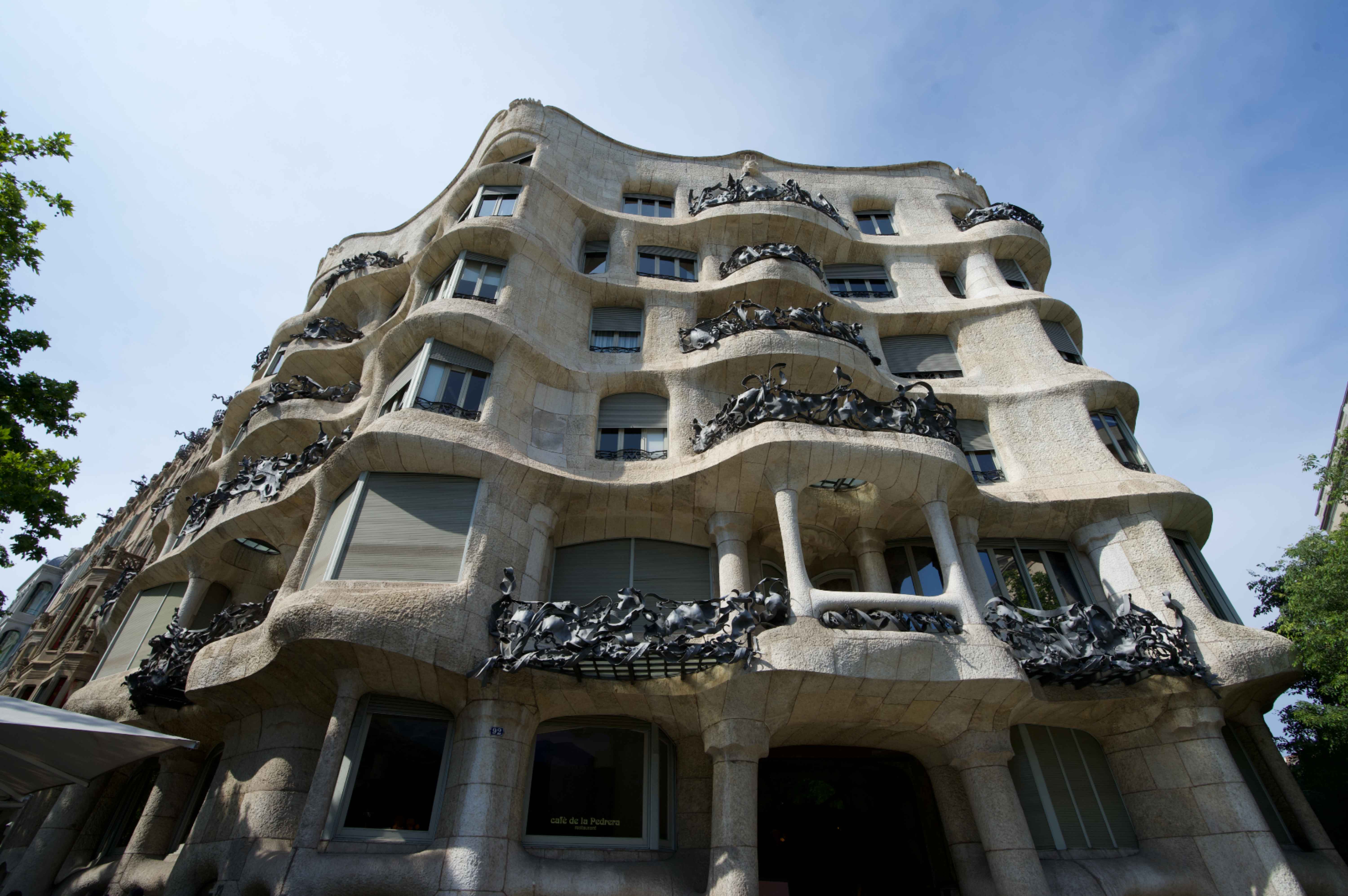
As you stroll around, familiarize yourself with the ambiance of Barcelona, soak up the atmosphere, and be ready to get captivated by this colorful city and its charming people.
Casa Batlló
Let’s dive into our first visit of the day: Casa Batlló, one of Barcelona’s most extraordinary architectural wonders!
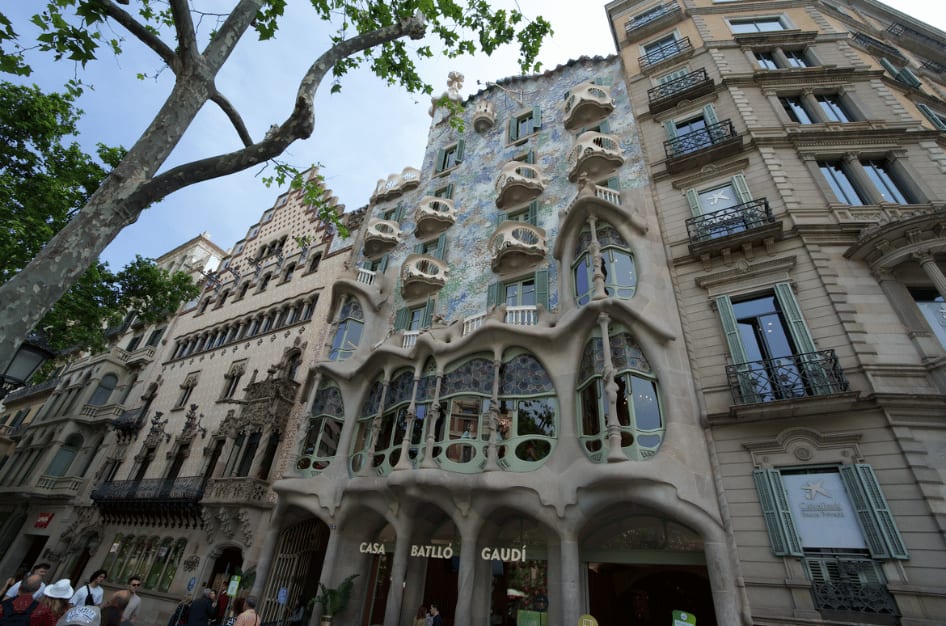
This iconic building was designed by the brilliant architect Gaudí. From the outside, take some time to look at the facade and its details. Once inside, you’ll be transported to a world of fantasy and creativity. Every little corner of Casa Batlló seems like a work of art.
La Sagrada Familia
The time many of you have been waiting for has come! Head up to the breathtaking Sagrada Familia, Barcelona’s most representative symbol.
The construction of this temple began in 1882 with a neo-Gothic style. They gave the project to Gaudí a year later, who completely rethought it.

Sadly, Gaudí died in 1926 and left this masterpiece unfinished. Yet, thanks to the plans that remain, other artists and donors are continuing the project so it can be finished one day!
📌 Read more: 15 Best Tourist Landmarks in Barcelona Worth Your Visit
If I were you, I would go there early in the morning to avoid crowds. And get tickets in advance. As you can imagine, La Sagrada Familia is more than just a building; it’s a testament to Gaudí’s imagination and architectural prominence! You can’t miss this activity.
Las Ramblas Street
After visiting the iconic Sagrada Familia, I bet you’ll have stories to share for hours! So my top tip is that you head straight to Las Ramblas, the city’s most famous street, and soak up the rich energy that fills the air.
You can do a lot of people-watching, walk at your own rhythm, and immerse yourself in the Spanish vibes.
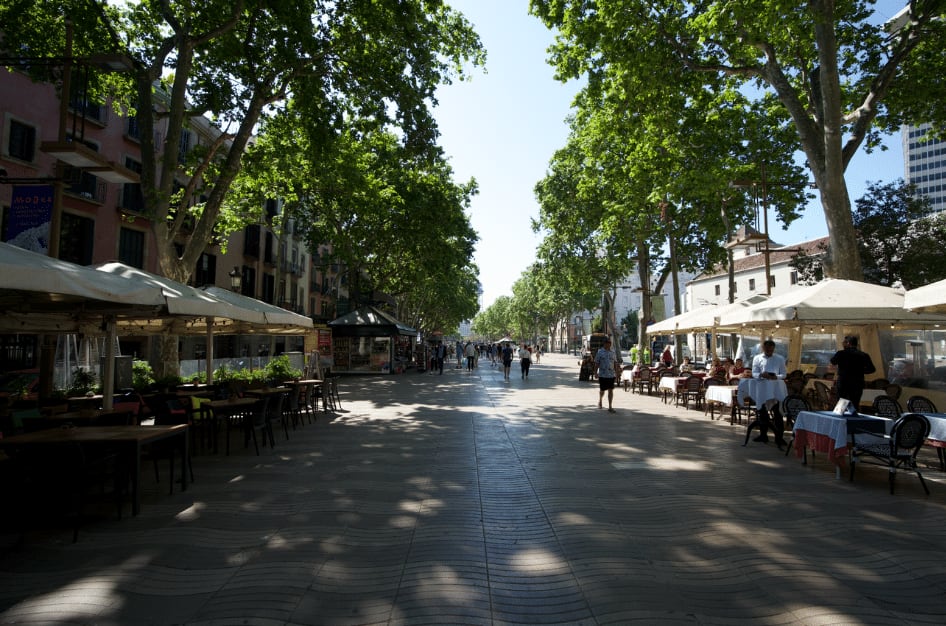
You’ll be surrounded by street performers, shops, vibrant terraces, and cozy cafes. So, bring comfy shoes to walk past this beautiful street and landmark of Barcelona.
La Boquería
Hope you’re hungry… Because we’re entering a foodies paradise when it comes to La Boquería, Barcelona’s most famous market
It has numerous stalls bursting with fruits, cheeses, veggies, meats, seafood, and everything you can imagine.
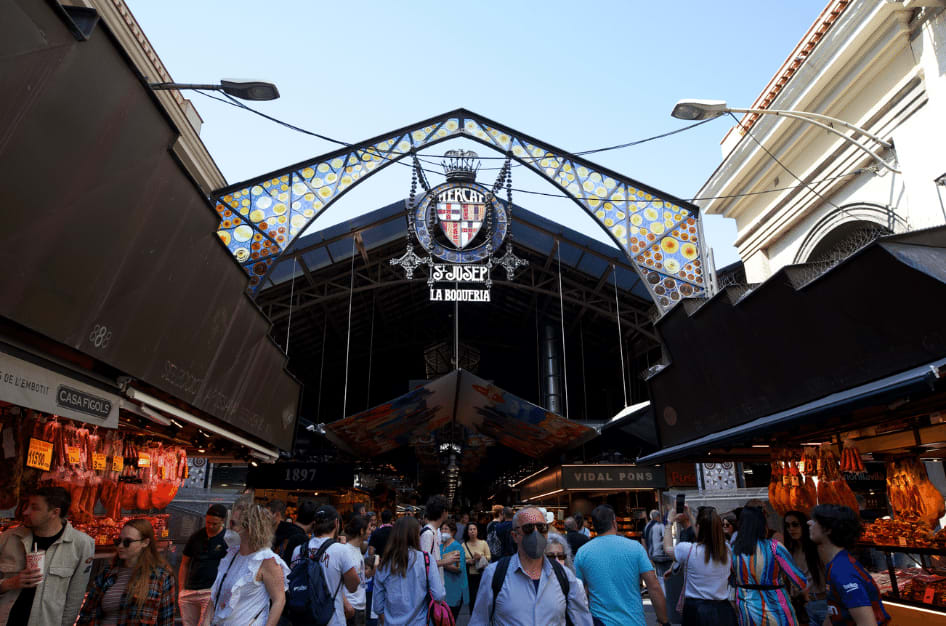
Admission is free, and even if you don’t want to buy anything at the market, it is worth a visit to soak up the atmosphere and discover the local cuisine with the fresh products on the stalls.
📌 Read more: What to Eat in Spain: 31 Tasty & Traditional Dishes
And, of course, you can grab a quick bite if you feel like it. In that case, try the octopus marinated in herb oil and paprika from the Boqueria bar.
Gothic Quarter
The Gothic Quarter has a unique energy. It transports you to the city’s early years, and each building has a distinctive architecture. I would say it’s a must for understanding Barcelona’s rich heritage and culture.
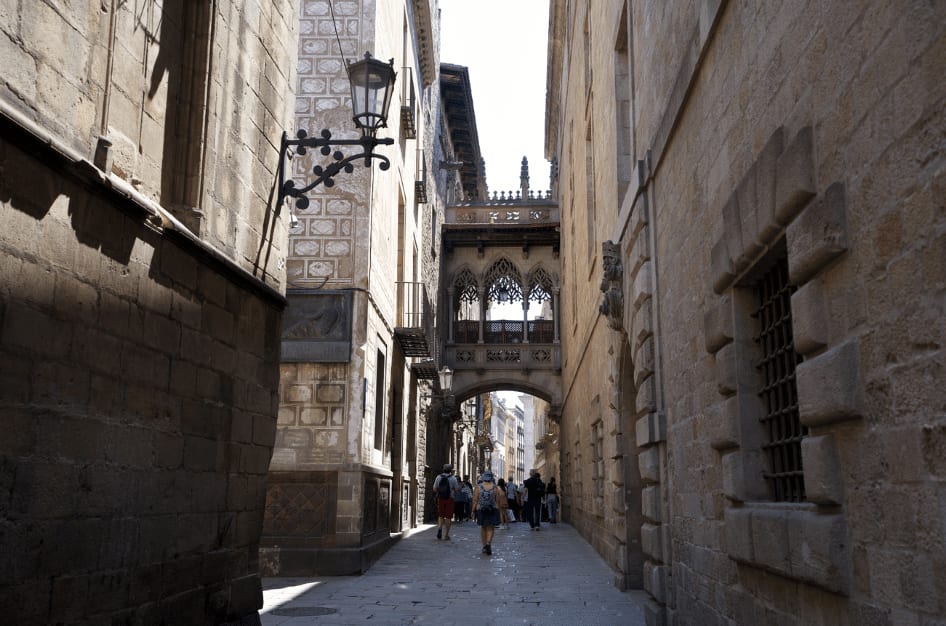
The most fun part is that the neighborhood is a vibrant hub of cultural and social life all year round. You’ll find art centers such as Arts Santa Monica and Artevistas Gallery or the famous Gaudí Exhibition Center.
📌 Read more: 9 Best Neighborhoods in Barcelona: Students, Expats & Tourists
Some highlights are the Barcelona Cathedral, a stunning Gothic masterpiece, and Plaça Reial, a lively square. And, of course, the fantastic Picasso Museum!
Picasso Museum
The Picasso Museum offers a complete insight into the mind of this renowned artist. You can find works from his early years to his iconic masterpieces that changed the course of art history.
Whether you’re an art enthusiast or simply curious about Picasso’s legacy, the museum is worth it! (I would choose this one over the other MOCO Museum, for example)
Make sure to book tickets online to ensure your entrance.
The place is well maintained, with an extensive collection segmented by themes. You’ll be immersed in a journey through the mind of one of the most influential artists ever!
Parc de la Ciutadella & Arc De Triomf
Local’s and visitor’s favorite spot to chill, relax, hang out, and get in touch with nature. (or is it the Barceloneta? Who knows…)
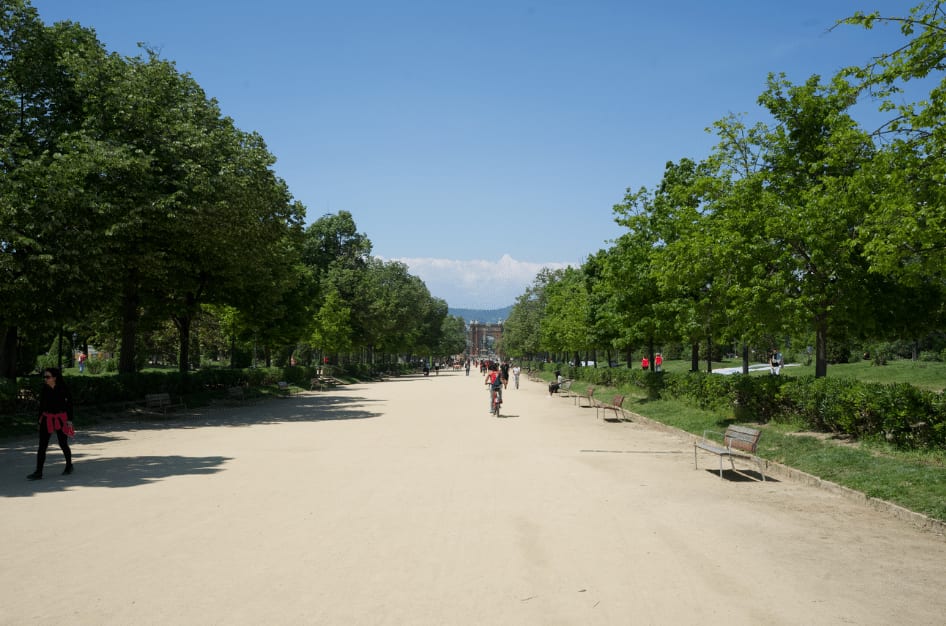
Parc de la Ciutadella is a lovely huge park with many green spaces, peaceful lakes, and charming paths perfect for a leisurely walk. Plus, right next to Parc de la Ciutadella is the majestic Arc de Triomf, an impressive gateway that welcomes everyone to the city!
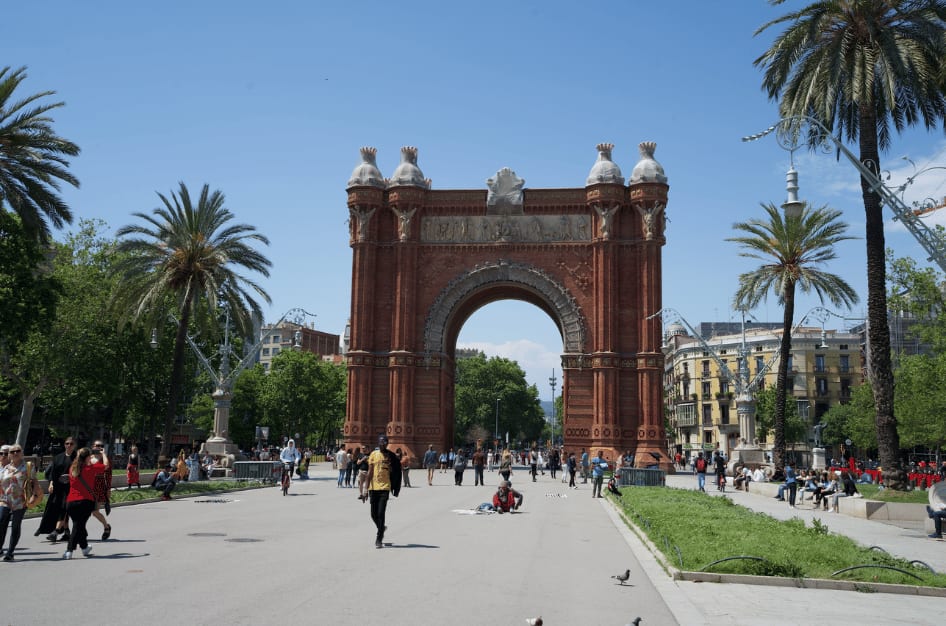
Also, the park is a perfect activity for families with kids since it is home to the Barcelona Zoo and the Museu de Zoologia, where you can get up close to different animal species.
La Barceloneta
Barcelona has something unique that sets it apart from European cities like Paris or London, which is its this beach.

It really brings a refreshing sea breeze and laid-back vibes to the city, offering the perfect escape from the hustle and bustle of city life.
Whether you want to walk along the coast, enjoy some water sports, or tan at the beach, this is your place. Also, make sure you try seafood or paella by the beach. You will remember it forever!
🏖️ Read more: 15 Top Beaches in Barcelona & Costa Brava. With videos!
If you’ve ever wondered why so many foreigners choose Barcelona as their dream destination, your questions will be answered once you visit the gorgeous beach of La Barceloneta. This is a true Mediterranean oasis in the heart of the bustling city.
Experience the Spanish Nightlife
On your first day in Spain, you really thought you were going to bed at 11 pm? You are wrong. Don’t be lazy, it’s just three days! How can you expect to know the city if you don’t party like a local? Let’s see if you can catch up with us and read my top recommendations to make your nights unique.
Our adventure continues to Paradiso Bar, a must in Barcelona. This cool and trendy spot was awarded Best Bar in the World in 2022! Impressive, isn’t it?
So, you can start your night delighting yourself with some exquisite cocktails, or you can go home and sleep, your pick!
Anyways, moving on with the things you should actually do on this trip is the Opium Club Barcelona, a very fun place to enjoy the most fantastic night out in Spain.
I really suggest you go out at least for one drink. I mean, they don’t call us party animals for nothing. Don’t miss out on this experience! After this, you’ll have enough time (maybe) to relax and unwind at your accommodation since the next day is also very promising!
🕺🏽 Read more: Spain Nightlife Guide: 9 Best Places to Party in 2023
Day 2 - IMMERSE IN BARCELONA’S CULTURE
I hope you’re all in for today because we will explore some of the coolest spots before you leave Barcelona for your next destination. On this day, we’ll visit places we couldn’t squeeze in yesterday because they were a bit far from the city center and we want to save time!
Still, these are musts for any traveler wanting to see the best of Barcelona, so make sure you get up early, and let’s start the day with a delicious breakfast! I’ll show you some fantastic spots to find delicious eats.
Have a Spanish Breakfast
Coffee, anyone? I don’t know about you, but we Spanish people can’t leave our houses without having (at least) a cup of coffee first thing in the morning.
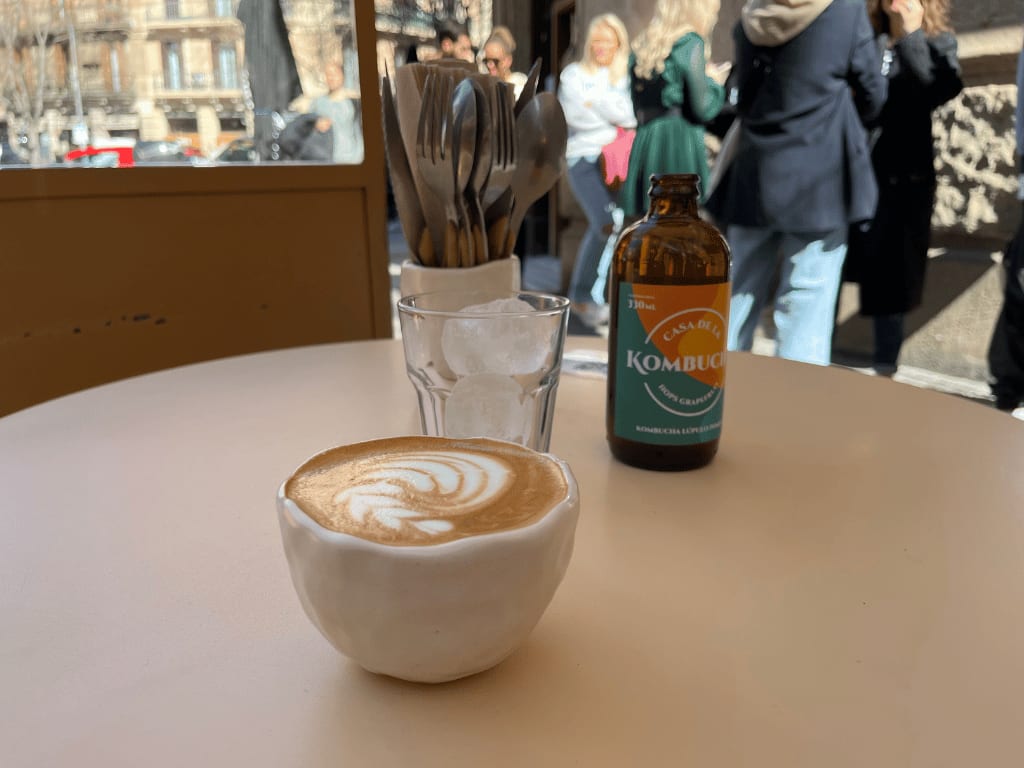
These are the best places to have an excellent breakfast or brunch in Barcelona:
🫖 Read more: 8 Best Cafes in Barcelona for a Unique Coffee Experience
And, if you need some ideas on what to order to look like an local, then this is for you:
🍳 Read more: 7 Best Typical Spanish Breakfasts You Must Try!
After fueling our tanks, it’s time to head down the streets and hit the road to discover what’s left of Barcelona!
Thank God you have 2 days in Barcelona because Park Güell is one of the activities that would hurt to get out of the itinerary.
Designed by the iconic architect Gaudí, Park Güell is like a fairytale in real life, with its colorful mosaics, curvy structures, and stunning city views!
I promise it feels like you’ve entered a magical dream. Just make sure to arrive early or book tickets online to reserve your spot, as this popular attraction can get busy.
Also, relax! It’s a park. Feel free to bring snacks and enjoy a picnic. A visit usually takes up to 3 hours approximately.
The Magic Fountain of Montjuïc
This fountain is in Montjuïc, a hilltop area with fantastic free views of Barcelona (like Montmartre in Paris).
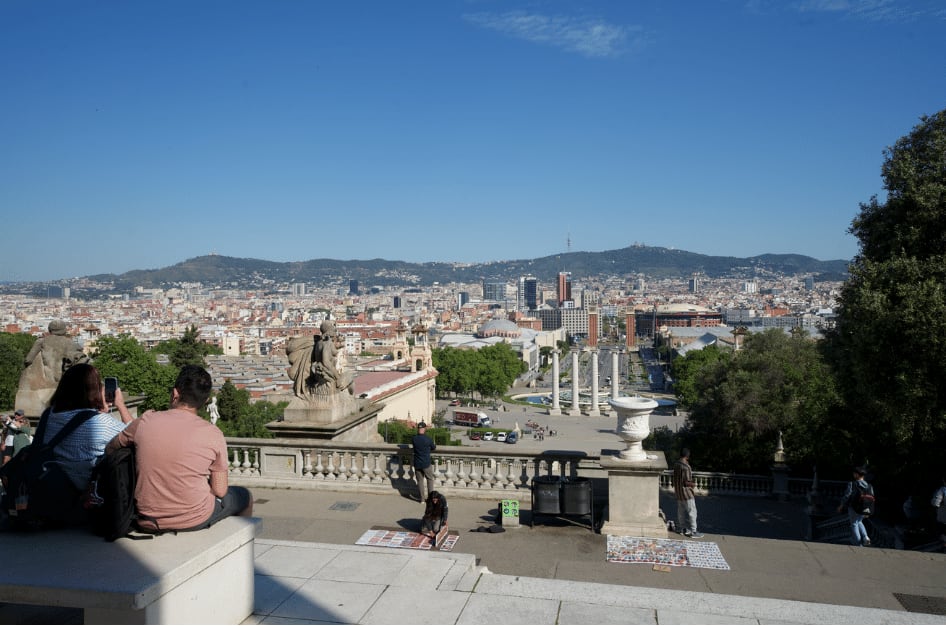
The area around the fountain is great for a relaxed walk, and you can absorb the city’s vibe.
Also, the Palau Nacional, also known as the National Museum of Catalan Art, makes a beautiful setting for Montjuic, as it is the museum with the most extensive collection of Catalan art in the world.
Museu Nacional d’Art de Catalunya
The National Museum of Art of Catalunya has a bit of everything. From Romanesque to Modern Art, this museum in Barcelona offers an extensive exhibition of over 260,000 pieces, including paintings, sculptures, and decorative art.
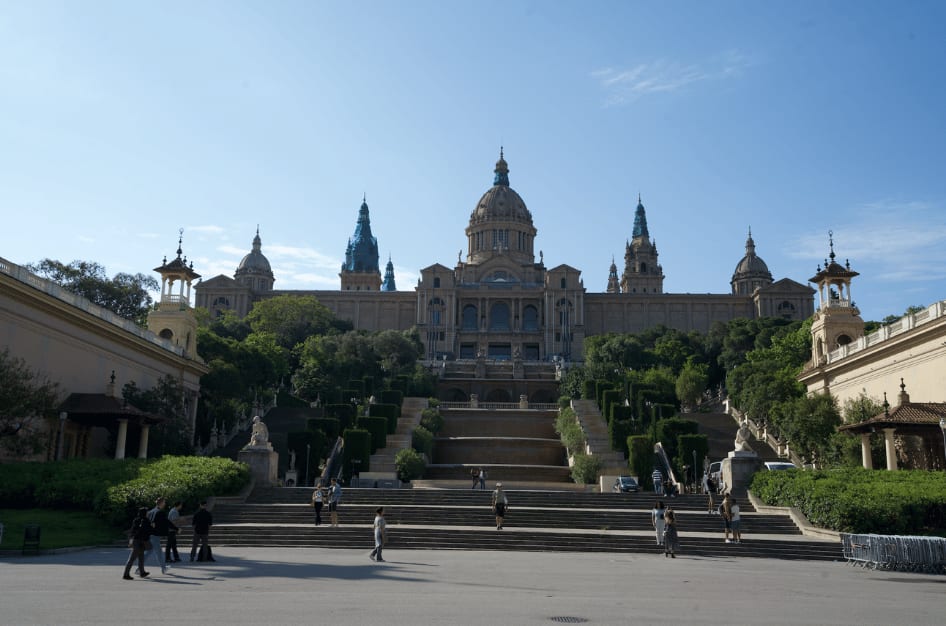
One unique piece in the museum is the 12th-century Apse of Sant Climent de Taüll, which shows one of Spain’s most remarkable examples of Romanesque art.
If you only go for the basic admission, you experience a panoramic view of the city from the terrace. It’s totally worth it!
Try Tasty Dishes in El Nacional
Now hear me out. El Nacional is the place you’re looking for to eat in Barcelona. It offers a bit of everything under the same roof; it’s a food lover’s paradise!
It’s like stepping into a superb food hall with a stylish atmosphere. The space divides into four different areas: La Llotja (best seafood dishes), La Taperia (tasty tapas and rice dishes), La Braseria (great charcoal grill), and La Parada (quick bite to eat)
Plus, the ambiance is very nice and photogenic. It is an open space with a good interior, very clean and busy. You can find different restaurants inside the complex offering up anything you could want.
Travel to Madrid
We should move to our next destination: Madrid, Spain’s capital and biggest city!
I’d suggest taking a high-speed train from Barcelona, departing from Barcelona Sants station, and arriving at Madrid’s Puerta de Atocha station. The journey usually takes around 2 and a half hours. Plus, traveling to the train stations is more budget-friendly than going to the airport.

Yes, there are other options like buses (which take about 7 and a half hours) or planes (which can be three times more expensive). Still, the train is undoubtedly the most convenient choice regarding time and money.
So, hop on that train because Madrid awaits you with open arms and lots of exciting things to do! I will show you how to make the most of this city and leave you some helpful resources:
📌 Read more: How to Get Around Madrid + 8 Tips I Wish Someone Told Me
DAY 3 - DISCOVER MADRID’S TREASURES
Your day begins in the gorgeous, elegant, and lordly Madrid, Spain’s Capital. This cosmopolitan city welcomes millions of visitors each year, and our adventure begins with a tour of the renowned Royal Palace of Madrid, also called the Palacio de Oriente.
Royal Palace of Madrid
It is the largest palace in Western Europe and one of the largest in the world! Today, it is used exclusively for receptions, ceremonies, and official acts, since the kings of Spain reside in the Palacio de la Zarzuela.
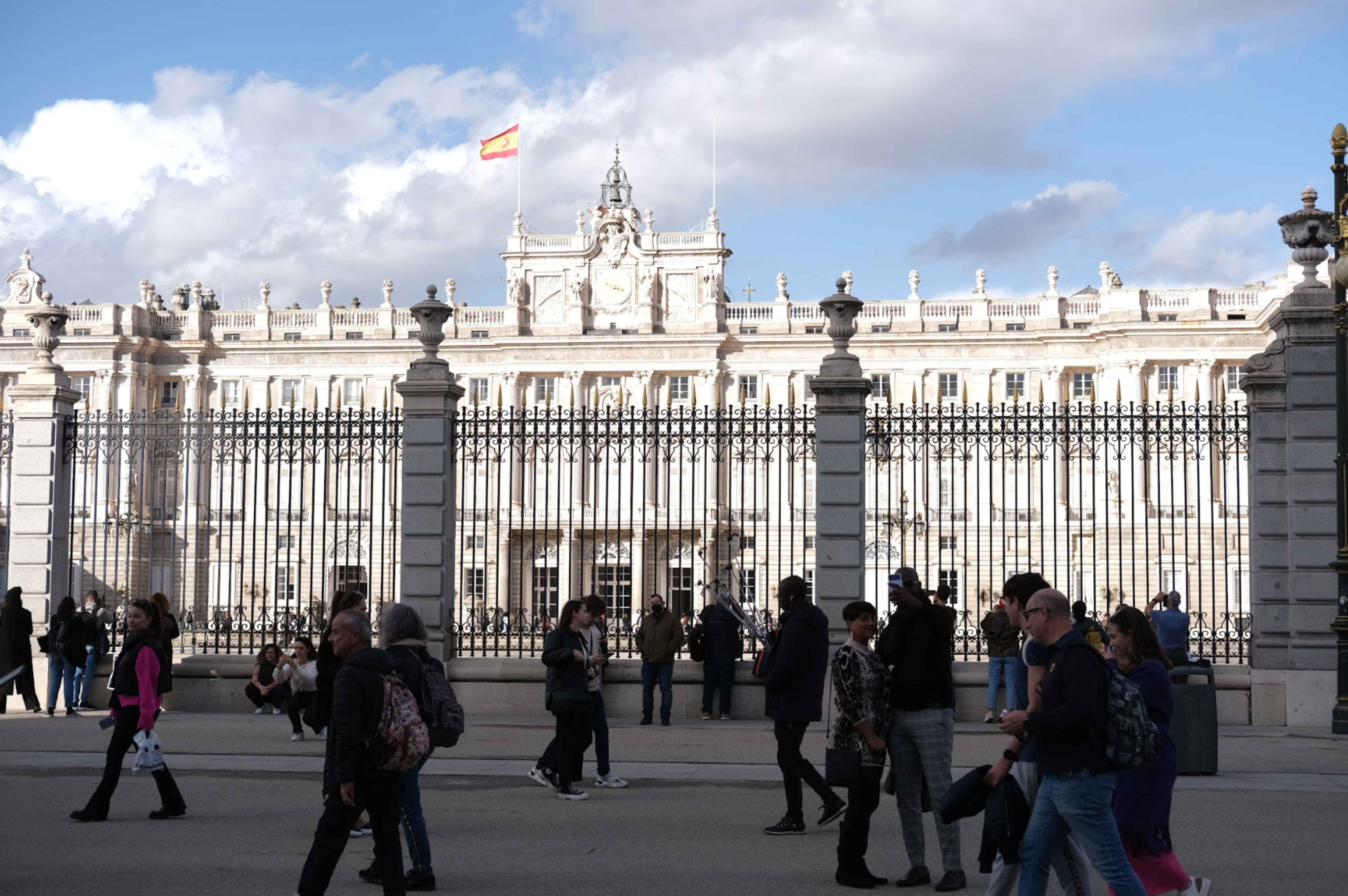
The visit includes entrance to the official halls, the Royal Armory (to see armor, shields, and weapons of all kinds, constituting one of the most important collections in the world), and the Royal Pharmacy.
It is free from Monday to Thursday, from 5 to 7 pm (from 4 to 6 in winter) if you are a citizen of the European Union, resident, or holder of a work permit.
If you have a moment, you can stop in front of La Catedral de la Almudena, a lovely cathedral with unique architecture.
Chocolatería San Ginés
Alright, let’s dive into Madrid’s local flavors and try the tastiest churros in the whole country at Chocolatería San Ginés!
This place is right in the heart of the city’s historical center, and trust me, it’s gonna win you over and make you remember this taste forever. Churros dipped in chocolate is a tradition we cherish and love.

Now get ready to explore some of Madrid’s most incredible spots on a walk through the historic city center. This way, you can really understand the local vibes and atmosphere.
La Plaza Mayor
After the churros, walk to La Plaza Mayor, the most important square that is very lively and has a buzzing atmosphere.
This is a very iconic place if you’re visiting Madrid for the first time. You can see the Statue of Felipe III, Casa de la Panadería, Arco de Cuchilleros, and many other essential details! You can get a guided tour if you want an in-depth explanation.

Ask us if you need any help planning your trip. We’ll be happy to help you!
Mercado de San Miguel
Our next stop is the iconic Mercado de San Miguel, a place to taste authentic local dishes.
It has 33 stalls, and its top-selling offers in this market are cheese, ham, wine, and oysters. But my favorite is the mushroom and ham croquetas from Arzabál Croqueteria cart, the oysters from Daniel Sorlut, and the baos from Boale.
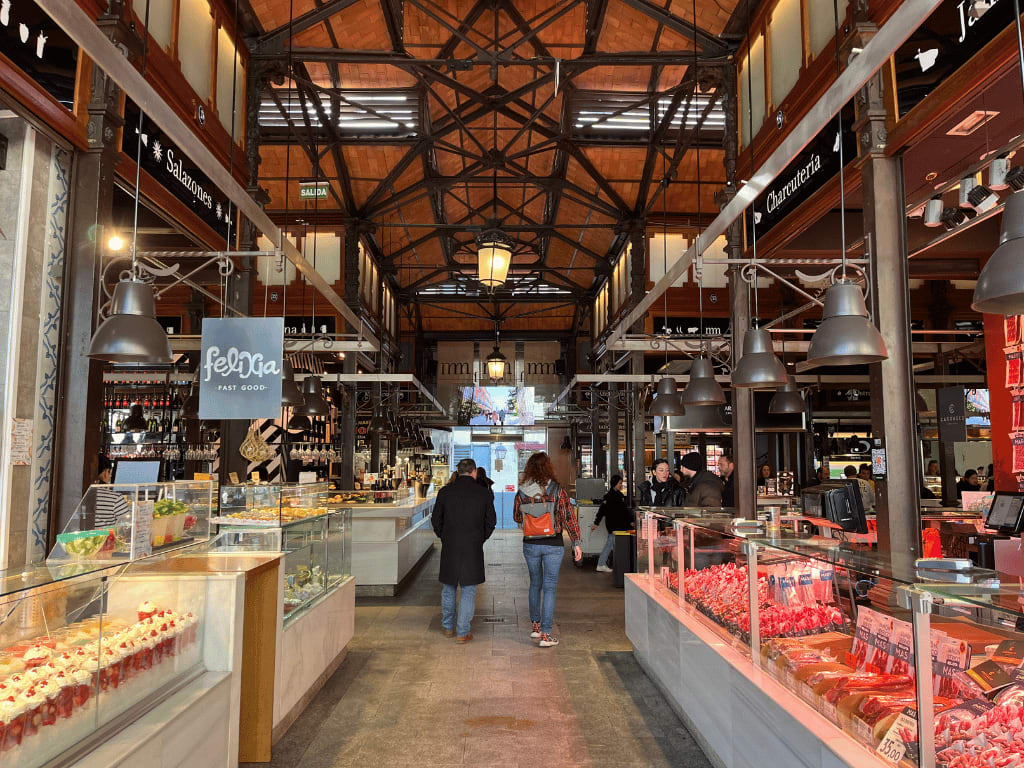
I know you must be dying to try the tortilla de patata . Still, save that for another time since the Mercado does not have the best tortilla in Madrid.
Puerta del Sol
Then head to Puerta del Sol, the heart of the city. It’s a huge square with plenty of spots to grab a bite and places to go.
Last but not least, we’ll venture into the hip district of Las Letras, where creativity and culture blend seamlessly. You’ll find cool street art, cozy cafes, and hidden gems waiting to be discovered.
📌 Read more: 30 Best Things to do in Madrid: Fun Activities & Food!
The Prado Museum
A visit to Madrid is only complete once you visit the Prado Museum. (Probably) the most important museum in Spain that houses the most extensive collection of Spanish paintings (7,600 paintings and around 1,000 sculptures), making it an art lover’s dream.
About 1,000 of the artwork exhibited in its rooms belonged to the Royal Collections of the Spanish dynasties. Also, it holds well-known paintings by Velázquez (Las Meninas), El Greco, Goya (Third of May 1808), Titian, Rubens, and Bosch.

With more than 3 million annual visitors, it is a must-see in the city. It is the most famous museum in the capital and the country and a worldwide reference.
Retiro Park
Nearby is the beautiful Retiro Park, the oasis in the middle of Madrid. After a long day of savoring, tasting, and knowing Madrid, it is only fair to delight yourself with a beautiful walk in the most beloved park for all Madrilenians.
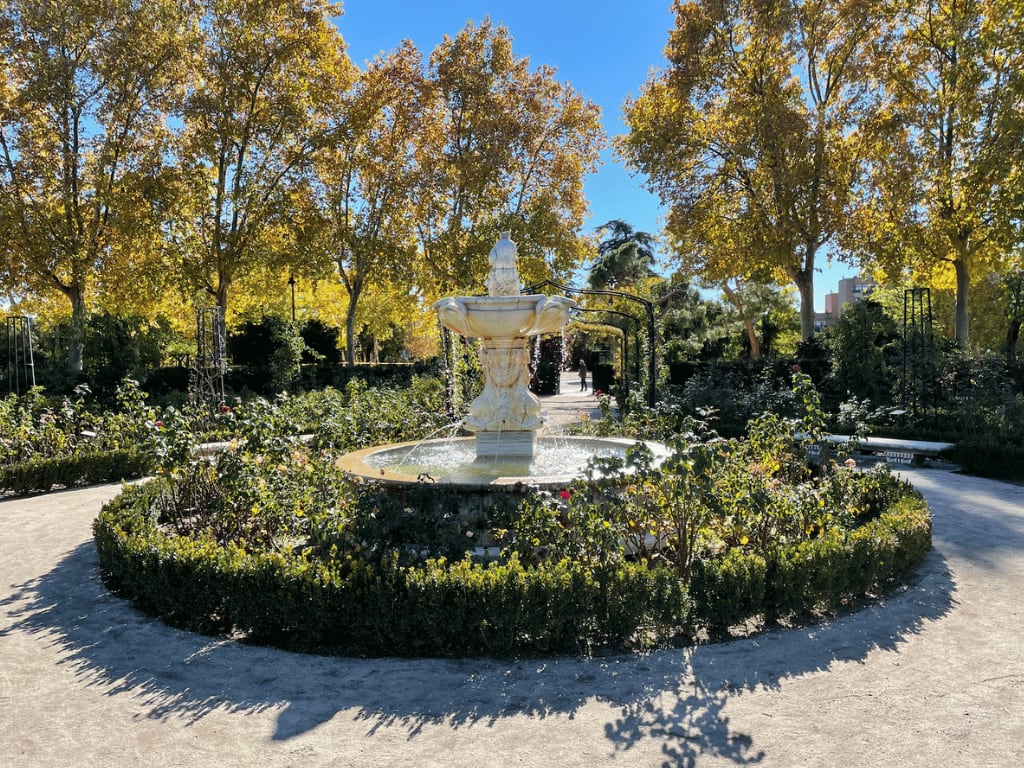
The famous Retiro Park is the largest and greenest park in central Madrid. It serves as a bit of escape from the bustling streets for all kinds of leisure activities, recreation, reading, painting, meditating, running, exercising, yoga, going on a picnic, enjoying works of art, taking photos of nature, playing chess, sitting down on a terrace, partying, you name it!
Puerta de Alcalá
Head outside and admire the imposing Puerta de Alcalá, one of Madrid’s most iconic symbols. This massive entrance, inaugurated in 1778, is next to the Parque del Retiro. It connects streets as prominent as Alcalá, Alfonso XII, and Serrano with lovely streets to walk, stroll around, or spend an afternoon in its fabulous terraces.
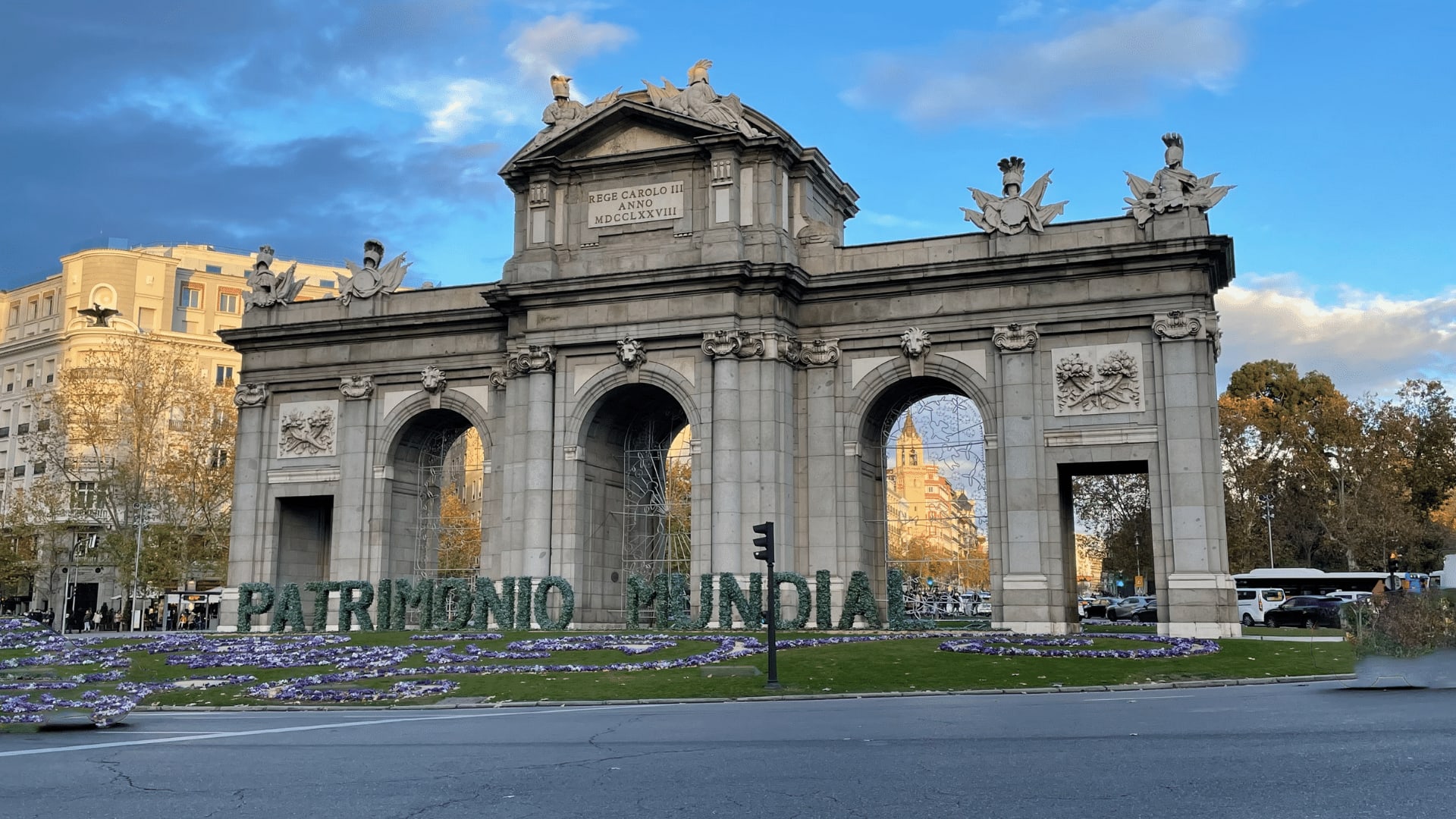
If you’re in Summer and are in for a sweet, refreshing treat, try the Maison Glacee ice cream by heading out of the park on Alcalá Street.
Cibeles Fountain
Go down the entire Alcalá Street, and you will see the post office building, the new Madrid town hall in front of the fascinating Cibeles fountain, where madrileños celebrate Real Madrid’s football victories.
You’ll also spot the impressive Bank of Spain building as you continue along the street. Soon, you’ll find yourself on “La Gran Vía,” a bustling and significant street in Madrid.
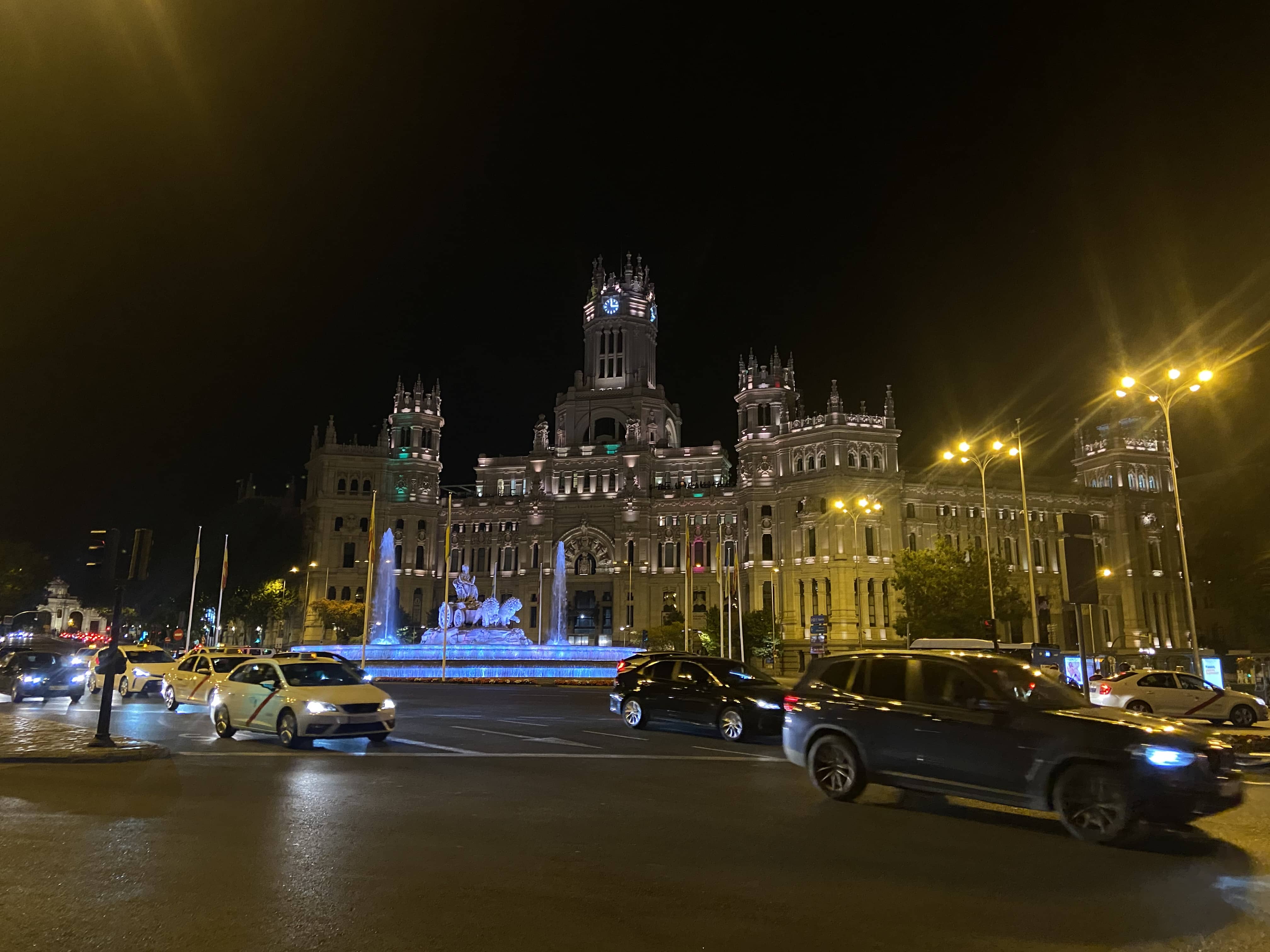
At the beginning of Gran Vía, don’t miss the chance to enjoy breathtaking skyline views from impressive rooftops, like those at Circulo de Bellas Artes or the RIU Hotel (that one being in front of Plaza España).
Gran Via and Callao
The Gran Vía in Madrid is one of the city’s most important streets. It has monumental architecture, a great shopping area, and a lively tourist center.
Along the way, you’ll encounter famous buildings like Metropolis, Sweepes, and Telefónica, as well as the Grassy Building with its iconic Rolex advertisement.
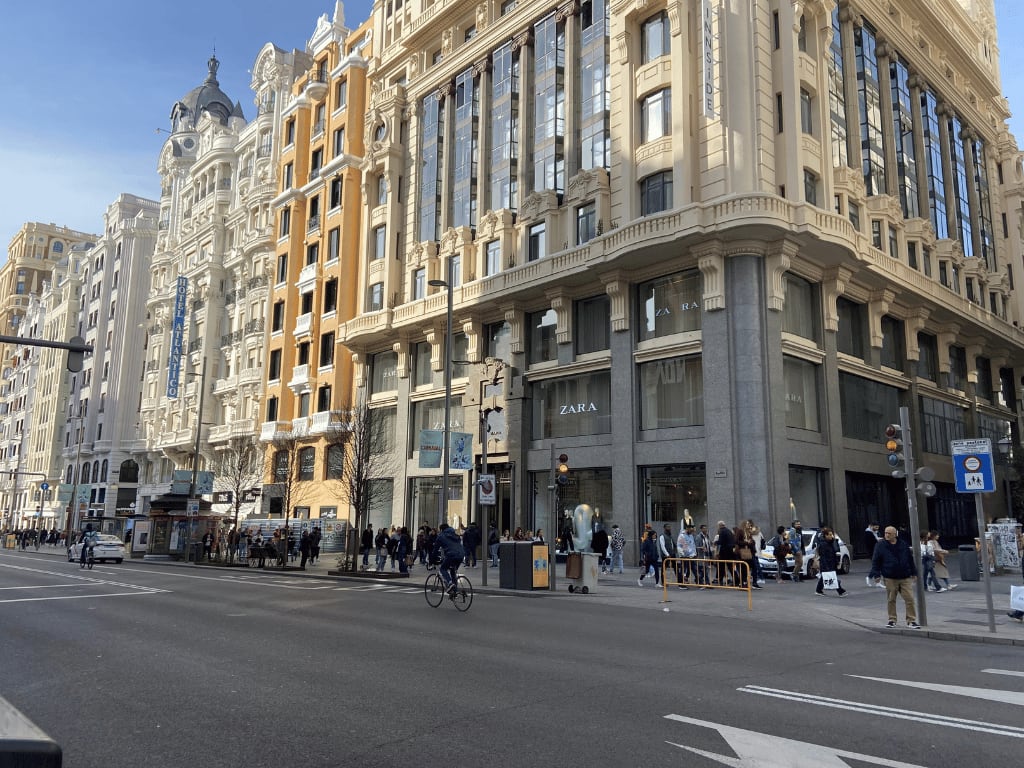
This street is bursting with life and various activities, including theaters, cinemas, entertainment venues, nightclubs, bars, and many dining options.
Before you reach Plaza de España, you’ll find the bustling Callao Square, where important streets converge. From there, you’re just a few minutes away from Puerta del Sol, completing your Madrid adventure. Enjoy every moment of it!
Plaza de España
Finally, Plaza de España is one of the most beautiful squares to sit down before hitting the streets of Madrid, as it has a privileged location next to Gran Via and other main roads. So it’s a fantastic starting point to finish your day strong before leaving Spain.
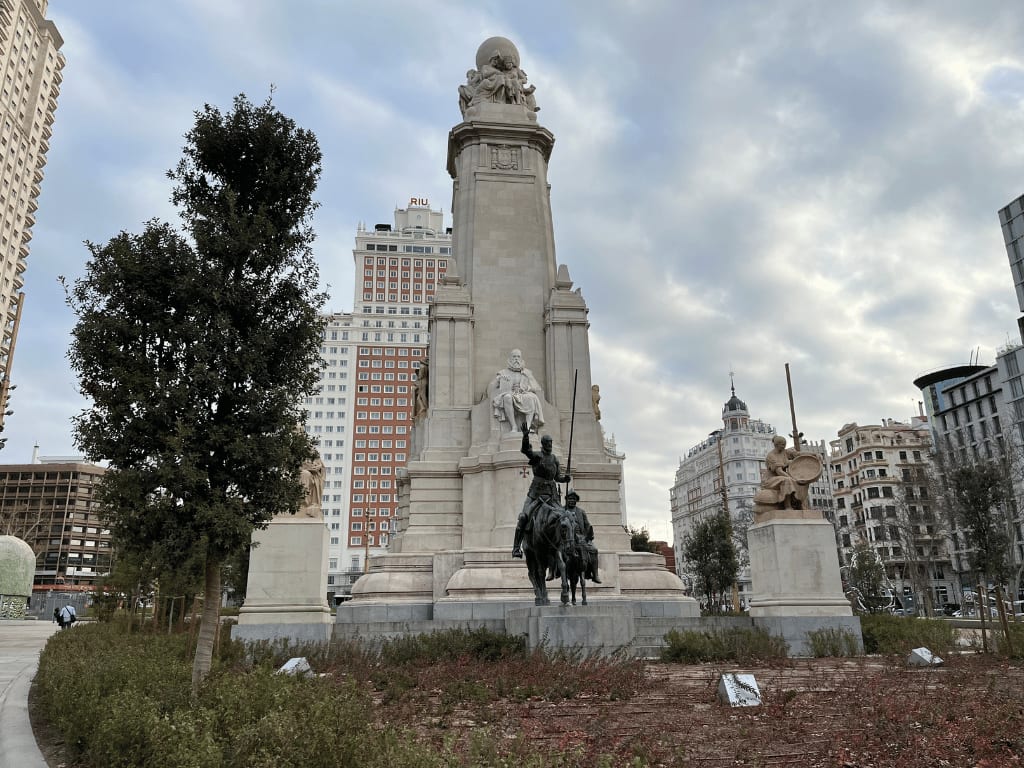
Bonus: If you find yourself in the afternoon with some time to spare, watch the sunset at Templo de Debod, right next to Plaza de España. It offers a beautiful, picturesque landscape to relax and say goodbye to this adventure.
I wish you had another day in Spain. This way we could spice up the itinerary a litlle bit and maybe include another small town… For example, Toledo City!
But that will be for another round. I hope you liked this itinerary, and if you have any other question feel free to ask. Happy travels!
READ NEXT: 5 Days in Spain: Itineraries to See (Almost) Everything!
Rating: No ratings yet. Leave a comment!

You might also like...
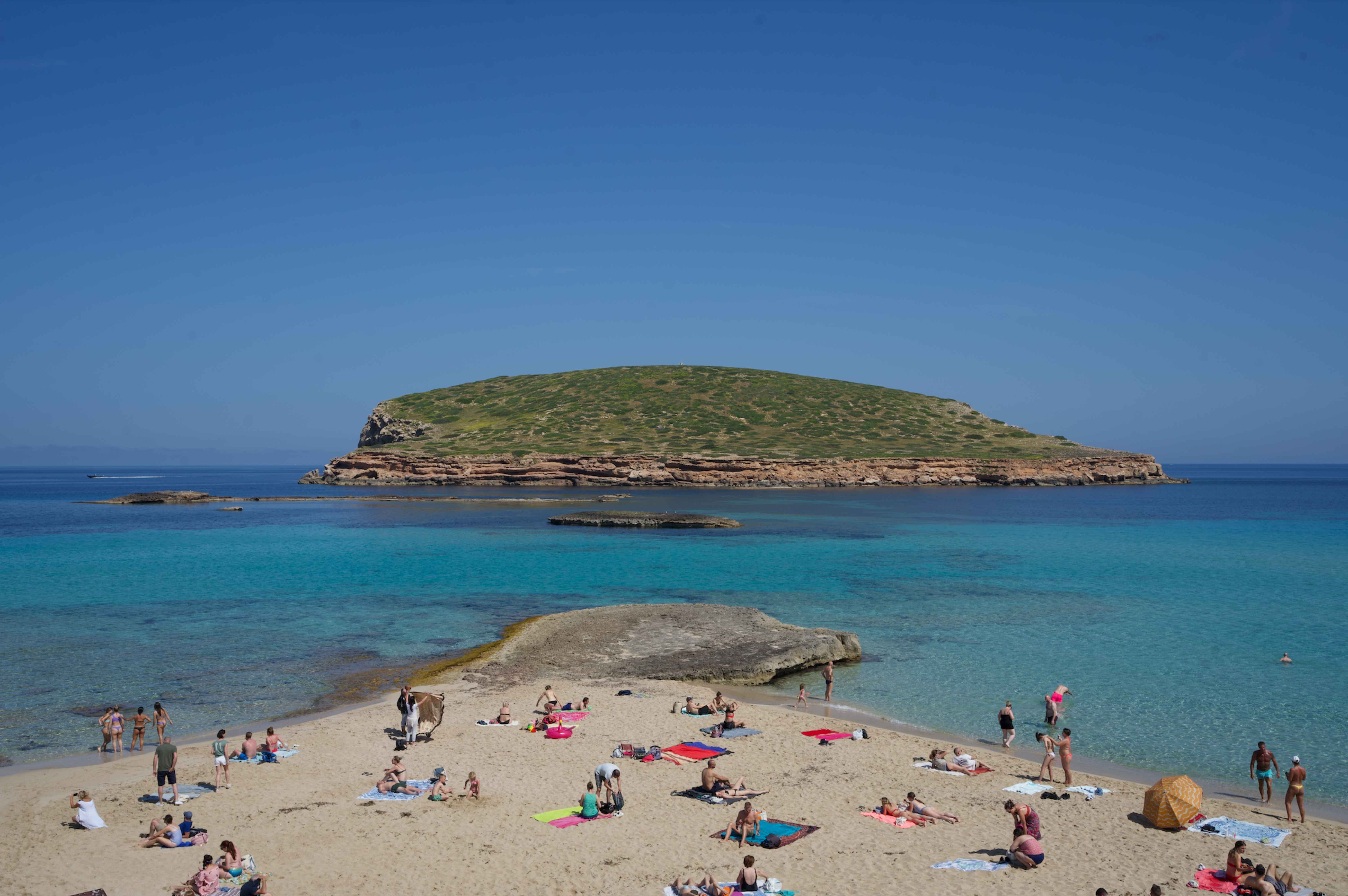
6 Days in Spain: The 3 Best Itineraries for Your Trip!
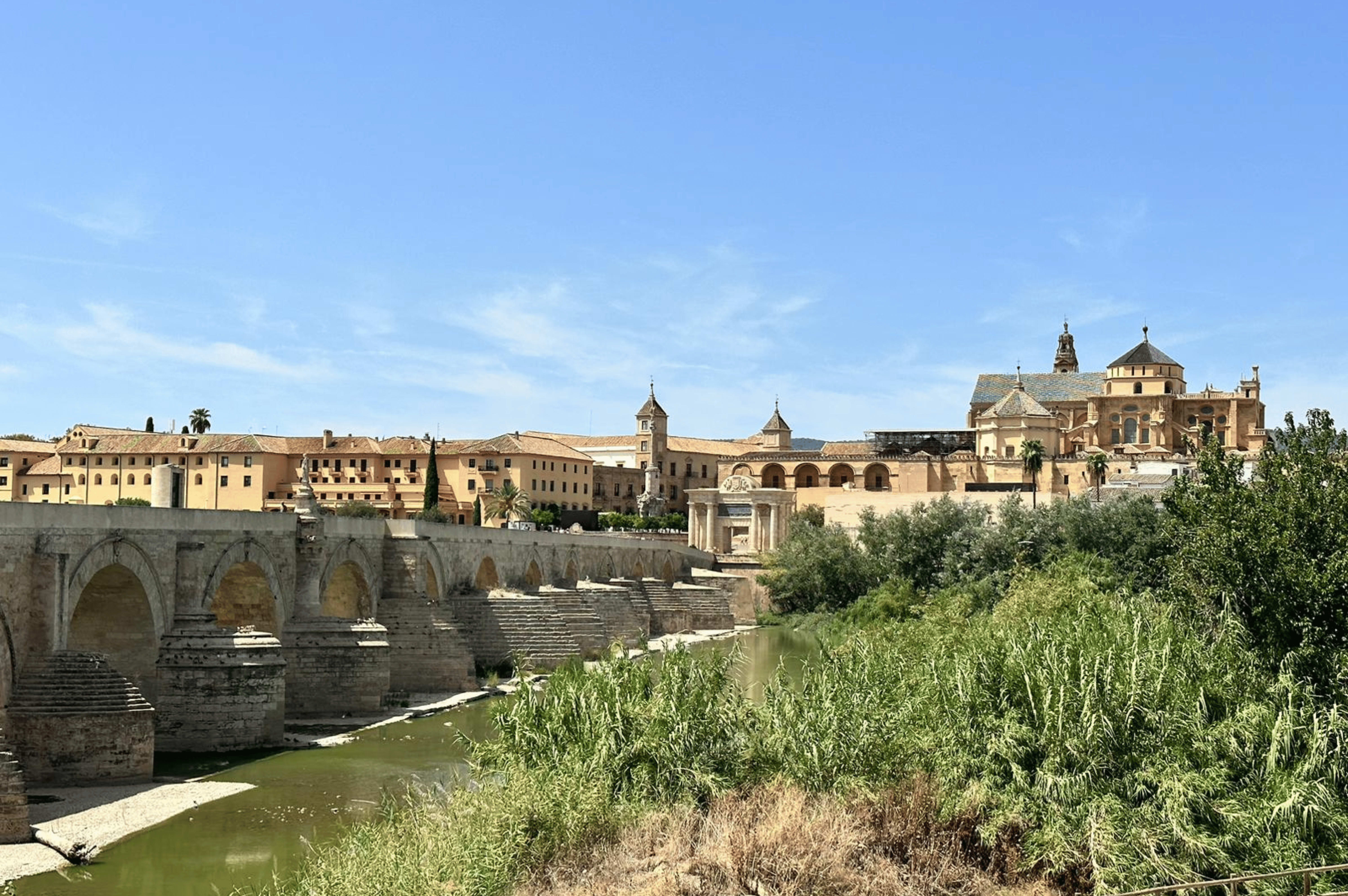
How to Spend 2 Weeks in Spain? 12 Cities & Activities
Email address (optional), star rating (optional).
Be the first to comment!

Millions of people como to Spain every month! But many never get to experience the SENSATIONAL SPAIN!!
We're both born and raised Spaniards and our goal is to give you all the resources to plan a perfect trip to Spain.
Take a look! 👇
FYI! Some affiliate links may be sprinkled throughout the post. We'll receive a small commission when you purchase from our links (at no extra cost to you), which will help us keep creating content.
Join the waitlist
I'm about to release my City Guides for Madrid, Barcelona, Sevilla and Mallorca.
They're going to have everything you need to plan the perfect trip. From hotels and transport, to restaurants, attractions, activities, & a lot (A LOT!) of tips & tricks.
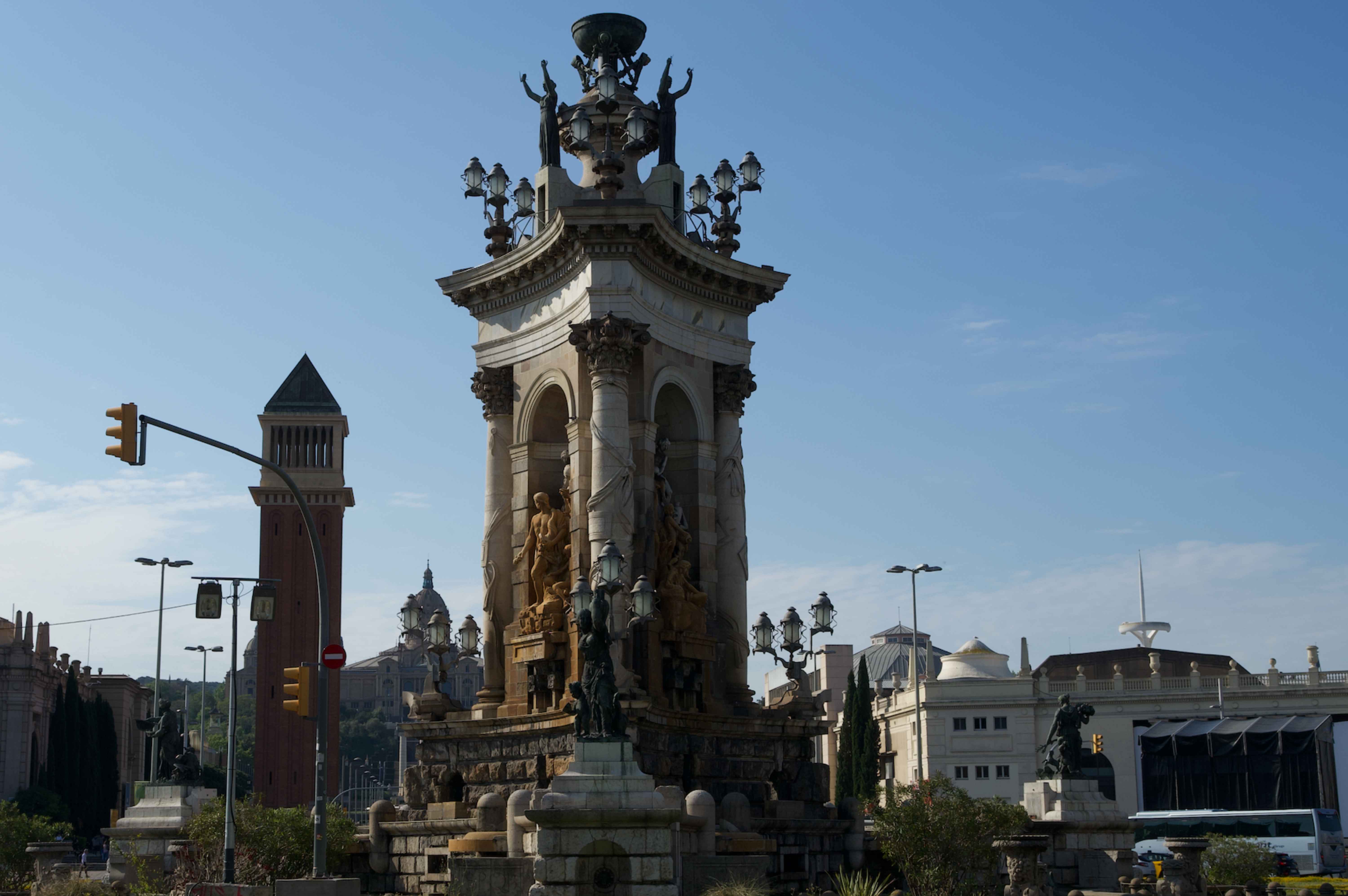
5 Days in Spain: Itineraries to See (Almost) Everything!

What do Spanish People Think of Americans?

What Song Are You Listening To? MADRID

What is the Best Show to Learn Spanish?

Things People Should NEVER do Dating in Spain

Can Foreigners Adapt To The Spanish Lifestyle?

3 Weeks In Spain Itinerary
DISCLAIMER: This post might have links to travel services and products that we enjoy. We might make a commission from it at no extra cost to you.
Popularly known as one of the most visited countries in Europe, Spain offers its annual 82 million tourists with all grace and satisfaction. Evidently, the number of tourist arrivals in Spain just keeps growing every year with people who are keen to visit beaches, go hiking, explore ancient towns, and try out local dishes.
So, what is your reason for visiting Spain? Is it to treat yourself to local Spanish cuisine? Or perhaps to experience its rich history and culture through its beautiful architecture? Or maybe you want to experience its natural beauty and the Mediterranean coastline? The good news is – Spain has all these.
Travelling to Spain for an extended time is recommended. There are so many things to see or do throughout your tour.
This itinerary for 3 weeks in Spain should be enough to cover the best that Spain has to offer, especially for first-time visitors. We have prepared this itinerary to plan your trip seamlessly and conveniently.
If you want to visit other countries in this region, check out our 3 weeks in South Europe itinerary or do a trio adventure and go to Italy, France, and Spain for 3 weeks .
THINGS TO KNOW BEFORE GOING TO SPAIN
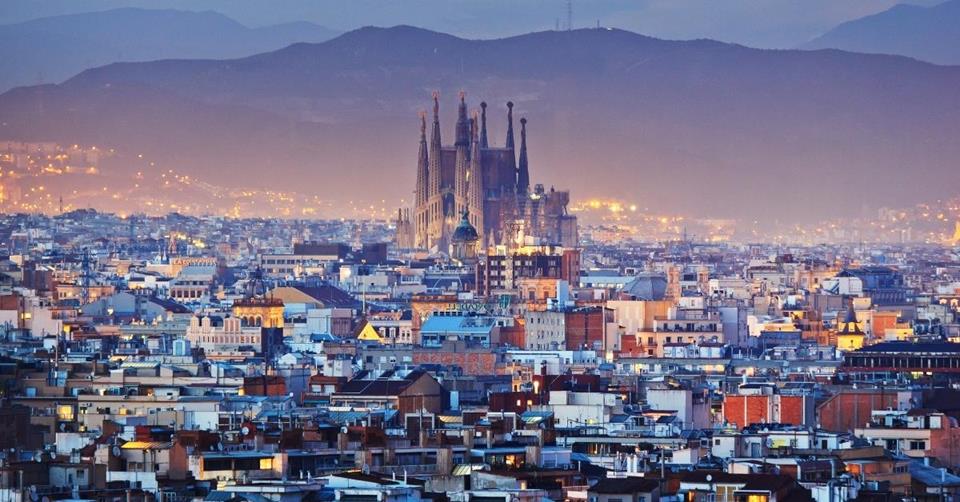
When you travel to Spain, it is important to learn basic Spanish phrases to make communication easier. Some can speak English, but some may not know the language at all. It is also important to know that drinking directly from the tap is safe. And tipping isn’t a big deal, so you are not required to leave a tip unless you are thrilled with the service.
As with any major tourist destination, pickpocketing can be an issue. Make sure you keep an eye on your belongings at all times. If it’s your first time travelling alone, check out our article on how to stay safe if you are travelling solo .
Here are more tips so you can better plan and write your 3-week itinerary . These tips will help you visualise and start having clarity on what your vacation will look like.
When is the best time to go to Spain
Choosing the best time to visit Spain can be a challenge since it is a great year-round destination. You generally decide the best time to go according to what you want to see or do. Each season offers a uniquely enjoyable experience, so you need to plan accordingly.
Spring (March to May) and fall (September to November) are the best times to go. This will provide you with good weather to enjoy the natural beauty and scenery of the country.
You can also expect fewer crowds (compared to winter and summer). And with fewer crowds, you can expect to find cheaper accommodations than when you book at other times of the year.
- Peak/summer season: June to August
- Heavy rains between September to January
- Winter season: December to February
One major holiday to remember when deciding when to go to Spain is Holy Week. During La Semana Santa , not only many businesses are closed, and locals not working, but there are parades and events surrounding this public holiday.
Make sure to book your hotel and other arrangements in advance if you plan to go during the Holy Week because it’s a peak season and last-minute booking will be expensive and challenging.
Are 3 weeks enough for Spain
3 weeks in Spain is perfect. You can visit historical sites, the beach, and even go for a hike or two. The country is also well-connected with flights and buses or trains, making travelling between cities or islands much easier. 20 days is plenty, and you won’t run out of things to do or feel like you have to cram everything and are always on the go.
If you’ve ever been to Spain or if you’re travelling here with your family and looking for something unique place to go to and spend your three weeks, perhaps this list of the best Spanish islands for families can be helpful. You can choose between popular spots and a tranquil peninsula to enjoy a peaceful atmosphere.
Average cost of 20 days in Spain
Plan to spend around $2,000 for a 3-week trip in Spain if you prefer to stay in a mid-range hotel and eat often. Accommodation costs you the most during your trip, around $40-$60 a night for a decent double room. Eating out in a m id-range restaurant will be about $7 to $12 per meal .
For those who want to t ravel more budget-wise, $1,200 could do it by staying in dorm rooms and eating street food most of the time. If your hostel has a kitchen, that could also cut costs. For l uxury spenders, around $3,500 will be an excellent budget if you plan to book five-star hotels and fancier restaurants.
These numbers don’t include your flight to and from Spain and are calculated for one person. For couples or a pair of friends travelling, you could save some money by sharing a double room.
What to pack
Knowing what to pack for Spain will depend on what time of the year you want to go. The country enjoys a Mediterranean climate, meaning the winters are mild with some rain, while the summers are hot and dry. When you visit during the summer, opt for casual and lightweight clothes to keep you cool.
It can get quite cold during winter in Spain, skiing is even possible here in the parts of the Pyrenees region. It is important to pack lightweight layering items such as cardigans and sweaters. The winters are not harsh, but it can get chilly at night.
We have a series of packing lists. Check out our packing for a 3-week trip . We also have a summer trip packing list , and of course, a packing list for winter .
How to get around
Getting around Spain is relatively easy. The best way to travel from one Spanish city or town to another is by train, especially while you are on the mainland. The high-speed train is called AVE(Alta Velocidad), a convenient way to travel between cities.
You can also rent a car and drive on your own since Spain has a pretty straightforward policy regarding recognising international driver’s licenses. However, remember that most vehicles in Spain are programmed with a stick (aka manual gear). You can, of course, find automatic cars, but they get booked up quickly.
Buses are also easy and cheaper but can be slower, while traditional taxis are everywhere. The use of ride-hailing apps is also common, and domestic flights will come in handy when moving between islands.
Spain has the same visa policy in place as any other Schengen State member (EU). This means that visitors with passports from most parts of the Americas, Oceania, Malaysia, Singapore, South Korea, Japan, and some parts of the Middle East can enter and travel around Europe for 90 days in every 180-day calendar.
US Citizens can travel to Spain for leisure or business purposes without a visa with a maximum stay of 90 days. The only requirement is that your passport must be valid for 6 months (during the time of travel). Also, it must have at least one blank page.
In some cases, a return airline ticket and enough funds are required. Aside from US citizens, the following passport holders do NOT need a visa to travel to Spain: Members of the European Union, Switzerland, Iceland, Norway, Canada, most parts of Latin America, Japan, South Korea, Malaysia, Singapore, New Zealand, Australia, and some regions of the Gulf countries and Central Asia.
For others not mentioned, the visa must be applied in advance. You could submit your application as early as 6 months in advance.
Travellers with passports from EU-member or part of Schengen States have indefinitely freedom of movement in Spain. Other passport holders must arrange their travel visa for Schengen through the Spanish Embassy or Consulate near you.
Package tours
Sometimes planning is overwhelming, and you really want a vacation where you can simply show up at the airport, and the fun begins. In that situation, I love booking package tours. In such tours, the travel agency book and arrange everything for you. This includes accommodations, activities, restaurants, transportation, and a knowledgeable guide.
Below is a list of exciting tours for 15 to 22 days. Let’s say you have 20 days of vacation, and you want to be easy but leave you time to do your own thing. Go book the 15 days, then you have 5 days of exploring on your own.
Other travel tips
Booking your travel arrangements can be overwhelming. There are simply too many options, and comparing them to one another is a daunting and time-consuming task. I was planning my Central Europe itinerary last night, and it is just a few minutes to book the accommodation I want and the flights I need.
I was also able to make a decision quickly because I know that some of the travel sites I use offer a flexible cancellation policy. Here’s a list of the websites and tools I use for any travel-related services. Perhaps, you might find them helpful and easy to use as well.
MUST-SEE PLACES IN SPAIN (pinned map)
Click the enlarge button on the top right corner. Credit: map data: Google
3 WEEKS IN SPAIN ITINERARY
Spain is home to many beautiful cities and towns that are worth exploring for various reasons. Whether you want to enjoy culture, nature, or history, you will be spoiled for options. Use this guide, so you know what to see or do for each destination in Spain.
If you enjoy your trip to Spain, perhaps you want to spend 3 weeks in Italy next time or a trip to France . For people on a budget, here’s our list of how to travel to Europe in 3 weeks on a budget .
Day-to-day overview
- Day 1 : Arrive in Barcelona. Arrange a private transfer to your hotel or take the airport shuttle bus . Pick up your rental car here at the airport if you plan to drive yourself. Get yourself a local sim card with data and local currency.
- Day 2-3 : Explore Barcelona and plan some day trips, get the Hola card for public transport .
- Day 4: Travel from Barcelona to Valencia by bus , train , plane, or drive.
- Day 5-7 : Discover Valencia, and don’t forget to enjoy the beach.
- Day 8 : Travel from Valencia to Madrid by bus , drive, train , or plane .
- Day 9 to 11 : Explore Madrid and plan some day trips from here.
- Day 12 : Get to Seville from Madrid by train , plane, bus , or drive.
- Day 13 to 14 : Discover Seville, and make sure to go to a flamenco bar.
- Day 15 : Travel to Malaga or Granada, which is around 2 hours by driving or 2.5 hours by bus ( Malaga / Granada ).
- Day 15-17 : Explore Granada or Malaga.
- Day 18 : Fly to Tenerife or Gran Canaria or Ibiza.
- Day 18-21 : Enjoy the island life and plan some relaxing days.
Barcelona for 4 days
Barcelona is probably the most popular city visited by tourists in Spain. It is known for its iconic architecture and beautiful Mediterranean location. It is rich in culture with a wide array of the iconic architect Gaudi’s works to explore. Barcelona is an ideal destination to start your 3 weeks in Spain trip, especially if you want to kick it off by relaxing on the beach and soaking up in the Mediterranean Sea.
Getting to Spain is very easy, there are two main destinations you can plan to start your trip – Barcelona and Madrid. Barcelona is as famous as Madrid, with non-stop flights from various cities in the US and Canada to Barcelona via American Airlines, Delta Airlines, Lufthansa, or Air Canada. The Josep Tarradellas Barcelona-El Prat International Airport in Barcelona is the central hub of flights and the second busiest airport in Spain.
Things to do in Barcelona
- Get a public transport pass – look at the price
- Mount Tibidabo
- Barceloneta Beach
- Basilica de la Sagrada Familia – skip the online and explore with an audio guide or combine with Parc Guell
- Barcelona Aquarium – suitable for young children, buy your ticket in advance
- Palau de la Musica Catalana
- Park Güell- get your ticket in advance , there’s a limit per day ticket sold for Parc Guell
- Casa Batllo
- Enjoy tapas and wine – book a walking tour
- Bogatell Beach/Playa de Bogatell
- Magic Fountain of Montjuic – ride a round-trip cable car
- Museo Picasso de Barcelona
- Explore Montserrate – join a half-day tour
- Trio-day trip and cover Spain, France, and Andorra – check the itinerary
- Walk around Barri Gotic
- Go kayaking and snorkelling in Costa Brava – book an affordable tour
Accommodations in Barcelona
- Affordable: Unite Hostel or Factory Hostel
- Mid-range: Sixties Ramblas or Violeta Boutique
- Luxury: Vincci Gala or Ohla Barcelona or ME Barcelona
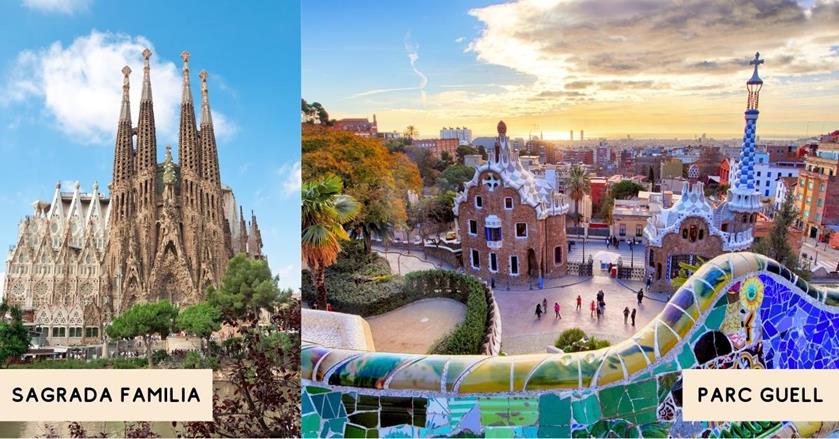
Valencia for 3 days
Best known as the home of paella, Valencia is the home of luscious Spanish dishes. But aside from introducing the world to this culinary delight, there are more reasons to visit Valencia in Spain. Valencia is another Spanish coastal town 348 km (216 miles) south of Barcelona.
Taking a stroll through its old town will enable you to marvel at the colonial architecture. But Valencia is also home to many futuristic architectural features, such as the world-famous Valencia City of Arts and Sciences. Spending 3 days in Valencia is plenty, although 2 days is possible if you want to add that one day to another city.
To get to Valencia from Barcelona, you can either drive your rented car for 3 hours and 40 minutes or take the train , the journey is around 3 hours or by bus is about 4 hours. You can also book a direct 1-hour flight.
The best way to get around Valencia is by using public transportation. You can also rent a bicycle or buy yourself this useful hop-on hop-off bus ticket which stops at major attractions in Valencia.
Things to do in Valencia
- La Lonja de la Seda
- Oceanografic – perfect for young children, get your entrance ticket
- Albufera Natural Park
- La Ciutat de les Artes i les Ciencies de Valencia
- Cuevas de San Jose – sign up for a half-day guide tour
- Mercado Central
- Plaza de la Virgen
- Hike and swim at Montanejos – book a group tour
- Bioparc Valencia
- Torres de Serranos
- Playa del Saler
- Sail on a Catamaran Cruise – check the tour price
- The medieval town of Requena
- Enjoy wine and tapas tasting in an 11th-century historical monument – check this trip
- Join a cooking class
Accommodations in Valencia
- Affordable: Hostal Antigua Morellana or Colors Rooms
- Mid-range: Ad Hoc Carmen or Venecia Plaza Centro
- Luxury: Vincci Lys or Petit Palace Plaza de la Reina
Madrid for 4 days
3 weeks in Spain without visiting its capital is incomplete especially if it’s your first time here. Madrid is the artistic centre of Spain. Proof of that is the concentration of art galleries located in various parts of the city that showcase the works of Picasso and Velazquez. It is also home to a wide range of vibrant neighbourhoods that offer the best tapas and pubs to check out at night.
Madrid is located right in the centre of Spain, about 346 km (215 miles) northwest of Valencia. There are a few ways to get to Madrid from Valencia. You can book a direct 2-hour flight from Valencia Airport to Adolfo Suárez Madrid-Barajas Airport. You can also get to Madrid by train from Valencia with Avlo in 2 hours or by car, which takes nearly 4 hours.
Once you get to Madrid, you can easily move around on foot and use public transport. If you prefer a more convenient way to travel around, a push bike might be more suitable for you or you get a hop-on hop-off bus ticket with stops at the most popular attractions.
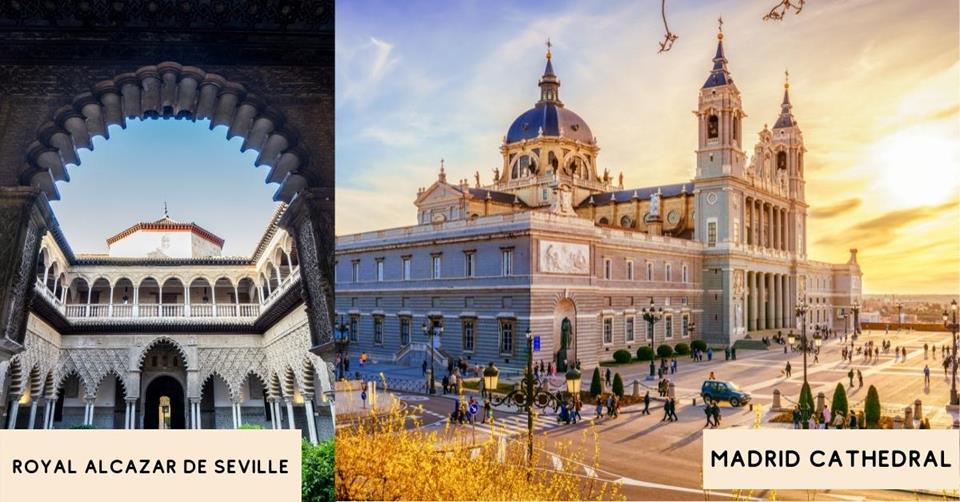
Things to do in Madrid
- Royal Palace – get your fast-access ticket
- Plaza Mayor
- Museo Nacional del Prado – purchase your ticket in advance
- Parque Natural de Peñalara and Sierra de Guadarrama National Park
- Visit Real Madrid’s Stadium (Santiago Bernabéu Stadium) – join a Bernabeu Stadium tour
- Buen Retiro Park and the Crystal Palace
- Puerta del Sol
- Fuente de Cibeles and Gran Via
- Temple of Debod
- Basilica de San Francisco el Grande
- Enjoy wine and tapas tasting – join a group tour
- Puerta de Alcala
- Watch a flamenco show with dinner
- National Museum of Romanticism
- Day trip to Avila and Segovia and visit historical sites or go to Toledo with a local guide
Accommodations in Madrid
- Affordable: Olblanc Plaza de Espana or Hostal Arrate
- Mid-range: II Castilla Madrid or Hotel Liabeny
- Luxury: Pestana CR7 Gran via Madrid or Palacio de Atocha
Seville for 3 days
Located within the province of Andalusia in Spain, Seville is best known for its flamenco culture. You can find plenty of flamenco bars in town. You can also visit many historical landmarks and museums to glimpse the town’s past.
The architectural landscape of Seville offers a mix of the old and the new, creating a beautiful contrast in the cityscape. If you prefer to see this region of Spain, perhaps a Southern Spain road trip would be an ideal adventure for you.
Seville is 532 km (330 miles) south of Madrid. You can book a direct train between Madrid and Seville called Renfre/AVE. The trip will take a little offer of 2.5 hours, you can also drive, which is about a little over 5 hours. A direct flight will take about an hour from Adolfo Suárez Madrid–Barajas Airport (MAD) to Seville Airport (SVQ).
Things to do in Seville
- Royal Alcazar of Seville
- Catedral de Seville
- Punta Umbria Beach
- Cascadas del Hueznar
- Real Alcazar
- Parque de Maria Luisa and Plaza de Espana
- Barrio de Santa Cruz
- Museo del Baile Flamenco
- Real Maestranza de Caballeria de Sevilla
- Palacio de la Condesa de Lebrija
- Metropol Parasol
- Torro del Oro
Accommodations in Seville
You can also check this list of best boutique hotels in Seville with swimming pools.
- Affordable: Hostel A2C or Pension Javier
- Mid-range: Hotel Casona de San Andreas or Cool Sevilla Hotel
- Luxury: Hotel Rey Alfonos X or Hotel Dona Maria
Granada or Malaga for 3 days
The city of Granada is like a Disney fairy tale that came to life. It is filled with cobblestone streets, snow-capped mountains, and enchanting fortresses. It is also notable for the abundance of Islamic art and architecture.
Granada’s excellent and unique identity sets it apart from many other Spanish cities. For this reason, the destination makes it a worthy addition to your 3-week itinerary in Spain. This city is known for its “free tapas” culture if you love tapas. If you sit in any restaurant, bar, or visit someone’s home, there are free tapas for everyone.
On the other hand, Malaga is another seaside city in the south of Spain. There are spectacular beaches, historical monuments, and varied museums. Pablo Picasso was from Malaga, when you explore the city, you’ll definitely see how proud this city of him is through displaying his art.
Both Granada and Malaga are on the east of Seville. Malaga is 205 km (127 miles) southeast of Seville, while Granada is 250 km (155 miles) east of Seville. A car will only take 2.5 hours to reach Granada from Seville and 2 hours to Malaga. There are direct trains to both cities from Seville but no direct flights to both cities.
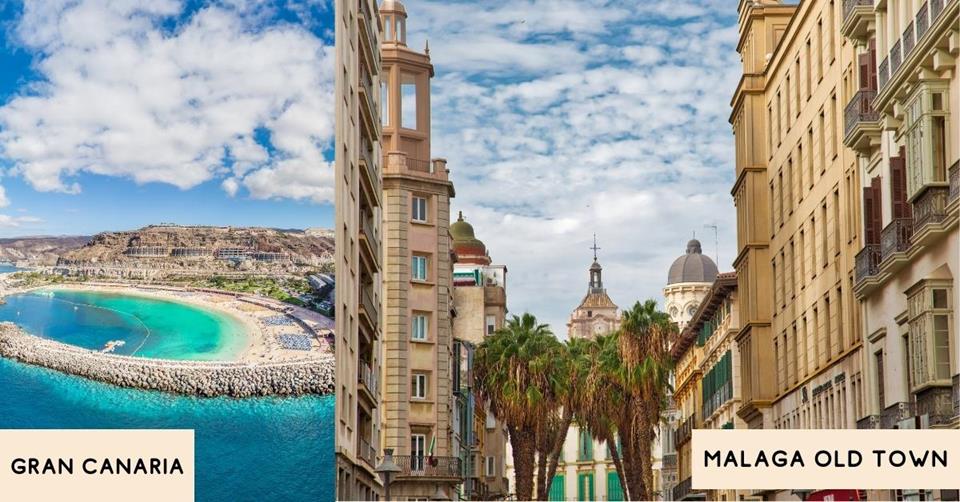
Things to do in Malaga and Granada
Since Granada and Malaga are not too far, you can easily plan day trips from both cities. You can also explore Malaga’s must-see spots on a 2-hour segway guided tour .
- Alhambra (G)
- Sacromonte (G)
- Alhambra (G) – check the tour price or do a day trip from Malaga
- Nasrid Palaces (G)
- Enjoy a flamenco show in a cave restaurant – book your table
- Salobreña Beach
- Sierra Nevada National Park
- Alcazaba de Malaga
- Torre Vigía De Cerro Gordo – sign up for a snorkelling and kayak tour
- Malaga Old Town/Marbella Urban Wall
- Boat trip to Paseo de Los Delfine – check the price
- Jardin Botanico-Historico la Concepcion
- Caminito del Rey – book a guided tour to cross the suspension bridge
- Playa de la Malagueta
- Museo Picasso Malaga – get your ticket with an audio guide tour
- Centre Pompidou Malaga
- Do tapas tasting – join a walking tour
- Festival de Malaga
- Day trip to Gibraltar – book a day trip including a St Michael Caves visit
Accommodations in Malaga
- Affordable: COEO Pod Hostel or Hotel Zeus
- Mid-range: Petit Palace Plaza Malaga or Be Mate Malaga Centro
- Luxury: Soho Boutique Castillo de Santa Catalina or Vincci Seleccion Posada del Patio
Accommodations in Granada
- Affordable: Urban Dream Nevada or Pension Venecia Gomerez
- Mid-range: Nest Flats Granada or Room Mate Leo
- Luxury: Candil Suite Origen or Hospes Palacio de Los Patos or Palacete (adults only)
Tenerife or Gran Canaria or Ibiza for 3 days
The best way to finish off your 3 weeks in Spain vacation is by visiting its most fabulous and beautiful islands in the northern part of Africa. West of the Sahara desert is the islands of Tenerife and Gran Canaria. Apart from magnificent beaches, these two islands also offer the best hikes in Spain and vibrant nightlife.
As one of the most popular destinations for holidaymakers in Spain, Tenerife is located in the Canary Islands. It is well-known for its natural beauty. The most notable feature of Tenerife is its volcanic peaks that create lunar landscapes and otherworldly natural features. It is also home to some of the country’s most unique geological gems.
However, Tenerife is a big island for a limited time. So, it’s best to decide which part you prefer. Whether it’s Tenerife North or South, either should work since both have their own airport to get in and out back to mainland Europe.
Gran Canaria, on the other hand, is a fantastic location for water sports and exploring nature, and it’s one of the most LGBTQ+-friendly across all of Europe. Spend your day either doing active sports or simply lying on the beach, enjoying a book, and drinking fresh coconuts.
Ibiza is not in the Canary Islands; it’s located east of Valencia. It’s well-known that Ibiza is an exciting destination when it comes to nightlife and all-night rave parties. It’s very suitable for young travellers and everyone who enjoys parties and delicious cocktails. If you just want a quick peek at Ibiza, you can also simply book a trip when you are in Valencia.
Getting to Gran Canaria or Tenerife
Tenerife has 2 major airports, Tenerife North (TFN) and Tenerife South (TFS). You should be able to get on a direct flight from Malaga both to the north and south, if not, you might have to connect in Madrid. The travel time is between 3-7 hours, depending on the connection.
Gran Canaria only has one airport (LPA), to get here from Malaga, you can get on a direct flight which is about 2.5 hours.

Things to do in Gran Canaria
- Pico de las Nieves
- Reserva Natural Especial de las dunas de Maspalomas
- Go scuba diving – book a tour
- Playa Puerto Rico
- Drive an ATV – enjoy a tour
- Roque Nublo
- Enjoy a submarine tour – read the reviews
- Palmitos Park
- Sign up for a morning cruise – check the price
Accommodations in Gran Canaria
- Affordable: La Hoyilla Hostel or Mountain Hostel Finca La Isa
- Mid-range: La Cason Canaria or Hotel Rural Hacien del Buen Suceso
- Luxury: Hotel the Lumm or Hotel Cordial or Wavia Hotel (adults only)
Things to do in Tenerife
- Lago Martianez
- Playa de Las Teresitas
- Mount Teide National Park
- Siam Water Park – get your tickets
- Whale and dolphin watching
- Museum of Science and the Cosmos
- Fuerteventura – do a 4×4 tour
- Cueva del Viento
- Masca Village
- Tabaiba Shipwreck/Pecio de Tabaiba
- Bajamar Natural Pools/Piscina Natural de Bajamar Teneriffa
- Sign up for a whale and dolphin watching tour or do a kayak tour while looking for dolphins and turtles
Accommodations in Tenerife
- Affordable: Albergue San Jose de Los Llanos or Hotel Las Canadas
- Mid-range: Hotel Adonis Plaza or Alua Tenerife
- Luxury: Hotel Hacienda del Conde or Gran Melia Palacio de Isora Resort & Spa
Things to do in Ibiza
- Join an all-inclusive boat party
- Platja de Cala Xarraca – Paul
- Cala Salada
- Platja d’en Bossa
- Cala Benirras
- Cala Bassa – book a 6-hour boat trip around Ibiza
- Cala d’Hort
- Ses Salines
- Hike Camino Al Faro De Moscater
- Faro de Punta Grossa
- Tore de Companitx
- Castell d’Elvissa/Castle of Ibiza
- Book a snorkelling and SUP paddle tour
Accommodations in Ibiza
- Affordable/Mid-range: Hotel Florencio or Lux Isla
- Luxury: Aparthotel Duquesa Playa or THB Los Molinos (adults only)
MUST-TRY SPANISH DISHES AND DRINKS
During your trip for 3 weeks in Spain, make sure you try the local dishes. You can taste so much food and see which ones are your favourite. The best way to do this is either by joining an affordable food tour or visiting at least 2-3 restaurants in each city you explore.
Spain has a rich culinary history. Many of the tourists who come to Spain seek out one of its many culinary specialities to get a taste of its rich culture. The dishes reflect the natural produce of the region where they come from and its cultural tradition. Discover the best dishes that you need to try when in Spain.

As the traditional and most popular dish in Spain, Paella is a rice dish cooked with various ingredients. It showcases local produce and fresh catch of the day.
Arroz Negro (or paella made with squid ink) is one of the most sought-after kinds of Paella. But you can also find seafood paella or paella Valencia, among other varieties of this dish.
Churros are fried, sugary sticks, probably Spain’s most notable dessert. This crunchy pastry is often dipped in hot chocolate or fudge. If you are looking for a dessert to cap off your meal, it is recommended that you order one.
As a dish that is made with ripe tomatoes, garlic, olive oil, cucumbers, and peppers, Gazpacho stands as one of the best Spanish cuisines. All of these ingredients are blended to create a smoothie-like consistency. This dish is best served cold and is perfect for summer. It is also a great dish to try for vegans and vegetarians.
Spanish Croquetas
The Spanish croquet is another must-try dish when you travel to Spain. This dish is Spain’s version of fried balls, but instead of meat, this can also be made with vegetables.
When looking for vegan options in Spain, make sure to ask for the meatless croqueta. They are served in various restaurants in Spain and meat. It is replaced with mushrooms, pine nuts, spinach, or blue cheese.
SUMMARY OF 3-WEEKS IN ITINERARY
Spain will spoil your senses with the most delicious food, best sights, and remarkable attractions you won’t find elsewhere. Spain is rich in history, medieval architecture, delicious dishes, fantastic beaches, and endless outdoor activities, you won’t run out of things to do in Spain.
If you are looking for a great beach destination for a 3-week vacation , make sure to consider Spain, and the destinations recommended here. I hope that you found this 3 weeks in Spain itinerary helpful.
SAVE THIS TRAVEL ITINERARY ON YOUR PINTEREST:
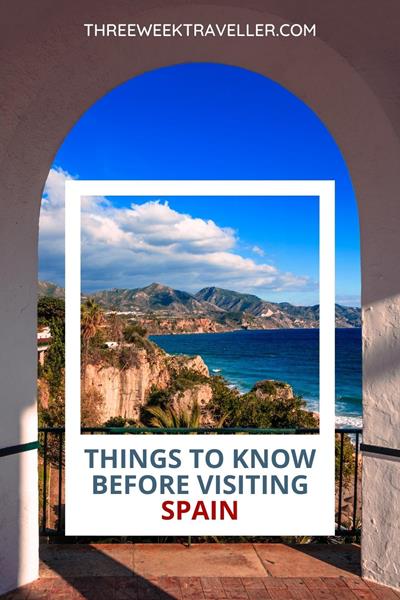

Get our Rail Planner app
Plan your trip, get extra discounts, and show your Pass as you go.

Our favorite spring routes
Celebrate spring with these 7 off-the-beaten-path train routes

All about seat reservations
Everything you need to know about booking your seats

Alternatives to Busy Routes
Travel between popular European cities without seat reservations

Through our Chatbot in the bottom right corner.

Ask the Community
Browse questions from fellow Eurail travellers, or ask your own!
- Plan your trip
- Suggested Itineraries
Spain Itinerary
- Order overview
- Reservations overview
- My Trips & Travelers
- {{translatedTraveler}} {{#promotional}} {{currencySign}} {{standardPrice}} {{/promotional}} {{quantity}}x {{currencySign}} {{finalPrice}}
- Child {{childPasses}}x FREE
- {{translatedPassType}}
- {{translatedValidityPeriodDescription}}
- {{translatedClass}}
- Remove Pass(es)
- {{variant.localizedTravelPackDescription}} {{quantity}}x Free
- {{variant.localizedPassUpgradeDescription}} {{quantity}}x {{currency}} {{price}}
- Your order will arrive by {{expectedDeliveryDate}} 1 x {{currency}} {{price}}
Your cart is empty
Spain by rail is a breeze with its network of fast and modern trains. You'll see wine regions, small villages, and sunny beaches - all on a single train ride. Our Spain travel itinerary has lively cities, delicious cuisines, and great opportunities for fiestas . Whether you're backpacking in Spain, or going on a flashier trip, you'll love the exciting cultural offerings!
Itinerary in short
Cities visited in this trip: .
- Barcelona, Spain
- Valencia, Spain
- Madrid, Spain
- Seville (Sevilla), Spain
- Malaga (Málaga), Spain
Click here or on the map to view this route in our Trip Planner

For this itinerary we recommend:
- Eurail pass: Spain
- Travel days: 4 days within 1 month
Most of the high-speed trains in Spain require reservations. These reservations are not included in your Eurail Pass. Make sure to book your seats in advance, there are limited seats available for Eurail Pass holders. It's also possible to avoid reservations altogether, simply by taking regional trains .
Barcelona, Spain
Barcelona has a Mediterranean climate, a cosmopolitan atmosphere, and an endless list of things to do. Antoni Gaudí’s architectural work is all around you, from Park Güell to the Casa Batlló , and the incredible Sagrada Familia . Enjoy the vibrant atmosphere of La Rambla (Las Ramblas), a lively pedestrian boulevard. Stop at La Boqueria Market and lose yourself in the maze of food stalls. Then relax on the white sand beaches of Barceloneta , and congratulate yourself on a great start to your trip.
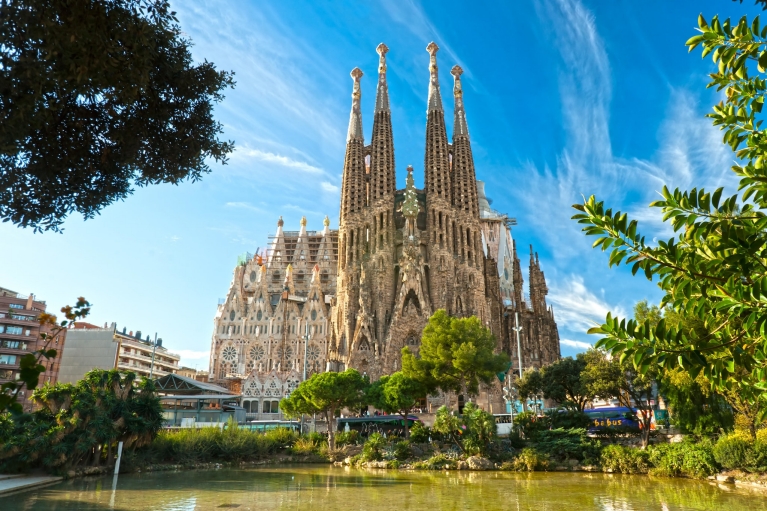
From Barcelona to Valencia
Travel time:
Reservation needed:
Barcelona Sants
Reservation required
Valencia, Spain
Valencia Joaquin Sorolla
Valencia is one of the oldest cities in Spain. Its sights range from ancient Roman structures, to the futuristic City of Arts and Sciences . Walking through the city is like taking a time machine through architectural history! Tuck into Valencia’s signature dish of paella. Still hungry? Sample the food at Mercado Central , one of the longest running markets in Europe. Valencia Cathedral is just minutes away – a trip up its tower will give you a beautiful view over the city. Round up your day by people-watching in the Turia Gardens (Jardines del Turia).
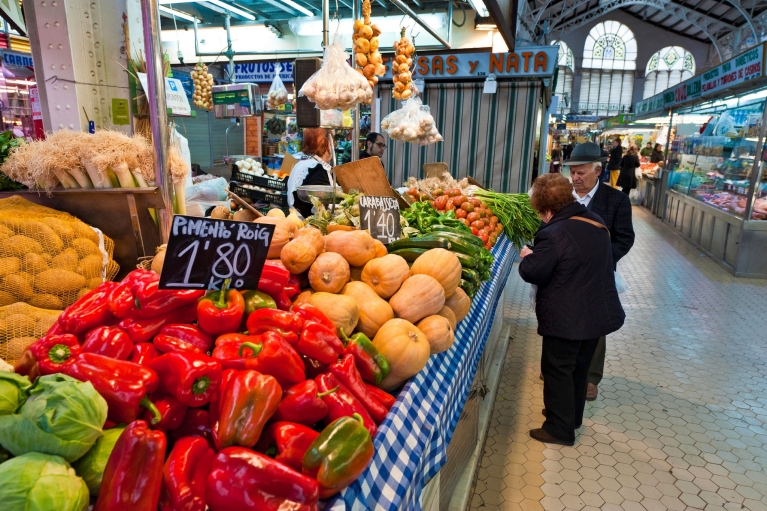
From Valencia to Madrid
Madrid, spain.
Madrid Puerta de Atocha
Spain's capital buzzes with culture and energy. There's no shortage of things to add to your Madrid itinerary! Stroll along the Art Walk and explore numerous museums, including the world-class Prado . Then check out the nearby Retiro Park (Parque del Buen Retiro). Las Ventas Bullring - the birthplace of bullfighting - will get your heart pumping. Learn the history of this controversial Spanish tradition, or watch a torero (bullfighter) in action. Fans of European football shouldn't miss a trip to the Santiago Bernabéu Stadium, home to Real Madrid.
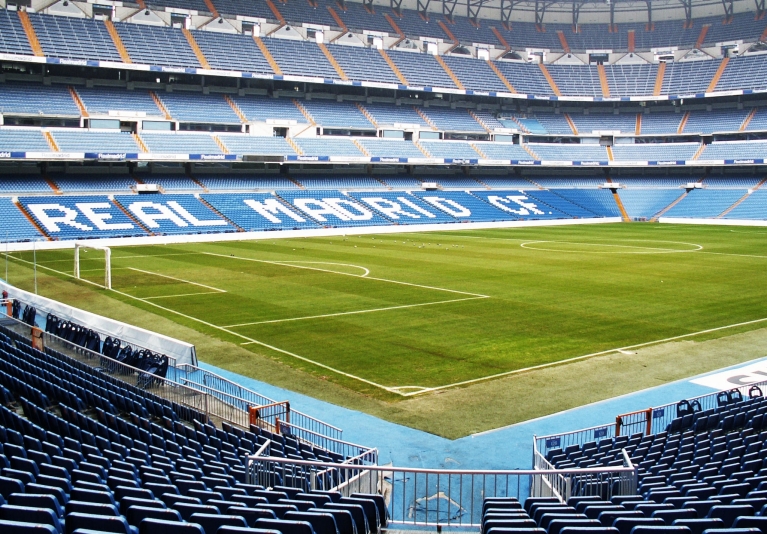
From Madrid to Seville
Seville, spain.
Sevilla Santa Justa
Seville (Sevilla), Spain
Portuguese explorer Ferdinand Magellan began the first voyage around the world in 1519, and it all began in Seville. This city is a place for true world travelers! Home to flamenco dancing and tasty tapas, you can easily immerse yourself in Spanish life here. Start with the colorful Calle Betis , which runs along the waterfront and is lined with restaurants, bars, and clubs. The Alcázar of Seville is worth a visit, as is the large and distinctive Metropol Parasol wooden structure.
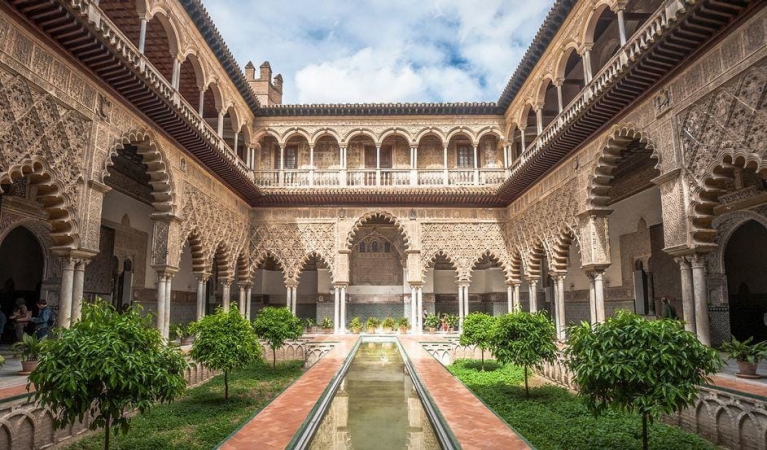
From Seville to Malaga
Malaga, spain.
Málaga-María Zambrano
Malaga (Málaga), Spain
Malaga is a stunning coastal city of sun and sand. It seamlessly combines natural beauty with a rich history and a modern skyline. The 11 th century Moorish castle of Alcazaba can be found in the middle of the city. Below lie the remains of the old Roman Theater (El Teatro Romano), which is free to visitors. After gazing in awe at the ancient ruins, fast forward to the 20 th century. Pablo Picasso was born in Malaga, so it's fitting to tour the Picasso Museum ! Then it’s time to complete your Spain trip with a visit to one of Malaga’s famous beaches .
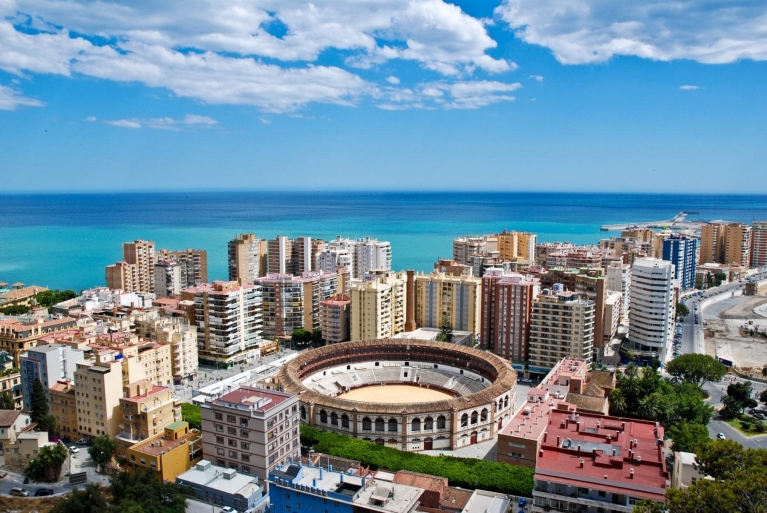
Get ready to discover Spain by train!
Change of currency.
You cannot change the currency once you have a Pass in your cart. Remove the Pass, and then change the currency on the website header.
- Getting Results.
- Newsletters
Google AI finds travel deals, itinerary for vacation destinations
The internet generation connects with price alerts for flights and hotels.
Mike Holfeld , Investigative Reporter
Florida residents who are getting set to plan a trip for the perfect summer destination may be able to get a bargain price with the help of AI and Google.
The search engine powerhouse is offering AI-driven trip planning with the destination of your choice and the best price to boot.
“We have what we call a price alert on Google Flights,” Google technology expert Luma Hamade said. “I actually got a massive discount for my trip to Europe using the price alert.”
The trip technology is free, creating itineraries for destinations from Orlando to Italy, which just happens to be a hotspot for Florida travelers this year.
Hamade told News 6 that travelers who want to score a bargain price should go to Google Flights “a few weeks before you intend to book” and set the price alert filter on so you know what day that flight will be the cheapest.
“When it comes to organization, you should get a confirmation email once you book right to your Gmail,” Hamade told News 6. “You can actually have Gemini, which is our AI chatbot, pull that confirmation email and create an entire itinerary based on where you are going.”
Hamade says the AI magic happens on your phone or laptop “in real-time.” In fact, she said she saved $500 on her flight, thanks to the price alert.
The “Google Maps community” provides real-time experiences so the AI system can focus on the best local spots for your vacation destination.
“When you’re shopping for what you want to wear on that trip, we have what we call a personalized style recommender,” she said. “Hit your Google search page, scroll down and you can choose your wardrobe.”
You can plan your itinerary by going to Gemini.Google.com to pull all the information from your Gmail account and it will condense an itinerary for you and your family.
To start planning your trip with Google Maps, visit https://www.google.com/mymaps . On your My Maps dashboard, click the “Create a New Map” button.
Once you’ve given your map a name, you can start adding your locations.
If you want to set up a search for cheap flights go to: google.com/travel/flights .
If you plan to do a lot of traveling, Google One offers a premium travel assistant for $15 to $20 a month.
Some of the top international travel destinations on Americans’ wish lists include London, Italy, Spain, Puerto Rico and The Bahamas. Here’s the full list:
Top Summer 2024 Destinations on Google Flights
Reflects people in the US searching on Google Flights for travel anytime June 1-August 31 2024.
5. New York
8. Las Vegas
11. Los Angeles
13. Barcelona
15. Fort Lauderdale
16. Honolulu
20. San Juan
If you have an investment or consumer issue email [email protected] or text the words make ends meet along with your issue and contact information to 407-676-7428.
Get today’s headlines in minutes with Your Florida Daily :
Copyright 2024 by WKMG ClickOrlando - All rights reserved.
About the Author
Mike holfeld.
News 6’s Emmy Award-winning Investigative Reporter Mike Holfeld has made Central Florida history with major investigations that have led to new policies, legislative proposals and even -- state and national laws. If you have an issue or story idea, call Mike's office at 407-521-1322.
Recommended Videos

IMAGES
VIDEO
COMMENTS
Find out the best places to visit in Spain for different lengths of trips, from 3 days to 25 days. Get tips on public transportation, side-trips, and highlights from Rick Steves' travel guide.
Explore Madrid, Toledo, Seville, Granada, and Barcelona in 10 days with this itinerary designed for first-time travelers. Learn how to get around by train, what to pack, and where to stay in each destination.
Explore the best places to visit in Spain in 10 days with this guide. From Madrid to Barcelona, discover the culture, history, and cuisine of this diverse country with tips on when to visit, how to get around, and where to stay.
Find detailed templates for planning your ideal Spain trip, whether you have 5, 7, 10 or 14 days. Explore the north and south of Spain, from Barcelona to Granada, with tips on transportation, accommodation and attractions.
Tip #4 - Go On Day Trips To Spain's Hidden Gems. The adorable town of Competa. Everyone wants to go to Barcelona and Madrid, but fewer people are lining up around the block for Spain's lesser-known gems of towns. Some of my favorite smaller places in Spain were Frigiliana, Nerja, and Competa in southern Spain.
4 Days in Spain - Best Travel Itineraries for Short Trips; Itinerary for 5 Days in Spain. In this article, five itineraries will help you spend the best 5 days in Spain. You will find one itinerary for Madrid, Barcelona, and Seville, another itinerary only to discover southern cities, and a third one to visit Spain's major classics.
See the highlights of Spain on this 14-day itinerary. To understand why many visitors fall in love with Spain and never want to leave, look no further than its vibrant, passionate, beautiful cities. This 14-day tour takes you through the best Spain has to offer. Days 1-3: Admire Modernista marvels in Barcelona
Here is a breakdown of this itinerary budget for each travel category: Accommodation: $70 per night p.p. (on average) in a nice mid-range hotel = $980 per person. Transportation: Train Barcelona-Valencia (approx. $30 ), Train Valencia-Madrid (approx $25 ), Train Madrid-Granada (approx. $50) = $105 per person.
Located in Northern Spain and surrounded by lush green mountains, the capital of Basque Country is home to the Guggenheim Museum Bilbao. The titanium structure of the museum receives more accolades than the famous contemporary art it houses. Bilbao is the perfect addition to any Northern Spain itinerary. 6. Seville.
Here's the quick overview of the 10-day Spain itinerary we've detailed above: Days 1 and 2: Arrive in Madrid, explore Madrid. Day 3: Take a day trip from Madrid to Toledo. Day 4: Travel to Seville, explore Seville. Day 5: Do a day trip to Cordoba, travel to Granada. Day 6: Explore Granada.
Finding the Perfect Spain Travel Itinerary: Choose from the Options Below. Andalusia in One Week: An Itinerary That Covers Southern Spain in 7 Days, Visiting Seville, Granada, Cordoba and Malaga. 10-Day Big Cities & Andalusian Highlights: A Best of Spain Itinerary Covering Madrid, Toledo, Seville, Granada and Barcelona.
1. Madrid, Seville, Granada. One of my favorite itineraries for 7 days in Spain! This plan is perfect for a first visit to Spain and those looking to see the TOP sights. 2 NIGHTS MADRID. 3 NIGHTS SEVILLE WITH OPTIONAL STOP IN CORDOBA. 2 NIGHTS GRANADA. Madridto Seville is a quick 2.5 hour journey by high-speed train.
Below, you will find a map overview of the itinerary, followed by detailed sections for each day of the trip. Two-Week Spain Travel Itinerary Map. View Larger Map. Day 1: Fly to Barcelona. Day 2: Explore Gaudí's Barcelona. Day 3: Explore the Rest of Barcelona. Day 4: Travel to Valencia. Day 5: Explore Valencia.
Barcelona, Madrid, and Granada in 10 Days. In this version, you're skipping Seville (one of our favorite places in Spain) in favor of Barcelona, Madrid, and Granada. Granada and the Alhambra gives you a taste of Andalusia, which you can come back to on a dedicated trip later. Day 1: Arrive in Barcelona.
10-Day Spain Itinerary: Barcelona, Madrid, Toledo, Seville & Granada. Day 1- 3: Barcelona. Day 4 - 5: Madrid. Day 6: Toledo. Day 7: Seville. Day 8-9: Granada. Day 10: Fly home. view over Passeig de Colom or Columbus avenue, La Barceloneta and Port Vell marina from Christopher Columbus monument in Barcelona.
What to do in Spain? This 4 days itinerary is the perfect guide to the best things to see in Spain. It includes day-by-day activities, travel tips, and the top places to visit. Day 1: Day 1: Madrid - The Heart of Spain. Morning. Start your journey in Madrid, the capital city. Visit the Prado Museum to admire works by Spanish masters.
I notice Cordoba gets skipped on some Spain travel itineraries. But its world-famous mosque-slash-cathedral alone is good enough reason to squeeze a day trip here from Seville into your ten day Spain itinerary. Add to that the picturesque winding and flower-pot-laden streets with the old town's seamless mix of Jewish, Moorish, ...
Gawk at the Catedral Santa María de la Sede. From one awe-striking site to another, the Catedral Santa María de la Sede (or Catedral de Sevilla) is bound to leave your jaw sagging. Seville's biggest drawcard is as impressive a sight as any in Spain. The 15th-century cathedral was built upon a 12th-century mosque.
Itinerary #1: Spain by Rail: Barcelona, Madrid & Seville. Ideal for first-time visitors, this 10-day Spain itinerary combines time in Barcelona, Madrid, and Seville for a well-rounded introduction to the country's culture and culinary scene. Throughout the adventure, you'll join an exciting bike journey through Barcelona's vibrant squares, embark on a kayak excursion on the Mediterranean Sea ...
Day 2 - IMMERSE IN BARCELONA'S CULTURE. Have a Spanish Breakfast. Park Güell. The Magic Fountain of Montjuïc. Museu Nacional d'Art de Catalunya. Try Tasty Dishes in El Nacional. Travel to Madrid. DAY 3 - DISCOVER MADRID'S TREASURES. Royal Palace of Madrid.
Itinerary #2: Culinary Journey Through Spain. Spain is a great country in which to plan an epic 12-day food tour. This itinerary covers many of the best regions for food, including Madrid's melting pot of restaurants and bars, the unique tapas culture of the Basque Country, and of course, Barcelona, home to some of the finest Catalan cuisine.
Average cost of 20 days in Spain. Plan to spend around $2,000 for a 3-week trip in Spain if you prefer to stay in a mid-range hotel and eat often. Accommodation costs you the most during your trip, around $40-$60 a night for a decent double room. Eating out in a m id-range restaurant will be about $7 to $12 per meal.
see eurail spain pass prices. For this itinerary we recommend: Eurail pass: Spain. Travel days: 4 days within 1 month. Most of the high-speed trains in Spain require reservations. These reservations are not included in your Eurail Pass. Make sure to book your seats in advance, there are limited seats available for Eurail Pass holders.
Southern Spain is dominated by Andalusia, the country's second-largest region and the south's heart and soul. Centuries of history and ancient civilisations have left an indelible mark here and much of the culture we associate with Spain - flamenco, bullfighting, cuisine - originates from Andalusia.. As such, this itinerary focuses on this incredible region and is designed to take you on a ...
With the 2024 eclipse just behind us, the travel industry is thinking ahead, and new packages to view the 2026 solar eclipse in Spain or Iceland, including travel tours and cruises, are booking up.
The trip technology is free, creating itineraries for destinations from Orlando to Italy, which just happens to be a hotspot for Florida travelers this year. ... Spain, Puerto Rico and The Bahamas ...